Factors Influencing Vaccination Uptake
VerifiedAdded on 2019/09/30
|107
|31336
|159
Report
AI Summary
The provided content discusses various aspects related to influenza vaccination, including its effectiveness, associated factors, and challenges. The articles highlight socio-demographic factors influencing poor knowledge, attitudes, and practices (KAP) regarding diphtheria vaccination among adults in Thailand. Other studies focus on increasing the coverage of influenza vaccination among healthcare workers, exploring factors affecting hand hygiene and risk of influenza virus infections, and investigating health education and willingness to pay for influenza vaccination among older adults. The report also touches upon sustainable local production of influenza vaccines and perceptions towards influenza vaccination during pregnancy. The survey questionnaire aims to test hypotheses related to influenza vaccination uptake, including the role of social influence, family support, and lay beliefs in hindering or promoting vaccination.
Contribute Materials
Your contribution can guide someone’s learning journey. Share your
documents today.
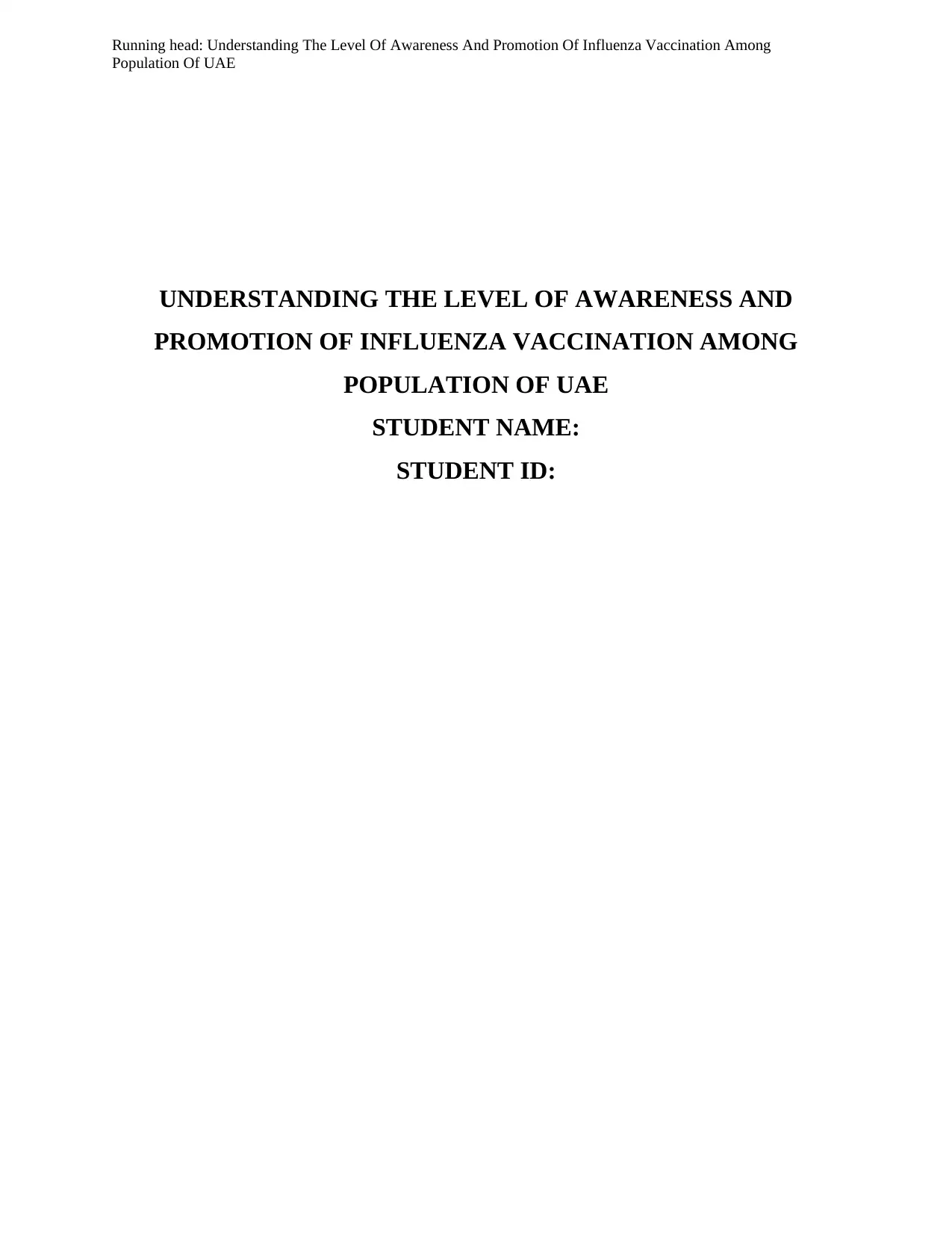
Running head: Understanding The Level Of Awareness And Promotion Of Influenza Vaccination Among
Population Of UAE
UNDERSTANDING THE LEVEL OF AWARENESS AND
PROMOTION OF INFLUENZA VACCINATION AMONG
POPULATION OF UAE
STUDENT NAME:
STUDENT ID:
Population Of UAE
UNDERSTANDING THE LEVEL OF AWARENESS AND
PROMOTION OF INFLUENZA VACCINATION AMONG
POPULATION OF UAE
STUDENT NAME:
STUDENT ID:
Secure Best Marks with AI Grader
Need help grading? Try our AI Grader for instant feedback on your assignments.

Understanding The Level Of Awareness And Promotion Of Influenza Vaccination Among Population Of UAE 2
Abstract
This research study provides an overview of the level of awareness among people of UAE
regarding the influenza vaccination. It also provides an overview about the various factors which
are affecting the process of vaccination. This research study helps the readers to gain knowledge
about the factors affecting vaccination against influenza and the ways in which it can be
mitigated. From the findings it has been observed that province of UAE in the Middle East
along with Kuwait and Oman are worst affected by influenza and the level of vaccination uptake
among its population is also less. Findings from this study indicate that, awareness of vaccination
uptake against influenza and the benefits associated with it have improved considerably.
However, this improvement rate is not enough to prevent the entire population from pandemic
influenza viruses. Several vaccination programs and initiatives have been taken by government
of UAE in order to promote vaccination process against influenza virus. Despite of such
attempts, a major portion of people are yet to avail vaccination against influenza. It has been
found that health workers, adults above 30 years of age and older people are at high risk of being
affected by impact of influenza viruses. Studies have also indicated that children are the best
carrier of influenza viruses and help in their spreading. Thus it was necessary for UAE
government to vaccinate the children as this will help in preventing spread of such
communicable disease to a considerable extent. Furthermore it has also been observed that
government authorities are not having proper data indicating number or percentage of
vaccination uptake by population of UAE. No records are present with government based on
which it can estimate the population that has been vaccinated. The availability of records helps
government in understanding and evaluating the perception and adaption of people against
vaccination of influenza. As per study, some of the prominent factors affecting the vaccination
uptake among people are low family support, social influence, lay beliefs and excess work
pressure. On the basis of findings it has been observed that a major part of UAE population that
is aware of the significance associated with vaccination process are unable to adopt vaccination
because they are too busy with their work and they are unable to make out time or schedule in
order to immunize themselves against influenza viruses. This enables researcher to recommend
ways in which rate of vaccination among UAE population can be enhanced.
Abstract
This research study provides an overview of the level of awareness among people of UAE
regarding the influenza vaccination. It also provides an overview about the various factors which
are affecting the process of vaccination. This research study helps the readers to gain knowledge
about the factors affecting vaccination against influenza and the ways in which it can be
mitigated. From the findings it has been observed that province of UAE in the Middle East
along with Kuwait and Oman are worst affected by influenza and the level of vaccination uptake
among its population is also less. Findings from this study indicate that, awareness of vaccination
uptake against influenza and the benefits associated with it have improved considerably.
However, this improvement rate is not enough to prevent the entire population from pandemic
influenza viruses. Several vaccination programs and initiatives have been taken by government
of UAE in order to promote vaccination process against influenza virus. Despite of such
attempts, a major portion of people are yet to avail vaccination against influenza. It has been
found that health workers, adults above 30 years of age and older people are at high risk of being
affected by impact of influenza viruses. Studies have also indicated that children are the best
carrier of influenza viruses and help in their spreading. Thus it was necessary for UAE
government to vaccinate the children as this will help in preventing spread of such
communicable disease to a considerable extent. Furthermore it has also been observed that
government authorities are not having proper data indicating number or percentage of
vaccination uptake by population of UAE. No records are present with government based on
which it can estimate the population that has been vaccinated. The availability of records helps
government in understanding and evaluating the perception and adaption of people against
vaccination of influenza. As per study, some of the prominent factors affecting the vaccination
uptake among people are low family support, social influence, lay beliefs and excess work
pressure. On the basis of findings it has been observed that a major part of UAE population that
is aware of the significance associated with vaccination process are unable to adopt vaccination
because they are too busy with their work and they are unable to make out time or schedule in
order to immunize themselves against influenza viruses. This enables researcher to recommend
ways in which rate of vaccination among UAE population can be enhanced.
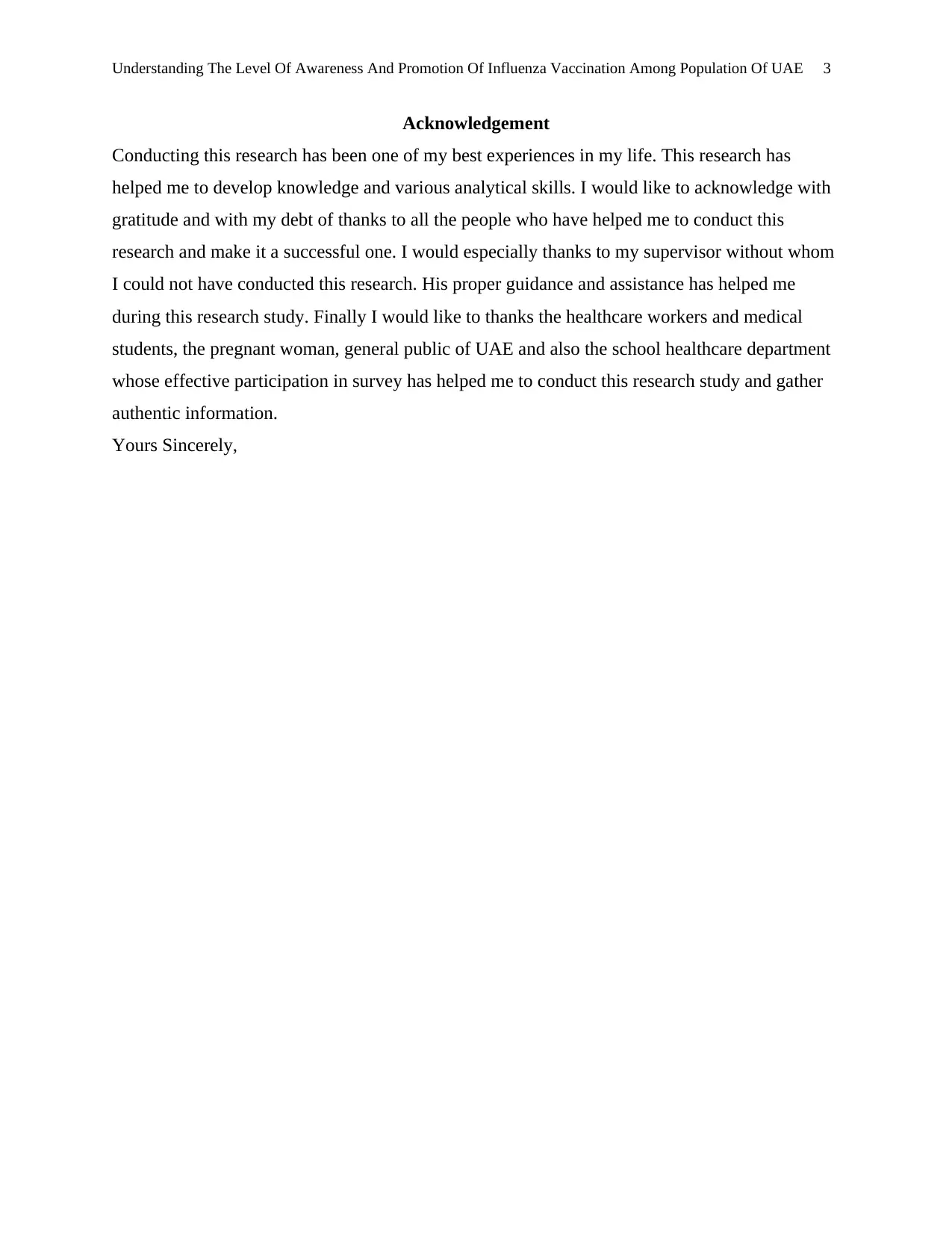
Understanding The Level Of Awareness And Promotion Of Influenza Vaccination Among Population Of UAE 3
Acknowledgement
Conducting this research has been one of my best experiences in my life. This research has
helped me to develop knowledge and various analytical skills. I would like to acknowledge with
gratitude and with my debt of thanks to all the people who have helped me to conduct this
research and make it a successful one. I would especially thanks to my supervisor without whom
I could not have conducted this research. His proper guidance and assistance has helped me
during this research study. Finally I would like to thanks the healthcare workers and medical
students, the pregnant woman, general public of UAE and also the school healthcare department
whose effective participation in survey has helped me to conduct this research study and gather
authentic information.
Yours Sincerely,
Acknowledgement
Conducting this research has been one of my best experiences in my life. This research has
helped me to develop knowledge and various analytical skills. I would like to acknowledge with
gratitude and with my debt of thanks to all the people who have helped me to conduct this
research and make it a successful one. I would especially thanks to my supervisor without whom
I could not have conducted this research. His proper guidance and assistance has helped me
during this research study. Finally I would like to thanks the healthcare workers and medical
students, the pregnant woman, general public of UAE and also the school healthcare department
whose effective participation in survey has helped me to conduct this research study and gather
authentic information.
Yours Sincerely,
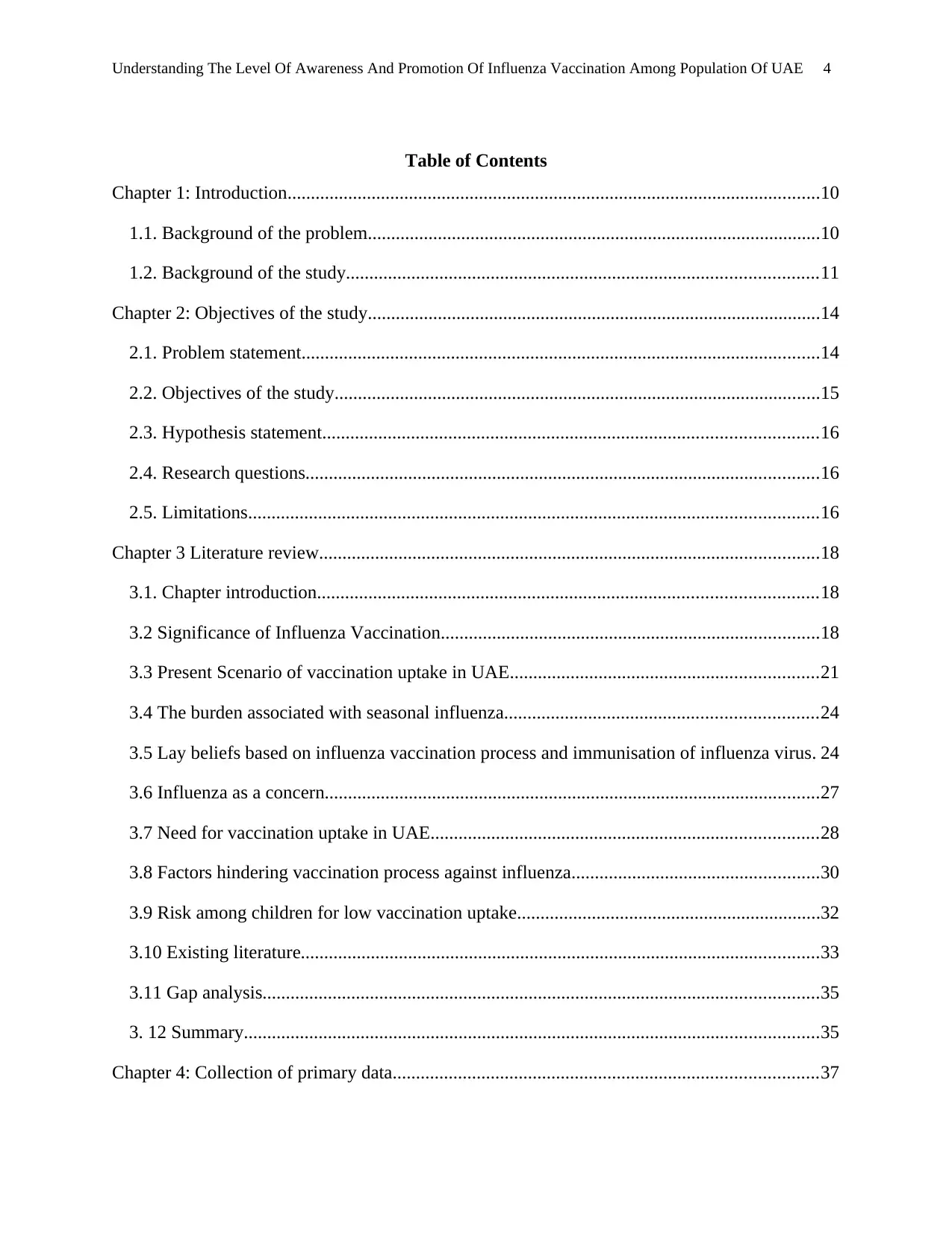
Understanding The Level Of Awareness And Promotion Of Influenza Vaccination Among Population Of UAE 4
Table of Contents
Chapter 1: Introduction..................................................................................................................10
1.1. Background of the problem.................................................................................................10
1.2. Background of the study.....................................................................................................11
Chapter 2: Objectives of the study.................................................................................................14
2.1. Problem statement...............................................................................................................14
2.2. Objectives of the study........................................................................................................15
2.3. Hypothesis statement..........................................................................................................16
2.4. Research questions..............................................................................................................16
2.5. Limitations..........................................................................................................................16
Chapter 3 Literature review...........................................................................................................18
3.1. Chapter introduction...........................................................................................................18
3.2 Significance of Influenza Vaccination.................................................................................18
3.3 Present Scenario of vaccination uptake in UAE..................................................................21
3.4 The burden associated with seasonal influenza...................................................................24
3.5 Lay beliefs based on influenza vaccination process and immunisation of influenza virus. 24
3.6 Influenza as a concern..........................................................................................................27
3.7 Need for vaccination uptake in UAE...................................................................................28
3.8 Factors hindering vaccination process against influenza.....................................................30
3.9 Risk among children for low vaccination uptake.................................................................32
3.10 Existing literature...............................................................................................................33
3.11 Gap analysis.......................................................................................................................35
3. 12 Summary...........................................................................................................................35
Chapter 4: Collection of primary data...........................................................................................37
Table of Contents
Chapter 1: Introduction..................................................................................................................10
1.1. Background of the problem.................................................................................................10
1.2. Background of the study.....................................................................................................11
Chapter 2: Objectives of the study.................................................................................................14
2.1. Problem statement...............................................................................................................14
2.2. Objectives of the study........................................................................................................15
2.3. Hypothesis statement..........................................................................................................16
2.4. Research questions..............................................................................................................16
2.5. Limitations..........................................................................................................................16
Chapter 3 Literature review...........................................................................................................18
3.1. Chapter introduction...........................................................................................................18
3.2 Significance of Influenza Vaccination.................................................................................18
3.3 Present Scenario of vaccination uptake in UAE..................................................................21
3.4 The burden associated with seasonal influenza...................................................................24
3.5 Lay beliefs based on influenza vaccination process and immunisation of influenza virus. 24
3.6 Influenza as a concern..........................................................................................................27
3.7 Need for vaccination uptake in UAE...................................................................................28
3.8 Factors hindering vaccination process against influenza.....................................................30
3.9 Risk among children for low vaccination uptake.................................................................32
3.10 Existing literature...............................................................................................................33
3.11 Gap analysis.......................................................................................................................35
3. 12 Summary...........................................................................................................................35
Chapter 4: Collection of primary data...........................................................................................37
Paraphrase This Document
Need a fresh take? Get an instant paraphrase of this document with our AI Paraphraser

Understanding The Level Of Awareness And Promotion Of Influenza Vaccination Among Population Of UAE 5
4.1. Methodology.......................................................................................................................37
4.2. Research design...................................................................................................................37
4.2. a. Type of research..........................................................................................................40
4.2. b. Design of the research instrument...............................................................................40
4.2. c. Sample selection..........................................................................................................41
4.3. Research execution.............................................................................................................42
4.4. Analysis of data...................................................................................................................43
4.4. a. Profile of respondents (if survey)................................................................................43
4.4. b. Analysis of responses..................................................................................................43
Chapter 5 Analysis and conclusion................................................................................................45
5.1. Hypothesis testing...............................................................................................................45
5.2. Intermediate conclusion(s)..................................................................................................72
Chapter 6: Conclusions and recommendations..............................................................................79
6.1. Summary of findings...........................................................................................................79
6.2. Overall conclusion..............................................................................................................80
6.3. Recommendations...............................................................................................................82
6.4. Lessons learned...................................................................................................................89
6.5. Ethical implications.............................................................................................................91
Reference List................................................................................................................................92
Bibliography..................................................................................................................................99
Appendix......................................................................................................................................106
4.1. Methodology.......................................................................................................................37
4.2. Research design...................................................................................................................37
4.2. a. Type of research..........................................................................................................40
4.2. b. Design of the research instrument...............................................................................40
4.2. c. Sample selection..........................................................................................................41
4.3. Research execution.............................................................................................................42
4.4. Analysis of data...................................................................................................................43
4.4. a. Profile of respondents (if survey)................................................................................43
4.4. b. Analysis of responses..................................................................................................43
Chapter 5 Analysis and conclusion................................................................................................45
5.1. Hypothesis testing...............................................................................................................45
5.2. Intermediate conclusion(s)..................................................................................................72
Chapter 6: Conclusions and recommendations..............................................................................79
6.1. Summary of findings...........................................................................................................79
6.2. Overall conclusion..............................................................................................................80
6.3. Recommendations...............................................................................................................82
6.4. Lessons learned...................................................................................................................89
6.5. Ethical implications.............................................................................................................91
Reference List................................................................................................................................92
Bibliography..................................................................................................................................99
Appendix......................................................................................................................................106
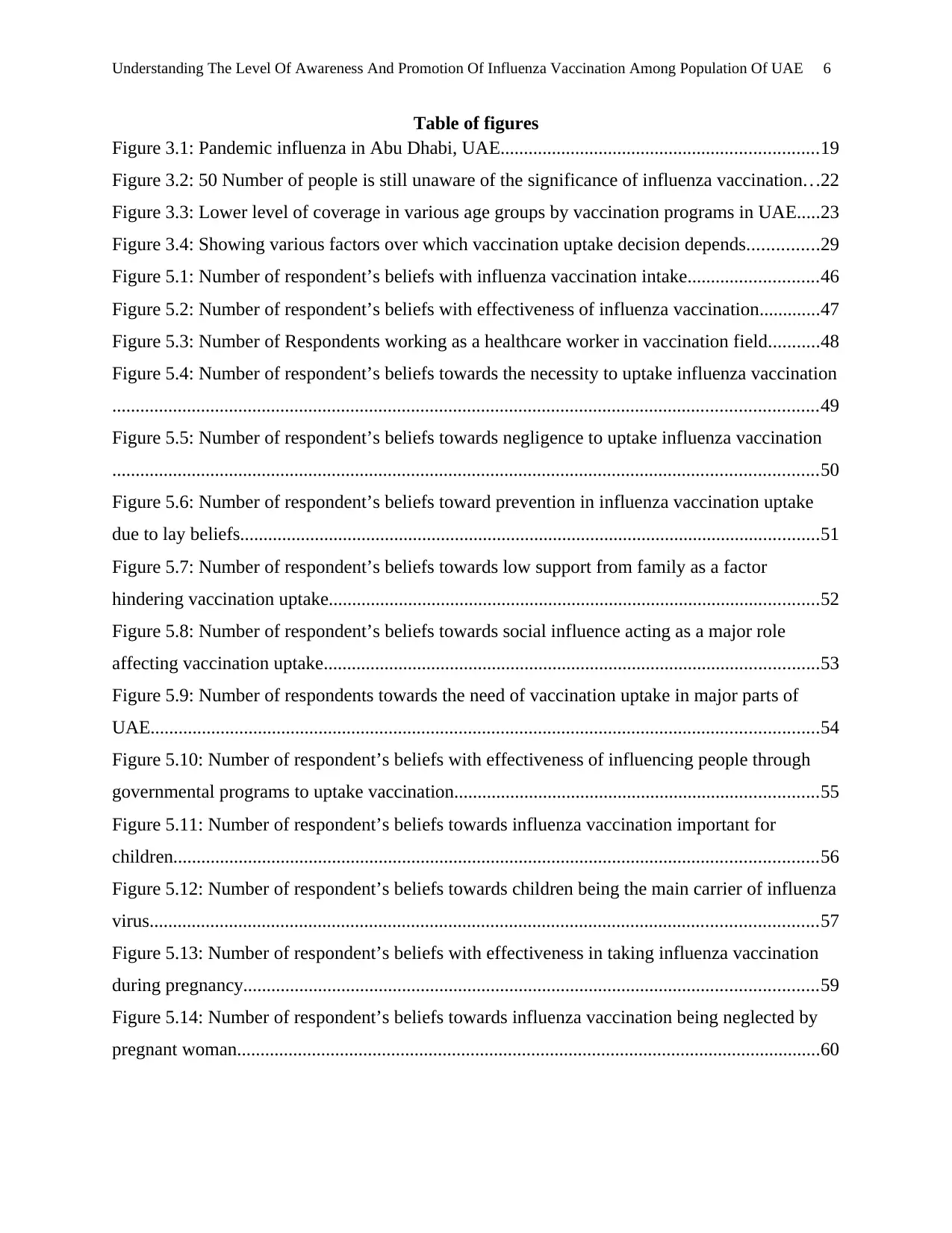
Understanding The Level Of Awareness And Promotion Of Influenza Vaccination Among Population Of UAE 6
Table of figures
Figure 3.1: Pandemic influenza in Abu Dhabi, UAE....................................................................19
Figure 3.2: 50 Number of people is still unaware of the significance of influenza vaccination...22
Figure 3.3: Lower level of coverage in various age groups by vaccination programs in UAE.....23
Figure 3.4: Showing various factors over which vaccination uptake decision depends...............29
Figure 5.1: Number of respondent’s beliefs with influenza vaccination intake............................46
Figure 5.2: Number of respondent’s beliefs with effectiveness of influenza vaccination.............47
Figure 5.3: Number of Respondents working as a healthcare worker in vaccination field...........48
Figure 5.4: Number of respondent’s beliefs towards the necessity to uptake influenza vaccination
.......................................................................................................................................................49
Figure 5.5: Number of respondent’s beliefs towards negligence to uptake influenza vaccination
.......................................................................................................................................................50
Figure 5.6: Number of respondent’s beliefs toward prevention in influenza vaccination uptake
due to lay beliefs............................................................................................................................51
Figure 5.7: Number of respondent’s beliefs towards low support from family as a factor
hindering vaccination uptake.........................................................................................................52
Figure 5.8: Number of respondent’s beliefs towards social influence acting as a major role
affecting vaccination uptake..........................................................................................................53
Figure 5.9: Number of respondents towards the need of vaccination uptake in major parts of
UAE...............................................................................................................................................54
Figure 5.10: Number of respondent’s beliefs with effectiveness of influencing people through
governmental programs to uptake vaccination..............................................................................55
Figure 5.11: Number of respondent’s beliefs towards influenza vaccination important for
children..........................................................................................................................................56
Figure 5.12: Number of respondent’s beliefs towards children being the main carrier of influenza
virus...............................................................................................................................................57
Figure 5.13: Number of respondent’s beliefs with effectiveness in taking influenza vaccination
during pregnancy...........................................................................................................................59
Figure 5.14: Number of respondent’s beliefs towards influenza vaccination being neglected by
pregnant woman.............................................................................................................................60
Table of figures
Figure 3.1: Pandemic influenza in Abu Dhabi, UAE....................................................................19
Figure 3.2: 50 Number of people is still unaware of the significance of influenza vaccination...22
Figure 3.3: Lower level of coverage in various age groups by vaccination programs in UAE.....23
Figure 3.4: Showing various factors over which vaccination uptake decision depends...............29
Figure 5.1: Number of respondent’s beliefs with influenza vaccination intake............................46
Figure 5.2: Number of respondent’s beliefs with effectiveness of influenza vaccination.............47
Figure 5.3: Number of Respondents working as a healthcare worker in vaccination field...........48
Figure 5.4: Number of respondent’s beliefs towards the necessity to uptake influenza vaccination
.......................................................................................................................................................49
Figure 5.5: Number of respondent’s beliefs towards negligence to uptake influenza vaccination
.......................................................................................................................................................50
Figure 5.6: Number of respondent’s beliefs toward prevention in influenza vaccination uptake
due to lay beliefs............................................................................................................................51
Figure 5.7: Number of respondent’s beliefs towards low support from family as a factor
hindering vaccination uptake.........................................................................................................52
Figure 5.8: Number of respondent’s beliefs towards social influence acting as a major role
affecting vaccination uptake..........................................................................................................53
Figure 5.9: Number of respondents towards the need of vaccination uptake in major parts of
UAE...............................................................................................................................................54
Figure 5.10: Number of respondent’s beliefs with effectiveness of influencing people through
governmental programs to uptake vaccination..............................................................................55
Figure 5.11: Number of respondent’s beliefs towards influenza vaccination important for
children..........................................................................................................................................56
Figure 5.12: Number of respondent’s beliefs towards children being the main carrier of influenza
virus...............................................................................................................................................57
Figure 5.13: Number of respondent’s beliefs with effectiveness in taking influenza vaccination
during pregnancy...........................................................................................................................59
Figure 5.14: Number of respondent’s beliefs towards influenza vaccination being neglected by
pregnant woman.............................................................................................................................60
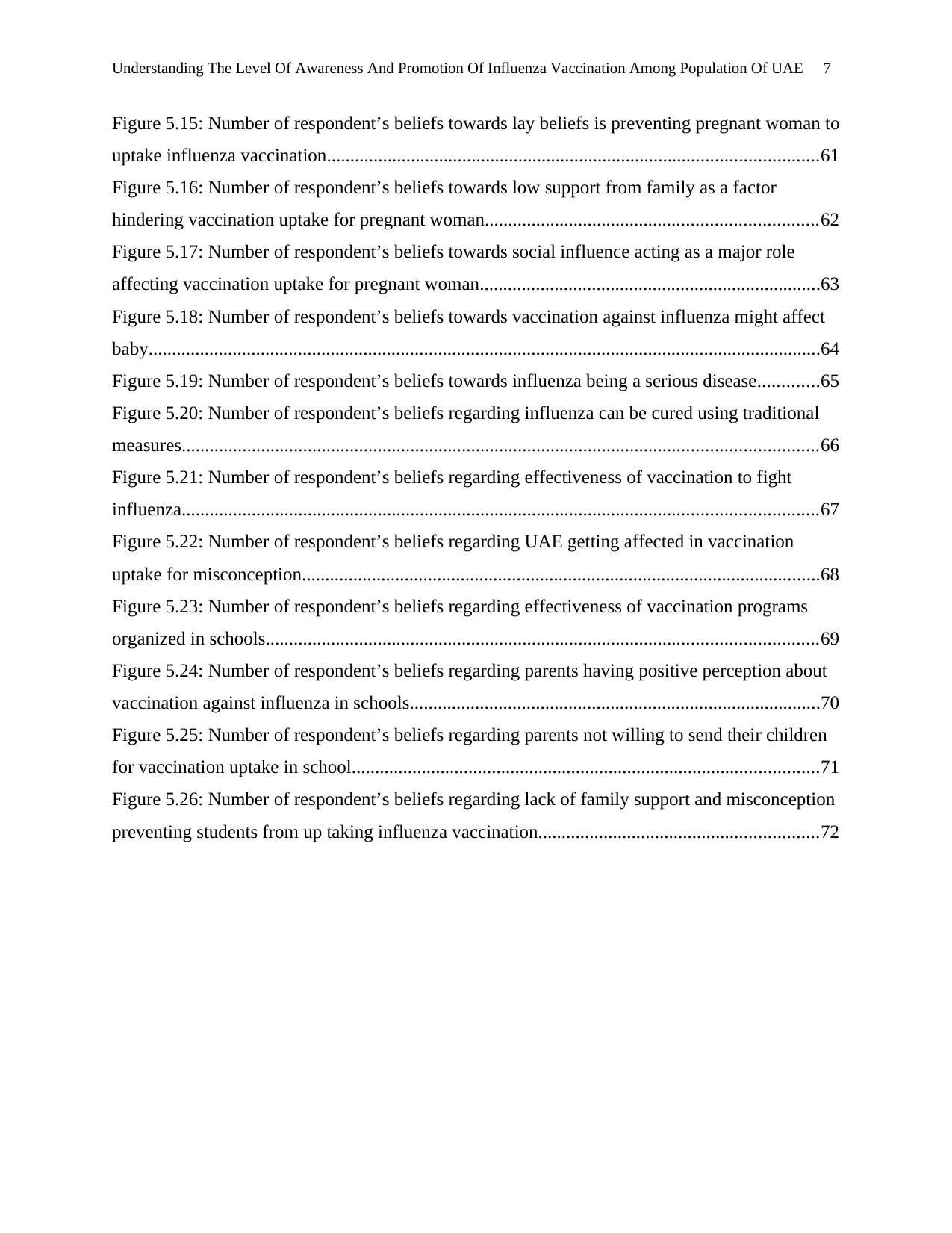
Understanding The Level Of Awareness And Promotion Of Influenza Vaccination Among Population Of UAE 7
Figure 5.15: Number of respondent’s beliefs towards lay beliefs is preventing pregnant woman to
uptake influenza vaccination.........................................................................................................61
Figure 5.16: Number of respondent’s beliefs towards low support from family as a factor
hindering vaccination uptake for pregnant woman.......................................................................62
Figure 5.17: Number of respondent’s beliefs towards social influence acting as a major role
affecting vaccination uptake for pregnant woman.........................................................................63
Figure 5.18: Number of respondent’s beliefs towards vaccination against influenza might affect
baby................................................................................................................................................64
Figure 5.19: Number of respondent’s beliefs towards influenza being a serious disease.............65
Figure 5.20: Number of respondent’s beliefs regarding influenza can be cured using traditional
measures........................................................................................................................................66
Figure 5.21: Number of respondent’s beliefs regarding effectiveness of vaccination to fight
influenza........................................................................................................................................67
Figure 5.22: Number of respondent’s beliefs regarding UAE getting affected in vaccination
uptake for misconception...............................................................................................................68
Figure 5.23: Number of respondent’s beliefs regarding effectiveness of vaccination programs
organized in schools......................................................................................................................69
Figure 5.24: Number of respondent’s beliefs regarding parents having positive perception about
vaccination against influenza in schools........................................................................................70
Figure 5.25: Number of respondent’s beliefs regarding parents not willing to send their children
for vaccination uptake in school....................................................................................................71
Figure 5.26: Number of respondent’s beliefs regarding lack of family support and misconception
preventing students from up taking influenza vaccination............................................................72
Figure 5.15: Number of respondent’s beliefs towards lay beliefs is preventing pregnant woman to
uptake influenza vaccination.........................................................................................................61
Figure 5.16: Number of respondent’s beliefs towards low support from family as a factor
hindering vaccination uptake for pregnant woman.......................................................................62
Figure 5.17: Number of respondent’s beliefs towards social influence acting as a major role
affecting vaccination uptake for pregnant woman.........................................................................63
Figure 5.18: Number of respondent’s beliefs towards vaccination against influenza might affect
baby................................................................................................................................................64
Figure 5.19: Number of respondent’s beliefs towards influenza being a serious disease.............65
Figure 5.20: Number of respondent’s beliefs regarding influenza can be cured using traditional
measures........................................................................................................................................66
Figure 5.21: Number of respondent’s beliefs regarding effectiveness of vaccination to fight
influenza........................................................................................................................................67
Figure 5.22: Number of respondent’s beliefs regarding UAE getting affected in vaccination
uptake for misconception...............................................................................................................68
Figure 5.23: Number of respondent’s beliefs regarding effectiveness of vaccination programs
organized in schools......................................................................................................................69
Figure 5.24: Number of respondent’s beliefs regarding parents having positive perception about
vaccination against influenza in schools........................................................................................70
Figure 5.25: Number of respondent’s beliefs regarding parents not willing to send their children
for vaccination uptake in school....................................................................................................71
Figure 5.26: Number of respondent’s beliefs regarding lack of family support and misconception
preventing students from up taking influenza vaccination............................................................72
Secure Best Marks with AI Grader
Need help grading? Try our AI Grader for instant feedback on your assignments.

Understanding The Level Of Awareness And Promotion Of Influenza Vaccination Among Population Of UAE 8
List of Tables
Table 5.1: Response towards influenza vaccination intake...........................................................45
Table 5.2: Response about effectiveness of influenza vaccination...............................................46
Table 5.3: Working period of healthcare workers.........................................................................47
Table 5.4: Response about necessity for healthcare workers to uptake influenza vaccination.....48
Table 5.5: Response about negligence to uptake influenza vaccination........................................49
Table 5.6: Response based on prevention in influenza vaccination uptake due to lay beliefs......50
Table 5.7: Response towards low support from family as a major factor hindering vaccination
uptake.............................................................................................................................................51
Table 5.8: Response towards social influence acting as a major role affecting vaccination uptake
.......................................................................................................................................................52
Table 5.9: Response towards vaccination uptake is still needed by major parts of UAE.............53
Table 5.10: Responses towards effectiveness of influencing people through governmental
programs to uptake vaccination.....................................................................................................54
Table 5.11: Response towards necessity of influenza vaccination for children............................56
Table 5.12: Response about children being the main carrier of influenza virus...........................57
Table 5.13: Response about effectiveness in taking influenza vaccination during pregnancy......58
Table 5.14: Response about influenza vaccination being neglected by pregnant woman.............59
Table 5.15: Response based on prevention in influenza vaccination uptake by pregnant woman
due to lay beliefs............................................................................................................................60
Table 5.16: Response towards low support from family as a major factor hindering vaccination
uptake for pregnant woman...........................................................................................................61
Table 5.17: Response towards social influence acting as a major role affecting vaccination
uptake for pregnant woman...........................................................................................................62
Table 5.18: Response based on vaccination against influenza might affect baby.........................63
Table 5.19: Response of people about influenza being a serious disease.....................................64
Table 5.20: Response based on influenza can be cured using traditional measures......................65
Table 5.21: Response based on effectiveness of vaccination to fight influenza............................66
Table 5.22: Response based on UAE getting affected in vaccination uptake for misconception. 67
Table 5.23: Response based on effectiveness of vaccination programs organized in schools......68
List of Tables
Table 5.1: Response towards influenza vaccination intake...........................................................45
Table 5.2: Response about effectiveness of influenza vaccination...............................................46
Table 5.3: Working period of healthcare workers.........................................................................47
Table 5.4: Response about necessity for healthcare workers to uptake influenza vaccination.....48
Table 5.5: Response about negligence to uptake influenza vaccination........................................49
Table 5.6: Response based on prevention in influenza vaccination uptake due to lay beliefs......50
Table 5.7: Response towards low support from family as a major factor hindering vaccination
uptake.............................................................................................................................................51
Table 5.8: Response towards social influence acting as a major role affecting vaccination uptake
.......................................................................................................................................................52
Table 5.9: Response towards vaccination uptake is still needed by major parts of UAE.............53
Table 5.10: Responses towards effectiveness of influencing people through governmental
programs to uptake vaccination.....................................................................................................54
Table 5.11: Response towards necessity of influenza vaccination for children............................56
Table 5.12: Response about children being the main carrier of influenza virus...........................57
Table 5.13: Response about effectiveness in taking influenza vaccination during pregnancy......58
Table 5.14: Response about influenza vaccination being neglected by pregnant woman.............59
Table 5.15: Response based on prevention in influenza vaccination uptake by pregnant woman
due to lay beliefs............................................................................................................................60
Table 5.16: Response towards low support from family as a major factor hindering vaccination
uptake for pregnant woman...........................................................................................................61
Table 5.17: Response towards social influence acting as a major role affecting vaccination
uptake for pregnant woman...........................................................................................................62
Table 5.18: Response based on vaccination against influenza might affect baby.........................63
Table 5.19: Response of people about influenza being a serious disease.....................................64
Table 5.20: Response based on influenza can be cured using traditional measures......................65
Table 5.21: Response based on effectiveness of vaccination to fight influenza............................66
Table 5.22: Response based on UAE getting affected in vaccination uptake for misconception. 67
Table 5.23: Response based on effectiveness of vaccination programs organized in schools......68

Understanding The Level Of Awareness And Promotion Of Influenza Vaccination Among Population Of UAE 9
Table 5.24: Response based on parents having positive perception about vaccination against
influenza in schools.......................................................................................................................69
Table 5.25: Response based on parents not willing to send their children for vaccination uptake
in school.........................................................................................................................................70
Table 5.26: Response based on lack of family support and misconception preventing students
from up taking influenza vaccination............................................................................................71
Table 5.24: Response based on parents having positive perception about vaccination against
influenza in schools.......................................................................................................................69
Table 5.25: Response based on parents not willing to send their children for vaccination uptake
in school.........................................................................................................................................70
Table 5.26: Response based on lack of family support and misconception preventing students
from up taking influenza vaccination............................................................................................71
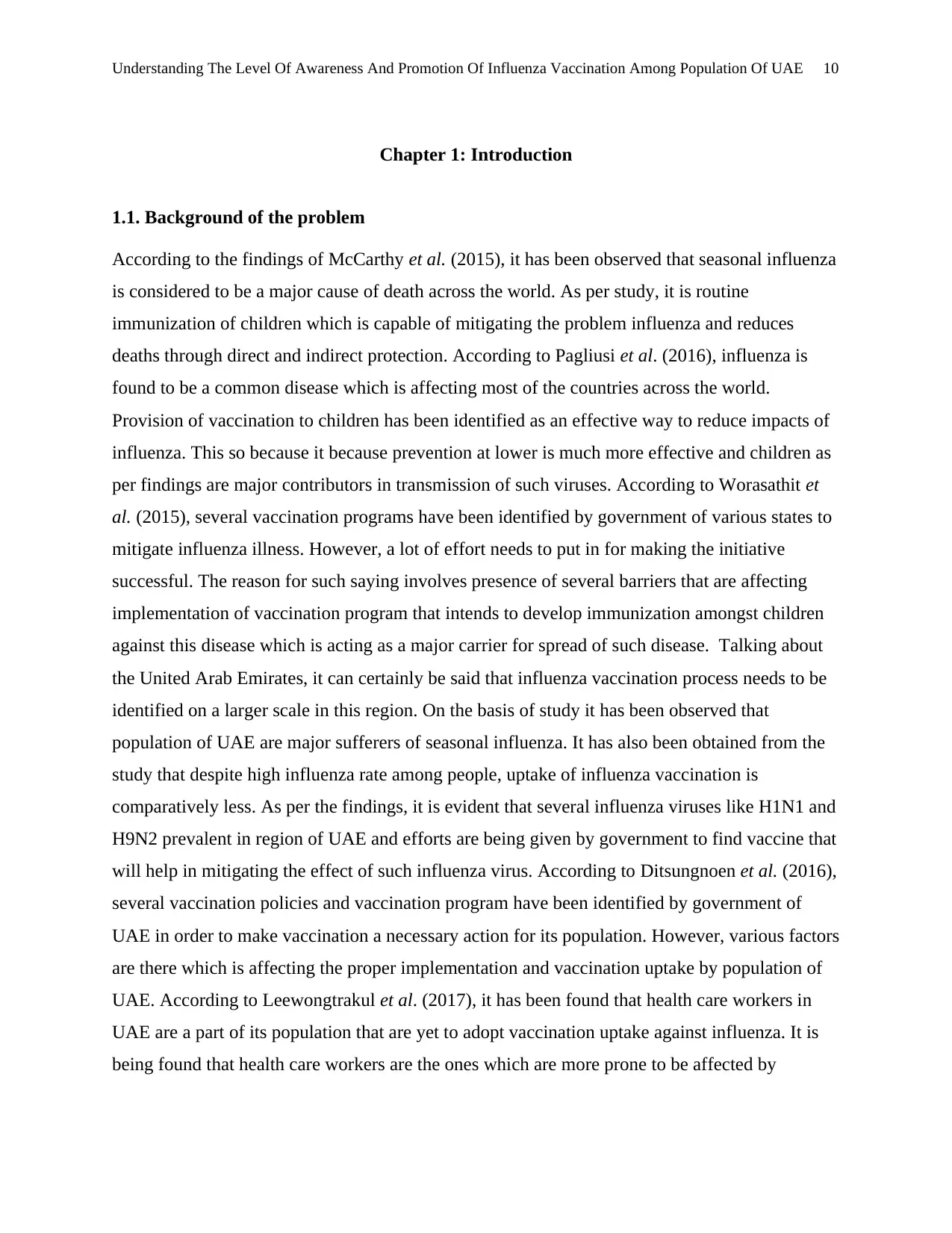
Understanding The Level Of Awareness And Promotion Of Influenza Vaccination Among Population Of UAE 10
Chapter 1: Introduction
1.1. Background of the problem
According to the findings of McCarthy et al. (2015), it has been observed that seasonal influenza
is considered to be a major cause of death across the world. As per study, it is routine
immunization of children which is capable of mitigating the problem influenza and reduces
deaths through direct and indirect protection. According to Pagliusi et al. (2016), influenza is
found to be a common disease which is affecting most of the countries across the world.
Provision of vaccination to children has been identified as an effective way to reduce impacts of
influenza. This so because it because prevention at lower is much more effective and children as
per findings are major contributors in transmission of such viruses. According to Worasathit et
al. (2015), several vaccination programs have been identified by government of various states to
mitigate influenza illness. However, a lot of effort needs to put in for making the initiative
successful. The reason for such saying involves presence of several barriers that are affecting
implementation of vaccination program that intends to develop immunization amongst children
against this disease which is acting as a major carrier for spread of such disease. Talking about
the United Arab Emirates, it can certainly be said that influenza vaccination process needs to be
identified on a larger scale in this region. On the basis of study it has been observed that
population of UAE are major sufferers of seasonal influenza. It has also been obtained from the
study that despite high influenza rate among people, uptake of influenza vaccination is
comparatively less. As per the findings, it is evident that several influenza viruses like H1N1 and
H9N2 prevalent in region of UAE and efforts are being given by government to find vaccine that
will help in mitigating the effect of such influenza virus. According to Ditsungnoen et al. (2016),
several vaccination policies and vaccination program have been identified by government of
UAE in order to make vaccination a necessary action for its population. However, various factors
are there which is affecting the proper implementation and vaccination uptake by population of
UAE. According to Leewongtrakul et al. (2017), it has been found that health care workers in
UAE are a part of its population that are yet to adopt vaccination uptake against influenza. It is
being found that health care workers are the ones which are more prone to be affected by
Chapter 1: Introduction
1.1. Background of the problem
According to the findings of McCarthy et al. (2015), it has been observed that seasonal influenza
is considered to be a major cause of death across the world. As per study, it is routine
immunization of children which is capable of mitigating the problem influenza and reduces
deaths through direct and indirect protection. According to Pagliusi et al. (2016), influenza is
found to be a common disease which is affecting most of the countries across the world.
Provision of vaccination to children has been identified as an effective way to reduce impacts of
influenza. This so because it because prevention at lower is much more effective and children as
per findings are major contributors in transmission of such viruses. According to Worasathit et
al. (2015), several vaccination programs have been identified by government of various states to
mitigate influenza illness. However, a lot of effort needs to put in for making the initiative
successful. The reason for such saying involves presence of several barriers that are affecting
implementation of vaccination program that intends to develop immunization amongst children
against this disease which is acting as a major carrier for spread of such disease. Talking about
the United Arab Emirates, it can certainly be said that influenza vaccination process needs to be
identified on a larger scale in this region. On the basis of study it has been observed that
population of UAE are major sufferers of seasonal influenza. It has also been obtained from the
study that despite high influenza rate among people, uptake of influenza vaccination is
comparatively less. As per the findings, it is evident that several influenza viruses like H1N1 and
H9N2 prevalent in region of UAE and efforts are being given by government to find vaccine that
will help in mitigating the effect of such influenza virus. According to Ditsungnoen et al. (2016),
several vaccination policies and vaccination program have been identified by government of
UAE in order to make vaccination a necessary action for its population. However, various factors
are there which is affecting the proper implementation and vaccination uptake by population of
UAE. According to Leewongtrakul et al. (2017), it has been found that health care workers in
UAE are a part of its population that are yet to adopt vaccination uptake against influenza. It is
being found that health care workers are the ones which are more prone to be affected by
Paraphrase This Document
Need a fresh take? Get an instant paraphrase of this document with our AI Paraphraser
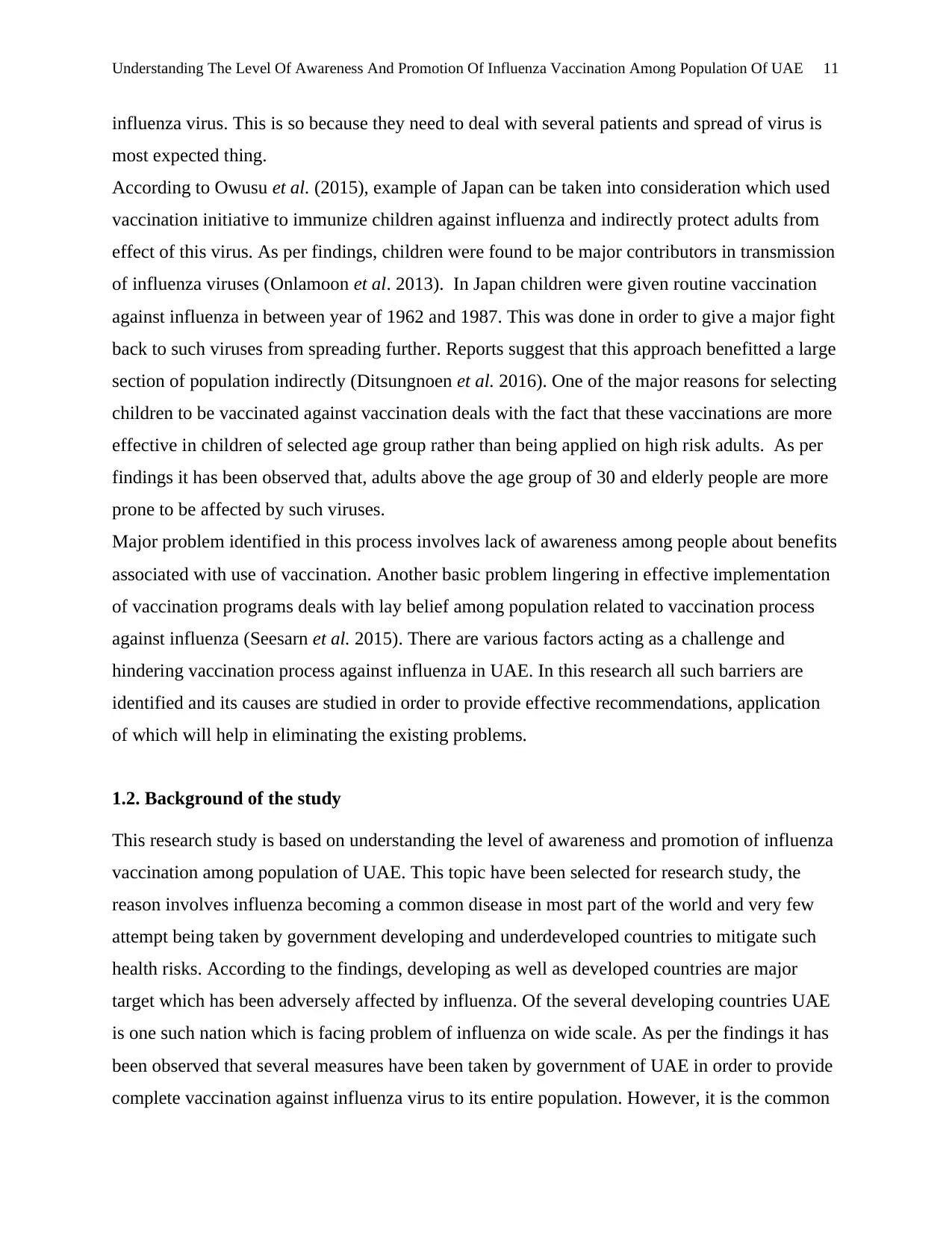
Understanding The Level Of Awareness And Promotion Of Influenza Vaccination Among Population Of UAE 11
influenza virus. This is so because they need to deal with several patients and spread of virus is
most expected thing.
According to Owusu et al. (2015), example of Japan can be taken into consideration which used
vaccination initiative to immunize children against influenza and indirectly protect adults from
effect of this virus. As per findings, children were found to be major contributors in transmission
of influenza viruses (Onlamoon et al. 2013). In Japan children were given routine vaccination
against influenza in between year of 1962 and 1987. This was done in order to give a major fight
back to such viruses from spreading further. Reports suggest that this approach benefitted a large
section of population indirectly (Ditsungnoen et al. 2016). One of the major reasons for selecting
children to be vaccinated against vaccination deals with the fact that these vaccinations are more
effective in children of selected age group rather than being applied on high risk adults. As per
findings it has been observed that, adults above the age group of 30 and elderly people are more
prone to be affected by such viruses.
Major problem identified in this process involves lack of awareness among people about benefits
associated with use of vaccination. Another basic problem lingering in effective implementation
of vaccination programs deals with lay belief among population related to vaccination process
against influenza (Seesarn et al. 2015). There are various factors acting as a challenge and
hindering vaccination process against influenza in UAE. In this research all such barriers are
identified and its causes are studied in order to provide effective recommendations, application
of which will help in eliminating the existing problems.
1.2. Background of the study
This research study is based on understanding the level of awareness and promotion of influenza
vaccination among population of UAE. This topic have been selected for research study, the
reason involves influenza becoming a common disease in most part of the world and very few
attempt being taken by government developing and underdeveloped countries to mitigate such
health risks. According to the findings, developing as well as developed countries are major
target which has been adversely affected by influenza. Of the several developing countries UAE
is one such nation which is facing problem of influenza on wide scale. As per the findings it has
been observed that several measures have been taken by government of UAE in order to provide
complete vaccination against influenza virus to its entire population. However, it is the common
influenza virus. This is so because they need to deal with several patients and spread of virus is
most expected thing.
According to Owusu et al. (2015), example of Japan can be taken into consideration which used
vaccination initiative to immunize children against influenza and indirectly protect adults from
effect of this virus. As per findings, children were found to be major contributors in transmission
of influenza viruses (Onlamoon et al. 2013). In Japan children were given routine vaccination
against influenza in between year of 1962 and 1987. This was done in order to give a major fight
back to such viruses from spreading further. Reports suggest that this approach benefitted a large
section of population indirectly (Ditsungnoen et al. 2016). One of the major reasons for selecting
children to be vaccinated against vaccination deals with the fact that these vaccinations are more
effective in children of selected age group rather than being applied on high risk adults. As per
findings it has been observed that, adults above the age group of 30 and elderly people are more
prone to be affected by such viruses.
Major problem identified in this process involves lack of awareness among people about benefits
associated with use of vaccination. Another basic problem lingering in effective implementation
of vaccination programs deals with lay belief among population related to vaccination process
against influenza (Seesarn et al. 2015). There are various factors acting as a challenge and
hindering vaccination process against influenza in UAE. In this research all such barriers are
identified and its causes are studied in order to provide effective recommendations, application
of which will help in eliminating the existing problems.
1.2. Background of the study
This research study is based on understanding the level of awareness and promotion of influenza
vaccination among population of UAE. This topic have been selected for research study, the
reason involves influenza becoming a common disease in most part of the world and very few
attempt being taken by government developing and underdeveloped countries to mitigate such
health risks. According to the findings, developing as well as developed countries are major
target which has been adversely affected by influenza. Of the several developing countries UAE
is one such nation which is facing problem of influenza on wide scale. As per the findings it has
been observed that several measures have been taken by government of UAE in order to provide
complete vaccination against influenza virus to its entire population. However, it is the common
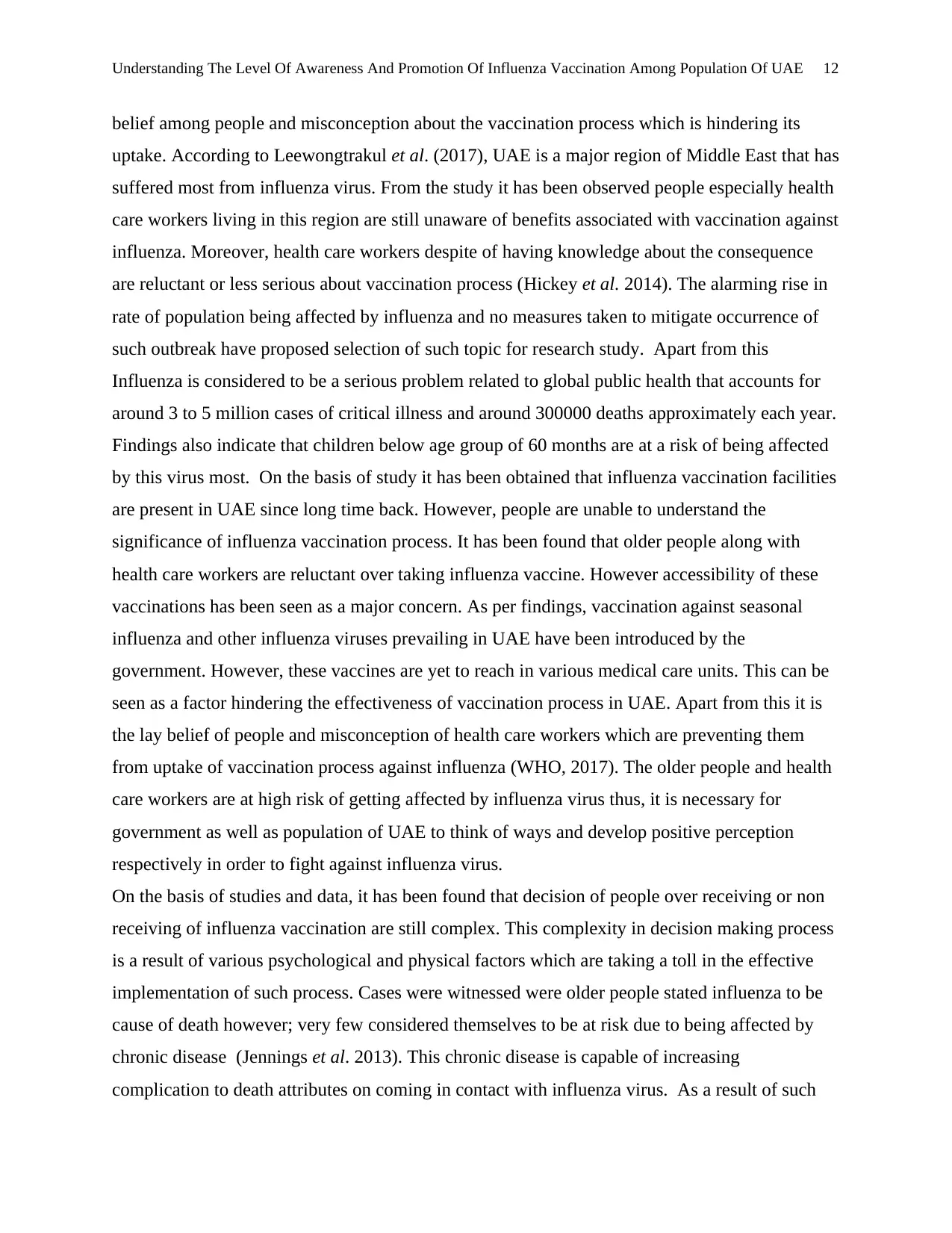
Understanding The Level Of Awareness And Promotion Of Influenza Vaccination Among Population Of UAE 12
belief among people and misconception about the vaccination process which is hindering its
uptake. According to Leewongtrakul et al. (2017), UAE is a major region of Middle East that has
suffered most from influenza virus. From the study it has been observed people especially health
care workers living in this region are still unaware of benefits associated with vaccination against
influenza. Moreover, health care workers despite of having knowledge about the consequence
are reluctant or less serious about vaccination process (Hickey et al. 2014). The alarming rise in
rate of population being affected by influenza and no measures taken to mitigate occurrence of
such outbreak have proposed selection of such topic for research study. Apart from this
Influenza is considered to be a serious problem related to global public health that accounts for
around 3 to 5 million cases of critical illness and around 300000 deaths approximately each year.
Findings also indicate that children below age group of 60 months are at a risk of being affected
by this virus most. On the basis of study it has been obtained that influenza vaccination facilities
are present in UAE since long time back. However, people are unable to understand the
significance of influenza vaccination process. It has been found that older people along with
health care workers are reluctant over taking influenza vaccine. However accessibility of these
vaccinations has been seen as a major concern. As per findings, vaccination against seasonal
influenza and other influenza viruses prevailing in UAE have been introduced by the
government. However, these vaccines are yet to reach in various medical care units. This can be
seen as a factor hindering the effectiveness of vaccination process in UAE. Apart from this it is
the lay belief of people and misconception of health care workers which are preventing them
from uptake of vaccination process against influenza (WHO, 2017). The older people and health
care workers are at high risk of getting affected by influenza virus thus, it is necessary for
government as well as population of UAE to think of ways and develop positive perception
respectively in order to fight against influenza virus.
On the basis of studies and data, it has been found that decision of people over receiving or non
receiving of influenza vaccination are still complex. This complexity in decision making process
is a result of various psychological and physical factors which are taking a toll in the effective
implementation of such process. Cases were witnessed were older people stated influenza to be
cause of death however; very few considered themselves to be at risk due to being affected by
chronic disease (Jennings et al. 2013). This chronic disease is capable of increasing
complication to death attributes on coming in contact with influenza virus. As a result of such
belief among people and misconception about the vaccination process which is hindering its
uptake. According to Leewongtrakul et al. (2017), UAE is a major region of Middle East that has
suffered most from influenza virus. From the study it has been observed people especially health
care workers living in this region are still unaware of benefits associated with vaccination against
influenza. Moreover, health care workers despite of having knowledge about the consequence
are reluctant or less serious about vaccination process (Hickey et al. 2014). The alarming rise in
rate of population being affected by influenza and no measures taken to mitigate occurrence of
such outbreak have proposed selection of such topic for research study. Apart from this
Influenza is considered to be a serious problem related to global public health that accounts for
around 3 to 5 million cases of critical illness and around 300000 deaths approximately each year.
Findings also indicate that children below age group of 60 months are at a risk of being affected
by this virus most. On the basis of study it has been obtained that influenza vaccination facilities
are present in UAE since long time back. However, people are unable to understand the
significance of influenza vaccination process. It has been found that older people along with
health care workers are reluctant over taking influenza vaccine. However accessibility of these
vaccinations has been seen as a major concern. As per findings, vaccination against seasonal
influenza and other influenza viruses prevailing in UAE have been introduced by the
government. However, these vaccines are yet to reach in various medical care units. This can be
seen as a factor hindering the effectiveness of vaccination process in UAE. Apart from this it is
the lay belief of people and misconception of health care workers which are preventing them
from uptake of vaccination process against influenza (WHO, 2017). The older people and health
care workers are at high risk of getting affected by influenza virus thus, it is necessary for
government as well as population of UAE to think of ways and develop positive perception
respectively in order to fight against influenza virus.
On the basis of studies and data, it has been found that decision of people over receiving or non
receiving of influenza vaccination are still complex. This complexity in decision making process
is a result of various psychological and physical factors which are taking a toll in the effective
implementation of such process. Cases were witnessed were older people stated influenza to be
cause of death however; very few considered themselves to be at risk due to being affected by
chronic disease (Jennings et al. 2013). This chronic disease is capable of increasing
complication to death attributes on coming in contact with influenza virus. As a result of such

Understanding The Level Of Awareness And Promotion Of Influenza Vaccination Among Population Of UAE 13
lay belief many people are becoming reluctant towards receiving of vaccination against
influenza. This is causing a major setback in government's attempt to protect its population from
deadly viruses like influenza.
lay belief many people are becoming reluctant towards receiving of vaccination against
influenza. This is causing a major setback in government's attempt to protect its population from
deadly viruses like influenza.
Secure Best Marks with AI Grader
Need help grading? Try our AI Grader for instant feedback on your assignments.
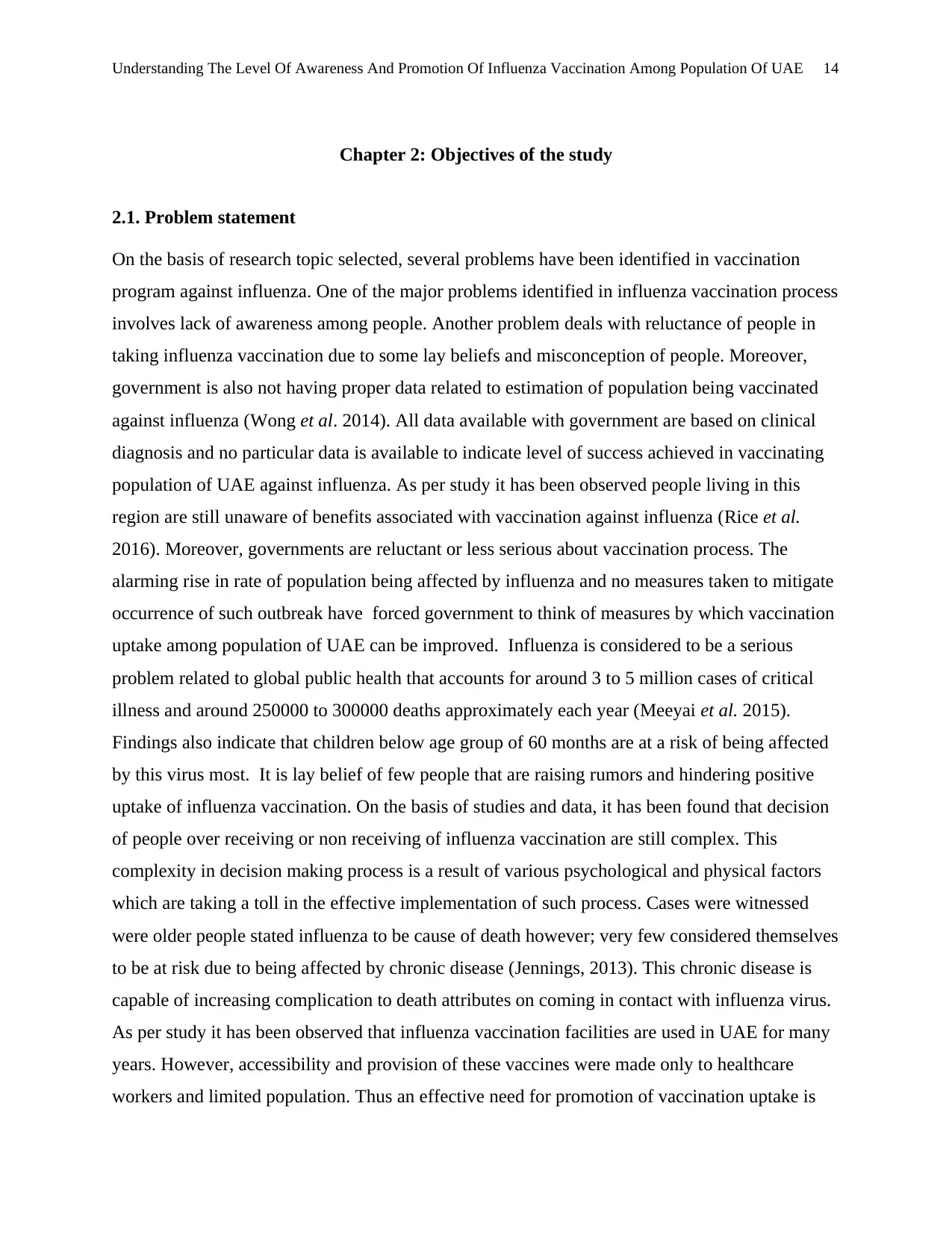
Understanding The Level Of Awareness And Promotion Of Influenza Vaccination Among Population Of UAE 14
Chapter 2: Objectives of the study
2.1. Problem statement
On the basis of research topic selected, several problems have been identified in vaccination
program against influenza. One of the major problems identified in influenza vaccination process
involves lack of awareness among people. Another problem deals with reluctance of people in
taking influenza vaccination due to some lay beliefs and misconception of people. Moreover,
government is also not having proper data related to estimation of population being vaccinated
against influenza (Wong et al. 2014). All data available with government are based on clinical
diagnosis and no particular data is available to indicate level of success achieved in vaccinating
population of UAE against influenza. As per study it has been observed people living in this
region are still unaware of benefits associated with vaccination against influenza (Rice et al.
2016). Moreover, governments are reluctant or less serious about vaccination process. The
alarming rise in rate of population being affected by influenza and no measures taken to mitigate
occurrence of such outbreak have forced government to think of measures by which vaccination
uptake among population of UAE can be improved. Influenza is considered to be a serious
problem related to global public health that accounts for around 3 to 5 million cases of critical
illness and around 250000 to 300000 deaths approximately each year (Meeyai et al. 2015).
Findings also indicate that children below age group of 60 months are at a risk of being affected
by this virus most. It is lay belief of few people that are raising rumors and hindering positive
uptake of influenza vaccination. On the basis of studies and data, it has been found that decision
of people over receiving or non receiving of influenza vaccination are still complex. This
complexity in decision making process is a result of various psychological and physical factors
which are taking a toll in the effective implementation of such process. Cases were witnessed
were older people stated influenza to be cause of death however; very few considered themselves
to be at risk due to being affected by chronic disease (Jennings, 2013). This chronic disease is
capable of increasing complication to death attributes on coming in contact with influenza virus.
As per study it has been observed that influenza vaccination facilities are used in UAE for many
years. However, accessibility and provision of these vaccines were made only to healthcare
workers and limited population. Thus an effective need for promotion of vaccination uptake is
Chapter 2: Objectives of the study
2.1. Problem statement
On the basis of research topic selected, several problems have been identified in vaccination
program against influenza. One of the major problems identified in influenza vaccination process
involves lack of awareness among people. Another problem deals with reluctance of people in
taking influenza vaccination due to some lay beliefs and misconception of people. Moreover,
government is also not having proper data related to estimation of population being vaccinated
against influenza (Wong et al. 2014). All data available with government are based on clinical
diagnosis and no particular data is available to indicate level of success achieved in vaccinating
population of UAE against influenza. As per study it has been observed people living in this
region are still unaware of benefits associated with vaccination against influenza (Rice et al.
2016). Moreover, governments are reluctant or less serious about vaccination process. The
alarming rise in rate of population being affected by influenza and no measures taken to mitigate
occurrence of such outbreak have forced government to think of measures by which vaccination
uptake among population of UAE can be improved. Influenza is considered to be a serious
problem related to global public health that accounts for around 3 to 5 million cases of critical
illness and around 250000 to 300000 deaths approximately each year (Meeyai et al. 2015).
Findings also indicate that children below age group of 60 months are at a risk of being affected
by this virus most. It is lay belief of few people that are raising rumors and hindering positive
uptake of influenza vaccination. On the basis of studies and data, it has been found that decision
of people over receiving or non receiving of influenza vaccination are still complex. This
complexity in decision making process is a result of various psychological and physical factors
which are taking a toll in the effective implementation of such process. Cases were witnessed
were older people stated influenza to be cause of death however; very few considered themselves
to be at risk due to being affected by chronic disease (Jennings, 2013). This chronic disease is
capable of increasing complication to death attributes on coming in contact with influenza virus.
As per study it has been observed that influenza vaccination facilities are used in UAE for many
years. However, accessibility and provision of these vaccines were made only to healthcare
workers and limited population. Thus an effective need for promotion of vaccination uptake is

Understanding The Level Of Awareness And Promotion Of Influenza Vaccination Among Population Of UAE 15
being seen in this case that needs to apply as soon as possible in order to prevent further damage
to public health.
2.2. Objectives of the study
Aim of the research
The aim of this research will deal with the determination of the level of awareness among
population of UAE over influenza vaccination. It would also deal with identification of the issues
that are hindering successful implementation of vaccination program in UAE. The research aim
determined will help in understanding the factors which are hindering successful promotion of
vaccination programs and adding challenges in proper availability of influenza vaccination to
children of UAE. The influenza vaccination program needs to be identified on a wider scale in
this region. On the basis of study it has been observed that H1N1 virus has affected many
countries including Thailand, Indonesia and several Middle East countries like UAE. The affect
of H1N1 was more in Bangkok and Indonesia. However several cases where found to be dealing
with H1N1 influenza virus in UAE also. As a result of this several people lost their lives and
nation went on emergency alert in order to prevent outbreak of such dangerous virus. According
to Jennings (2013), several vaccination programs and initiatives were identified by government
of UAE for preventing further spread of such influenza viruses. As per findings, children
belonging to 6months to 3 years of age group were to be vaccinated along with adults’ in order to
prevent them from being affected by the virus. However, it has been found that this attempt of
government was partially successful due to the lay belief among older people thinking that
vaccination against influenza is the main cause of death over several cases identified.
Objective of research
On the basis of research topic selected, following objectives have been identified by the
researcher in order to achieve goals determined for this study:
● To identify the present scenario of influenza vaccination among population of UAE
● To identify the challenges which are hindering vaccination programs in UAE
● To understand the perception of people over influenza and influenza vaccination
programs
● To identify the risks associated with improper influenza vaccination facility to children of
UAE
being seen in this case that needs to apply as soon as possible in order to prevent further damage
to public health.
2.2. Objectives of the study
Aim of the research
The aim of this research will deal with the determination of the level of awareness among
population of UAE over influenza vaccination. It would also deal with identification of the issues
that are hindering successful implementation of vaccination program in UAE. The research aim
determined will help in understanding the factors which are hindering successful promotion of
vaccination programs and adding challenges in proper availability of influenza vaccination to
children of UAE. The influenza vaccination program needs to be identified on a wider scale in
this region. On the basis of study it has been observed that H1N1 virus has affected many
countries including Thailand, Indonesia and several Middle East countries like UAE. The affect
of H1N1 was more in Bangkok and Indonesia. However several cases where found to be dealing
with H1N1 influenza virus in UAE also. As a result of this several people lost their lives and
nation went on emergency alert in order to prevent outbreak of such dangerous virus. According
to Jennings (2013), several vaccination programs and initiatives were identified by government
of UAE for preventing further spread of such influenza viruses. As per findings, children
belonging to 6months to 3 years of age group were to be vaccinated along with adults’ in order to
prevent them from being affected by the virus. However, it has been found that this attempt of
government was partially successful due to the lay belief among older people thinking that
vaccination against influenza is the main cause of death over several cases identified.
Objective of research
On the basis of research topic selected, following objectives have been identified by the
researcher in order to achieve goals determined for this study:
● To identify the present scenario of influenza vaccination among population of UAE
● To identify the challenges which are hindering vaccination programs in UAE
● To understand the perception of people over influenza and influenza vaccination
programs
● To identify the risks associated with improper influenza vaccination facility to children of
UAE
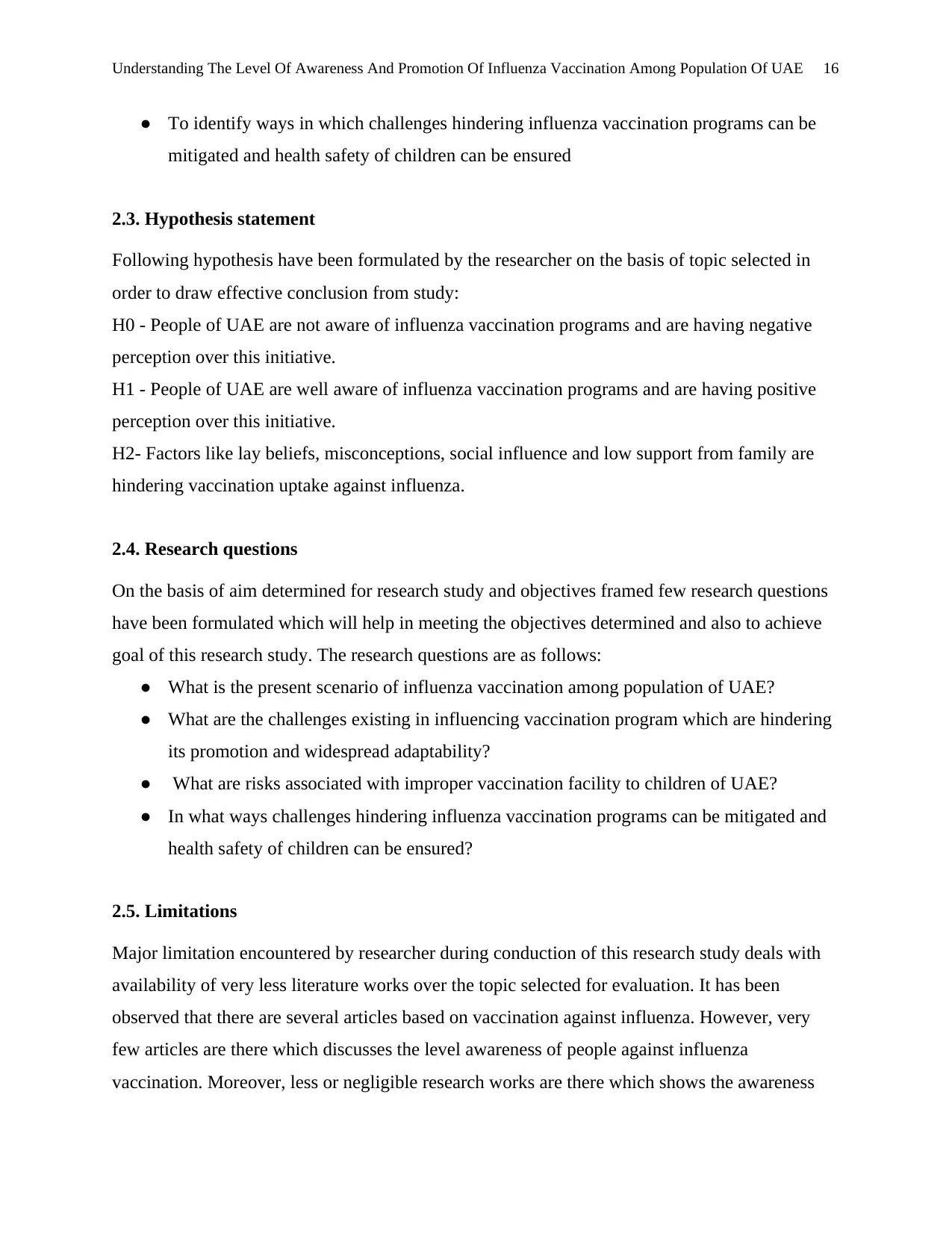
Understanding The Level Of Awareness And Promotion Of Influenza Vaccination Among Population Of UAE 16
● To identify ways in which challenges hindering influenza vaccination programs can be
mitigated and health safety of children can be ensured
2.3. Hypothesis statement
Following hypothesis have been formulated by the researcher on the basis of topic selected in
order to draw effective conclusion from study:
H0 - People of UAE are not aware of influenza vaccination programs and are having negative
perception over this initiative.
H1 - People of UAE are well aware of influenza vaccination programs and are having positive
perception over this initiative.
H2- Factors like lay beliefs, misconceptions, social influence and low support from family are
hindering vaccination uptake against influenza.
2.4. Research questions
On the basis of aim determined for research study and objectives framed few research questions
have been formulated which will help in meeting the objectives determined and also to achieve
goal of this research study. The research questions are as follows:
● What is the present scenario of influenza vaccination among population of UAE?
● What are the challenges existing in influencing vaccination program which are hindering
its promotion and widespread adaptability?
● What are risks associated with improper vaccination facility to children of UAE?
● In what ways challenges hindering influenza vaccination programs can be mitigated and
health safety of children can be ensured?
2.5. Limitations
Major limitation encountered by researcher during conduction of this research study deals with
availability of very less literature works over the topic selected for evaluation. It has been
observed that there are several articles based on vaccination against influenza. However, very
few articles are there which discusses the level awareness of people against influenza
vaccination. Moreover, less or negligible research works are there which shows the awareness
● To identify ways in which challenges hindering influenza vaccination programs can be
mitigated and health safety of children can be ensured
2.3. Hypothesis statement
Following hypothesis have been formulated by the researcher on the basis of topic selected in
order to draw effective conclusion from study:
H0 - People of UAE are not aware of influenza vaccination programs and are having negative
perception over this initiative.
H1 - People of UAE are well aware of influenza vaccination programs and are having positive
perception over this initiative.
H2- Factors like lay beliefs, misconceptions, social influence and low support from family are
hindering vaccination uptake against influenza.
2.4. Research questions
On the basis of aim determined for research study and objectives framed few research questions
have been formulated which will help in meeting the objectives determined and also to achieve
goal of this research study. The research questions are as follows:
● What is the present scenario of influenza vaccination among population of UAE?
● What are the challenges existing in influencing vaccination program which are hindering
its promotion and widespread adaptability?
● What are risks associated with improper vaccination facility to children of UAE?
● In what ways challenges hindering influenza vaccination programs can be mitigated and
health safety of children can be ensured?
2.5. Limitations
Major limitation encountered by researcher during conduction of this research study deals with
availability of very less literature works over the topic selected for evaluation. It has been
observed that there are several articles based on vaccination against influenza. However, very
few articles are there which discusses the level awareness of people against influenza
vaccination. Moreover, less or negligible research works are there which shows the awareness
Paraphrase This Document
Need a fresh take? Get an instant paraphrase of this document with our AI Paraphraser
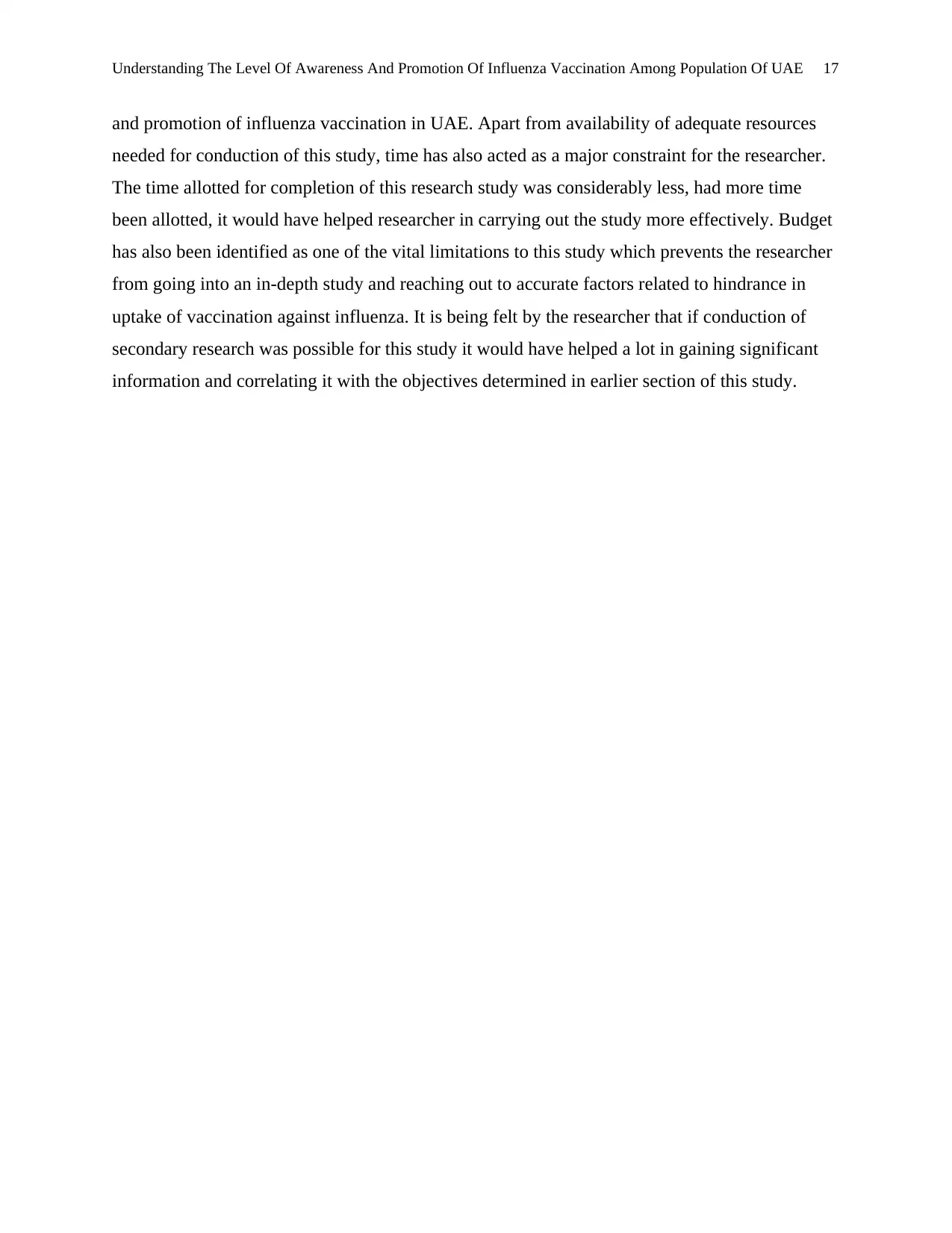
Understanding The Level Of Awareness And Promotion Of Influenza Vaccination Among Population Of UAE 17
and promotion of influenza vaccination in UAE. Apart from availability of adequate resources
needed for conduction of this study, time has also acted as a major constraint for the researcher.
The time allotted for completion of this research study was considerably less, had more time
been allotted, it would have helped researcher in carrying out the study more effectively. Budget
has also been identified as one of the vital limitations to this study which prevents the researcher
from going into an in-depth study and reaching out to accurate factors related to hindrance in
uptake of vaccination against influenza. It is being felt by the researcher that if conduction of
secondary research was possible for this study it would have helped a lot in gaining significant
information and correlating it with the objectives determined in earlier section of this study.
and promotion of influenza vaccination in UAE. Apart from availability of adequate resources
needed for conduction of this study, time has also acted as a major constraint for the researcher.
The time allotted for completion of this research study was considerably less, had more time
been allotted, it would have helped researcher in carrying out the study more effectively. Budget
has also been identified as one of the vital limitations to this study which prevents the researcher
from going into an in-depth study and reaching out to accurate factors related to hindrance in
uptake of vaccination against influenza. It is being felt by the researcher that if conduction of
secondary research was possible for this study it would have helped a lot in gaining significant
information and correlating it with the objectives determined in earlier section of this study.

Understanding The Level Of Awareness And Promotion Of Influenza Vaccination Among Population Of UAE 18
Chapter 3 Literature review
3.1. Chapter introduction
In this chapter of research, the researcher has reviewed the existing literature works in terms of
existing data related to vaccination uptake and perception of people. This is done to help
researcher in getting in depth knowledge about the entire scenario of UAE based on vaccination
program. Proper analysis of literature articles has enabled the researcher in identifying the issues
which are affecting the accessibility and provision of vaccination facilities against influenza to
population of UAE. In this chapter focus has been given by researcher over importance of
vaccination against influenza and the issues which are affecting its adoption among children and
high risk adults. This chapter is considered to be an essential part of research study as it helps in
analysis of previously done researches over this study. Through which a new platform is
generated for current research study to be conducted. This chapter sticks to the aim and objective
determined for this research in order to understand the awareness level among people of UAE
against influenza vaccine and to identify the factors which are affecting its effectiveness over
promotion and adoption. Taking help of literature review researcher is able compare the
historical context with present context that is associated with research topic. This chapter
provides an in depth knowledge about the research topic selected and helps in carrying the
research study ahead in an effective manner.
3.2 Significance of Influenza Vaccination
As per the findings of Nowak et al. (2015), it has been observed that influenza remains to be one
of the major concerns in most of the countries. It is a very serious disease that having impact on
public health and in extreme cases it causes rise in mortality, morbidity and hospitalization rate.
On the basis of study it has been observed that older people are more prone to be affected by
influenza viruses. Effects are adverse on older people that are having chronic disease as it leads
development of several complications which cause severe illness and also causes death. On the
basis of record from CDC or Centres for Disease Control and Prevention, it has been obtained
that during regular flu season around 90Number ofpeople affected by this virus suffered death.
Of the people who died due to impact of this virus most of them were elderly people belonging
Chapter 3 Literature review
3.1. Chapter introduction
In this chapter of research, the researcher has reviewed the existing literature works in terms of
existing data related to vaccination uptake and perception of people. This is done to help
researcher in getting in depth knowledge about the entire scenario of UAE based on vaccination
program. Proper analysis of literature articles has enabled the researcher in identifying the issues
which are affecting the accessibility and provision of vaccination facilities against influenza to
population of UAE. In this chapter focus has been given by researcher over importance of
vaccination against influenza and the issues which are affecting its adoption among children and
high risk adults. This chapter is considered to be an essential part of research study as it helps in
analysis of previously done researches over this study. Through which a new platform is
generated for current research study to be conducted. This chapter sticks to the aim and objective
determined for this research in order to understand the awareness level among people of UAE
against influenza vaccine and to identify the factors which are affecting its effectiveness over
promotion and adoption. Taking help of literature review researcher is able compare the
historical context with present context that is associated with research topic. This chapter
provides an in depth knowledge about the research topic selected and helps in carrying the
research study ahead in an effective manner.
3.2 Significance of Influenza Vaccination
As per the findings of Nowak et al. (2015), it has been observed that influenza remains to be one
of the major concerns in most of the countries. It is a very serious disease that having impact on
public health and in extreme cases it causes rise in mortality, morbidity and hospitalization rate.
On the basis of study it has been observed that older people are more prone to be affected by
influenza viruses. Effects are adverse on older people that are having chronic disease as it leads
development of several complications which cause severe illness and also causes death. On the
basis of record from CDC or Centres for Disease Control and Prevention, it has been obtained
that during regular flu season around 90Number ofpeople affected by this virus suffered death.
Of the people who died due to impact of this virus most of them were elderly people belonging
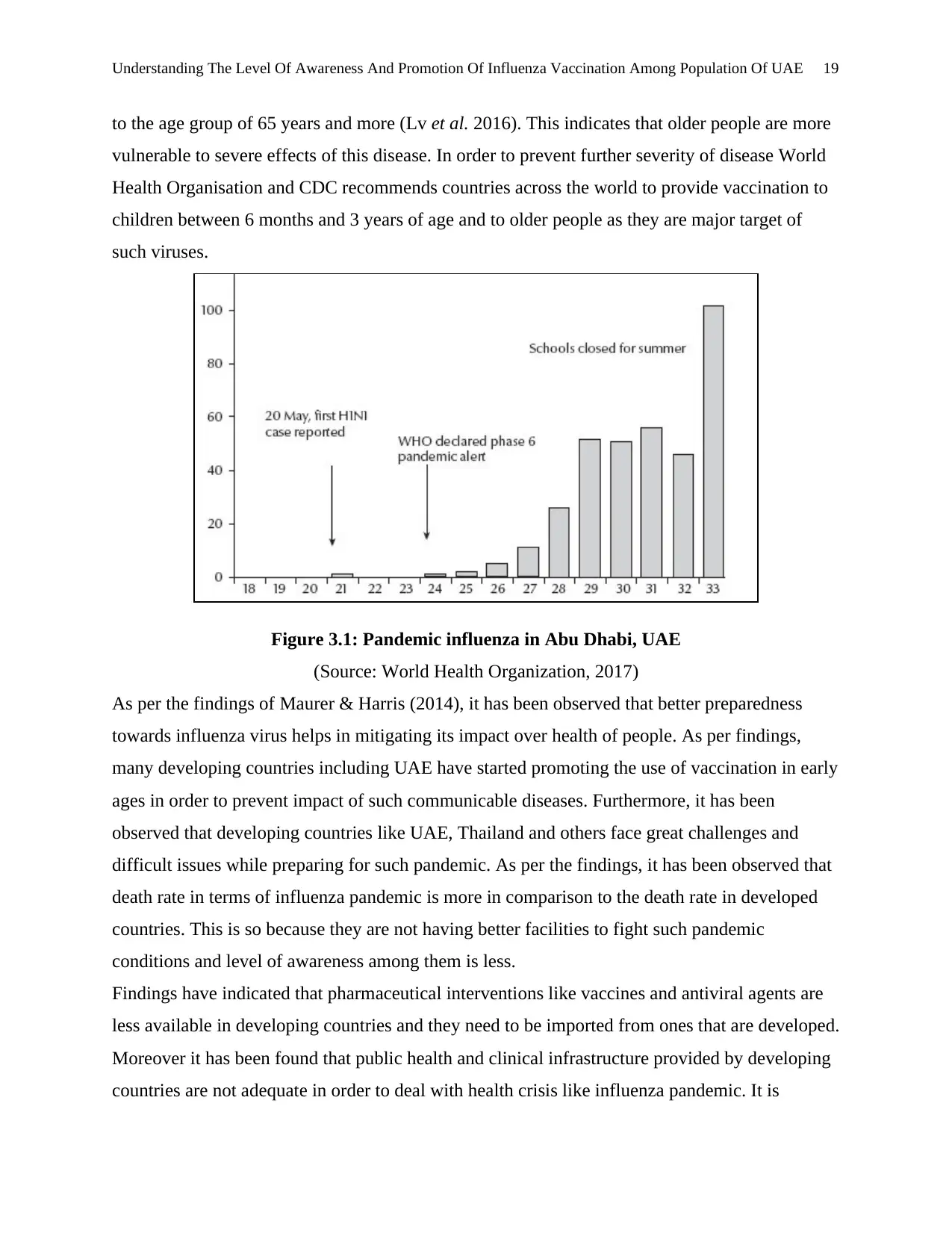
Understanding The Level Of Awareness And Promotion Of Influenza Vaccination Among Population Of UAE 19
to the age group of 65 years and more (Lv et al. 2016). This indicates that older people are more
vulnerable to severe effects of this disease. In order to prevent further severity of disease World
Health Organisation and CDC recommends countries across the world to provide vaccination to
children between 6 months and 3 years of age and to older people as they are major target of
such viruses.
Figure 3.1: Pandemic influenza in Abu Dhabi, UAE
(Source: World Health Organization, 2017)
As per the findings of Maurer & Harris (2014), it has been observed that better preparedness
towards influenza virus helps in mitigating its impact over health of people. As per findings,
many developing countries including UAE have started promoting the use of vaccination in early
ages in order to prevent impact of such communicable diseases. Furthermore, it has been
observed that developing countries like UAE, Thailand and others face great challenges and
difficult issues while preparing for such pandemic. As per the findings, it has been observed that
death rate in terms of influenza pandemic is more in comparison to the death rate in developed
countries. This is so because they are not having better facilities to fight such pandemic
conditions and level of awareness among them is less.
Findings have indicated that pharmaceutical interventions like vaccines and antiviral agents are
less available in developing countries and they need to be imported from ones that are developed.
Moreover it has been found that public health and clinical infrastructure provided by developing
countries are not adequate in order to deal with health crisis like influenza pandemic. It is
to the age group of 65 years and more (Lv et al. 2016). This indicates that older people are more
vulnerable to severe effects of this disease. In order to prevent further severity of disease World
Health Organisation and CDC recommends countries across the world to provide vaccination to
children between 6 months and 3 years of age and to older people as they are major target of
such viruses.
Figure 3.1: Pandemic influenza in Abu Dhabi, UAE
(Source: World Health Organization, 2017)
As per the findings of Maurer & Harris (2014), it has been observed that better preparedness
towards influenza virus helps in mitigating its impact over health of people. As per findings,
many developing countries including UAE have started promoting the use of vaccination in early
ages in order to prevent impact of such communicable diseases. Furthermore, it has been
observed that developing countries like UAE, Thailand and others face great challenges and
difficult issues while preparing for such pandemic. As per the findings, it has been observed that
death rate in terms of influenza pandemic is more in comparison to the death rate in developed
countries. This is so because they are not having better facilities to fight such pandemic
conditions and level of awareness among them is less.
Findings have indicated that pharmaceutical interventions like vaccines and antiviral agents are
less available in developing countries and they need to be imported from ones that are developed.
Moreover it has been found that public health and clinical infrastructure provided by developing
countries are not adequate in order to deal with health crisis like influenza pandemic. It is
Secure Best Marks with AI Grader
Need help grading? Try our AI Grader for instant feedback on your assignments.

Understanding The Level Of Awareness And Promotion Of Influenza Vaccination Among Population Of UAE 20
therefore becoming essential for developing countries to think of vaccination process at an early
age in order to deal with outbreak of such critical disease in future. Moreover it has been
observed that influenza virus H1N1 has impacted lives of several people in Middle East and is
still affecting children. The virus is getting transmitted from generation to generation due to
pregnant women being affected by such viruses. It is necessary to take effective measures
otherwise it can lead to functional complexity and disabilities in newly born child. Influenza
vaccination has found great significance in preventing children and high risk adults from being
affected by this disease. Apart from this H5N1 virus is also taking a toll over public health of
UAE as this virus are pandemic and are spreading rapidly. Vaccines have been identified and
provided to people for prevention of major outbreak. However, a considerable part of population
despite of government’s effort is yet to avail and understand the importance of vaccination
against such influenza viruses.
As per the comment of Lim & Seale (2014), influenza virus is getting transmitted from
generation to generation due to pregnant women being affected by such viruses. It is necessary to
take effective measures otherwise it can lead to functional complexity and disabilities in newly
born child. Influenza vaccination has found great significance in preventing children and high
risk adults from being affected by this disease. According to Chamberlain et al. (2014), several
vaccination programs have been identified by government of various states to mitigate influenza
illness. Uptake of vaccination is found to have reduced mortality and morbidity rate in several
countries to a considerable extent. As per findings, mortality and morbidity rate in Japan before
uptake of vaccination against influenza was found to be around 78% which has fallen down
sharply to 44%. The reason for estimate to be at 44% even after adaption to vaccination process
deals with the fact that there are certain elements which are hindering the performance of
vaccination over population. Few of the major factors responsible for hindrance in vaccination
uptake involve lay beliefs of people over use of vaccination against influenza. On the basis of
findings, vaccination process against influenza is found to be vital in both direct as well as
indirect ways.
As per the comment of Haq & McElhaney (2014), vaccination against influenza directly given to
children and elder people makes them immune to such disease. Moreover it has been observed
that this immunization process have an indirect impact on rest of the population. This is so
because it prevents spread of such viruses by making the host as well as transmitters of such
therefore becoming essential for developing countries to think of vaccination process at an early
age in order to deal with outbreak of such critical disease in future. Moreover it has been
observed that influenza virus H1N1 has impacted lives of several people in Middle East and is
still affecting children. The virus is getting transmitted from generation to generation due to
pregnant women being affected by such viruses. It is necessary to take effective measures
otherwise it can lead to functional complexity and disabilities in newly born child. Influenza
vaccination has found great significance in preventing children and high risk adults from being
affected by this disease. Apart from this H5N1 virus is also taking a toll over public health of
UAE as this virus are pandemic and are spreading rapidly. Vaccines have been identified and
provided to people for prevention of major outbreak. However, a considerable part of population
despite of government’s effort is yet to avail and understand the importance of vaccination
against such influenza viruses.
As per the comment of Lim & Seale (2014), influenza virus is getting transmitted from
generation to generation due to pregnant women being affected by such viruses. It is necessary to
take effective measures otherwise it can lead to functional complexity and disabilities in newly
born child. Influenza vaccination has found great significance in preventing children and high
risk adults from being affected by this disease. According to Chamberlain et al. (2014), several
vaccination programs have been identified by government of various states to mitigate influenza
illness. Uptake of vaccination is found to have reduced mortality and morbidity rate in several
countries to a considerable extent. As per findings, mortality and morbidity rate in Japan before
uptake of vaccination against influenza was found to be around 78% which has fallen down
sharply to 44%. The reason for estimate to be at 44% even after adaption to vaccination process
deals with the fact that there are certain elements which are hindering the performance of
vaccination over population. Few of the major factors responsible for hindrance in vaccination
uptake involve lay beliefs of people over use of vaccination against influenza. On the basis of
findings, vaccination process against influenza is found to be vital in both direct as well as
indirect ways.
As per the comment of Haq & McElhaney (2014), vaccination against influenza directly given to
children and elder people makes them immune to such disease. Moreover it has been observed
that this immunization process have an indirect impact on rest of the population. This is so
because it prevents spread of such viruses by making the host as well as transmitters of such
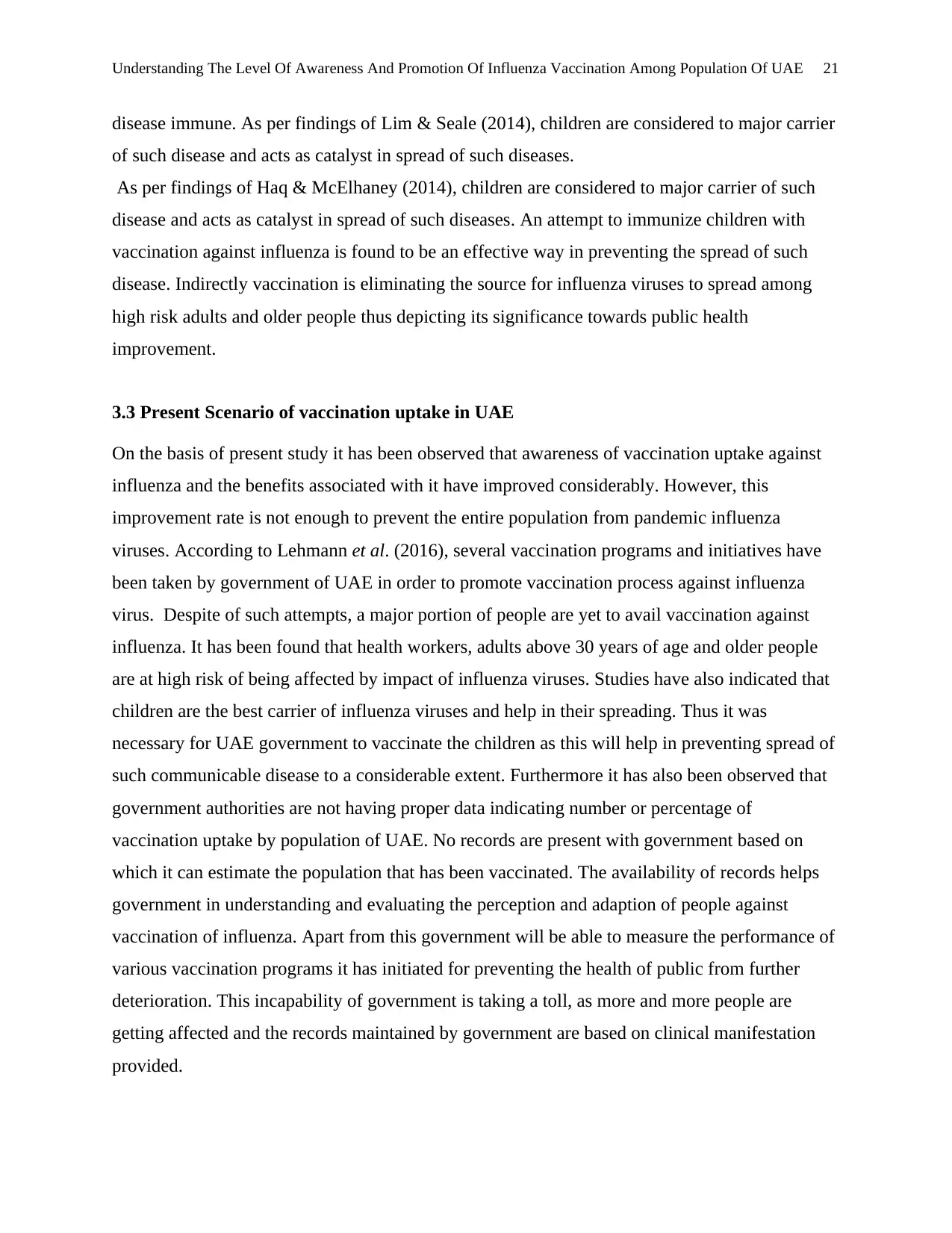
Understanding The Level Of Awareness And Promotion Of Influenza Vaccination Among Population Of UAE 21
disease immune. As per findings of Lim & Seale (2014), children are considered to major carrier
of such disease and acts as catalyst in spread of such diseases.
As per findings of Haq & McElhaney (2014), children are considered to major carrier of such
disease and acts as catalyst in spread of such diseases. An attempt to immunize children with
vaccination against influenza is found to be an effective way in preventing the spread of such
disease. Indirectly vaccination is eliminating the source for influenza viruses to spread among
high risk adults and older people thus depicting its significance towards public health
improvement.
3.3 Present Scenario of vaccination uptake in UAE
On the basis of present study it has been observed that awareness of vaccination uptake against
influenza and the benefits associated with it have improved considerably. However, this
improvement rate is not enough to prevent the entire population from pandemic influenza
viruses. According to Lehmann et al. (2016), several vaccination programs and initiatives have
been taken by government of UAE in order to promote vaccination process against influenza
virus. Despite of such attempts, a major portion of people are yet to avail vaccination against
influenza. It has been found that health workers, adults above 30 years of age and older people
are at high risk of being affected by impact of influenza viruses. Studies have also indicated that
children are the best carrier of influenza viruses and help in their spreading. Thus it was
necessary for UAE government to vaccinate the children as this will help in preventing spread of
such communicable disease to a considerable extent. Furthermore it has also been observed that
government authorities are not having proper data indicating number or percentage of
vaccination uptake by population of UAE. No records are present with government based on
which it can estimate the population that has been vaccinated. The availability of records helps
government in understanding and evaluating the perception and adaption of people against
vaccination of influenza. Apart from this government will be able to measure the performance of
various vaccination programs it has initiated for preventing the health of public from further
deterioration. This incapability of government is taking a toll, as more and more people are
getting affected and the records maintained by government are based on clinical manifestation
provided.
disease immune. As per findings of Lim & Seale (2014), children are considered to major carrier
of such disease and acts as catalyst in spread of such diseases.
As per findings of Haq & McElhaney (2014), children are considered to major carrier of such
disease and acts as catalyst in spread of such diseases. An attempt to immunize children with
vaccination against influenza is found to be an effective way in preventing the spread of such
disease. Indirectly vaccination is eliminating the source for influenza viruses to spread among
high risk adults and older people thus depicting its significance towards public health
improvement.
3.3 Present Scenario of vaccination uptake in UAE
On the basis of present study it has been observed that awareness of vaccination uptake against
influenza and the benefits associated with it have improved considerably. However, this
improvement rate is not enough to prevent the entire population from pandemic influenza
viruses. According to Lehmann et al. (2016), several vaccination programs and initiatives have
been taken by government of UAE in order to promote vaccination process against influenza
virus. Despite of such attempts, a major portion of people are yet to avail vaccination against
influenza. It has been found that health workers, adults above 30 years of age and older people
are at high risk of being affected by impact of influenza viruses. Studies have also indicated that
children are the best carrier of influenza viruses and help in their spreading. Thus it was
necessary for UAE government to vaccinate the children as this will help in preventing spread of
such communicable disease to a considerable extent. Furthermore it has also been observed that
government authorities are not having proper data indicating number or percentage of
vaccination uptake by population of UAE. No records are present with government based on
which it can estimate the population that has been vaccinated. The availability of records helps
government in understanding and evaluating the perception and adaption of people against
vaccination of influenza. Apart from this government will be able to measure the performance of
various vaccination programs it has initiated for preventing the health of public from further
deterioration. This incapability of government is taking a toll, as more and more people are
getting affected and the records maintained by government are based on clinical manifestation
provided.
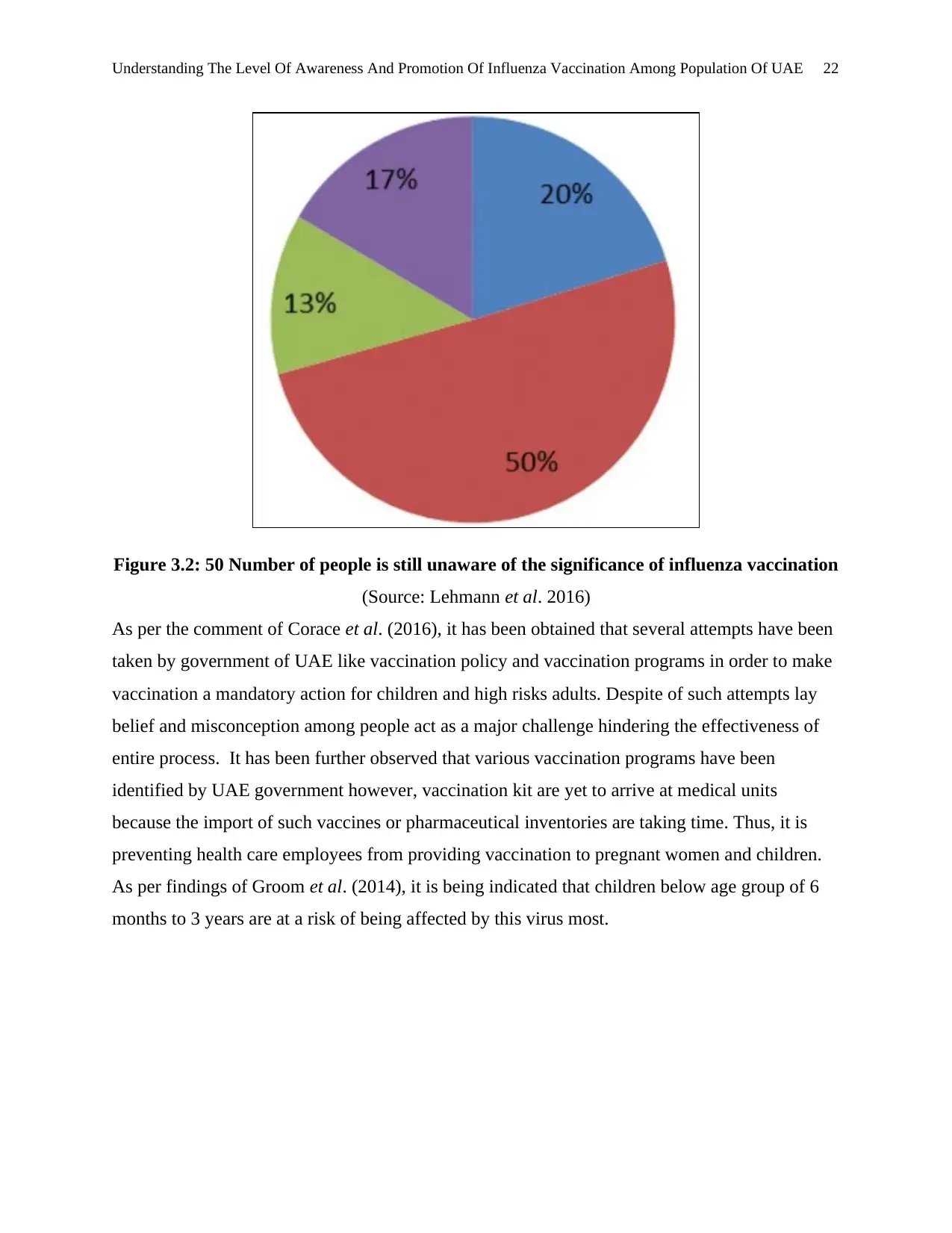
Understanding The Level Of Awareness And Promotion Of Influenza Vaccination Among Population Of UAE 22
Figure 3.2: 50 Number of people is still unaware of the significance of influenza vaccination
(Source: Lehmann et al. 2016)
As per the comment of Corace et al. (2016), it has been obtained that several attempts have been
taken by government of UAE like vaccination policy and vaccination programs in order to make
vaccination a mandatory action for children and high risks adults. Despite of such attempts lay
belief and misconception among people act as a major challenge hindering the effectiveness of
entire process. It has been further observed that various vaccination programs have been
identified by UAE government however, vaccination kit are yet to arrive at medical units
because the import of such vaccines or pharmaceutical inventories are taking time. Thus, it is
preventing health care employees from providing vaccination to pregnant women and children.
As per findings of Groom et al. (2014), it is being indicated that children below age group of 6
months to 3 years are at a risk of being affected by this virus most.
Figure 3.2: 50 Number of people is still unaware of the significance of influenza vaccination
(Source: Lehmann et al. 2016)
As per the comment of Corace et al. (2016), it has been obtained that several attempts have been
taken by government of UAE like vaccination policy and vaccination programs in order to make
vaccination a mandatory action for children and high risks adults. Despite of such attempts lay
belief and misconception among people act as a major challenge hindering the effectiveness of
entire process. It has been further observed that various vaccination programs have been
identified by UAE government however, vaccination kit are yet to arrive at medical units
because the import of such vaccines or pharmaceutical inventories are taking time. Thus, it is
preventing health care employees from providing vaccination to pregnant women and children.
As per findings of Groom et al. (2014), it is being indicated that children below age group of 6
months to 3 years are at a risk of being affected by this virus most.
Paraphrase This Document
Need a fresh take? Get an instant paraphrase of this document with our AI Paraphraser
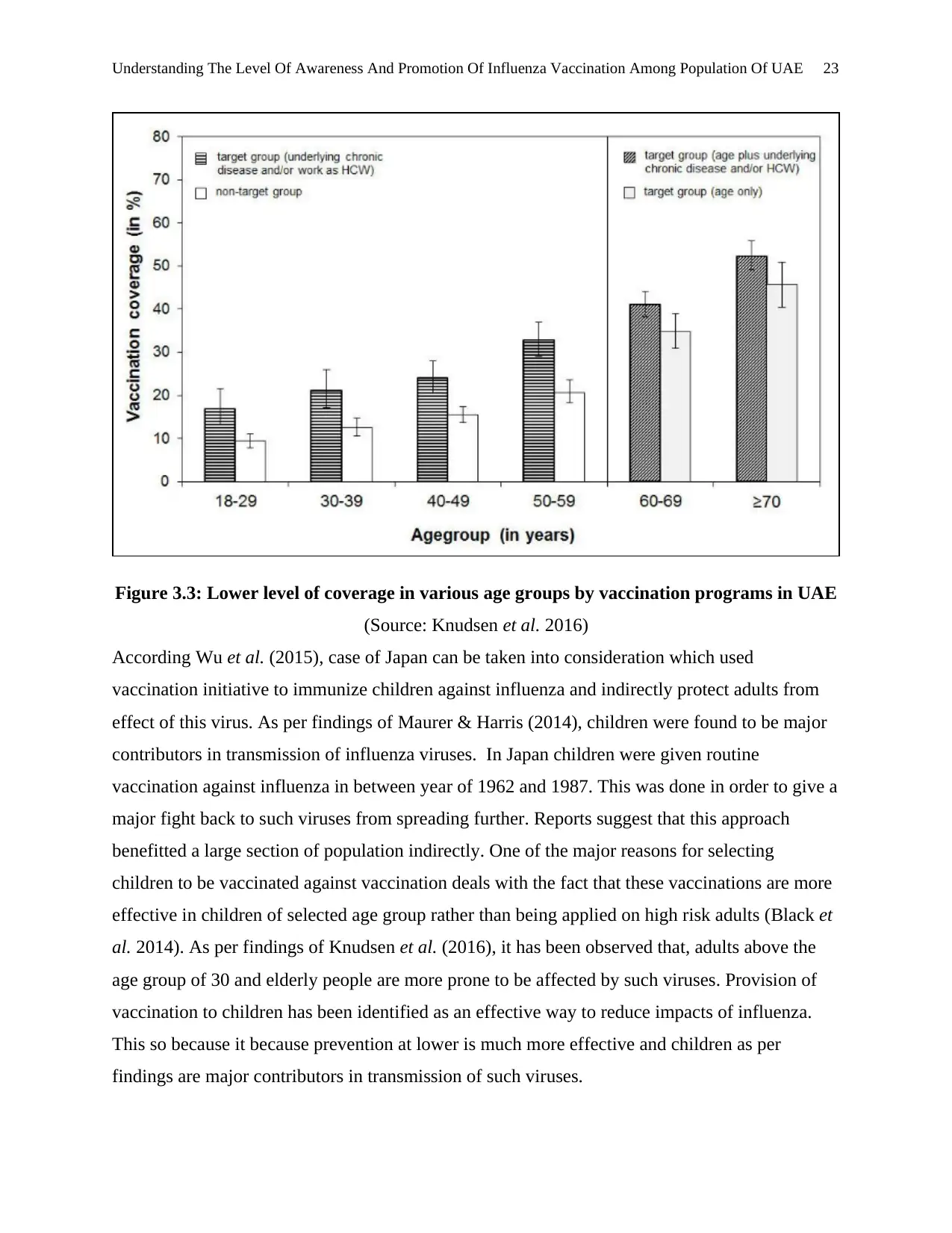
Understanding The Level Of Awareness And Promotion Of Influenza Vaccination Among Population Of UAE 23
Figure 3.3: Lower level of coverage in various age groups by vaccination programs in UAE
(Source: Knudsen et al. 2016)
According Wu et al. (2015), case of Japan can be taken into consideration which used
vaccination initiative to immunize children against influenza and indirectly protect adults from
effect of this virus. As per findings of Maurer & Harris (2014), children were found to be major
contributors in transmission of influenza viruses. In Japan children were given routine
vaccination against influenza in between year of 1962 and 1987. This was done in order to give a
major fight back to such viruses from spreading further. Reports suggest that this approach
benefitted a large section of population indirectly. One of the major reasons for selecting
children to be vaccinated against vaccination deals with the fact that these vaccinations are more
effective in children of selected age group rather than being applied on high risk adults (Black et
al. 2014). As per findings of Knudsen et al. (2016), it has been observed that, adults above the
age group of 30 and elderly people are more prone to be affected by such viruses. Provision of
vaccination to children has been identified as an effective way to reduce impacts of influenza.
This so because it because prevention at lower is much more effective and children as per
findings are major contributors in transmission of such viruses.
Figure 3.3: Lower level of coverage in various age groups by vaccination programs in UAE
(Source: Knudsen et al. 2016)
According Wu et al. (2015), case of Japan can be taken into consideration which used
vaccination initiative to immunize children against influenza and indirectly protect adults from
effect of this virus. As per findings of Maurer & Harris (2014), children were found to be major
contributors in transmission of influenza viruses. In Japan children were given routine
vaccination against influenza in between year of 1962 and 1987. This was done in order to give a
major fight back to such viruses from spreading further. Reports suggest that this approach
benefitted a large section of population indirectly. One of the major reasons for selecting
children to be vaccinated against vaccination deals with the fact that these vaccinations are more
effective in children of selected age group rather than being applied on high risk adults (Black et
al. 2014). As per findings of Knudsen et al. (2016), it has been observed that, adults above the
age group of 30 and elderly people are more prone to be affected by such viruses. Provision of
vaccination to children has been identified as an effective way to reduce impacts of influenza.
This so because it because prevention at lower is much more effective and children as per
findings are major contributors in transmission of such viruses.
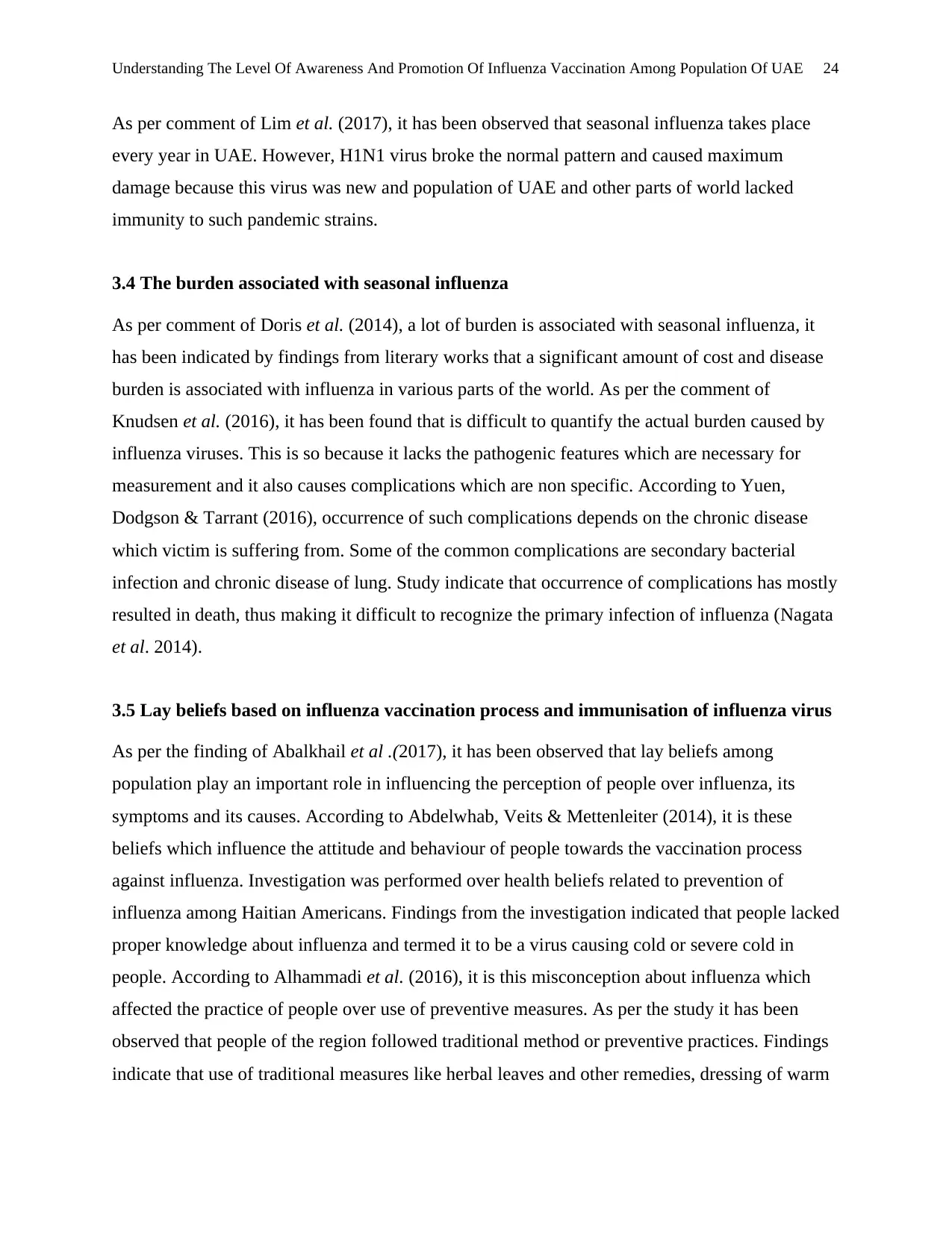
Understanding The Level Of Awareness And Promotion Of Influenza Vaccination Among Population Of UAE 24
As per comment of Lim et al. (2017), it has been observed that seasonal influenza takes place
every year in UAE. However, H1N1 virus broke the normal pattern and caused maximum
damage because this virus was new and population of UAE and other parts of world lacked
immunity to such pandemic strains.
3.4 The burden associated with seasonal influenza
As per comment of Doris et al. (2014), a lot of burden is associated with seasonal influenza, it
has been indicated by findings from literary works that a significant amount of cost and disease
burden is associated with influenza in various parts of the world. As per the comment of
Knudsen et al. (2016), it has been found that is difficult to quantify the actual burden caused by
influenza viruses. This is so because it lacks the pathogenic features which are necessary for
measurement and it also causes complications which are non specific. According to Yuen,
Dodgson & Tarrant (2016), occurrence of such complications depends on the chronic disease
which victim is suffering from. Some of the common complications are secondary bacterial
infection and chronic disease of lung. Study indicate that occurrence of complications has mostly
resulted in death, thus making it difficult to recognize the primary infection of influenza (Nagata
et al. 2014).
3.5 Lay beliefs based on influenza vaccination process and immunisation of influenza virus
As per the finding of Abalkhail et al .(2017), it has been observed that lay beliefs among
population play an important role in influencing the perception of people over influenza, its
symptoms and its causes. According to Abdelwhab, Veits & Mettenleiter (2014), it is these
beliefs which influence the attitude and behaviour of people towards the vaccination process
against influenza. Investigation was performed over health beliefs related to prevention of
influenza among Haitian Americans. Findings from the investigation indicated that people lacked
proper knowledge about influenza and termed it to be a virus causing cold or severe cold in
people. According to Alhammadi et al. (2016), it is this misconception about influenza which
affected the practice of people over use of preventive measures. As per the study it has been
observed that people of the region followed traditional method or preventive practices. Findings
indicate that use of traditional measures like herbal leaves and other remedies, dressing of warm
As per comment of Lim et al. (2017), it has been observed that seasonal influenza takes place
every year in UAE. However, H1N1 virus broke the normal pattern and caused maximum
damage because this virus was new and population of UAE and other parts of world lacked
immunity to such pandemic strains.
3.4 The burden associated with seasonal influenza
As per comment of Doris et al. (2014), a lot of burden is associated with seasonal influenza, it
has been indicated by findings from literary works that a significant amount of cost and disease
burden is associated with influenza in various parts of the world. As per the comment of
Knudsen et al. (2016), it has been found that is difficult to quantify the actual burden caused by
influenza viruses. This is so because it lacks the pathogenic features which are necessary for
measurement and it also causes complications which are non specific. According to Yuen,
Dodgson & Tarrant (2016), occurrence of such complications depends on the chronic disease
which victim is suffering from. Some of the common complications are secondary bacterial
infection and chronic disease of lung. Study indicate that occurrence of complications has mostly
resulted in death, thus making it difficult to recognize the primary infection of influenza (Nagata
et al. 2014).
3.5 Lay beliefs based on influenza vaccination process and immunisation of influenza virus
As per the finding of Abalkhail et al .(2017), it has been observed that lay beliefs among
population play an important role in influencing the perception of people over influenza, its
symptoms and its causes. According to Abdelwhab, Veits & Mettenleiter (2014), it is these
beliefs which influence the attitude and behaviour of people towards the vaccination process
against influenza. Investigation was performed over health beliefs related to prevention of
influenza among Haitian Americans. Findings from the investigation indicated that people lacked
proper knowledge about influenza and termed it to be a virus causing cold or severe cold in
people. According to Alhammadi et al. (2016), it is this misconception about influenza which
affected the practice of people over use of preventive measures. As per the study it has been
observed that people of the region followed traditional method or preventive practices. Findings
indicate that use of traditional measures like herbal leaves and other remedies, dressing of warm
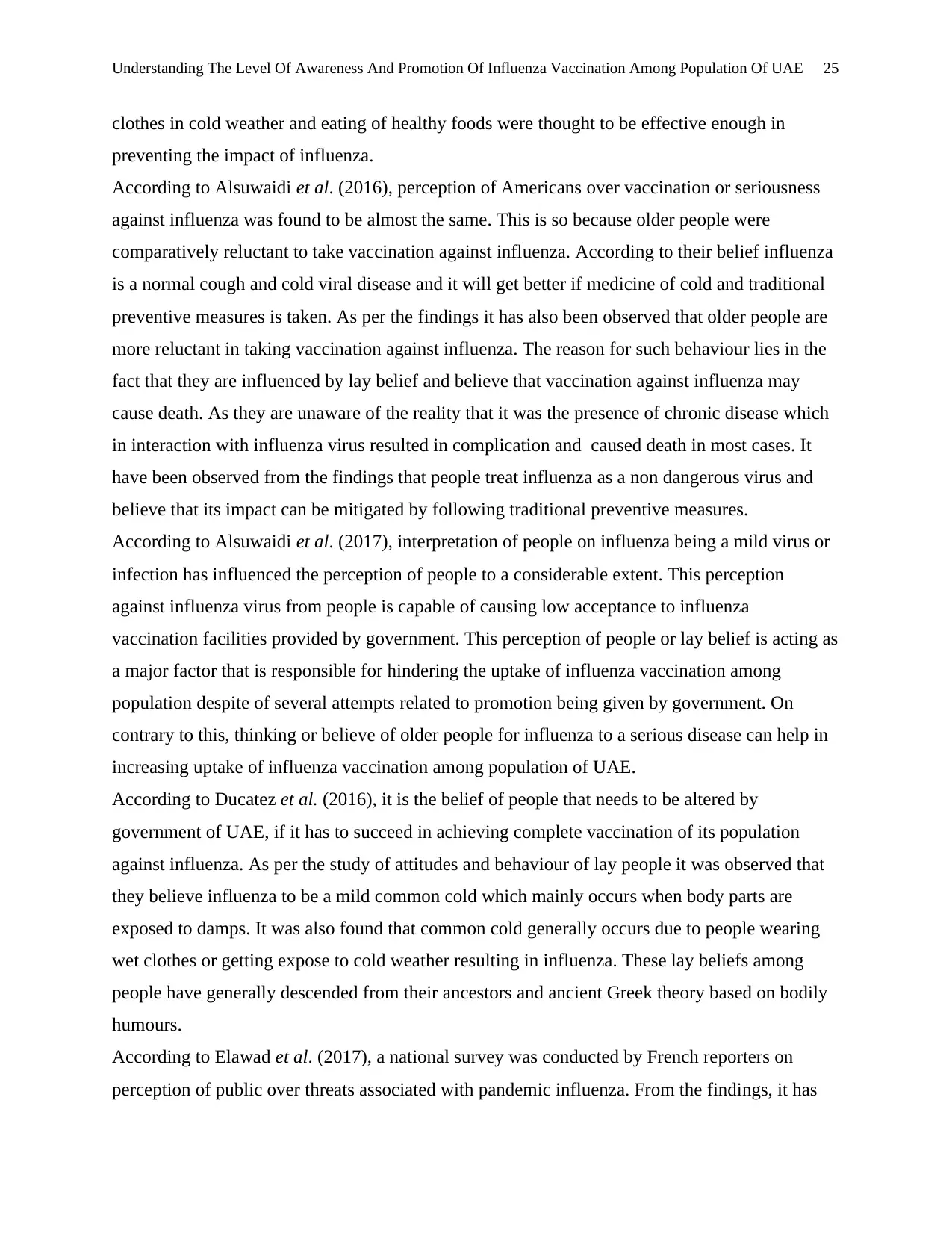
Understanding The Level Of Awareness And Promotion Of Influenza Vaccination Among Population Of UAE 25
clothes in cold weather and eating of healthy foods were thought to be effective enough in
preventing the impact of influenza.
According to Alsuwaidi et al. (2016), perception of Americans over vaccination or seriousness
against influenza was found to be almost the same. This is so because older people were
comparatively reluctant to take vaccination against influenza. According to their belief influenza
is a normal cough and cold viral disease and it will get better if medicine of cold and traditional
preventive measures is taken. As per the findings it has also been observed that older people are
more reluctant in taking vaccination against influenza. The reason for such behaviour lies in the
fact that they are influenced by lay belief and believe that vaccination against influenza may
cause death. As they are unaware of the reality that it was the presence of chronic disease which
in interaction with influenza virus resulted in complication and caused death in most cases. It
have been observed from the findings that people treat influenza as a non dangerous virus and
believe that its impact can be mitigated by following traditional preventive measures.
According to Alsuwaidi et al. (2017), interpretation of people on influenza being a mild virus or
infection has influenced the perception of people to a considerable extent. This perception
against influenza virus from people is capable of causing low acceptance to influenza
vaccination facilities provided by government. This perception of people or lay belief is acting as
a major factor that is responsible for hindering the uptake of influenza vaccination among
population despite of several attempts related to promotion being given by government. On
contrary to this, thinking or believe of older people for influenza to a serious disease can help in
increasing uptake of influenza vaccination among population of UAE.
According to Ducatez et al. (2016), it is the belief of people that needs to be altered by
government of UAE, if it has to succeed in achieving complete vaccination of its population
against influenza. As per the study of attitudes and behaviour of lay people it was observed that
they believe influenza to be a mild common cold which mainly occurs when body parts are
exposed to damps. It was also found that common cold generally occurs due to people wearing
wet clothes or getting expose to cold weather resulting in influenza. These lay beliefs among
people have generally descended from their ancestors and ancient Greek theory based on bodily
humours.
According to Elawad et al. (2017), a national survey was conducted by French reporters on
perception of public over threats associated with pandemic influenza. From the findings, it has
clothes in cold weather and eating of healthy foods were thought to be effective enough in
preventing the impact of influenza.
According to Alsuwaidi et al. (2016), perception of Americans over vaccination or seriousness
against influenza was found to be almost the same. This is so because older people were
comparatively reluctant to take vaccination against influenza. According to their belief influenza
is a normal cough and cold viral disease and it will get better if medicine of cold and traditional
preventive measures is taken. As per the findings it has also been observed that older people are
more reluctant in taking vaccination against influenza. The reason for such behaviour lies in the
fact that they are influenced by lay belief and believe that vaccination against influenza may
cause death. As they are unaware of the reality that it was the presence of chronic disease which
in interaction with influenza virus resulted in complication and caused death in most cases. It
have been observed from the findings that people treat influenza as a non dangerous virus and
believe that its impact can be mitigated by following traditional preventive measures.
According to Alsuwaidi et al. (2017), interpretation of people on influenza being a mild virus or
infection has influenced the perception of people to a considerable extent. This perception
against influenza virus from people is capable of causing low acceptance to influenza
vaccination facilities provided by government. This perception of people or lay belief is acting as
a major factor that is responsible for hindering the uptake of influenza vaccination among
population despite of several attempts related to promotion being given by government. On
contrary to this, thinking or believe of older people for influenza to a serious disease can help in
increasing uptake of influenza vaccination among population of UAE.
According to Ducatez et al. (2016), it is the belief of people that needs to be altered by
government of UAE, if it has to succeed in achieving complete vaccination of its population
against influenza. As per the study of attitudes and behaviour of lay people it was observed that
they believe influenza to be a mild common cold which mainly occurs when body parts are
exposed to damps. It was also found that common cold generally occurs due to people wearing
wet clothes or getting expose to cold weather resulting in influenza. These lay beliefs among
people have generally descended from their ancestors and ancient Greek theory based on bodily
humours.
According to Elawad et al. (2017), a national survey was conducted by French reporters on
perception of public over threats associated with pandemic influenza. From the findings, it has
Secure Best Marks with AI Grader
Need help grading? Try our AI Grader for instant feedback on your assignments.
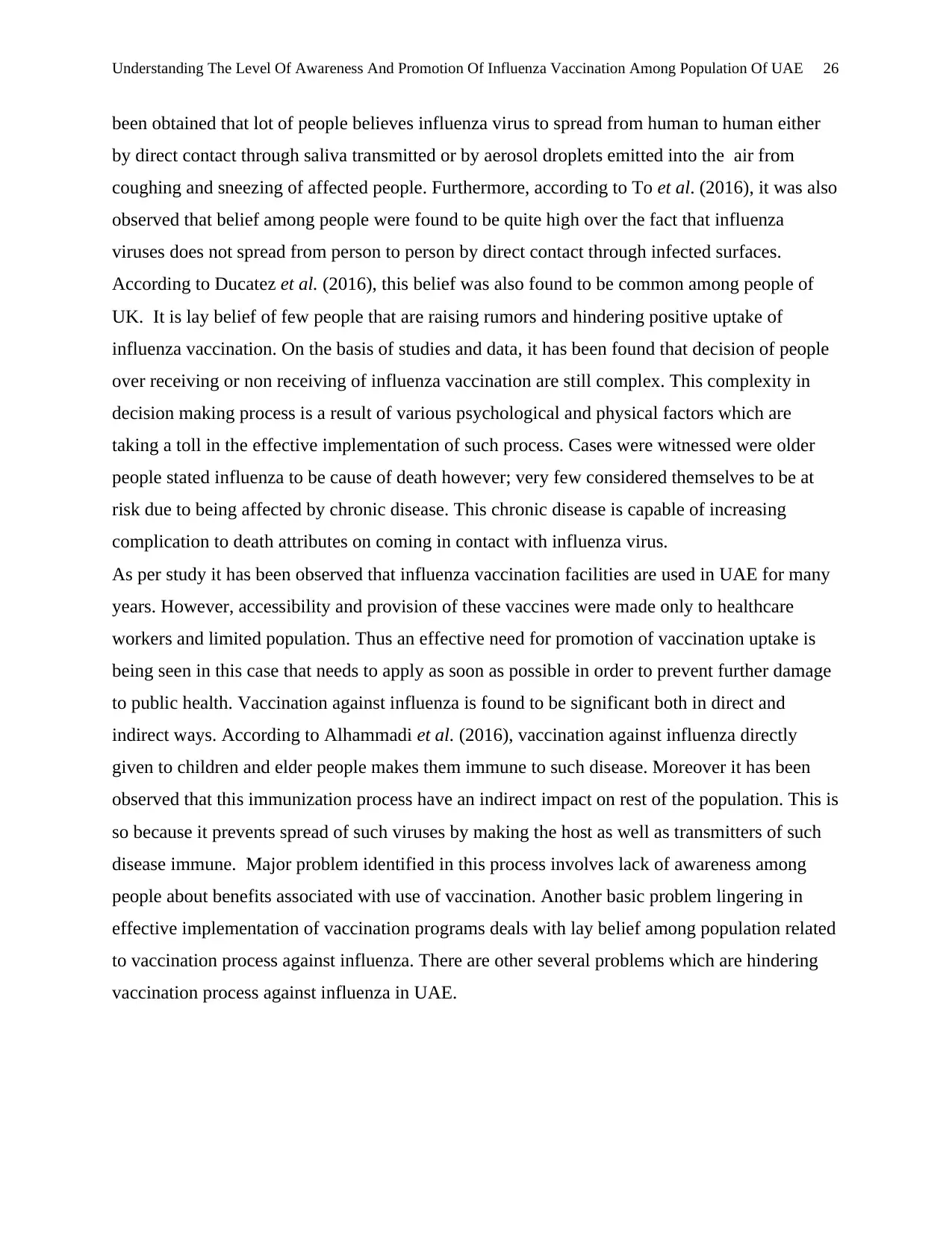
Understanding The Level Of Awareness And Promotion Of Influenza Vaccination Among Population Of UAE 26
been obtained that lot of people believes influenza virus to spread from human to human either
by direct contact through saliva transmitted or by aerosol droplets emitted into the air from
coughing and sneezing of affected people. Furthermore, according to To et al. (2016), it was also
observed that belief among people were found to be quite high over the fact that influenza
viruses does not spread from person to person by direct contact through infected surfaces.
According to Ducatez et al. (2016), this belief was also found to be common among people of
UK. It is lay belief of few people that are raising rumors and hindering positive uptake of
influenza vaccination. On the basis of studies and data, it has been found that decision of people
over receiving or non receiving of influenza vaccination are still complex. This complexity in
decision making process is a result of various psychological and physical factors which are
taking a toll in the effective implementation of such process. Cases were witnessed were older
people stated influenza to be cause of death however; very few considered themselves to be at
risk due to being affected by chronic disease. This chronic disease is capable of increasing
complication to death attributes on coming in contact with influenza virus.
As per study it has been observed that influenza vaccination facilities are used in UAE for many
years. However, accessibility and provision of these vaccines were made only to healthcare
workers and limited population. Thus an effective need for promotion of vaccination uptake is
being seen in this case that needs to apply as soon as possible in order to prevent further damage
to public health. Vaccination against influenza is found to be significant both in direct and
indirect ways. According to Alhammadi et al. (2016), vaccination against influenza directly
given to children and elder people makes them immune to such disease. Moreover it has been
observed that this immunization process have an indirect impact on rest of the population. This is
so because it prevents spread of such viruses by making the host as well as transmitters of such
disease immune. Major problem identified in this process involves lack of awareness among
people about benefits associated with use of vaccination. Another basic problem lingering in
effective implementation of vaccination programs deals with lay belief among population related
to vaccination process against influenza. There are other several problems which are hindering
vaccination process against influenza in UAE.
been obtained that lot of people believes influenza virus to spread from human to human either
by direct contact through saliva transmitted or by aerosol droplets emitted into the air from
coughing and sneezing of affected people. Furthermore, according to To et al. (2016), it was also
observed that belief among people were found to be quite high over the fact that influenza
viruses does not spread from person to person by direct contact through infected surfaces.
According to Ducatez et al. (2016), this belief was also found to be common among people of
UK. It is lay belief of few people that are raising rumors and hindering positive uptake of
influenza vaccination. On the basis of studies and data, it has been found that decision of people
over receiving or non receiving of influenza vaccination are still complex. This complexity in
decision making process is a result of various psychological and physical factors which are
taking a toll in the effective implementation of such process. Cases were witnessed were older
people stated influenza to be cause of death however; very few considered themselves to be at
risk due to being affected by chronic disease. This chronic disease is capable of increasing
complication to death attributes on coming in contact with influenza virus.
As per study it has been observed that influenza vaccination facilities are used in UAE for many
years. However, accessibility and provision of these vaccines were made only to healthcare
workers and limited population. Thus an effective need for promotion of vaccination uptake is
being seen in this case that needs to apply as soon as possible in order to prevent further damage
to public health. Vaccination against influenza is found to be significant both in direct and
indirect ways. According to Alhammadi et al. (2016), vaccination against influenza directly
given to children and elder people makes them immune to such disease. Moreover it has been
observed that this immunization process have an indirect impact on rest of the population. This is
so because it prevents spread of such viruses by making the host as well as transmitters of such
disease immune. Major problem identified in this process involves lack of awareness among
people about benefits associated with use of vaccination. Another basic problem lingering in
effective implementation of vaccination programs deals with lay belief among population related
to vaccination process against influenza. There are other several problems which are hindering
vaccination process against influenza in UAE.
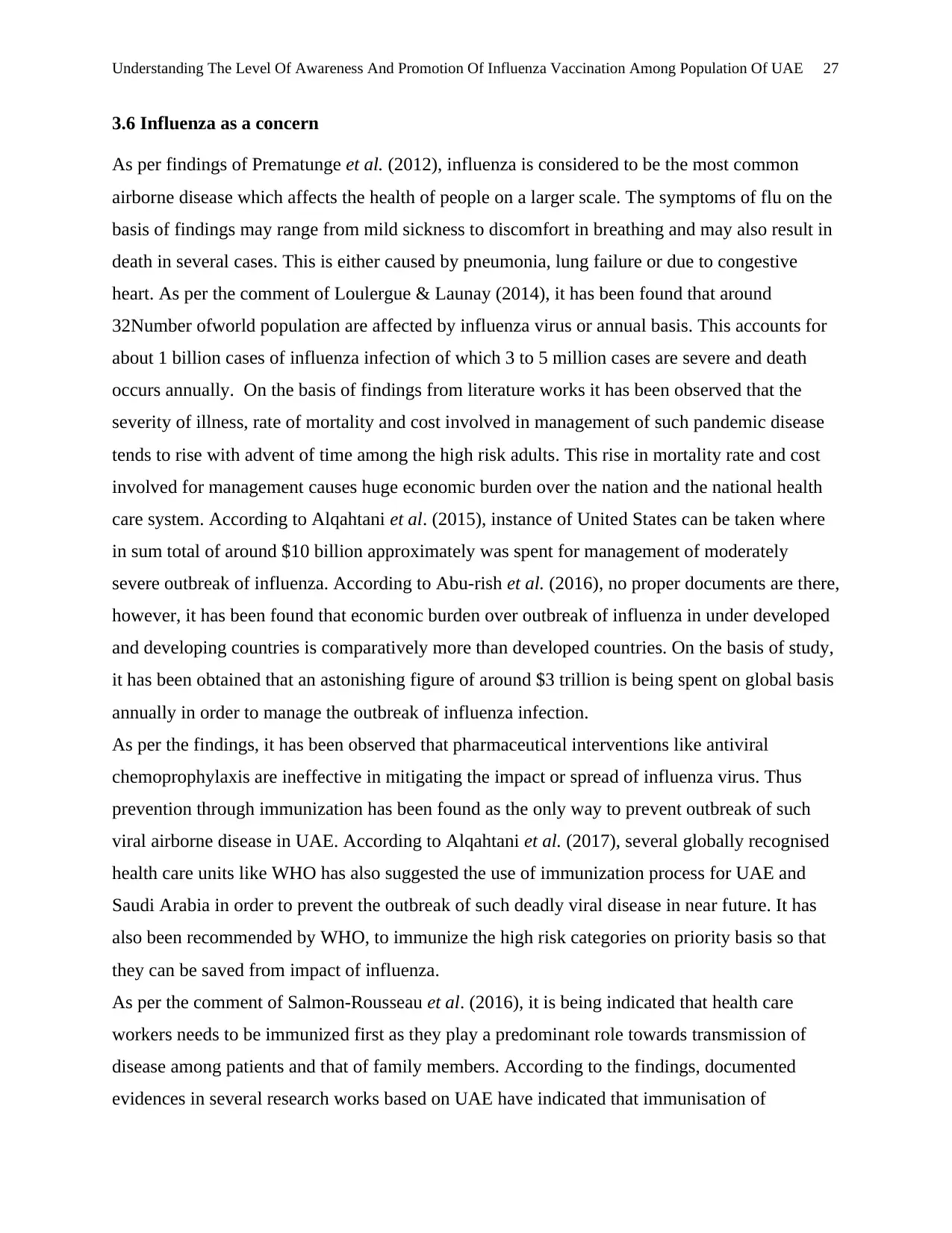
Understanding The Level Of Awareness And Promotion Of Influenza Vaccination Among Population Of UAE 27
3.6 Influenza as a concern
As per findings of Prematunge et al. (2012), influenza is considered to be the most common
airborne disease which affects the health of people on a larger scale. The symptoms of flu on the
basis of findings may range from mild sickness to discomfort in breathing and may also result in
death in several cases. This is either caused by pneumonia, lung failure or due to congestive
heart. As per the comment of Loulergue & Launay (2014), it has been found that around
32Number ofworld population are affected by influenza virus or annual basis. This accounts for
about 1 billion cases of influenza infection of which 3 to 5 million cases are severe and death
occurs annually. On the basis of findings from literature works it has been observed that the
severity of illness, rate of mortality and cost involved in management of such pandemic disease
tends to rise with advent of time among the high risk adults. This rise in mortality rate and cost
involved for management causes huge economic burden over the nation and the national health
care system. According to Alqahtani et al. (2015), instance of United States can be taken where
in sum total of around $10 billion approximately was spent for management of moderately
severe outbreak of influenza. According to Abu-rish et al. (2016), no proper documents are there,
however, it has been found that economic burden over outbreak of influenza in under developed
and developing countries is comparatively more than developed countries. On the basis of study,
it has been obtained that an astonishing figure of around $3 trillion is being spent on global basis
annually in order to manage the outbreak of influenza infection.
As per the findings, it has been observed that pharmaceutical interventions like antiviral
chemoprophylaxis are ineffective in mitigating the impact or spread of influenza virus. Thus
prevention through immunization has been found as the only way to prevent outbreak of such
viral airborne disease in UAE. According to Alqahtani et al. (2017), several globally recognised
health care units like WHO has also suggested the use of immunization process for UAE and
Saudi Arabia in order to prevent the outbreak of such deadly viral disease in near future. It has
also been recommended by WHO, to immunize the high risk categories on priority basis so that
they can be saved from impact of influenza.
As per the comment of Salmon-Rousseau et al. (2016), it is being indicated that health care
workers needs to be immunized first as they play a predominant role towards transmission of
disease among patients and that of family members. According to the findings, documented
evidences in several research works based on UAE have indicated that immunisation of
3.6 Influenza as a concern
As per findings of Prematunge et al. (2012), influenza is considered to be the most common
airborne disease which affects the health of people on a larger scale. The symptoms of flu on the
basis of findings may range from mild sickness to discomfort in breathing and may also result in
death in several cases. This is either caused by pneumonia, lung failure or due to congestive
heart. As per the comment of Loulergue & Launay (2014), it has been found that around
32Number ofworld population are affected by influenza virus or annual basis. This accounts for
about 1 billion cases of influenza infection of which 3 to 5 million cases are severe and death
occurs annually. On the basis of findings from literature works it has been observed that the
severity of illness, rate of mortality and cost involved in management of such pandemic disease
tends to rise with advent of time among the high risk adults. This rise in mortality rate and cost
involved for management causes huge economic burden over the nation and the national health
care system. According to Alqahtani et al. (2015), instance of United States can be taken where
in sum total of around $10 billion approximately was spent for management of moderately
severe outbreak of influenza. According to Abu-rish et al. (2016), no proper documents are there,
however, it has been found that economic burden over outbreak of influenza in under developed
and developing countries is comparatively more than developed countries. On the basis of study,
it has been obtained that an astonishing figure of around $3 trillion is being spent on global basis
annually in order to manage the outbreak of influenza infection.
As per the findings, it has been observed that pharmaceutical interventions like antiviral
chemoprophylaxis are ineffective in mitigating the impact or spread of influenza virus. Thus
prevention through immunization has been found as the only way to prevent outbreak of such
viral airborne disease in UAE. According to Alqahtani et al. (2017), several globally recognised
health care units like WHO has also suggested the use of immunization process for UAE and
Saudi Arabia in order to prevent the outbreak of such deadly viral disease in near future. It has
also been recommended by WHO, to immunize the high risk categories on priority basis so that
they can be saved from impact of influenza.
As per the comment of Salmon-Rousseau et al. (2016), it is being indicated that health care
workers needs to be immunized first as they play a predominant role towards transmission of
disease among patients and that of family members. According to the findings, documented
evidences in several research works based on UAE have indicated that immunisation of
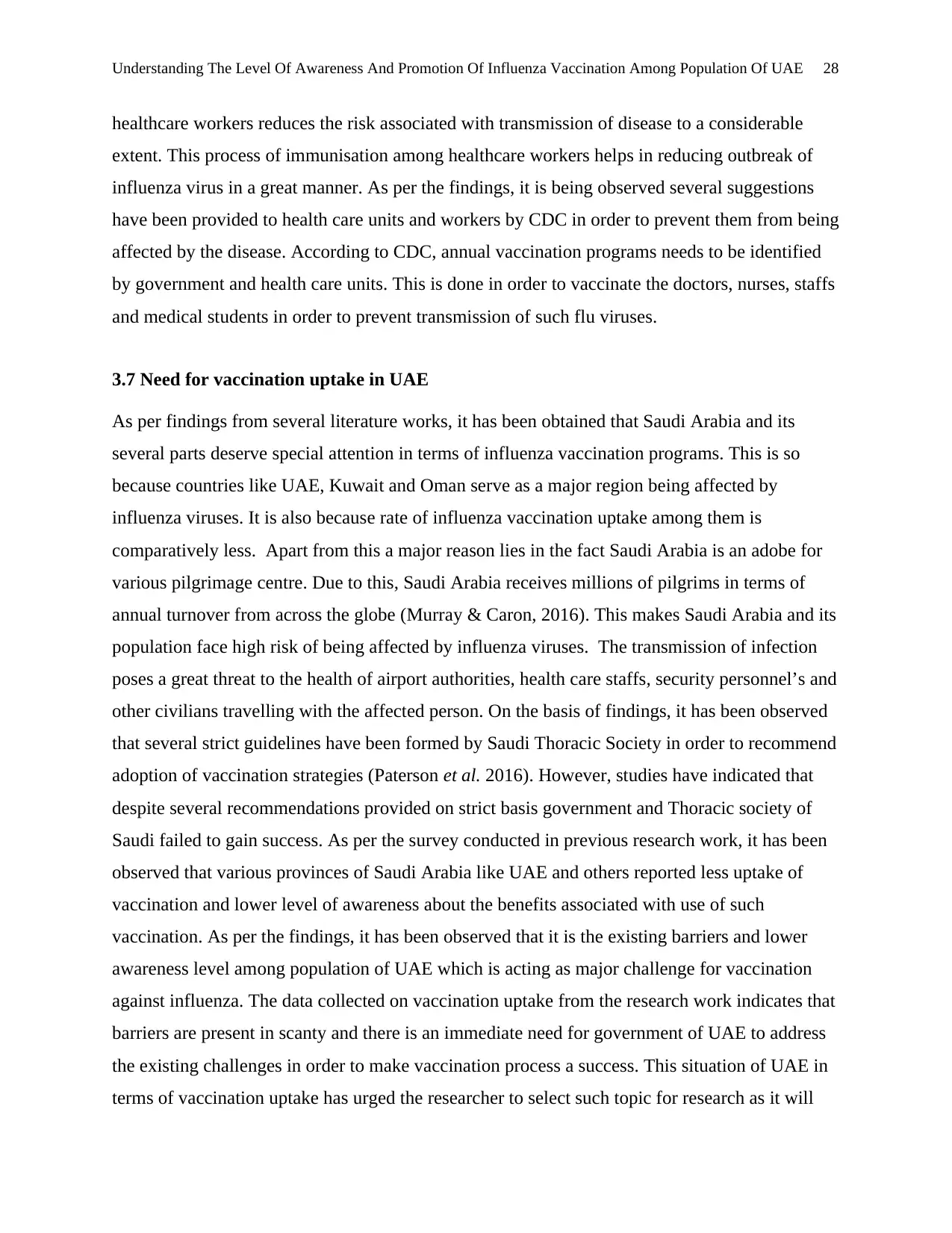
Understanding The Level Of Awareness And Promotion Of Influenza Vaccination Among Population Of UAE 28
healthcare workers reduces the risk associated with transmission of disease to a considerable
extent. This process of immunisation among healthcare workers helps in reducing outbreak of
influenza virus in a great manner. As per the findings, it is being observed several suggestions
have been provided to health care units and workers by CDC in order to prevent them from being
affected by the disease. According to CDC, annual vaccination programs needs to be identified
by government and health care units. This is done in order to vaccinate the doctors, nurses, staffs
and medical students in order to prevent transmission of such flu viruses.
3.7 Need for vaccination uptake in UAE
As per findings from several literature works, it has been obtained that Saudi Arabia and its
several parts deserve special attention in terms of influenza vaccination programs. This is so
because countries like UAE, Kuwait and Oman serve as a major region being affected by
influenza viruses. It is also because rate of influenza vaccination uptake among them is
comparatively less. Apart from this a major reason lies in the fact Saudi Arabia is an adobe for
various pilgrimage centre. Due to this, Saudi Arabia receives millions of pilgrims in terms of
annual turnover from across the globe (Murray & Caron, 2016). This makes Saudi Arabia and its
population face high risk of being affected by influenza viruses. The transmission of infection
poses a great threat to the health of airport authorities, health care staffs, security personnel’s and
other civilians travelling with the affected person. On the basis of findings, it has been observed
that several strict guidelines have been formed by Saudi Thoracic Society in order to recommend
adoption of vaccination strategies (Paterson et al. 2016). However, studies have indicated that
despite several recommendations provided on strict basis government and Thoracic society of
Saudi failed to gain success. As per the survey conducted in previous research work, it has been
observed that various provinces of Saudi Arabia like UAE and others reported less uptake of
vaccination and lower level of awareness about the benefits associated with use of such
vaccination. As per the findings, it has been observed that it is the existing barriers and lower
awareness level among population of UAE which is acting as major challenge for vaccination
against influenza. The data collected on vaccination uptake from the research work indicates that
barriers are present in scanty and there is an immediate need for government of UAE to address
the existing challenges in order to make vaccination process a success. This situation of UAE in
terms of vaccination uptake has urged the researcher to select such topic for research as it will
healthcare workers reduces the risk associated with transmission of disease to a considerable
extent. This process of immunisation among healthcare workers helps in reducing outbreak of
influenza virus in a great manner. As per the findings, it is being observed several suggestions
have been provided to health care units and workers by CDC in order to prevent them from being
affected by the disease. According to CDC, annual vaccination programs needs to be identified
by government and health care units. This is done in order to vaccinate the doctors, nurses, staffs
and medical students in order to prevent transmission of such flu viruses.
3.7 Need for vaccination uptake in UAE
As per findings from several literature works, it has been obtained that Saudi Arabia and its
several parts deserve special attention in terms of influenza vaccination programs. This is so
because countries like UAE, Kuwait and Oman serve as a major region being affected by
influenza viruses. It is also because rate of influenza vaccination uptake among them is
comparatively less. Apart from this a major reason lies in the fact Saudi Arabia is an adobe for
various pilgrimage centre. Due to this, Saudi Arabia receives millions of pilgrims in terms of
annual turnover from across the globe (Murray & Caron, 2016). This makes Saudi Arabia and its
population face high risk of being affected by influenza viruses. The transmission of infection
poses a great threat to the health of airport authorities, health care staffs, security personnel’s and
other civilians travelling with the affected person. On the basis of findings, it has been observed
that several strict guidelines have been formed by Saudi Thoracic Society in order to recommend
adoption of vaccination strategies (Paterson et al. 2016). However, studies have indicated that
despite several recommendations provided on strict basis government and Thoracic society of
Saudi failed to gain success. As per the survey conducted in previous research work, it has been
observed that various provinces of Saudi Arabia like UAE and others reported less uptake of
vaccination and lower level of awareness about the benefits associated with use of such
vaccination. As per the findings, it has been observed that it is the existing barriers and lower
awareness level among population of UAE which is acting as major challenge for vaccination
against influenza. The data collected on vaccination uptake from the research work indicates that
barriers are present in scanty and there is an immediate need for government of UAE to address
the existing challenges in order to make vaccination process a success. This situation of UAE in
terms of vaccination uptake has urged the researcher to select such topic for research as it will
Paraphrase This Document
Need a fresh take? Get an instant paraphrase of this document with our AI Paraphraser
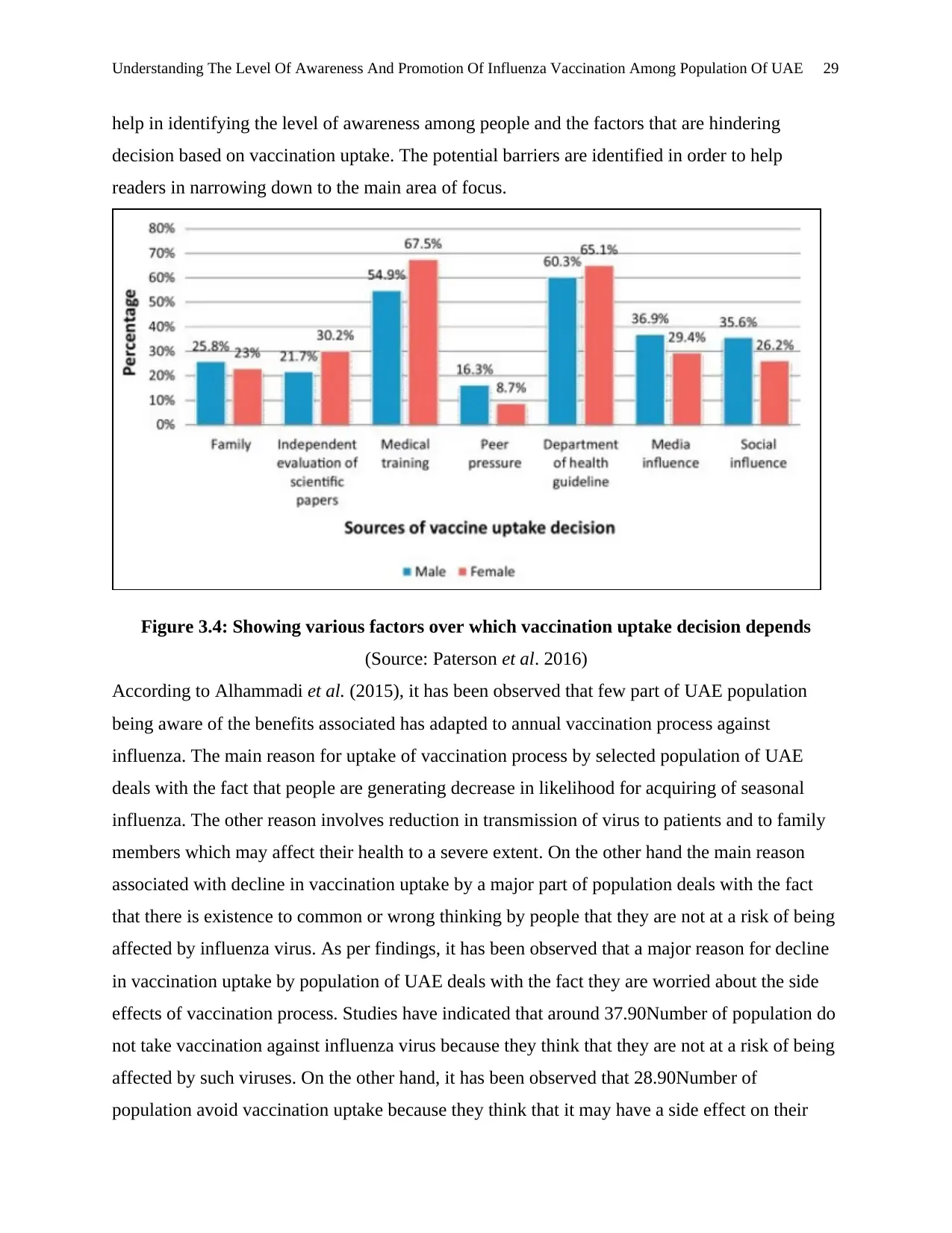
Understanding The Level Of Awareness And Promotion Of Influenza Vaccination Among Population Of UAE 29
help in identifying the level of awareness among people and the factors that are hindering
decision based on vaccination uptake. The potential barriers are identified in order to help
readers in narrowing down to the main area of focus.
Figure 3.4: Showing various factors over which vaccination uptake decision depends
(Source: Paterson et al. 2016)
According to Alhammadi et al. (2015), it has been observed that few part of UAE population
being aware of the benefits associated has adapted to annual vaccination process against
influenza. The main reason for uptake of vaccination process by selected population of UAE
deals with the fact that people are generating decrease in likelihood for acquiring of seasonal
influenza. The other reason involves reduction in transmission of virus to patients and to family
members which may affect their health to a severe extent. On the other hand the main reason
associated with decline in vaccination uptake by a major part of population deals with the fact
that there is existence to common or wrong thinking by people that they are not at a risk of being
affected by influenza virus. As per findings, it has been observed that a major reason for decline
in vaccination uptake by population of UAE deals with the fact they are worried about the side
effects of vaccination process. Studies have indicated that around 37.90Number of population do
not take vaccination against influenza virus because they think that they are not at a risk of being
affected by such viruses. On the other hand, it has been observed that 28.90Number of
population avoid vaccination uptake because they think that it may have a side effect on their
help in identifying the level of awareness among people and the factors that are hindering
decision based on vaccination uptake. The potential barriers are identified in order to help
readers in narrowing down to the main area of focus.
Figure 3.4: Showing various factors over which vaccination uptake decision depends
(Source: Paterson et al. 2016)
According to Alhammadi et al. (2015), it has been observed that few part of UAE population
being aware of the benefits associated has adapted to annual vaccination process against
influenza. The main reason for uptake of vaccination process by selected population of UAE
deals with the fact that people are generating decrease in likelihood for acquiring of seasonal
influenza. The other reason involves reduction in transmission of virus to patients and to family
members which may affect their health to a severe extent. On the other hand the main reason
associated with decline in vaccination uptake by a major part of population deals with the fact
that there is existence to common or wrong thinking by people that they are not at a risk of being
affected by influenza virus. As per findings, it has been observed that a major reason for decline
in vaccination uptake by population of UAE deals with the fact they are worried about the side
effects of vaccination process. Studies have indicated that around 37.90Number of population do
not take vaccination against influenza virus because they think that they are not at a risk of being
affected by such viruses. On the other hand, it has been observed that 28.90Number of
population avoid vaccination uptake because they think that it may have a side effect on their
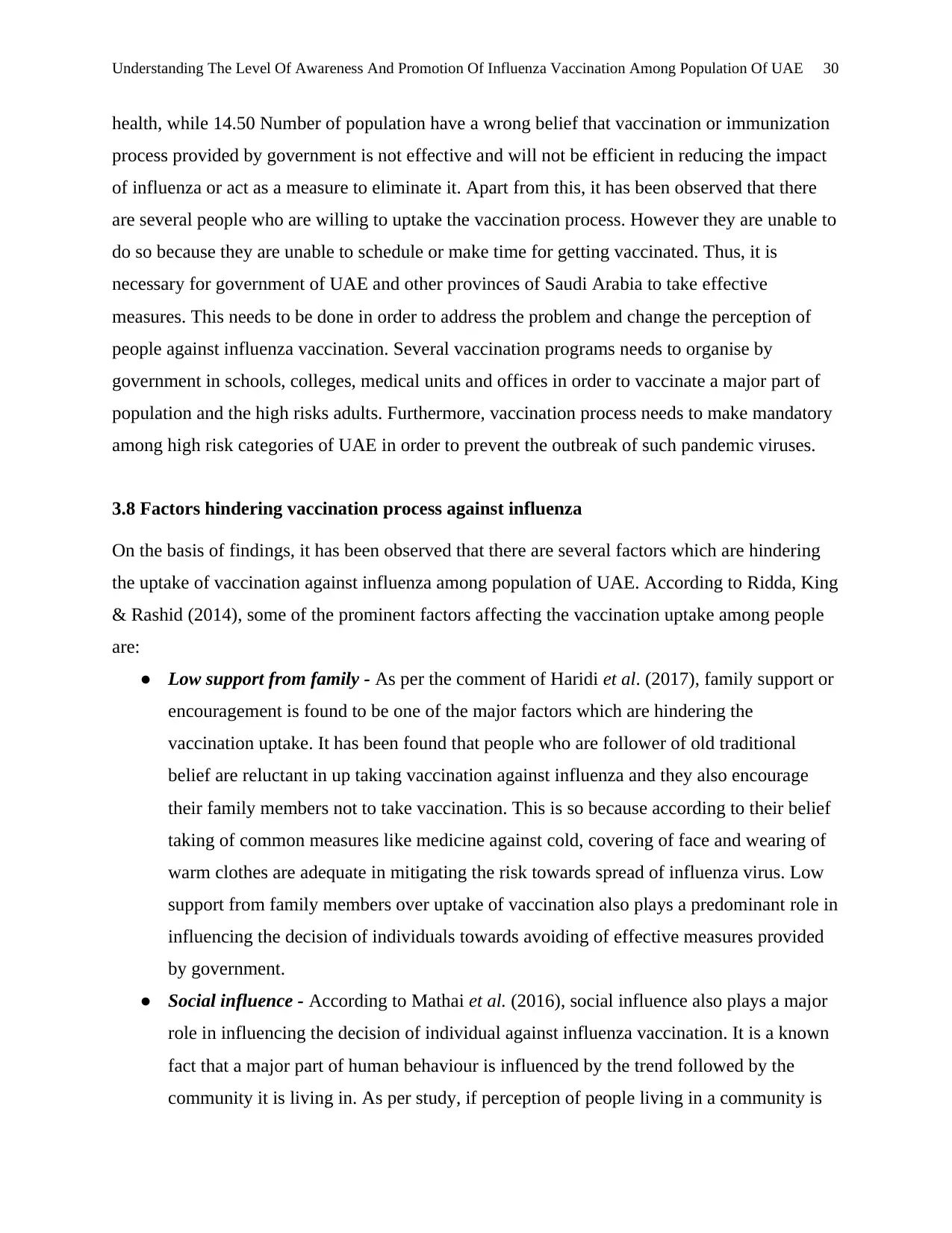
Understanding The Level Of Awareness And Promotion Of Influenza Vaccination Among Population Of UAE 30
health, while 14.50 Number of population have a wrong belief that vaccination or immunization
process provided by government is not effective and will not be efficient in reducing the impact
of influenza or act as a measure to eliminate it. Apart from this, it has been observed that there
are several people who are willing to uptake the vaccination process. However they are unable to
do so because they are unable to schedule or make time for getting vaccinated. Thus, it is
necessary for government of UAE and other provinces of Saudi Arabia to take effective
measures. This needs to be done in order to address the problem and change the perception of
people against influenza vaccination. Several vaccination programs needs to organise by
government in schools, colleges, medical units and offices in order to vaccinate a major part of
population and the high risks adults. Furthermore, vaccination process needs to make mandatory
among high risk categories of UAE in order to prevent the outbreak of such pandemic viruses.
3.8 Factors hindering vaccination process against influenza
On the basis of findings, it has been observed that there are several factors which are hindering
the uptake of vaccination against influenza among population of UAE. According to Ridda, King
& Rashid (2014), some of the prominent factors affecting the vaccination uptake among people
are:
● Low support from family - As per the comment of Haridi et al. (2017), family support or
encouragement is found to be one of the major factors which are hindering the
vaccination uptake. It has been found that people who are follower of old traditional
belief are reluctant in up taking vaccination against influenza and they also encourage
their family members not to take vaccination. This is so because according to their belief
taking of common measures like medicine against cold, covering of face and wearing of
warm clothes are adequate in mitigating the risk towards spread of influenza virus. Low
support from family members over uptake of vaccination also plays a predominant role in
influencing the decision of individuals towards avoiding of effective measures provided
by government.
● Social influence - According to Mathai et al. (2016), social influence also plays a major
role in influencing the decision of individual against influenza vaccination. It is a known
fact that a major part of human behaviour is influenced by the trend followed by the
community it is living in. As per study, if perception of people living in a community is
health, while 14.50 Number of population have a wrong belief that vaccination or immunization
process provided by government is not effective and will not be efficient in reducing the impact
of influenza or act as a measure to eliminate it. Apart from this, it has been observed that there
are several people who are willing to uptake the vaccination process. However they are unable to
do so because they are unable to schedule or make time for getting vaccinated. Thus, it is
necessary for government of UAE and other provinces of Saudi Arabia to take effective
measures. This needs to be done in order to address the problem and change the perception of
people against influenza vaccination. Several vaccination programs needs to organise by
government in schools, colleges, medical units and offices in order to vaccinate a major part of
population and the high risks adults. Furthermore, vaccination process needs to make mandatory
among high risk categories of UAE in order to prevent the outbreak of such pandemic viruses.
3.8 Factors hindering vaccination process against influenza
On the basis of findings, it has been observed that there are several factors which are hindering
the uptake of vaccination against influenza among population of UAE. According to Ridda, King
& Rashid (2014), some of the prominent factors affecting the vaccination uptake among people
are:
● Low support from family - As per the comment of Haridi et al. (2017), family support or
encouragement is found to be one of the major factors which are hindering the
vaccination uptake. It has been found that people who are follower of old traditional
belief are reluctant in up taking vaccination against influenza and they also encourage
their family members not to take vaccination. This is so because according to their belief
taking of common measures like medicine against cold, covering of face and wearing of
warm clothes are adequate in mitigating the risk towards spread of influenza virus. Low
support from family members over uptake of vaccination also plays a predominant role in
influencing the decision of individuals towards avoiding of effective measures provided
by government.
● Social influence - According to Mathai et al. (2016), social influence also plays a major
role in influencing the decision of individual against influenza vaccination. It is a known
fact that a major part of human behaviour is influenced by the trend followed by the
community it is living in. As per study, if perception of people living in a community is
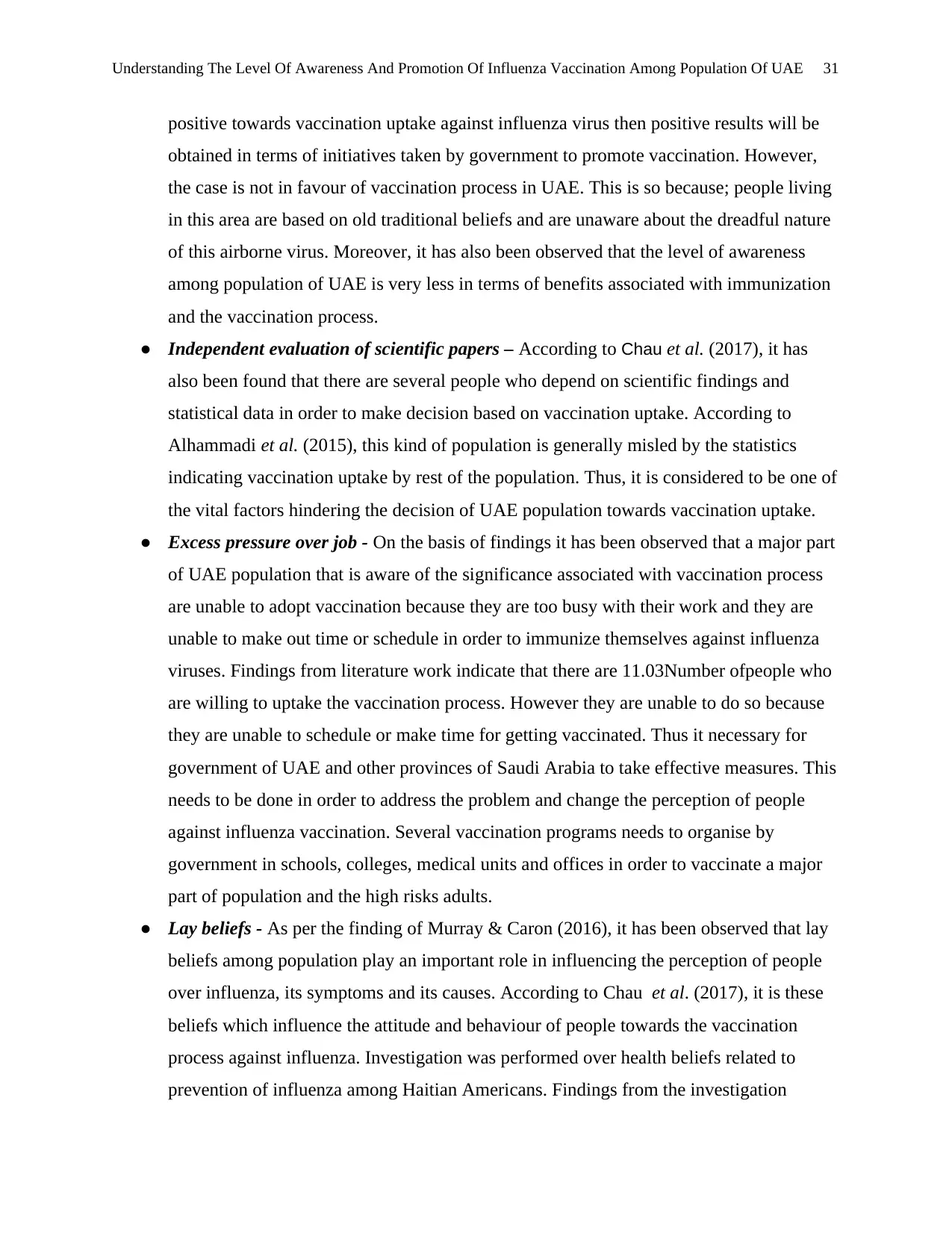
Understanding The Level Of Awareness And Promotion Of Influenza Vaccination Among Population Of UAE 31
positive towards vaccination uptake against influenza virus then positive results will be
obtained in terms of initiatives taken by government to promote vaccination. However,
the case is not in favour of vaccination process in UAE. This is so because; people living
in this area are based on old traditional beliefs and are unaware about the dreadful nature
of this airborne virus. Moreover, it has also been observed that the level of awareness
among population of UAE is very less in terms of benefits associated with immunization
and the vaccination process.
● Independent evaluation of scientific papers – According to Chau et al. (2017), it has
also been found that there are several people who depend on scientific findings and
statistical data in order to make decision based on vaccination uptake. According to
Alhammadi et al. (2015), this kind of population is generally misled by the statistics
indicating vaccination uptake by rest of the population. Thus, it is considered to be one of
the vital factors hindering the decision of UAE population towards vaccination uptake.
● Excess pressure over job - On the basis of findings it has been observed that a major part
of UAE population that is aware of the significance associated with vaccination process
are unable to adopt vaccination because they are too busy with their work and they are
unable to make out time or schedule in order to immunize themselves against influenza
viruses. Findings from literature work indicate that there are 11.03Number ofpeople who
are willing to uptake the vaccination process. However they are unable to do so because
they are unable to schedule or make time for getting vaccinated. Thus it necessary for
government of UAE and other provinces of Saudi Arabia to take effective measures. This
needs to be done in order to address the problem and change the perception of people
against influenza vaccination. Several vaccination programs needs to organise by
government in schools, colleges, medical units and offices in order to vaccinate a major
part of population and the high risks adults.
● Lay beliefs - As per the finding of Murray & Caron (2016), it has been observed that lay
beliefs among population play an important role in influencing the perception of people
over influenza, its symptoms and its causes. According to Chau et al. (2017), it is these
beliefs which influence the attitude and behaviour of people towards the vaccination
process against influenza. Investigation was performed over health beliefs related to
prevention of influenza among Haitian Americans. Findings from the investigation
positive towards vaccination uptake against influenza virus then positive results will be
obtained in terms of initiatives taken by government to promote vaccination. However,
the case is not in favour of vaccination process in UAE. This is so because; people living
in this area are based on old traditional beliefs and are unaware about the dreadful nature
of this airborne virus. Moreover, it has also been observed that the level of awareness
among population of UAE is very less in terms of benefits associated with immunization
and the vaccination process.
● Independent evaluation of scientific papers – According to Chau et al. (2017), it has
also been found that there are several people who depend on scientific findings and
statistical data in order to make decision based on vaccination uptake. According to
Alhammadi et al. (2015), this kind of population is generally misled by the statistics
indicating vaccination uptake by rest of the population. Thus, it is considered to be one of
the vital factors hindering the decision of UAE population towards vaccination uptake.
● Excess pressure over job - On the basis of findings it has been observed that a major part
of UAE population that is aware of the significance associated with vaccination process
are unable to adopt vaccination because they are too busy with their work and they are
unable to make out time or schedule in order to immunize themselves against influenza
viruses. Findings from literature work indicate that there are 11.03Number ofpeople who
are willing to uptake the vaccination process. However they are unable to do so because
they are unable to schedule or make time for getting vaccinated. Thus it necessary for
government of UAE and other provinces of Saudi Arabia to take effective measures. This
needs to be done in order to address the problem and change the perception of people
against influenza vaccination. Several vaccination programs needs to organise by
government in schools, colleges, medical units and offices in order to vaccinate a major
part of population and the high risks adults.
● Lay beliefs - As per the finding of Murray & Caron (2016), it has been observed that lay
beliefs among population play an important role in influencing the perception of people
over influenza, its symptoms and its causes. According to Chau et al. (2017), it is these
beliefs which influence the attitude and behaviour of people towards the vaccination
process against influenza. Investigation was performed over health beliefs related to
prevention of influenza among Haitian Americans. Findings from the investigation
Secure Best Marks with AI Grader
Need help grading? Try our AI Grader for instant feedback on your assignments.
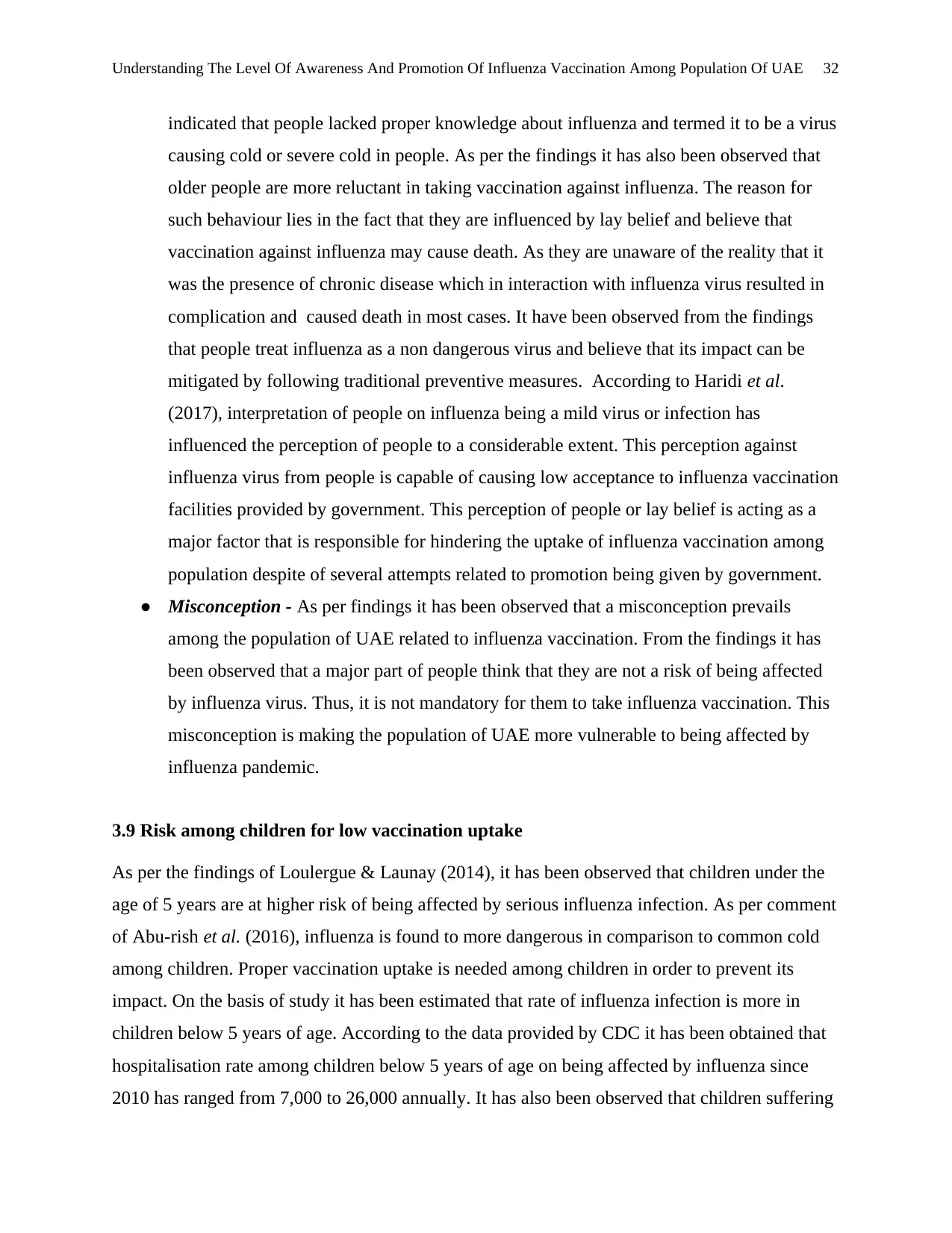
Understanding The Level Of Awareness And Promotion Of Influenza Vaccination Among Population Of UAE 32
indicated that people lacked proper knowledge about influenza and termed it to be a virus
causing cold or severe cold in people. As per the findings it has also been observed that
older people are more reluctant in taking vaccination against influenza. The reason for
such behaviour lies in the fact that they are influenced by lay belief and believe that
vaccination against influenza may cause death. As they are unaware of the reality that it
was the presence of chronic disease which in interaction with influenza virus resulted in
complication and caused death in most cases. It have been observed from the findings
that people treat influenza as a non dangerous virus and believe that its impact can be
mitigated by following traditional preventive measures. According to Haridi et al.
(2017), interpretation of people on influenza being a mild virus or infection has
influenced the perception of people to a considerable extent. This perception against
influenza virus from people is capable of causing low acceptance to influenza vaccination
facilities provided by government. This perception of people or lay belief is acting as a
major factor that is responsible for hindering the uptake of influenza vaccination among
population despite of several attempts related to promotion being given by government.
● Misconception - As per findings it has been observed that a misconception prevails
among the population of UAE related to influenza vaccination. From the findings it has
been observed that a major part of people think that they are not a risk of being affected
by influenza virus. Thus, it is not mandatory for them to take influenza vaccination. This
misconception is making the population of UAE more vulnerable to being affected by
influenza pandemic.
3.9 Risk among children for low vaccination uptake
As per the findings of Loulergue & Launay (2014), it has been observed that children under the
age of 5 years are at higher risk of being affected by serious influenza infection. As per comment
of Abu-rish et al. (2016), influenza is found to more dangerous in comparison to common cold
among children. Proper vaccination uptake is needed among children in order to prevent its
impact. On the basis of study it has been estimated that rate of influenza infection is more in
children below 5 years of age. According to the data provided by CDC it has been obtained that
hospitalisation rate among children below 5 years of age on being affected by influenza since
2010 has ranged from 7,000 to 26,000 annually. It has also been observed that children suffering
indicated that people lacked proper knowledge about influenza and termed it to be a virus
causing cold or severe cold in people. As per the findings it has also been observed that
older people are more reluctant in taking vaccination against influenza. The reason for
such behaviour lies in the fact that they are influenced by lay belief and believe that
vaccination against influenza may cause death. As they are unaware of the reality that it
was the presence of chronic disease which in interaction with influenza virus resulted in
complication and caused death in most cases. It have been observed from the findings
that people treat influenza as a non dangerous virus and believe that its impact can be
mitigated by following traditional preventive measures. According to Haridi et al.
(2017), interpretation of people on influenza being a mild virus or infection has
influenced the perception of people to a considerable extent. This perception against
influenza virus from people is capable of causing low acceptance to influenza vaccination
facilities provided by government. This perception of people or lay belief is acting as a
major factor that is responsible for hindering the uptake of influenza vaccination among
population despite of several attempts related to promotion being given by government.
● Misconception - As per findings it has been observed that a misconception prevails
among the population of UAE related to influenza vaccination. From the findings it has
been observed that a major part of people think that they are not a risk of being affected
by influenza virus. Thus, it is not mandatory for them to take influenza vaccination. This
misconception is making the population of UAE more vulnerable to being affected by
influenza pandemic.
3.9 Risk among children for low vaccination uptake
As per the findings of Loulergue & Launay (2014), it has been observed that children under the
age of 5 years are at higher risk of being affected by serious influenza infection. As per comment
of Abu-rish et al. (2016), influenza is found to more dangerous in comparison to common cold
among children. Proper vaccination uptake is needed among children in order to prevent its
impact. On the basis of study it has been estimated that rate of influenza infection is more in
children below 5 years of age. According to the data provided by CDC it has been obtained that
hospitalisation rate among children below 5 years of age on being affected by influenza since
2010 has ranged from 7,000 to 26,000 annually. It has also been observed that children suffering

Understanding The Level Of Awareness And Promotion Of Influenza Vaccination Among Population Of UAE 33
from chronic disease are at more risk of being affected by influenza and maximum number of
death has been witnessed in such cases. This is so because influenza virus on interaction with
chronic disease hampers the metabolic activity of body and thus affects it proper functioning
leading the heart congestion or lung failure and causing death in most cases. As per findings
children have been identified as main priority by WHO and CDC for immunization process. This
is so because, as per study and scientific researches children are found to be the major carrier of
influenza virus and acts as catalyst in transmitting the disease among high risk adults.
Immunization of children against influenza through vaccination process will reduce the
spreading of virus and thus help in mitigating the chances for occurrence of major outbreak.
Furthermore, children in UAE are at higher risk of being affected by influenza because the rate
of vaccination uptake among its population is very low despite of several measures taken by
government to promote them. Citing the current scenario and seriousness of the issue several
vaccination policies have also been laid down by UAE government to increase vaccination
uptake.
3.10 Existing literature
On the basis of the study and the findings, the researcher has come across several research
literatures that were done earlier by other researchers. The research literature available throws
light on the various factors that influences vaccination against influenza. From literature work of
Alhammadi et al. (2016), it has been observed that death rate in terms of influenza pandemic is
more in comparison to the death rate in developed countries. This is so because they are not
having better facilities to fight such pandemic conditions and level of awareness among them is
less. According to the journal ‘A cross-sectional serosurvey of influenza A and B virus-specific
IgG antibodies in Emirati children’ written by Alsuwaidi, A., Al-Mekaini, L., Kamal, S., Narchi,
H., & Souid, A. K. it has been obtained that influenza is emerging as a major problem in various
parts of UAE thus it has made the researcher to develop interest over chosen topic and carry the
research work forward.
It has also taken into consideration peer reviewed articles like understanding influenza and the
various factors which influences it. This literature helps the researcher to understand and
evaluate the condition as well as awareness level among population of UAE. The research
from chronic disease are at more risk of being affected by influenza and maximum number of
death has been witnessed in such cases. This is so because influenza virus on interaction with
chronic disease hampers the metabolic activity of body and thus affects it proper functioning
leading the heart congestion or lung failure and causing death in most cases. As per findings
children have been identified as main priority by WHO and CDC for immunization process. This
is so because, as per study and scientific researches children are found to be the major carrier of
influenza virus and acts as catalyst in transmitting the disease among high risk adults.
Immunization of children against influenza through vaccination process will reduce the
spreading of virus and thus help in mitigating the chances for occurrence of major outbreak.
Furthermore, children in UAE are at higher risk of being affected by influenza because the rate
of vaccination uptake among its population is very low despite of several measures taken by
government to promote them. Citing the current scenario and seriousness of the issue several
vaccination policies have also been laid down by UAE government to increase vaccination
uptake.
3.10 Existing literature
On the basis of the study and the findings, the researcher has come across several research
literatures that were done earlier by other researchers. The research literature available throws
light on the various factors that influences vaccination against influenza. From literature work of
Alhammadi et al. (2016), it has been observed that death rate in terms of influenza pandemic is
more in comparison to the death rate in developed countries. This is so because they are not
having better facilities to fight such pandemic conditions and level of awareness among them is
less. According to the journal ‘A cross-sectional serosurvey of influenza A and B virus-specific
IgG antibodies in Emirati children’ written by Alsuwaidi, A., Al-Mekaini, L., Kamal, S., Narchi,
H., & Souid, A. K. it has been obtained that influenza is emerging as a major problem in various
parts of UAE thus it has made the researcher to develop interest over chosen topic and carry the
research work forward.
It has also taken into consideration peer reviewed articles like understanding influenza and the
various factors which influences it. This literature helps the researcher to understand and
evaluate the condition as well as awareness level among population of UAE. The research
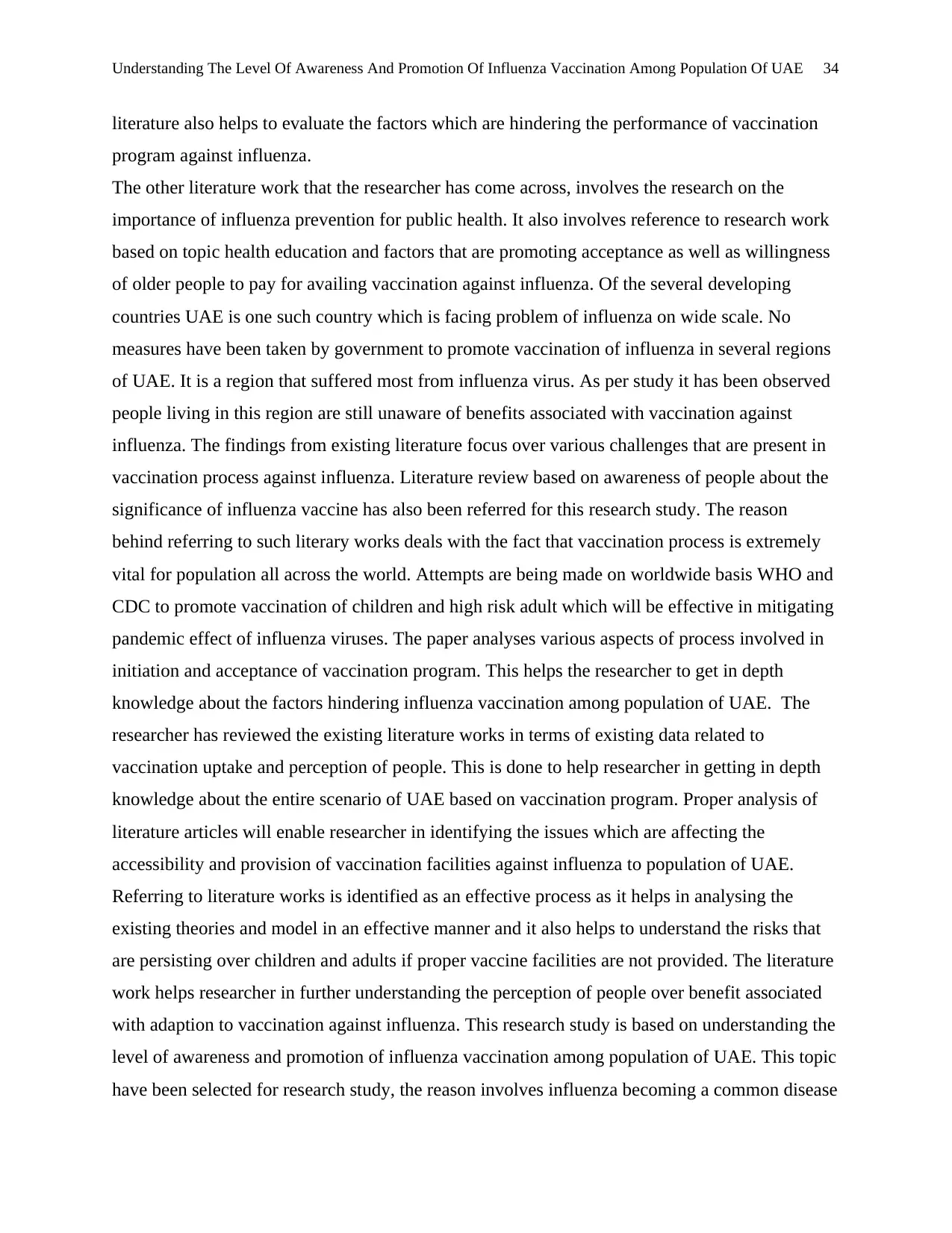
Understanding The Level Of Awareness And Promotion Of Influenza Vaccination Among Population Of UAE 34
literature also helps to evaluate the factors which are hindering the performance of vaccination
program against influenza.
The other literature work that the researcher has come across, involves the research on the
importance of influenza prevention for public health. It also involves reference to research work
based on topic health education and factors that are promoting acceptance as well as willingness
of older people to pay for availing vaccination against influenza. Of the several developing
countries UAE is one such country which is facing problem of influenza on wide scale. No
measures have been taken by government to promote vaccination of influenza in several regions
of UAE. It is a region that suffered most from influenza virus. As per study it has been observed
people living in this region are still unaware of benefits associated with vaccination against
influenza. The findings from existing literature focus over various challenges that are present in
vaccination process against influenza. Literature review based on awareness of people about the
significance of influenza vaccine has also been referred for this research study. The reason
behind referring to such literary works deals with the fact that vaccination process is extremely
vital for population all across the world. Attempts are being made on worldwide basis WHO and
CDC to promote vaccination of children and high risk adult which will be effective in mitigating
pandemic effect of influenza viruses. The paper analyses various aspects of process involved in
initiation and acceptance of vaccination program. This helps the researcher to get in depth
knowledge about the factors hindering influenza vaccination among population of UAE. The
researcher has reviewed the existing literature works in terms of existing data related to
vaccination uptake and perception of people. This is done to help researcher in getting in depth
knowledge about the entire scenario of UAE based on vaccination program. Proper analysis of
literature articles will enable researcher in identifying the issues which are affecting the
accessibility and provision of vaccination facilities against influenza to population of UAE.
Referring to literature works is identified as an effective process as it helps in analysing the
existing theories and model in an effective manner and it also helps to understand the risks that
are persisting over children and adults if proper vaccine facilities are not provided. The literature
work helps researcher in further understanding the perception of people over benefit associated
with adaption to vaccination against influenza. This research study is based on understanding the
level of awareness and promotion of influenza vaccination among population of UAE. This topic
have been selected for research study, the reason involves influenza becoming a common disease
literature also helps to evaluate the factors which are hindering the performance of vaccination
program against influenza.
The other literature work that the researcher has come across, involves the research on the
importance of influenza prevention for public health. It also involves reference to research work
based on topic health education and factors that are promoting acceptance as well as willingness
of older people to pay for availing vaccination against influenza. Of the several developing
countries UAE is one such country which is facing problem of influenza on wide scale. No
measures have been taken by government to promote vaccination of influenza in several regions
of UAE. It is a region that suffered most from influenza virus. As per study it has been observed
people living in this region are still unaware of benefits associated with vaccination against
influenza. The findings from existing literature focus over various challenges that are present in
vaccination process against influenza. Literature review based on awareness of people about the
significance of influenza vaccine has also been referred for this research study. The reason
behind referring to such literary works deals with the fact that vaccination process is extremely
vital for population all across the world. Attempts are being made on worldwide basis WHO and
CDC to promote vaccination of children and high risk adult which will be effective in mitigating
pandemic effect of influenza viruses. The paper analyses various aspects of process involved in
initiation and acceptance of vaccination program. This helps the researcher to get in depth
knowledge about the factors hindering influenza vaccination among population of UAE. The
researcher has reviewed the existing literature works in terms of existing data related to
vaccination uptake and perception of people. This is done to help researcher in getting in depth
knowledge about the entire scenario of UAE based on vaccination program. Proper analysis of
literature articles will enable researcher in identifying the issues which are affecting the
accessibility and provision of vaccination facilities against influenza to population of UAE.
Referring to literature works is identified as an effective process as it helps in analysing the
existing theories and model in an effective manner and it also helps to understand the risks that
are persisting over children and adults if proper vaccine facilities are not provided. The literature
work helps researcher in further understanding the perception of people over benefit associated
with adaption to vaccination against influenza. This research study is based on understanding the
level of awareness and promotion of influenza vaccination among population of UAE. This topic
have been selected for research study, the reason involves influenza becoming a common disease
Paraphrase This Document
Need a fresh take? Get an instant paraphrase of this document with our AI Paraphraser

Understanding The Level Of Awareness And Promotion Of Influenza Vaccination Among Population Of UAE 35
in most part of the world and very few attempt being taken by government developing and
underdeveloped countries to mitigate such health risks. According to the findings, developing as
well as developed countries are major target which has been adversely affected by influenza.
3.11 Gap analysis
In this research study, various research works available related to the topic are their which are
analysed and reviewed by researcher in order to gain in-depth knowledge about the research
topic. The literature works also cover the vaccination operations and the belief followed by the
population of UAE over up taking influenza vaccination. On analysis of the findings from
literature works it has been observed that several areas of study which has been left incomplete
or untouched in previous research. The lack of detailed information does not leave any future
scope for other researchers to take the research forward and provides inappropriate knowledge to
the readers. Moreover, some of the other gaps found in existing articles or literature works
includes the lack of discussion over the factors or the issues that are making government of UAE
to struggle over implementation of vaccination facilities for children and high risks adults. It can
be said that very less or no articles are present that compares the present and past record of
influenza affected deaths and indicates the major challenge responsible for such happenings.
Further discoveries in the existing literature works indicates that none of the research works have
pointed the challenges and problems faced by government in effectively initialising vaccination
promotion program. Adding on to it, the research work also lacks the recommendations and
suggestions for the elimination of existing issues and for improvement as well as enhancement in
vaccination uptake by people especially children and health care workers. All this untouched
sections in previous research works and the vitality of this section has forced the researcher to
choose understanding the level of awareness and promotion of influenza vaccination among
population of UAE as the research topic.
3. 12 Summary
This section of research study helps the researcher in understanding the previous researches done
in relation to this topic. Moreover, it helps the researcher with information that is vital in
conduction of research study. This is done to help researcher in getting in depth knowledge
about the entire scenario of UAE based on vaccination program. Proper analysis of literature
in most part of the world and very few attempt being taken by government developing and
underdeveloped countries to mitigate such health risks. According to the findings, developing as
well as developed countries are major target which has been adversely affected by influenza.
3.11 Gap analysis
In this research study, various research works available related to the topic are their which are
analysed and reviewed by researcher in order to gain in-depth knowledge about the research
topic. The literature works also cover the vaccination operations and the belief followed by the
population of UAE over up taking influenza vaccination. On analysis of the findings from
literature works it has been observed that several areas of study which has been left incomplete
or untouched in previous research. The lack of detailed information does not leave any future
scope for other researchers to take the research forward and provides inappropriate knowledge to
the readers. Moreover, some of the other gaps found in existing articles or literature works
includes the lack of discussion over the factors or the issues that are making government of UAE
to struggle over implementation of vaccination facilities for children and high risks adults. It can
be said that very less or no articles are present that compares the present and past record of
influenza affected deaths and indicates the major challenge responsible for such happenings.
Further discoveries in the existing literature works indicates that none of the research works have
pointed the challenges and problems faced by government in effectively initialising vaccination
promotion program. Adding on to it, the research work also lacks the recommendations and
suggestions for the elimination of existing issues and for improvement as well as enhancement in
vaccination uptake by people especially children and health care workers. All this untouched
sections in previous research works and the vitality of this section has forced the researcher to
choose understanding the level of awareness and promotion of influenza vaccination among
population of UAE as the research topic.
3. 12 Summary
This section of research study helps the researcher in understanding the previous researches done
in relation to this topic. Moreover, it helps the researcher with information that is vital in
conduction of research study. This is done to help researcher in getting in depth knowledge
about the entire scenario of UAE based on vaccination program. Proper analysis of literature
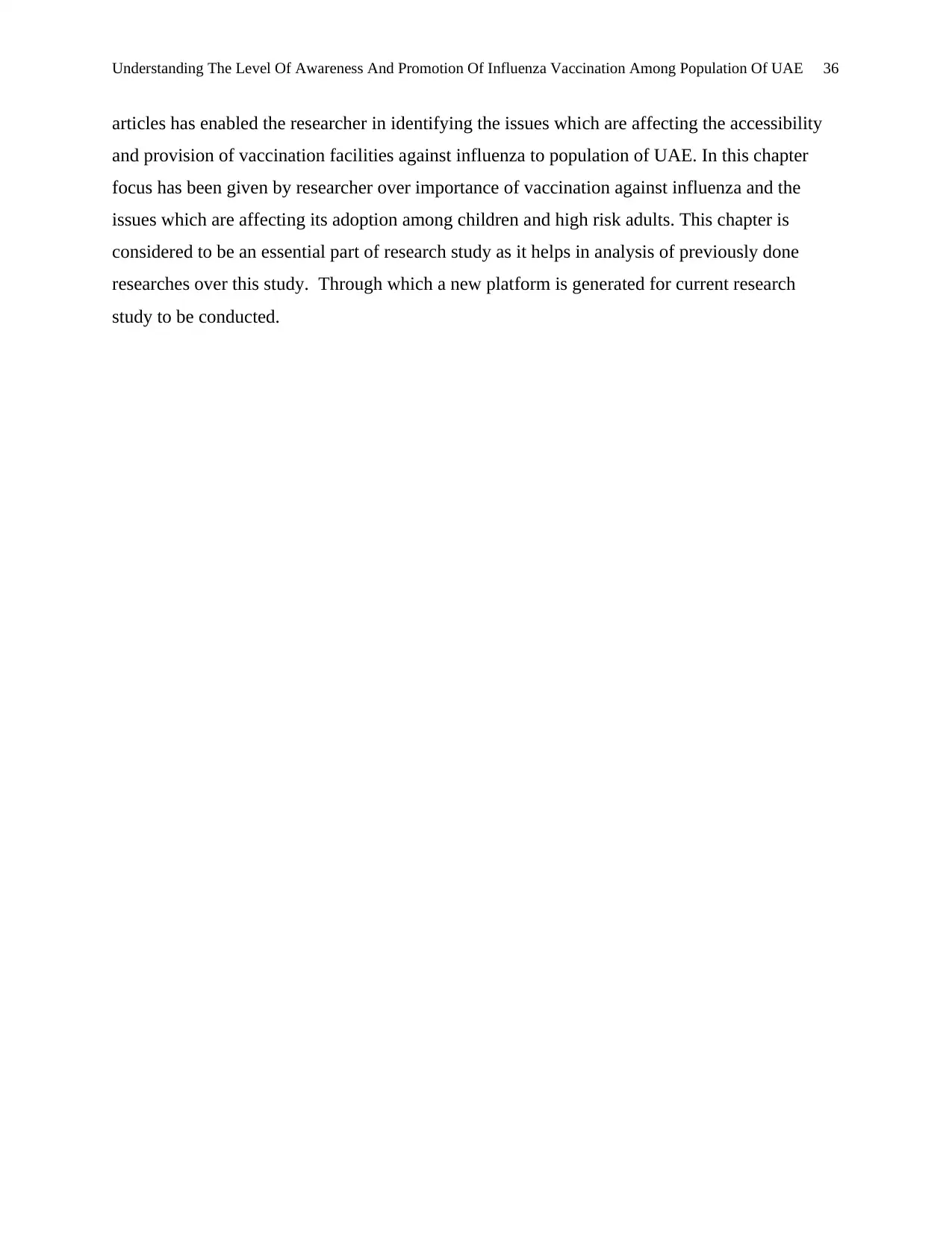
Understanding The Level Of Awareness And Promotion Of Influenza Vaccination Among Population Of UAE 36
articles has enabled the researcher in identifying the issues which are affecting the accessibility
and provision of vaccination facilities against influenza to population of UAE. In this chapter
focus has been given by researcher over importance of vaccination against influenza and the
issues which are affecting its adoption among children and high risk adults. This chapter is
considered to be an essential part of research study as it helps in analysis of previously done
researches over this study. Through which a new platform is generated for current research
study to be conducted.
articles has enabled the researcher in identifying the issues which are affecting the accessibility
and provision of vaccination facilities against influenza to population of UAE. In this chapter
focus has been given by researcher over importance of vaccination against influenza and the
issues which are affecting its adoption among children and high risk adults. This chapter is
considered to be an essential part of research study as it helps in analysis of previously done
researches over this study. Through which a new platform is generated for current research
study to be conducted.
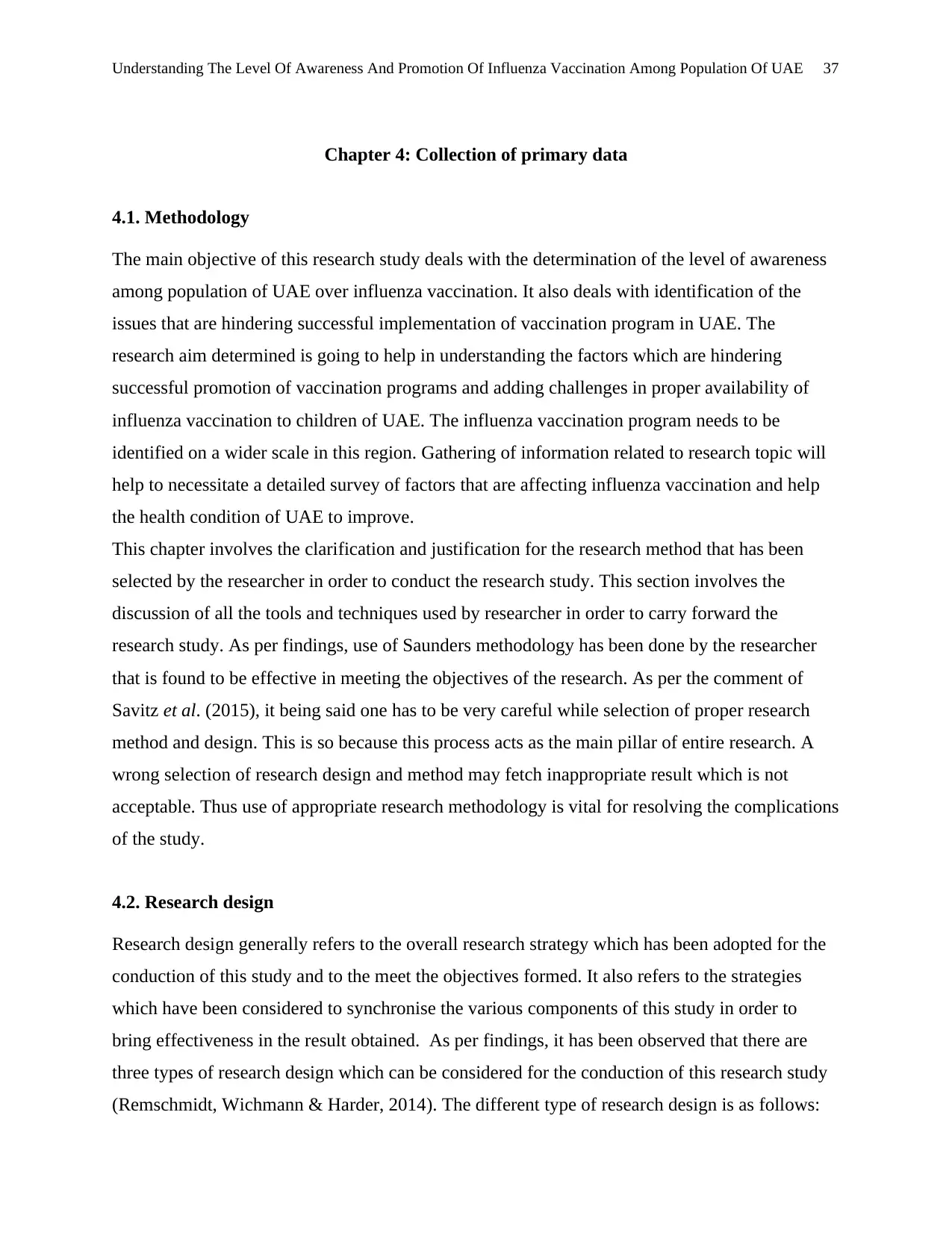
Understanding The Level Of Awareness And Promotion Of Influenza Vaccination Among Population Of UAE 37
Chapter 4: Collection of primary data
4.1. Methodology
The main objective of this research study deals with the determination of the level of awareness
among population of UAE over influenza vaccination. It also deals with identification of the
issues that are hindering successful implementation of vaccination program in UAE. The
research aim determined is going to help in understanding the factors which are hindering
successful promotion of vaccination programs and adding challenges in proper availability of
influenza vaccination to children of UAE. The influenza vaccination program needs to be
identified on a wider scale in this region. Gathering of information related to research topic will
help to necessitate a detailed survey of factors that are affecting influenza vaccination and help
the health condition of UAE to improve.
This chapter involves the clarification and justification for the research method that has been
selected by the researcher in order to conduct the research study. This section involves the
discussion of all the tools and techniques used by researcher in order to carry forward the
research study. As per findings, use of Saunders methodology has been done by the researcher
that is found to be effective in meeting the objectives of the research. As per the comment of
Savitz et al. (2015), it being said one has to be very careful while selection of proper research
method and design. This is so because this process acts as the main pillar of entire research. A
wrong selection of research design and method may fetch inappropriate result which is not
acceptable. Thus use of appropriate research methodology is vital for resolving the complications
of the study.
4.2. Research design
Research design generally refers to the overall research strategy which has been adopted for the
conduction of this study and to the meet the objectives formed. It also refers to the strategies
which have been considered to synchronise the various components of this study in order to
bring effectiveness in the result obtained. As per findings, it has been observed that there are
three types of research design which can be considered for the conduction of this research study
(Remschmidt, Wichmann & Harder, 2014). The different type of research design is as follows:
Chapter 4: Collection of primary data
4.1. Methodology
The main objective of this research study deals with the determination of the level of awareness
among population of UAE over influenza vaccination. It also deals with identification of the
issues that are hindering successful implementation of vaccination program in UAE. The
research aim determined is going to help in understanding the factors which are hindering
successful promotion of vaccination programs and adding challenges in proper availability of
influenza vaccination to children of UAE. The influenza vaccination program needs to be
identified on a wider scale in this region. Gathering of information related to research topic will
help to necessitate a detailed survey of factors that are affecting influenza vaccination and help
the health condition of UAE to improve.
This chapter involves the clarification and justification for the research method that has been
selected by the researcher in order to conduct the research study. This section involves the
discussion of all the tools and techniques used by researcher in order to carry forward the
research study. As per findings, use of Saunders methodology has been done by the researcher
that is found to be effective in meeting the objectives of the research. As per the comment of
Savitz et al. (2015), it being said one has to be very careful while selection of proper research
method and design. This is so because this process acts as the main pillar of entire research. A
wrong selection of research design and method may fetch inappropriate result which is not
acceptable. Thus use of appropriate research methodology is vital for resolving the complications
of the study.
4.2. Research design
Research design generally refers to the overall research strategy which has been adopted for the
conduction of this study and to the meet the objectives formed. It also refers to the strategies
which have been considered to synchronise the various components of this study in order to
bring effectiveness in the result obtained. As per findings, it has been observed that there are
three types of research design which can be considered for the conduction of this research study
(Remschmidt, Wichmann & Harder, 2014). The different type of research design is as follows:
Secure Best Marks with AI Grader
Need help grading? Try our AI Grader for instant feedback on your assignments.

Understanding The Level Of Awareness And Promotion Of Influenza Vaccination Among Population Of UAE 38
Exploratory design: this type of research design helps in identifying the impediments that are
related to the topic selected for current study.
Explanatory design: this type of research design helps in identification of the requirements and
components for research study. It helps in derivation of conclusion that are profound.
Descriptive design: this design deals with the study for depicting the participants of research in
an appropriate manner.
For this study, use of descriptive design has been selected by the researcher in order to bring
effectiveness in it research findings.
Use of descriptive design has been considered for this research study since this this design deals
with both dependent and independent variables. It also controls the variables that are present in
this study. Apart from this the main reason for selection such kind of research design deals with
the fact that it helps the researcher in gathering information based on statistical interpretation of
the research topic (Nagata et al. 2013). In addition to this, the selected research design helps in
identifying the potential factors which are hindering vaccination process against influenza in
UAE and other provinces of Saudi Arabia. The most beneficial component associated with use of
this design is that it allows the researcher to use both quantitative and qualitative method for
findings valid and vital information based on topic selected. However, use of primary
quantitative method has been identified by researcher for this study.
On the other hand, research design like exploratory has not been selected by the researcher. This
is so because only background of research study is taken into account by these designs.
Moreover, it does not indicate the factors which are associated with this research study. Use of
explanatory design has also been avoided by the researcher since it provides limited data or
information related to research topic (Baxter et al. 2014). In this type of design several factors
are missing which helps findings additional information based on research topic.
As per findings, research philosophy also plays a vital role in research study, since it deals with
the efficient process collecting, processing and utilising proper data. The researcher in order to
carry forward the research study has selected post positivism philosophy. This philosophy
selected is the most common philosophy which is being used researchers in order to get in depth
knowledge about the research topic. Moreover, this philosophy is based on real life facts and
data and helps in getting appropriate results.
Exploratory design: this type of research design helps in identifying the impediments that are
related to the topic selected for current study.
Explanatory design: this type of research design helps in identification of the requirements and
components for research study. It helps in derivation of conclusion that are profound.
Descriptive design: this design deals with the study for depicting the participants of research in
an appropriate manner.
For this study, use of descriptive design has been selected by the researcher in order to bring
effectiveness in it research findings.
Use of descriptive design has been considered for this research study since this this design deals
with both dependent and independent variables. It also controls the variables that are present in
this study. Apart from this the main reason for selection such kind of research design deals with
the fact that it helps the researcher in gathering information based on statistical interpretation of
the research topic (Nagata et al. 2013). In addition to this, the selected research design helps in
identifying the potential factors which are hindering vaccination process against influenza in
UAE and other provinces of Saudi Arabia. The most beneficial component associated with use of
this design is that it allows the researcher to use both quantitative and qualitative method for
findings valid and vital information based on topic selected. However, use of primary
quantitative method has been identified by researcher for this study.
On the other hand, research design like exploratory has not been selected by the researcher. This
is so because only background of research study is taken into account by these designs.
Moreover, it does not indicate the factors which are associated with this research study. Use of
explanatory design has also been avoided by the researcher since it provides limited data or
information related to research topic (Baxter et al. 2014). In this type of design several factors
are missing which helps findings additional information based on research topic.
As per findings, research philosophy also plays a vital role in research study, since it deals with
the efficient process collecting, processing and utilising proper data. The researcher in order to
carry forward the research study has selected post positivism philosophy. This philosophy
selected is the most common philosophy which is being used researchers in order to get in depth
knowledge about the research topic. Moreover, this philosophy is based on real life facts and
data and helps in getting appropriate results.
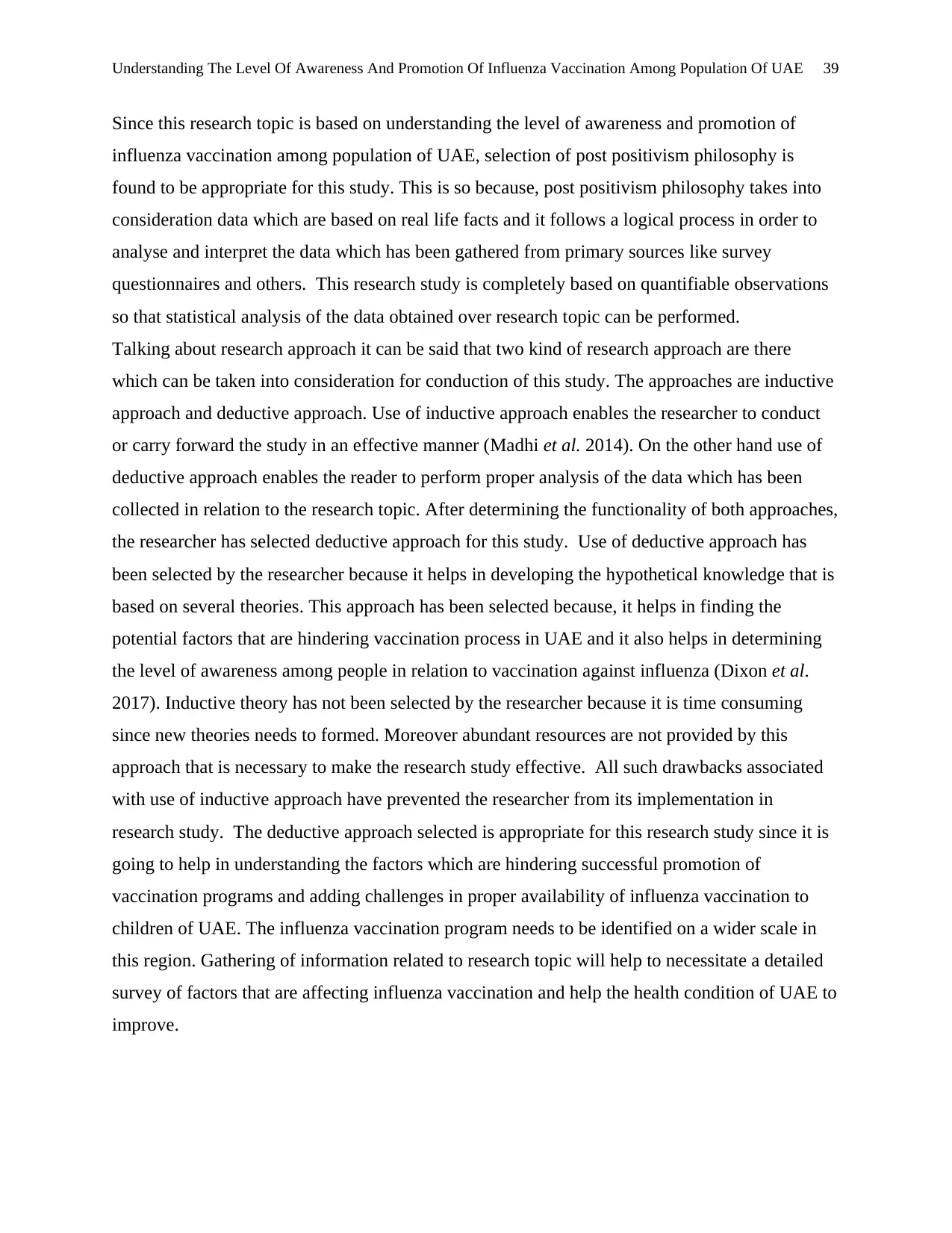
Understanding The Level Of Awareness And Promotion Of Influenza Vaccination Among Population Of UAE 39
Since this research topic is based on understanding the level of awareness and promotion of
influenza vaccination among population of UAE, selection of post positivism philosophy is
found to be appropriate for this study. This is so because, post positivism philosophy takes into
consideration data which are based on real life facts and it follows a logical process in order to
analyse and interpret the data which has been gathered from primary sources like survey
questionnaires and others. This research study is completely based on quantifiable observations
so that statistical analysis of the data obtained over research topic can be performed.
Talking about research approach it can be said that two kind of research approach are there
which can be taken into consideration for conduction of this study. The approaches are inductive
approach and deductive approach. Use of inductive approach enables the researcher to conduct
or carry forward the study in an effective manner (Madhi et al. 2014). On the other hand use of
deductive approach enables the reader to perform proper analysis of the data which has been
collected in relation to the research topic. After determining the functionality of both approaches,
the researcher has selected deductive approach for this study. Use of deductive approach has
been selected by the researcher because it helps in developing the hypothetical knowledge that is
based on several theories. This approach has been selected because, it helps in finding the
potential factors that are hindering vaccination process in UAE and it also helps in determining
the level of awareness among people in relation to vaccination against influenza (Dixon et al.
2017). Inductive theory has not been selected by the researcher because it is time consuming
since new theories needs to formed. Moreover abundant resources are not provided by this
approach that is necessary to make the research study effective. All such drawbacks associated
with use of inductive approach have prevented the researcher from its implementation in
research study. The deductive approach selected is appropriate for this research study since it is
going to help in understanding the factors which are hindering successful promotion of
vaccination programs and adding challenges in proper availability of influenza vaccination to
children of UAE. The influenza vaccination program needs to be identified on a wider scale in
this region. Gathering of information related to research topic will help to necessitate a detailed
survey of factors that are affecting influenza vaccination and help the health condition of UAE to
improve.
Since this research topic is based on understanding the level of awareness and promotion of
influenza vaccination among population of UAE, selection of post positivism philosophy is
found to be appropriate for this study. This is so because, post positivism philosophy takes into
consideration data which are based on real life facts and it follows a logical process in order to
analyse and interpret the data which has been gathered from primary sources like survey
questionnaires and others. This research study is completely based on quantifiable observations
so that statistical analysis of the data obtained over research topic can be performed.
Talking about research approach it can be said that two kind of research approach are there
which can be taken into consideration for conduction of this study. The approaches are inductive
approach and deductive approach. Use of inductive approach enables the researcher to conduct
or carry forward the study in an effective manner (Madhi et al. 2014). On the other hand use of
deductive approach enables the reader to perform proper analysis of the data which has been
collected in relation to the research topic. After determining the functionality of both approaches,
the researcher has selected deductive approach for this study. Use of deductive approach has
been selected by the researcher because it helps in developing the hypothetical knowledge that is
based on several theories. This approach has been selected because, it helps in finding the
potential factors that are hindering vaccination process in UAE and it also helps in determining
the level of awareness among people in relation to vaccination against influenza (Dixon et al.
2017). Inductive theory has not been selected by the researcher because it is time consuming
since new theories needs to formed. Moreover abundant resources are not provided by this
approach that is necessary to make the research study effective. All such drawbacks associated
with use of inductive approach have prevented the researcher from its implementation in
research study. The deductive approach selected is appropriate for this research study since it is
going to help in understanding the factors which are hindering successful promotion of
vaccination programs and adding challenges in proper availability of influenza vaccination to
children of UAE. The influenza vaccination program needs to be identified on a wider scale in
this region. Gathering of information related to research topic will help to necessitate a detailed
survey of factors that are affecting influenza vaccination and help the health condition of UAE to
improve.
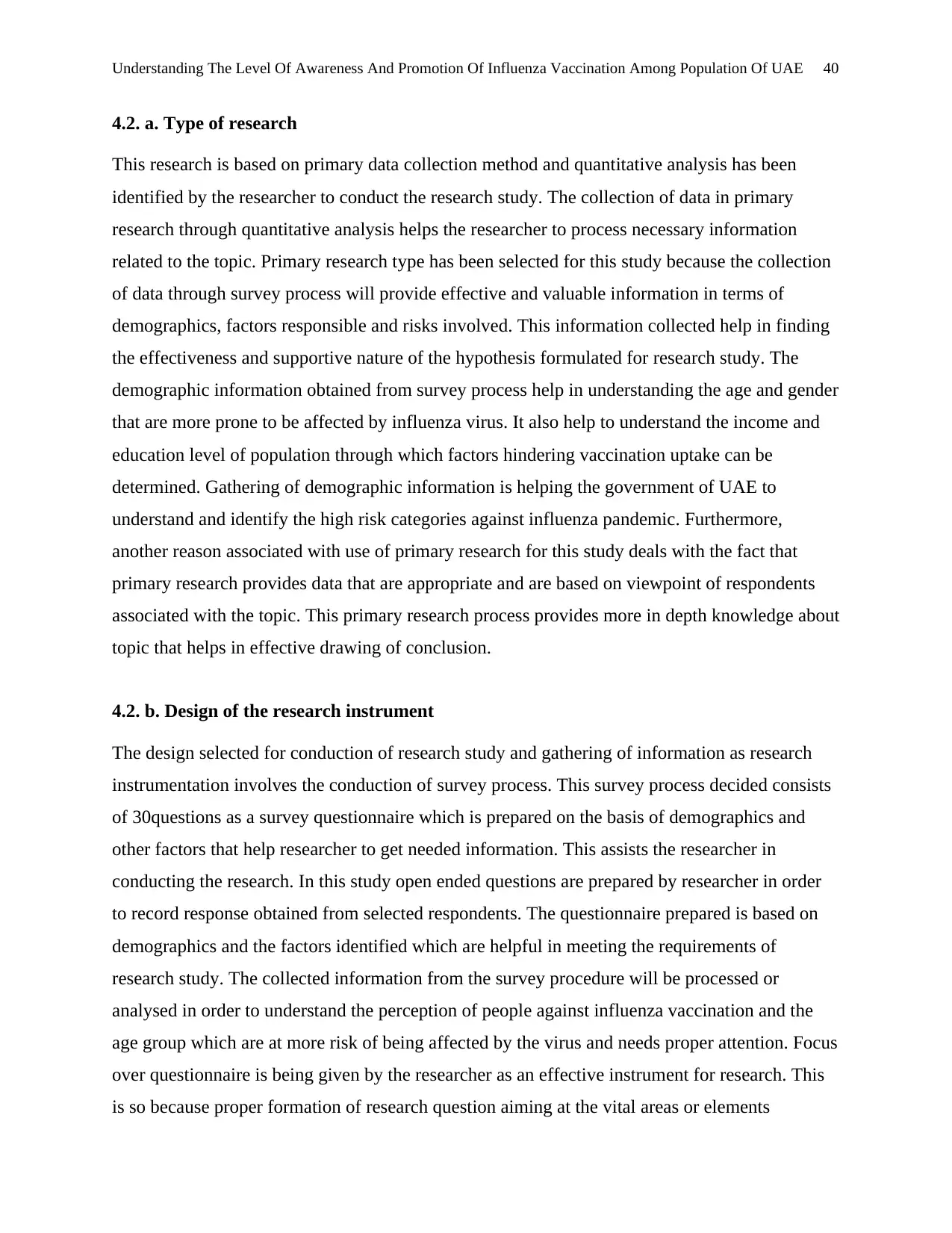
Understanding The Level Of Awareness And Promotion Of Influenza Vaccination Among Population Of UAE 40
4.2. a. Type of research
This research is based on primary data collection method and quantitative analysis has been
identified by the researcher to conduct the research study. The collection of data in primary
research through quantitative analysis helps the researcher to process necessary information
related to the topic. Primary research type has been selected for this study because the collection
of data through survey process will provide effective and valuable information in terms of
demographics, factors responsible and risks involved. This information collected help in finding
the effectiveness and supportive nature of the hypothesis formulated for research study. The
demographic information obtained from survey process help in understanding the age and gender
that are more prone to be affected by influenza virus. It also help to understand the income and
education level of population through which factors hindering vaccination uptake can be
determined. Gathering of demographic information is helping the government of UAE to
understand and identify the high risk categories against influenza pandemic. Furthermore,
another reason associated with use of primary research for this study deals with the fact that
primary research provides data that are appropriate and are based on viewpoint of respondents
associated with the topic. This primary research process provides more in depth knowledge about
topic that helps in effective drawing of conclusion.
4.2. b. Design of the research instrument
The design selected for conduction of research study and gathering of information as research
instrumentation involves the conduction of survey process. This survey process decided consists
of 30questions as a survey questionnaire which is prepared on the basis of demographics and
other factors that help researcher to get needed information. This assists the researcher in
conducting the research. In this study open ended questions are prepared by researcher in order
to record response obtained from selected respondents. The questionnaire prepared is based on
demographics and the factors identified which are helpful in meeting the requirements of
research study. The collected information from the survey procedure will be processed or
analysed in order to understand the perception of people against influenza vaccination and the
age group which are at more risk of being affected by the virus and needs proper attention. Focus
over questionnaire is being given by the researcher as an effective instrument for research. This
is so because proper formation of research question aiming at the vital areas or elements
4.2. a. Type of research
This research is based on primary data collection method and quantitative analysis has been
identified by the researcher to conduct the research study. The collection of data in primary
research through quantitative analysis helps the researcher to process necessary information
related to the topic. Primary research type has been selected for this study because the collection
of data through survey process will provide effective and valuable information in terms of
demographics, factors responsible and risks involved. This information collected help in finding
the effectiveness and supportive nature of the hypothesis formulated for research study. The
demographic information obtained from survey process help in understanding the age and gender
that are more prone to be affected by influenza virus. It also help to understand the income and
education level of population through which factors hindering vaccination uptake can be
determined. Gathering of demographic information is helping the government of UAE to
understand and identify the high risk categories against influenza pandemic. Furthermore,
another reason associated with use of primary research for this study deals with the fact that
primary research provides data that are appropriate and are based on viewpoint of respondents
associated with the topic. This primary research process provides more in depth knowledge about
topic that helps in effective drawing of conclusion.
4.2. b. Design of the research instrument
The design selected for conduction of research study and gathering of information as research
instrumentation involves the conduction of survey process. This survey process decided consists
of 30questions as a survey questionnaire which is prepared on the basis of demographics and
other factors that help researcher to get needed information. This assists the researcher in
conducting the research. In this study open ended questions are prepared by researcher in order
to record response obtained from selected respondents. The questionnaire prepared is based on
demographics and the factors identified which are helpful in meeting the requirements of
research study. The collected information from the survey procedure will be processed or
analysed in order to understand the perception of people against influenza vaccination and the
age group which are at more risk of being affected by the virus and needs proper attention. Focus
over questionnaire is being given by the researcher as an effective instrument for research. This
is so because proper formation of research question aiming at the vital areas or elements
Paraphrase This Document
Need a fresh take? Get an instant paraphrase of this document with our AI Paraphraser
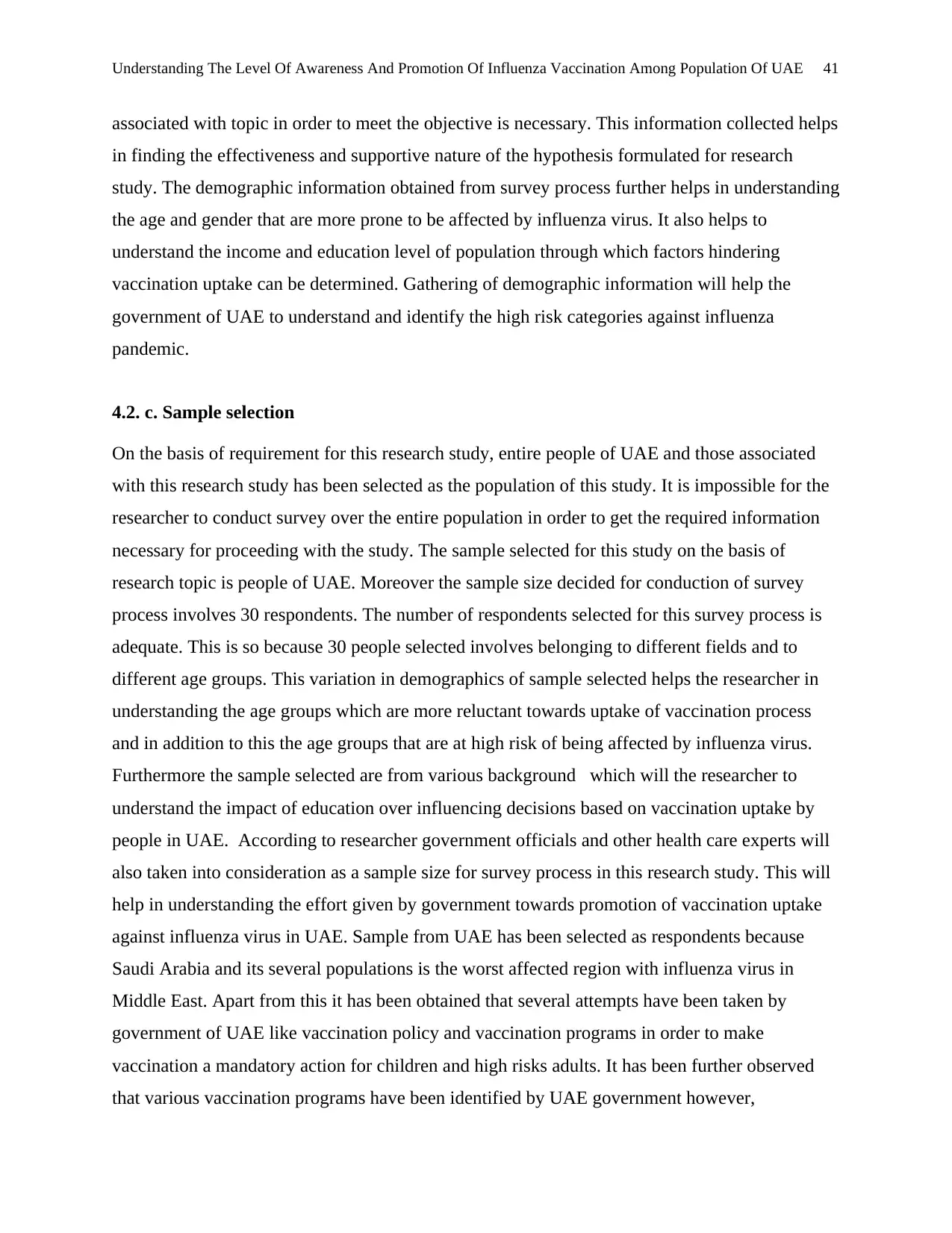
Understanding The Level Of Awareness And Promotion Of Influenza Vaccination Among Population Of UAE 41
associated with topic in order to meet the objective is necessary. This information collected helps
in finding the effectiveness and supportive nature of the hypothesis formulated for research
study. The demographic information obtained from survey process further helps in understanding
the age and gender that are more prone to be affected by influenza virus. It also helps to
understand the income and education level of population through which factors hindering
vaccination uptake can be determined. Gathering of demographic information will help the
government of UAE to understand and identify the high risk categories against influenza
pandemic.
4.2. c. Sample selection
On the basis of requirement for this research study, entire people of UAE and those associated
with this research study has been selected as the population of this study. It is impossible for the
researcher to conduct survey over the entire population in order to get the required information
necessary for proceeding with the study. The sample selected for this study on the basis of
research topic is people of UAE. Moreover the sample size decided for conduction of survey
process involves 30 respondents. The number of respondents selected for this survey process is
adequate. This is so because 30 people selected involves belonging to different fields and to
different age groups. This variation in demographics of sample selected helps the researcher in
understanding the age groups which are more reluctant towards uptake of vaccination process
and in addition to this the age groups that are at high risk of being affected by influenza virus.
Furthermore the sample selected are from various background which will the researcher to
understand the impact of education over influencing decisions based on vaccination uptake by
people in UAE. According to researcher government officials and other health care experts will
also taken into consideration as a sample size for survey process in this research study. This will
help in understanding the effort given by government towards promotion of vaccination uptake
against influenza virus in UAE. Sample from UAE has been selected as respondents because
Saudi Arabia and its several populations is the worst affected region with influenza virus in
Middle East. Apart from this it has been obtained that several attempts have been taken by
government of UAE like vaccination policy and vaccination programs in order to make
vaccination a mandatory action for children and high risks adults. It has been further observed
that various vaccination programs have been identified by UAE government however,
associated with topic in order to meet the objective is necessary. This information collected helps
in finding the effectiveness and supportive nature of the hypothesis formulated for research
study. The demographic information obtained from survey process further helps in understanding
the age and gender that are more prone to be affected by influenza virus. It also helps to
understand the income and education level of population through which factors hindering
vaccination uptake can be determined. Gathering of demographic information will help the
government of UAE to understand and identify the high risk categories against influenza
pandemic.
4.2. c. Sample selection
On the basis of requirement for this research study, entire people of UAE and those associated
with this research study has been selected as the population of this study. It is impossible for the
researcher to conduct survey over the entire population in order to get the required information
necessary for proceeding with the study. The sample selected for this study on the basis of
research topic is people of UAE. Moreover the sample size decided for conduction of survey
process involves 30 respondents. The number of respondents selected for this survey process is
adequate. This is so because 30 people selected involves belonging to different fields and to
different age groups. This variation in demographics of sample selected helps the researcher in
understanding the age groups which are more reluctant towards uptake of vaccination process
and in addition to this the age groups that are at high risk of being affected by influenza virus.
Furthermore the sample selected are from various background which will the researcher to
understand the impact of education over influencing decisions based on vaccination uptake by
people in UAE. According to researcher government officials and other health care experts will
also taken into consideration as a sample size for survey process in this research study. This will
help in understanding the effort given by government towards promotion of vaccination uptake
against influenza virus in UAE. Sample from UAE has been selected as respondents because
Saudi Arabia and its several populations is the worst affected region with influenza virus in
Middle East. Apart from this it has been obtained that several attempts have been taken by
government of UAE like vaccination policy and vaccination programs in order to make
vaccination a mandatory action for children and high risks adults. It has been further observed
that various vaccination programs have been identified by UAE government however,
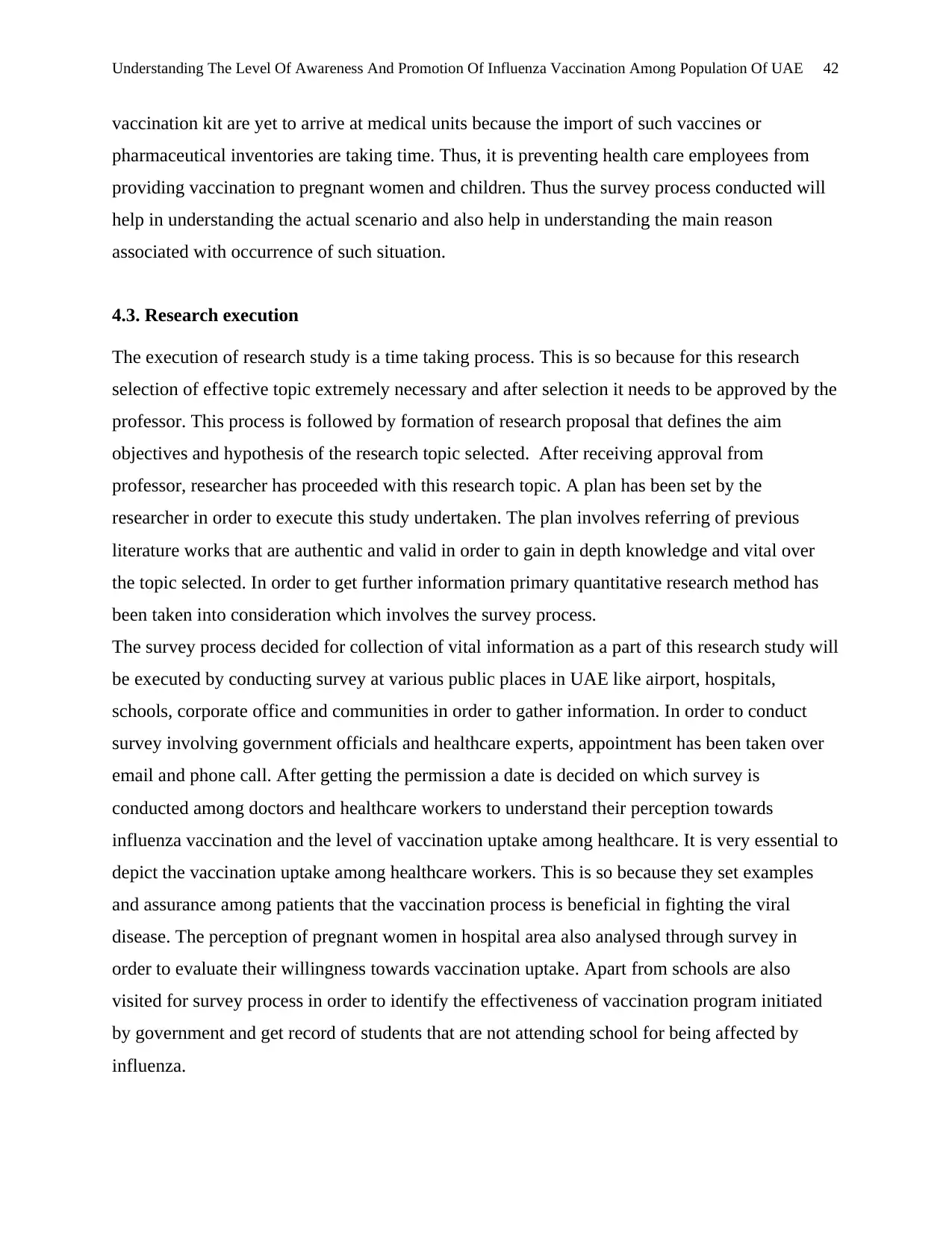
Understanding The Level Of Awareness And Promotion Of Influenza Vaccination Among Population Of UAE 42
vaccination kit are yet to arrive at medical units because the import of such vaccines or
pharmaceutical inventories are taking time. Thus, it is preventing health care employees from
providing vaccination to pregnant women and children. Thus the survey process conducted will
help in understanding the actual scenario and also help in understanding the main reason
associated with occurrence of such situation.
4.3. Research execution
The execution of research study is a time taking process. This is so because for this research
selection of effective topic extremely necessary and after selection it needs to be approved by the
professor. This process is followed by formation of research proposal that defines the aim
objectives and hypothesis of the research topic selected. After receiving approval from
professor, researcher has proceeded with this research topic. A plan has been set by the
researcher in order to execute this study undertaken. The plan involves referring of previous
literature works that are authentic and valid in order to gain in depth knowledge and vital over
the topic selected. In order to get further information primary quantitative research method has
been taken into consideration which involves the survey process.
The survey process decided for collection of vital information as a part of this research study will
be executed by conducting survey at various public places in UAE like airport, hospitals,
schools, corporate office and communities in order to gather information. In order to conduct
survey involving government officials and healthcare experts, appointment has been taken over
email and phone call. After getting the permission a date is decided on which survey is
conducted among doctors and healthcare workers to understand their perception towards
influenza vaccination and the level of vaccination uptake among healthcare. It is very essential to
depict the vaccination uptake among healthcare workers. This is so because they set examples
and assurance among patients that the vaccination process is beneficial in fighting the viral
disease. The perception of pregnant women in hospital area also analysed through survey in
order to evaluate their willingness towards vaccination uptake. Apart from schools are also
visited for survey process in order to identify the effectiveness of vaccination program initiated
by government and get record of students that are not attending school for being affected by
influenza.
vaccination kit are yet to arrive at medical units because the import of such vaccines or
pharmaceutical inventories are taking time. Thus, it is preventing health care employees from
providing vaccination to pregnant women and children. Thus the survey process conducted will
help in understanding the actual scenario and also help in understanding the main reason
associated with occurrence of such situation.
4.3. Research execution
The execution of research study is a time taking process. This is so because for this research
selection of effective topic extremely necessary and after selection it needs to be approved by the
professor. This process is followed by formation of research proposal that defines the aim
objectives and hypothesis of the research topic selected. After receiving approval from
professor, researcher has proceeded with this research topic. A plan has been set by the
researcher in order to execute this study undertaken. The plan involves referring of previous
literature works that are authentic and valid in order to gain in depth knowledge and vital over
the topic selected. In order to get further information primary quantitative research method has
been taken into consideration which involves the survey process.
The survey process decided for collection of vital information as a part of this research study will
be executed by conducting survey at various public places in UAE like airport, hospitals,
schools, corporate office and communities in order to gather information. In order to conduct
survey involving government officials and healthcare experts, appointment has been taken over
email and phone call. After getting the permission a date is decided on which survey is
conducted among doctors and healthcare workers to understand their perception towards
influenza vaccination and the level of vaccination uptake among healthcare. It is very essential to
depict the vaccination uptake among healthcare workers. This is so because they set examples
and assurance among patients that the vaccination process is beneficial in fighting the viral
disease. The perception of pregnant women in hospital area also analysed through survey in
order to evaluate their willingness towards vaccination uptake. Apart from schools are also
visited for survey process in order to identify the effectiveness of vaccination program initiated
by government and get record of students that are not attending school for being affected by
influenza.
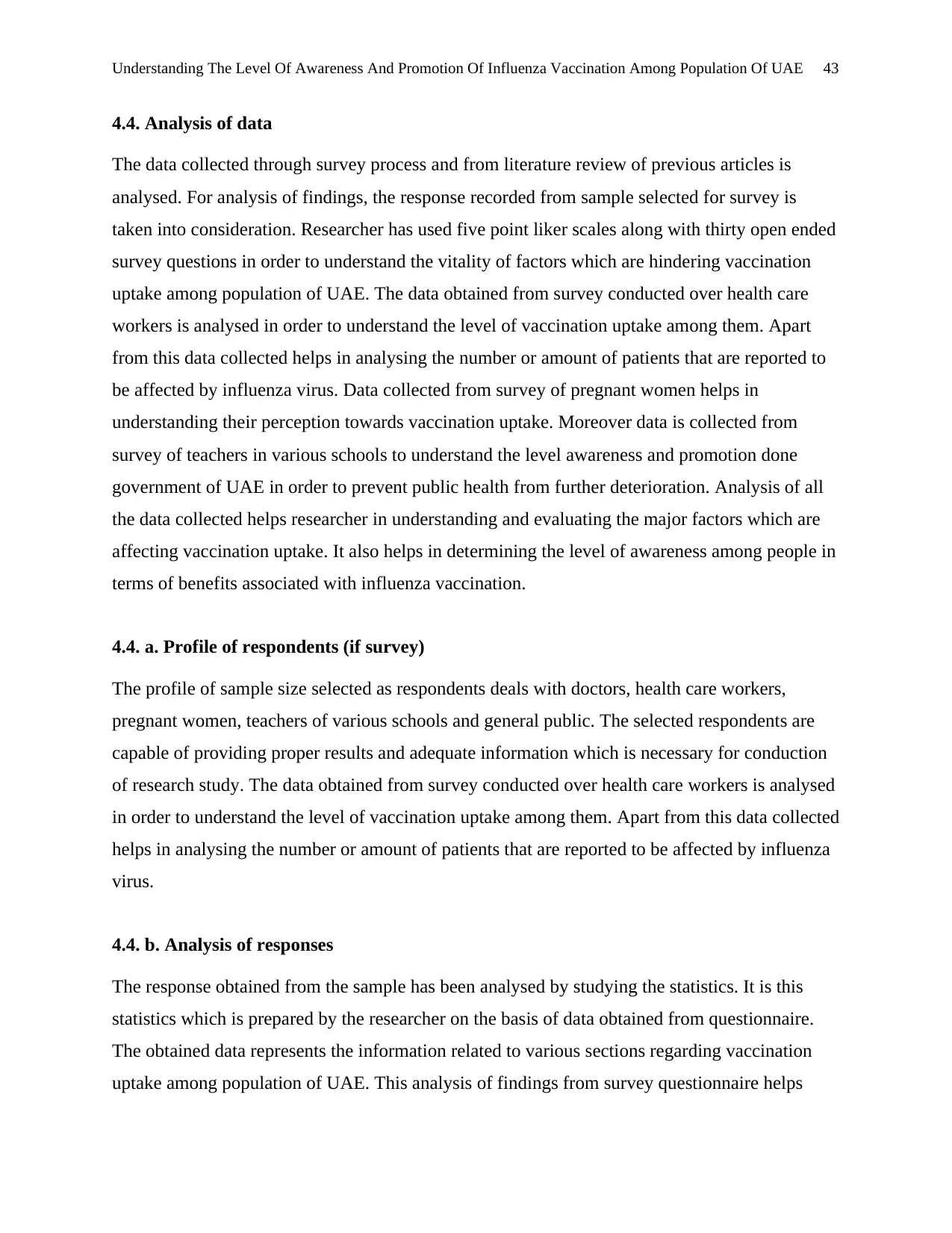
Understanding The Level Of Awareness And Promotion Of Influenza Vaccination Among Population Of UAE 43
4.4. Analysis of data
The data collected through survey process and from literature review of previous articles is
analysed. For analysis of findings, the response recorded from sample selected for survey is
taken into consideration. Researcher has used five point liker scales along with thirty open ended
survey questions in order to understand the vitality of factors which are hindering vaccination
uptake among population of UAE. The data obtained from survey conducted over health care
workers is analysed in order to understand the level of vaccination uptake among them. Apart
from this data collected helps in analysing the number or amount of patients that are reported to
be affected by influenza virus. Data collected from survey of pregnant women helps in
understanding their perception towards vaccination uptake. Moreover data is collected from
survey of teachers in various schools to understand the level awareness and promotion done
government of UAE in order to prevent public health from further deterioration. Analysis of all
the data collected helps researcher in understanding and evaluating the major factors which are
affecting vaccination uptake. It also helps in determining the level of awareness among people in
terms of benefits associated with influenza vaccination.
4.4. a. Profile of respondents (if survey)
The profile of sample size selected as respondents deals with doctors, health care workers,
pregnant women, teachers of various schools and general public. The selected respondents are
capable of providing proper results and adequate information which is necessary for conduction
of research study. The data obtained from survey conducted over health care workers is analysed
in order to understand the level of vaccination uptake among them. Apart from this data collected
helps in analysing the number or amount of patients that are reported to be affected by influenza
virus.
4.4. b. Analysis of responses
The response obtained from the sample has been analysed by studying the statistics. It is this
statistics which is prepared by the researcher on the basis of data obtained from questionnaire.
The obtained data represents the information related to various sections regarding vaccination
uptake among population of UAE. This analysis of findings from survey questionnaire helps
4.4. Analysis of data
The data collected through survey process and from literature review of previous articles is
analysed. For analysis of findings, the response recorded from sample selected for survey is
taken into consideration. Researcher has used five point liker scales along with thirty open ended
survey questions in order to understand the vitality of factors which are hindering vaccination
uptake among population of UAE. The data obtained from survey conducted over health care
workers is analysed in order to understand the level of vaccination uptake among them. Apart
from this data collected helps in analysing the number or amount of patients that are reported to
be affected by influenza virus. Data collected from survey of pregnant women helps in
understanding their perception towards vaccination uptake. Moreover data is collected from
survey of teachers in various schools to understand the level awareness and promotion done
government of UAE in order to prevent public health from further deterioration. Analysis of all
the data collected helps researcher in understanding and evaluating the major factors which are
affecting vaccination uptake. It also helps in determining the level of awareness among people in
terms of benefits associated with influenza vaccination.
4.4. a. Profile of respondents (if survey)
The profile of sample size selected as respondents deals with doctors, health care workers,
pregnant women, teachers of various schools and general public. The selected respondents are
capable of providing proper results and adequate information which is necessary for conduction
of research study. The data obtained from survey conducted over health care workers is analysed
in order to understand the level of vaccination uptake among them. Apart from this data collected
helps in analysing the number or amount of patients that are reported to be affected by influenza
virus.
4.4. b. Analysis of responses
The response obtained from the sample has been analysed by studying the statistics. It is this
statistics which is prepared by the researcher on the basis of data obtained from questionnaire.
The obtained data represents the information related to various sections regarding vaccination
uptake among population of UAE. This analysis of findings from survey questionnaire helps
Secure Best Marks with AI Grader
Need help grading? Try our AI Grader for instant feedback on your assignments.

Understanding The Level Of Awareness And Promotion Of Influenza Vaccination Among Population Of UAE 44
researcher in testing the effectiveness of Hypothesis formed in earlier section of this study. The
data from respondents is collected in the form questionnaires.
researcher in testing the effectiveness of Hypothesis formed in earlier section of this study. The
data from respondents is collected in the form questionnaires.

Understanding The Level Of Awareness And Promotion Of Influenza Vaccination Among Population Of UAE 45
Chapter 5 Analysis and conclusion
5.1. Hypothesis testing
Survey of 30 respondents is to be conducted in order to identify effectiveness of Hypothesis
framed in supporting the research study. The respondents selected for the survey process are
health care workers, pregnant women, teachers and general public. The response obtained has
helped in understanding and evaluating the hypothesis of this research. The H0 and H1 framed
for this research study helps in analysing the level of awareness among people of UAE regarding
the influenza vaccination process.
Survey Questionnaire for Hypothesis testing
Health care workers and medical students
Q1. How far do you agree that children of 0 to 3 years and people of 35 to 60 years should
intake influenza vaccination?
Options No. Respondents Total No. of
Respondents
Number of
Respondents
Strongly disagree 1 10 10%
Disagree 1 10 10%
Neither disagree nor
agree
2 10 20%
Agree 3 10 30%
Strongly agree 3 10 30%
Table 5.1: Response towards influenza vaccination intake
(Source: Self Developed)
Chapter 5 Analysis and conclusion
5.1. Hypothesis testing
Survey of 30 respondents is to be conducted in order to identify effectiveness of Hypothesis
framed in supporting the research study. The respondents selected for the survey process are
health care workers, pregnant women, teachers and general public. The response obtained has
helped in understanding and evaluating the hypothesis of this research. The H0 and H1 framed
for this research study helps in analysing the level of awareness among people of UAE regarding
the influenza vaccination process.
Survey Questionnaire for Hypothesis testing
Health care workers and medical students
Q1. How far do you agree that children of 0 to 3 years and people of 35 to 60 years should
intake influenza vaccination?
Options No. Respondents Total No. of
Respondents
Number of
Respondents
Strongly disagree 1 10 10%
Disagree 1 10 10%
Neither disagree nor
agree
2 10 20%
Agree 3 10 30%
Strongly agree 3 10 30%
Table 5.1: Response towards influenza vaccination intake
(Source: Self Developed)

Understanding The Level Of Awareness And Promotion Of Influenza Vaccination Among Population Of UAE 46
0 to 6 months;
Number of
Respondents ; 30%
1 year; Number of
Respondents ; 20%
1 to 1.5 years;
Number of
Respondents ; 10%
2 years; Number of
Respondents ; 20%
2.5 years ; Number
of Respondents ;
20%
Respondents agreed with influenza vaccination intake
Number of Respondents
Figure 5.1: Number of respondent’s beliefs with influenza vaccination intake
(Source: Self developed)
Q2. How far do you agree that influenza vaccination is effective in eliminating the risks of
influenza?
Options No. Respondents Total No. of
Respondents
Number of
Respondents
Strongly disagree 1 10 10%
Disagree 1 10 10%
Neither disagree nor
agree
1 10 10%
Agree 3 10 30%
Strongly agree 4 10 40%
Table 5.2: Response about effectiveness of influenza vaccination
(Source: Self developed)
0 to 6 months;
Number of
Respondents ; 30%
1 year; Number of
Respondents ; 20%
1 to 1.5 years;
Number of
Respondents ; 10%
2 years; Number of
Respondents ; 20%
2.5 years ; Number
of Respondents ;
20%
Respondents agreed with influenza vaccination intake
Number of Respondents
Figure 5.1: Number of respondent’s beliefs with influenza vaccination intake
(Source: Self developed)
Q2. How far do you agree that influenza vaccination is effective in eliminating the risks of
influenza?
Options No. Respondents Total No. of
Respondents
Number of
Respondents
Strongly disagree 1 10 10%
Disagree 1 10 10%
Neither disagree nor
agree
1 10 10%
Agree 3 10 30%
Strongly agree 4 10 40%
Table 5.2: Response about effectiveness of influenza vaccination
(Source: Self developed)
Paraphrase This Document
Need a fresh take? Get an instant paraphrase of this document with our AI Paraphraser
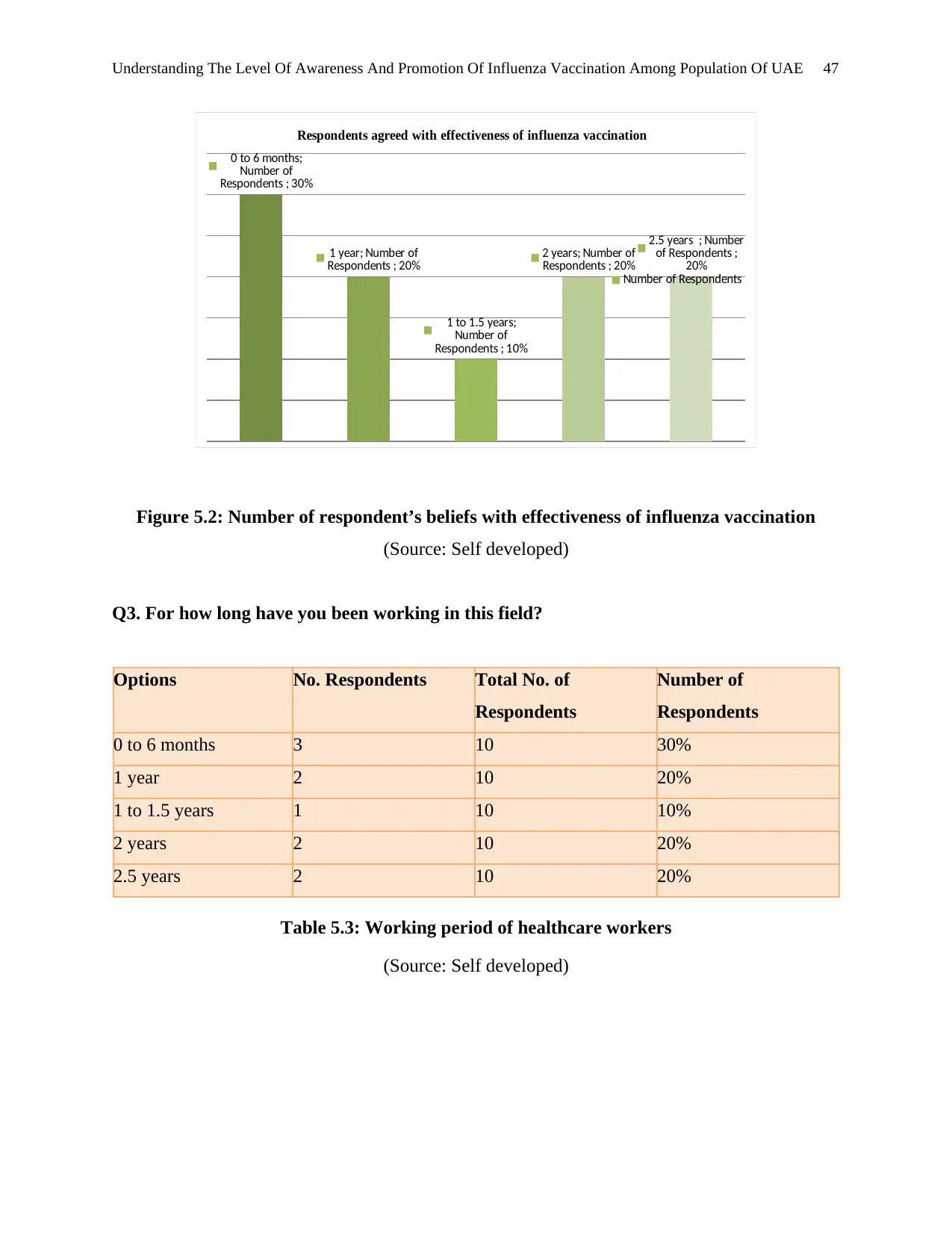
Understanding The Level Of Awareness And Promotion Of Influenza Vaccination Among Population Of UAE 47
0 to 6 months;
Number of
Respondents ; 30%
1 year; Number of
Respondents ; 20%
1 to 1.5 years;
Number of
Respondents ; 10%
2 years; Number of
Respondents ; 20%
2.5 years ; Number
of Respondents ;
20%
Respondents agreed with effectiveness of influenza vaccination
Number of Respondents
Figure 5.2: Number of respondent’s beliefs with effectiveness of influenza vaccination
(Source: Self developed)
Q3. For how long have you been working in this field?
Options No. Respondents Total No. of
Respondents
Number of
Respondents
0 to 6 months 3 10 30%
1 year 2 10 20%
1 to 1.5 years 1 10 10%
2 years 2 10 20%
2.5 years 2 10 20%
Table 5.3: Working period of healthcare workers
(Source: Self developed)
0 to 6 months;
Number of
Respondents ; 30%
1 year; Number of
Respondents ; 20%
1 to 1.5 years;
Number of
Respondents ; 10%
2 years; Number of
Respondents ; 20%
2.5 years ; Number
of Respondents ;
20%
Respondents agreed with effectiveness of influenza vaccination
Number of Respondents
Figure 5.2: Number of respondent’s beliefs with effectiveness of influenza vaccination
(Source: Self developed)
Q3. For how long have you been working in this field?
Options No. Respondents Total No. of
Respondents
Number of
Respondents
0 to 6 months 3 10 30%
1 year 2 10 20%
1 to 1.5 years 1 10 10%
2 years 2 10 20%
2.5 years 2 10 20%
Table 5.3: Working period of healthcare workers
(Source: Self developed)
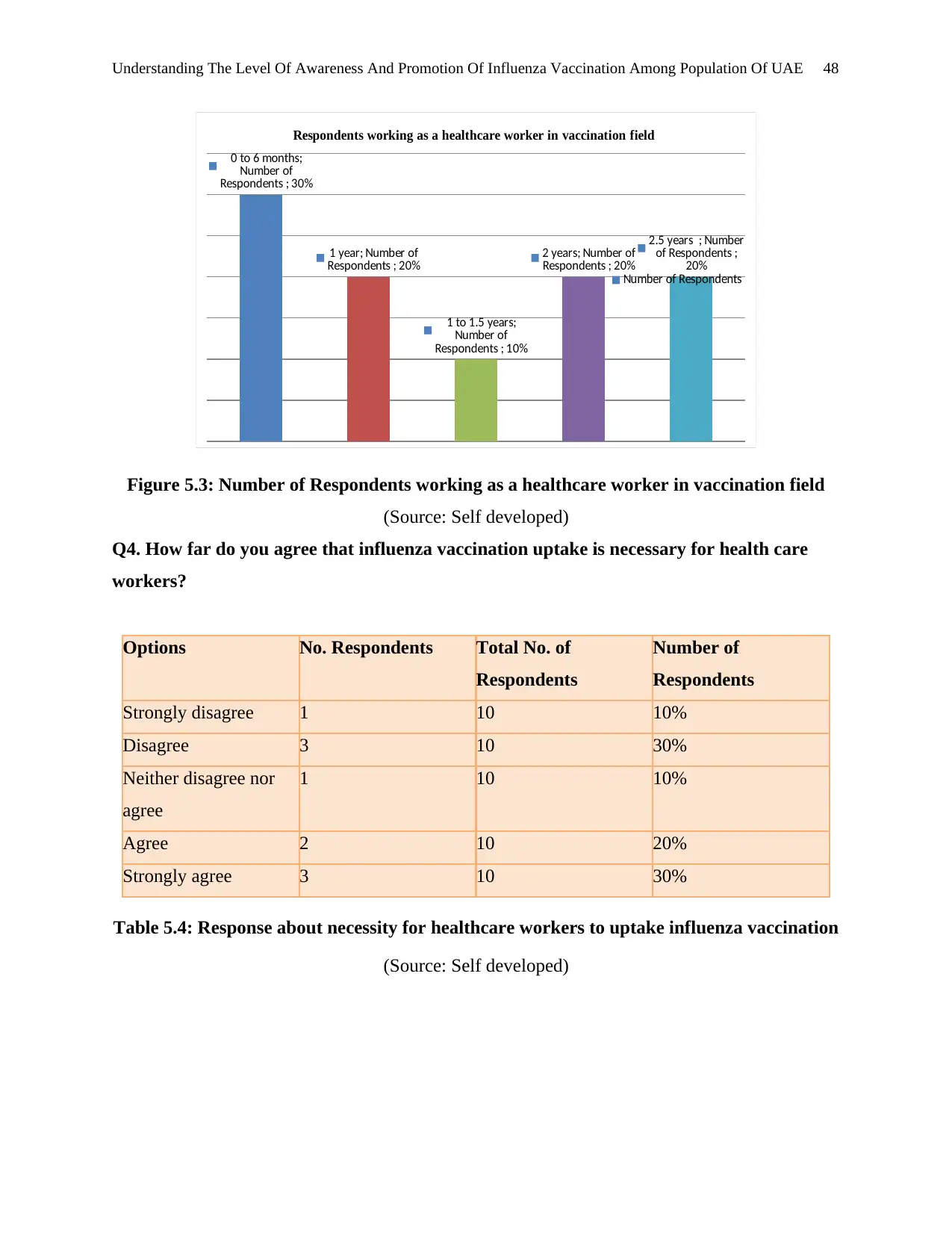
Understanding The Level Of Awareness And Promotion Of Influenza Vaccination Among Population Of UAE 48
0 to 6 months;
Number of
Respondents ; 30%
1 year; Number of
Respondents ; 20%
1 to 1.5 years;
Number of
Respondents ; 10%
2 years; Number of
Respondents ; 20%
2.5 years ; Number
of Respondents ;
20%
Respondents working as a healthcare worker in vaccination field
Number of Respondents
Figure 5.3: Number of Respondents working as a healthcare worker in vaccination field
(Source: Self developed)
Q4. How far do you agree that influenza vaccination uptake is necessary for health care
workers?
Options No. Respondents Total No. of
Respondents
Number of
Respondents
Strongly disagree 1 10 10%
Disagree 3 10 30%
Neither disagree nor
agree
1 10 10%
Agree 2 10 20%
Strongly agree 3 10 30%
Table 5.4: Response about necessity for healthcare workers to uptake influenza vaccination
(Source: Self developed)
0 to 6 months;
Number of
Respondents ; 30%
1 year; Number of
Respondents ; 20%
1 to 1.5 years;
Number of
Respondents ; 10%
2 years; Number of
Respondents ; 20%
2.5 years ; Number
of Respondents ;
20%
Respondents working as a healthcare worker in vaccination field
Number of Respondents
Figure 5.3: Number of Respondents working as a healthcare worker in vaccination field
(Source: Self developed)
Q4. How far do you agree that influenza vaccination uptake is necessary for health care
workers?
Options No. Respondents Total No. of
Respondents
Number of
Respondents
Strongly disagree 1 10 10%
Disagree 3 10 30%
Neither disagree nor
agree
1 10 10%
Agree 2 10 20%
Strongly agree 3 10 30%
Table 5.4: Response about necessity for healthcare workers to uptake influenza vaccination
(Source: Self developed)
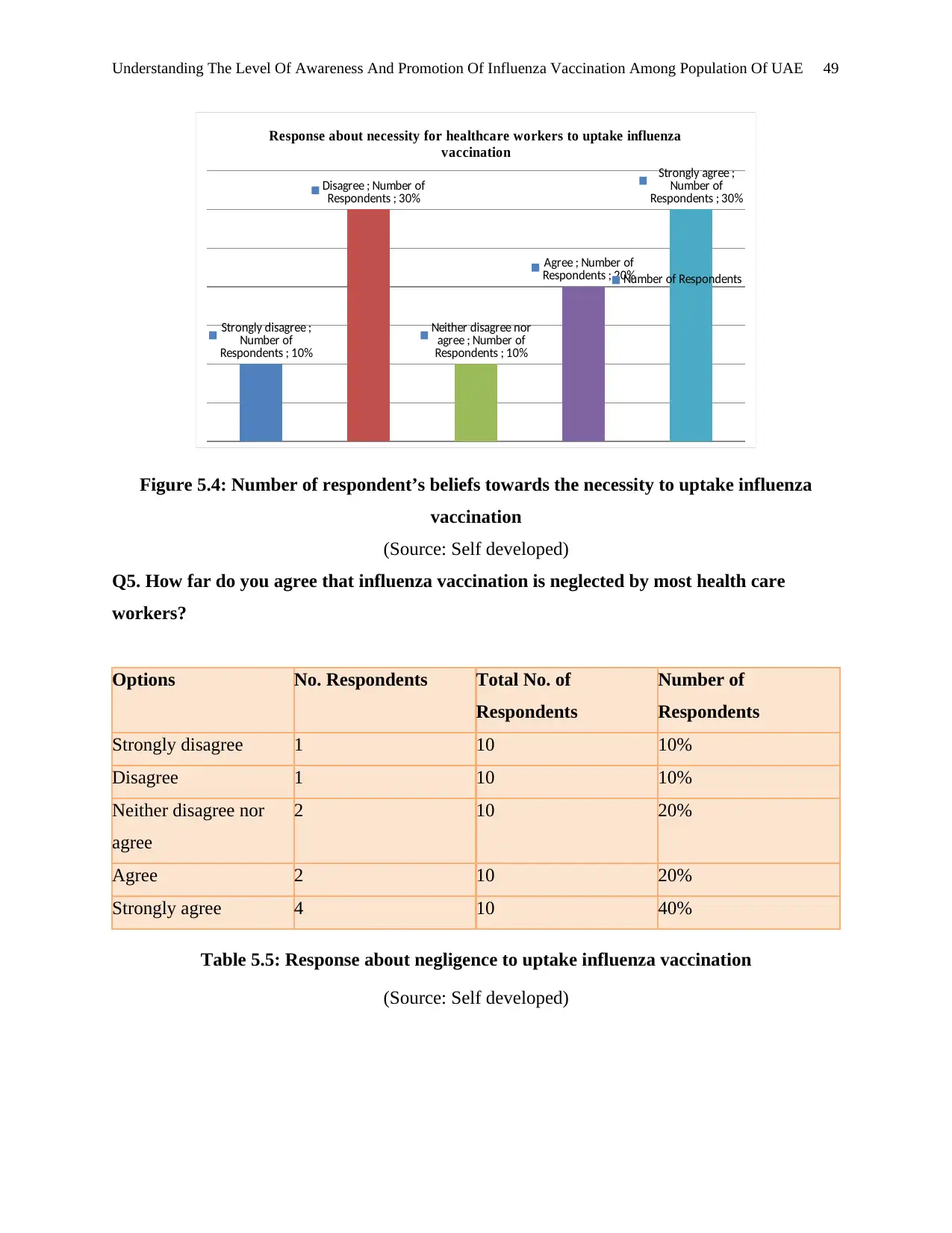
Understanding The Level Of Awareness And Promotion Of Influenza Vaccination Among Population Of UAE 49
Strongly disagree ;
Number of
Respondents ; 10%
Disagree ; Number of
Respondents ; 30%
Neither disagree nor
agree ; Number of
Respondents ; 10%
Agree ; Number of
Respondents ; 20%
Strongly agree ;
Number of
Respondents ; 30%
Response about necessity for healthcare workers to uptake influenza
vaccination
Number of Respondents
Figure 5.4: Number of respondent’s beliefs towards the necessity to uptake influenza
vaccination
(Source: Self developed)
Q5. How far do you agree that influenza vaccination is neglected by most health care
workers?
Options No. Respondents Total No. of
Respondents
Number of
Respondents
Strongly disagree 1 10 10%
Disagree 1 10 10%
Neither disagree nor
agree
2 10 20%
Agree 2 10 20%
Strongly agree 4 10 40%
Table 5.5: Response about negligence to uptake influenza vaccination
(Source: Self developed)
Strongly disagree ;
Number of
Respondents ; 10%
Disagree ; Number of
Respondents ; 30%
Neither disagree nor
agree ; Number of
Respondents ; 10%
Agree ; Number of
Respondents ; 20%
Strongly agree ;
Number of
Respondents ; 30%
Response about necessity for healthcare workers to uptake influenza
vaccination
Number of Respondents
Figure 5.4: Number of respondent’s beliefs towards the necessity to uptake influenza
vaccination
(Source: Self developed)
Q5. How far do you agree that influenza vaccination is neglected by most health care
workers?
Options No. Respondents Total No. of
Respondents
Number of
Respondents
Strongly disagree 1 10 10%
Disagree 1 10 10%
Neither disagree nor
agree
2 10 20%
Agree 2 10 20%
Strongly agree 4 10 40%
Table 5.5: Response about negligence to uptake influenza vaccination
(Source: Self developed)
Secure Best Marks with AI Grader
Need help grading? Try our AI Grader for instant feedback on your assignments.
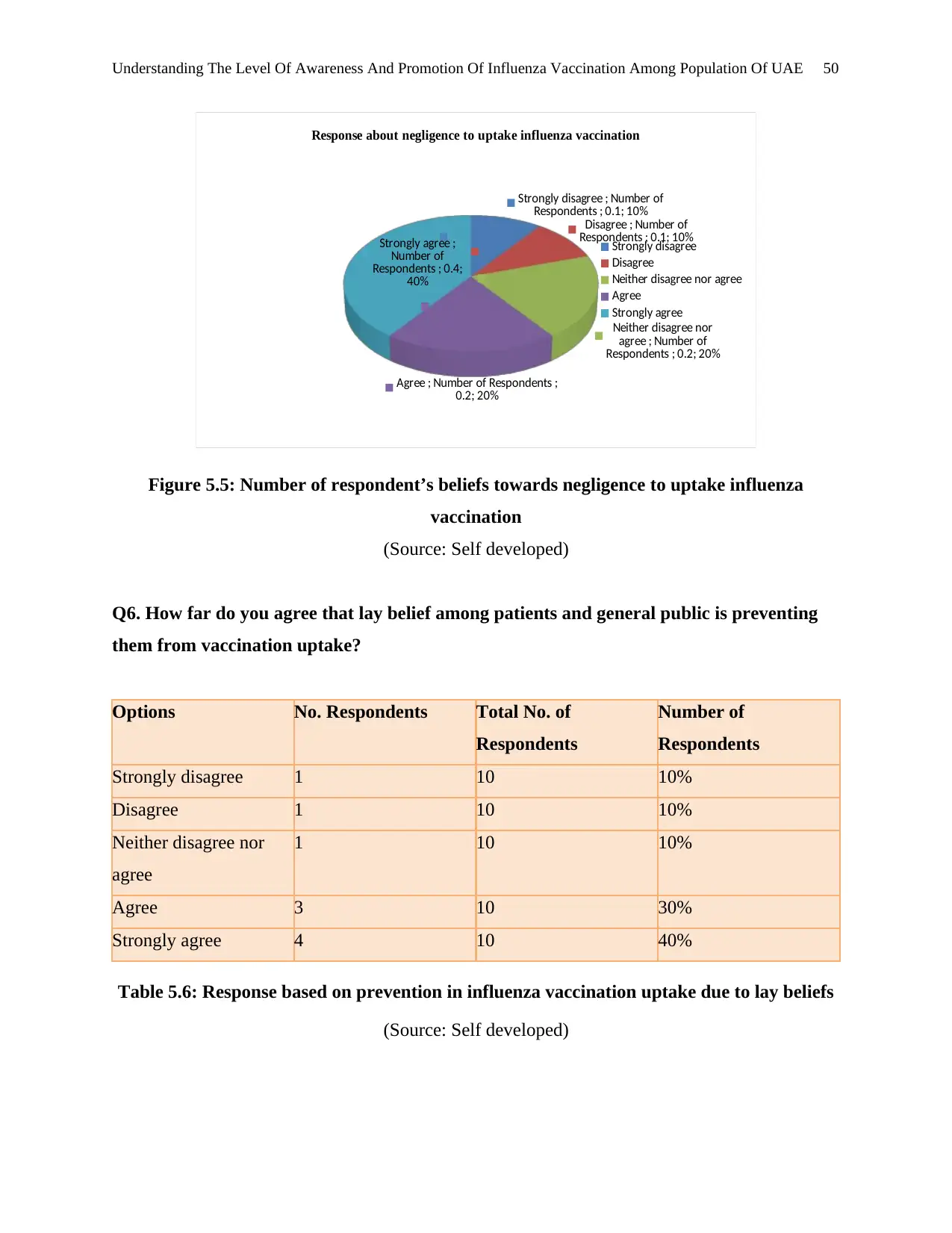
Understanding The Level Of Awareness And Promotion Of Influenza Vaccination Among Population Of UAE 50
Strongly disagree ; Number of
Respondents ; 0.1; 10%
Disagree ; Number of
Respondents ; 0.1; 10%
Neither disagree nor
agree ; Number of
Respondents ; 0.2; 20%
Agree ; Number of Respondents ;
0.2; 20%
Strongly agree ;
Number of
Respondents ; 0.4;
40%
Response about negligence to uptake influenza vaccination
Strongly disagree
Disagree
Neither disagree nor agree
Agree
Strongly agree
Figure 5.5: Number of respondent’s beliefs towards negligence to uptake influenza
vaccination
(Source: Self developed)
Q6. How far do you agree that lay belief among patients and general public is preventing
them from vaccination uptake?
Options No. Respondents Total No. of
Respondents
Number of
Respondents
Strongly disagree 1 10 10%
Disagree 1 10 10%
Neither disagree nor
agree
1 10 10%
Agree 3 10 30%
Strongly agree 4 10 40%
Table 5.6: Response based on prevention in influenza vaccination uptake due to lay beliefs
(Source: Self developed)
Strongly disagree ; Number of
Respondents ; 0.1; 10%
Disagree ; Number of
Respondents ; 0.1; 10%
Neither disagree nor
agree ; Number of
Respondents ; 0.2; 20%
Agree ; Number of Respondents ;
0.2; 20%
Strongly agree ;
Number of
Respondents ; 0.4;
40%
Response about negligence to uptake influenza vaccination
Strongly disagree
Disagree
Neither disagree nor agree
Agree
Strongly agree
Figure 5.5: Number of respondent’s beliefs towards negligence to uptake influenza
vaccination
(Source: Self developed)
Q6. How far do you agree that lay belief among patients and general public is preventing
them from vaccination uptake?
Options No. Respondents Total No. of
Respondents
Number of
Respondents
Strongly disagree 1 10 10%
Disagree 1 10 10%
Neither disagree nor
agree
1 10 10%
Agree 3 10 30%
Strongly agree 4 10 40%
Table 5.6: Response based on prevention in influenza vaccination uptake due to lay beliefs
(Source: Self developed)

Understanding The Level Of Awareness And Promotion Of Influenza Vaccination Among Population Of UAE 51
Strongly disagree ;
Number of
Respondents ; 10% Disagree ; Number of
Respondents ; 10%
Neither disagree nor
agree ; Number of
Respondents ; 10%
Agree ; Number of
Respondents ; 30%
Strongly agree ;
Number of
Respondents ; 40%
Response based on prevention in influenza vaccination uptake due to lay
beliefs
Number of Respondents
Figure 5.6: Number of respondent’s beliefs toward prevention in influenza vaccination
uptake due to lay beliefs
(Source: Self developed)
Q7. How far do you agree that low support from family is acting as a major factor
hindering vaccination uptake?
Options No. Respondents Total No. of
Respondents
Number of
Respondents
Strongly disagree 1 10 10%
Disagree 2 10 20%
Neither disagree nor
agree
1 10 10%
Agree 2 10 20%
Strongly agree 4 10 40%
Table 5.7: Response towards low support from family as a major factor hindering
vaccination uptake
(Source: Self developed)
Strongly disagree ;
Number of
Respondents ; 10% Disagree ; Number of
Respondents ; 10%
Neither disagree nor
agree ; Number of
Respondents ; 10%
Agree ; Number of
Respondents ; 30%
Strongly agree ;
Number of
Respondents ; 40%
Response based on prevention in influenza vaccination uptake due to lay
beliefs
Number of Respondents
Figure 5.6: Number of respondent’s beliefs toward prevention in influenza vaccination
uptake due to lay beliefs
(Source: Self developed)
Q7. How far do you agree that low support from family is acting as a major factor
hindering vaccination uptake?
Options No. Respondents Total No. of
Respondents
Number of
Respondents
Strongly disagree 1 10 10%
Disagree 2 10 20%
Neither disagree nor
agree
1 10 10%
Agree 2 10 20%
Strongly agree 4 10 40%
Table 5.7: Response towards low support from family as a major factor hindering
vaccination uptake
(Source: Self developed)
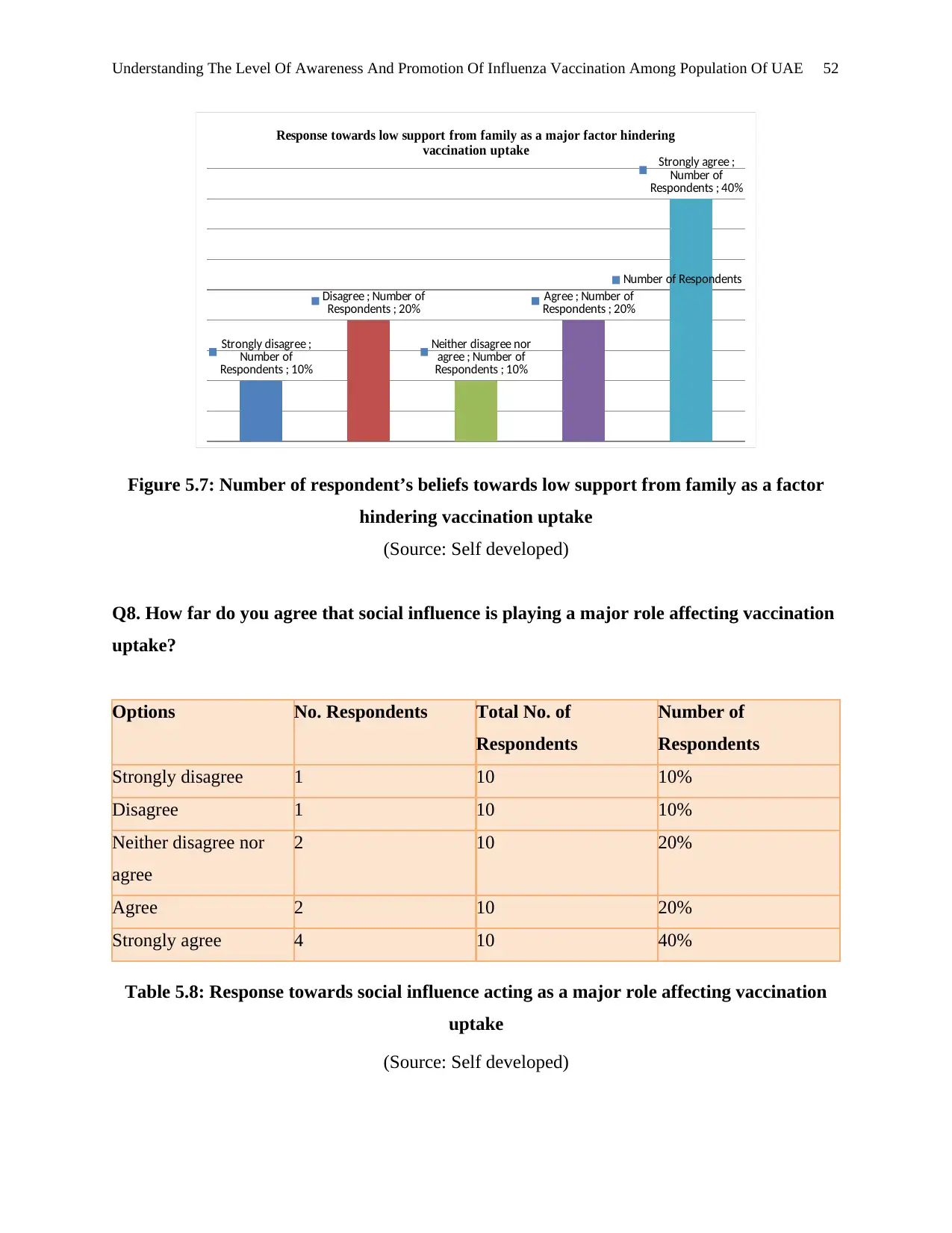
Understanding The Level Of Awareness And Promotion Of Influenza Vaccination Among Population Of UAE 52
Strongly disagree ;
Number of
Respondents ; 10%
Disagree ; Number of
Respondents ; 20%
Neither disagree nor
agree ; Number of
Respondents ; 10%
Agree ; Number of
Respondents ; 20%
Strongly agree ;
Number of
Respondents ; 40%
Response towards low support from family as a major factor hindering
vaccination uptake
Number of Respondents
Figure 5.7: Number of respondent’s beliefs towards low support from family as a factor
hindering vaccination uptake
(Source: Self developed)
Q8. How far do you agree that social influence is playing a major role affecting vaccination
uptake?
Options No. Respondents Total No. of
Respondents
Number of
Respondents
Strongly disagree 1 10 10%
Disagree 1 10 10%
Neither disagree nor
agree
2 10 20%
Agree 2 10 20%
Strongly agree 4 10 40%
Table 5.8: Response towards social influence acting as a major role affecting vaccination
uptake
(Source: Self developed)
Strongly disagree ;
Number of
Respondents ; 10%
Disagree ; Number of
Respondents ; 20%
Neither disagree nor
agree ; Number of
Respondents ; 10%
Agree ; Number of
Respondents ; 20%
Strongly agree ;
Number of
Respondents ; 40%
Response towards low support from family as a major factor hindering
vaccination uptake
Number of Respondents
Figure 5.7: Number of respondent’s beliefs towards low support from family as a factor
hindering vaccination uptake
(Source: Self developed)
Q8. How far do you agree that social influence is playing a major role affecting vaccination
uptake?
Options No. Respondents Total No. of
Respondents
Number of
Respondents
Strongly disagree 1 10 10%
Disagree 1 10 10%
Neither disagree nor
agree
2 10 20%
Agree 2 10 20%
Strongly agree 4 10 40%
Table 5.8: Response towards social influence acting as a major role affecting vaccination
uptake
(Source: Self developed)
Paraphrase This Document
Need a fresh take? Get an instant paraphrase of this document with our AI Paraphraser
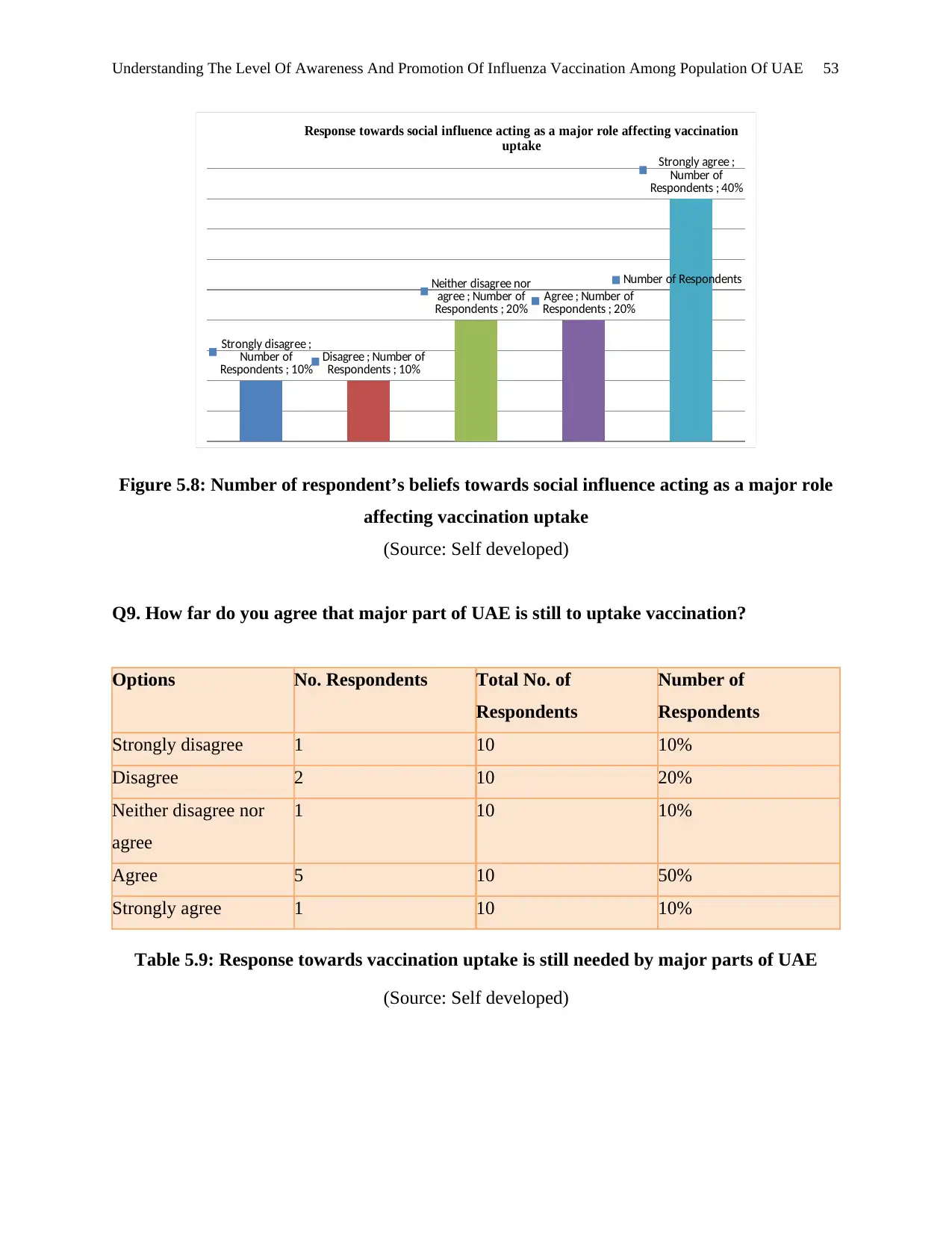
Understanding The Level Of Awareness And Promotion Of Influenza Vaccination Among Population Of UAE 53
Strongly disagree ;
Number of
Respondents ; 10% Disagree ; Number of
Respondents ; 10%
Neither disagree nor
agree ; Number of
Respondents ; 20% Agree ; Number of
Respondents ; 20%
Strongly agree ;
Number of
Respondents ; 40%
Response towards social influence acting as a major role affecting vaccination
uptake
Number of Respondents
Figure 5.8: Number of respondent’s beliefs towards social influence acting as a major role
affecting vaccination uptake
(Source: Self developed)
Q9. How far do you agree that major part of UAE is still to uptake vaccination?
Options No. Respondents Total No. of
Respondents
Number of
Respondents
Strongly disagree 1 10 10%
Disagree 2 10 20%
Neither disagree nor
agree
1 10 10%
Agree 5 10 50%
Strongly agree 1 10 10%
Table 5.9: Response towards vaccination uptake is still needed by major parts of UAE
(Source: Self developed)
Strongly disagree ;
Number of
Respondents ; 10% Disagree ; Number of
Respondents ; 10%
Neither disagree nor
agree ; Number of
Respondents ; 20% Agree ; Number of
Respondents ; 20%
Strongly agree ;
Number of
Respondents ; 40%
Response towards social influence acting as a major role affecting vaccination
uptake
Number of Respondents
Figure 5.8: Number of respondent’s beliefs towards social influence acting as a major role
affecting vaccination uptake
(Source: Self developed)
Q9. How far do you agree that major part of UAE is still to uptake vaccination?
Options No. Respondents Total No. of
Respondents
Number of
Respondents
Strongly disagree 1 10 10%
Disagree 2 10 20%
Neither disagree nor
agree
1 10 10%
Agree 5 10 50%
Strongly agree 1 10 10%
Table 5.9: Response towards vaccination uptake is still needed by major parts of UAE
(Source: Self developed)

Understanding The Level Of Awareness And Promotion Of Influenza Vaccination Among Population Of UAE 54
Strongly disagree ; Number of
Respondents ; 0.1; 10%
Disagree ; Number of
Respondents ; 0.2; 20%
Neither disagree nor agree ;
Number of Respondents ; 0.1;
10%
Agree ; Number of
Respondents ; 0.5; 50%
Strongly agree ; Number of
Respondents ; 0.1; 10%
Response towards vaccination uptake is still needed by major parts of
UAE
Strongly disagree
Disagree
Neither disagree nor agree
Agree
Strongly agree
Figure 5.9: Number of respondents towards the need of vaccination uptake in major parts
of UAE
(Source: Self developed)
Q10. How far do you agree that promotion initiatives and vaccination programs launched
by government are effective in influencing people to uptake vaccination?
Options No. Respondents Total No. of
Respondents
Number of
Respondents
Strongly disagree 1 10 10%
Disagree 3 10 30%
Neither disagree nor
agree
2 10 20%
Agree 3 10 30%
Strongly agree 1 10 10%
Table 5.10: Responses towards effectiveness of influencing people through governmental
programs to uptake vaccination
(Source: Self developed)
Strongly disagree ; Number of
Respondents ; 0.1; 10%
Disagree ; Number of
Respondents ; 0.2; 20%
Neither disagree nor agree ;
Number of Respondents ; 0.1;
10%
Agree ; Number of
Respondents ; 0.5; 50%
Strongly agree ; Number of
Respondents ; 0.1; 10%
Response towards vaccination uptake is still needed by major parts of
UAE
Strongly disagree
Disagree
Neither disagree nor agree
Agree
Strongly agree
Figure 5.9: Number of respondents towards the need of vaccination uptake in major parts
of UAE
(Source: Self developed)
Q10. How far do you agree that promotion initiatives and vaccination programs launched
by government are effective in influencing people to uptake vaccination?
Options No. Respondents Total No. of
Respondents
Number of
Respondents
Strongly disagree 1 10 10%
Disagree 3 10 30%
Neither disagree nor
agree
2 10 20%
Agree 3 10 30%
Strongly agree 1 10 10%
Table 5.10: Responses towards effectiveness of influencing people through governmental
programs to uptake vaccination
(Source: Self developed)

Understanding The Level Of Awareness And Promotion Of Influenza Vaccination Among Population Of UAE 55
Strongly disagree ;
Number of
Respondents ; 10%
Disagree ; Number of
Respondents ; 30%
Neither disagree nor
agree ; Number of
Respondents ; 20%
Agree ; Number of
Respondents ; 30%
Strongly agree ;
Number of
Respondents ; 10%
Responses towards effectiveness of influencing people through
governmental programs to uptake vaccination
Number of Respondents
Figure 5.10: Number of respondent’s beliefs with effectiveness of influencing people
through governmental programs to uptake vaccination
(Source: Self developed)
Q11.What factor in influenza vaccination is affecting its uptake?
Answer. Around 40 Number of health care respondents have indicated that low support from
family along with lay beliefs is acting as a major factor affecting vaccination uptake. 30%
believes misconception as a major factor affecting vaccination process, while remaining 30%
have indicated that various factors are affecting the vaccination process in equal ratio.
Strongly disagree ;
Number of
Respondents ; 10%
Disagree ; Number of
Respondents ; 30%
Neither disagree nor
agree ; Number of
Respondents ; 20%
Agree ; Number of
Respondents ; 30%
Strongly agree ;
Number of
Respondents ; 10%
Responses towards effectiveness of influencing people through
governmental programs to uptake vaccination
Number of Respondents
Figure 5.10: Number of respondent’s beliefs with effectiveness of influencing people
through governmental programs to uptake vaccination
(Source: Self developed)
Q11.What factor in influenza vaccination is affecting its uptake?
Answer. Around 40 Number of health care respondents have indicated that low support from
family along with lay beliefs is acting as a major factor affecting vaccination uptake. 30%
believes misconception as a major factor affecting vaccination process, while remaining 30%
have indicated that various factors are affecting the vaccination process in equal ratio.
Secure Best Marks with AI Grader
Need help grading? Try our AI Grader for instant feedback on your assignments.

Understanding The Level Of Awareness And Promotion Of Influenza Vaccination Among Population Of UAE 56
Pregnant Women
Q1. How far do you agree that influenza vaccination is essential for children belonging to
age group 0 to 3 years?
Options No. Respondents Total No. of
Respondents
Number of
Respondents
Strongly disagree 1 7 14.3%
Disagree 3 7 42.8%
Neither disagree nor
agree
1 7 14.3%
Agree 1 7 14.3%
Strongly agree 1 7 14.3%
Table 5.11: Response towards necessity of influenza vaccination for children
(Source: Self developed)
Strongly disagree ; Number of
Respondents ; 0.143; 14%
Disagree ; Number of
Respondents ; 0.428; 43%
Neither disagree nor agree ;
Number of Respondents ;
0.143; 14%
Agree ; Number of
Respondents ; 0.143; 14%
Strongly agree ; Number of
Respondents ; 0.143; 14%
Response towards necessity of influenza vaccination for children
Strongly disagree
Disagree
Neither disagree nor agree
Agree
Strongly agree
Figure 5.11: Number of respondent’s beliefs towards influenza vaccination important for
children
(Source: Self developed)
Pregnant Women
Q1. How far do you agree that influenza vaccination is essential for children belonging to
age group 0 to 3 years?
Options No. Respondents Total No. of
Respondents
Number of
Respondents
Strongly disagree 1 7 14.3%
Disagree 3 7 42.8%
Neither disagree nor
agree
1 7 14.3%
Agree 1 7 14.3%
Strongly agree 1 7 14.3%
Table 5.11: Response towards necessity of influenza vaccination for children
(Source: Self developed)
Strongly disagree ; Number of
Respondents ; 0.143; 14%
Disagree ; Number of
Respondents ; 0.428; 43%
Neither disagree nor agree ;
Number of Respondents ;
0.143; 14%
Agree ; Number of
Respondents ; 0.143; 14%
Strongly agree ; Number of
Respondents ; 0.143; 14%
Response towards necessity of influenza vaccination for children
Strongly disagree
Disagree
Neither disagree nor agree
Agree
Strongly agree
Figure 5.11: Number of respondent’s beliefs towards influenza vaccination important for
children
(Source: Self developed)
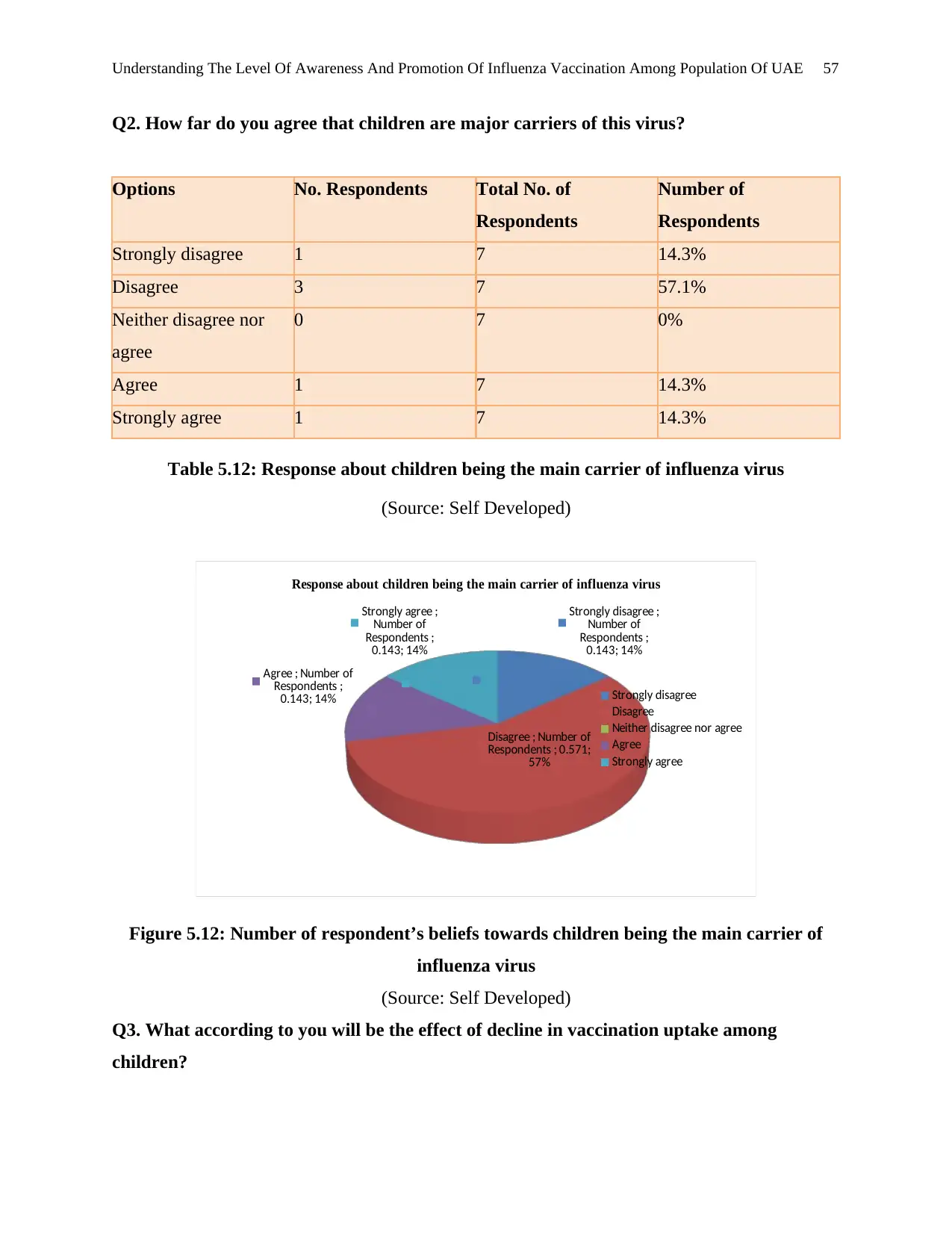
Understanding The Level Of Awareness And Promotion Of Influenza Vaccination Among Population Of UAE 57
Q2. How far do you agree that children are major carriers of this virus?
Options No. Respondents Total No. of
Respondents
Number of
Respondents
Strongly disagree 1 7 14.3%
Disagree 3 7 57.1%
Neither disagree nor
agree
0 7 0%
Agree 1 7 14.3%
Strongly agree 1 7 14.3%
Table 5.12: Response about children being the main carrier of influenza virus
(Source: Self Developed)
Strongly disagree ;
Number of
Respondents ;
0.143; 14%
Disagree ; Number of
Respondents ; 0.571;
57%
Agree ; Number of
Respondents ;
0.143; 14%
Strongly agree ;
Number of
Respondents ;
0.143; 14%
Response about children being the main carrier of influenza virus
Strongly disagree
Disagree
Neither disagree nor agree
Agree
Strongly agree
Figure 5.12: Number of respondent’s beliefs towards children being the main carrier of
influenza virus
(Source: Self Developed)
Q3. What according to you will be the effect of decline in vaccination uptake among
children?
Q2. How far do you agree that children are major carriers of this virus?
Options No. Respondents Total No. of
Respondents
Number of
Respondents
Strongly disagree 1 7 14.3%
Disagree 3 7 57.1%
Neither disagree nor
agree
0 7 0%
Agree 1 7 14.3%
Strongly agree 1 7 14.3%
Table 5.12: Response about children being the main carrier of influenza virus
(Source: Self Developed)
Strongly disagree ;
Number of
Respondents ;
0.143; 14%
Disagree ; Number of
Respondents ; 0.571;
57%
Agree ; Number of
Respondents ;
0.143; 14%
Strongly agree ;
Number of
Respondents ;
0.143; 14%
Response about children being the main carrier of influenza virus
Strongly disagree
Disagree
Neither disagree nor agree
Agree
Strongly agree
Figure 5.12: Number of respondent’s beliefs towards children being the main carrier of
influenza virus
(Source: Self Developed)
Q3. What according to you will be the effect of decline in vaccination uptake among
children?
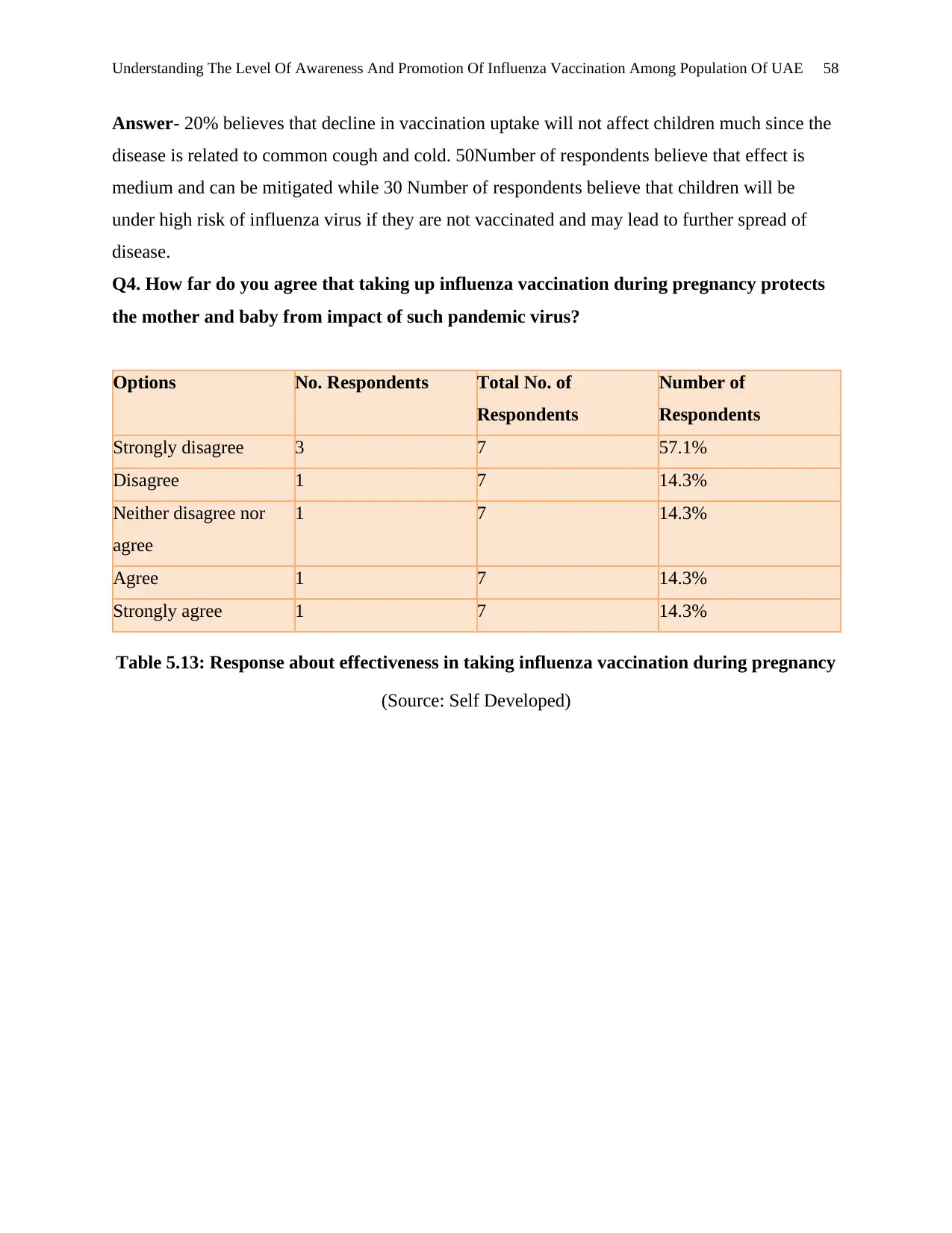
Understanding The Level Of Awareness And Promotion Of Influenza Vaccination Among Population Of UAE 58
Answer- 20% believes that decline in vaccination uptake will not affect children much since the
disease is related to common cough and cold. 50Number of respondents believe that effect is
medium and can be mitigated while 30 Number of respondents believe that children will be
under high risk of influenza virus if they are not vaccinated and may lead to further spread of
disease.
Q4. How far do you agree that taking up influenza vaccination during pregnancy protects
the mother and baby from impact of such pandemic virus?
Options No. Respondents Total No. of
Respondents
Number of
Respondents
Strongly disagree 3 7 57.1%
Disagree 1 7 14.3%
Neither disagree nor
agree
1 7 14.3%
Agree 1 7 14.3%
Strongly agree 1 7 14.3%
Table 5.13: Response about effectiveness in taking influenza vaccination during pregnancy
(Source: Self Developed)
Answer- 20% believes that decline in vaccination uptake will not affect children much since the
disease is related to common cough and cold. 50Number of respondents believe that effect is
medium and can be mitigated while 30 Number of respondents believe that children will be
under high risk of influenza virus if they are not vaccinated and may lead to further spread of
disease.
Q4. How far do you agree that taking up influenza vaccination during pregnancy protects
the mother and baby from impact of such pandemic virus?
Options No. Respondents Total No. of
Respondents
Number of
Respondents
Strongly disagree 3 7 57.1%
Disagree 1 7 14.3%
Neither disagree nor
agree
1 7 14.3%
Agree 1 7 14.3%
Strongly agree 1 7 14.3%
Table 5.13: Response about effectiveness in taking influenza vaccination during pregnancy
(Source: Self Developed)
Paraphrase This Document
Need a fresh take? Get an instant paraphrase of this document with our AI Paraphraser
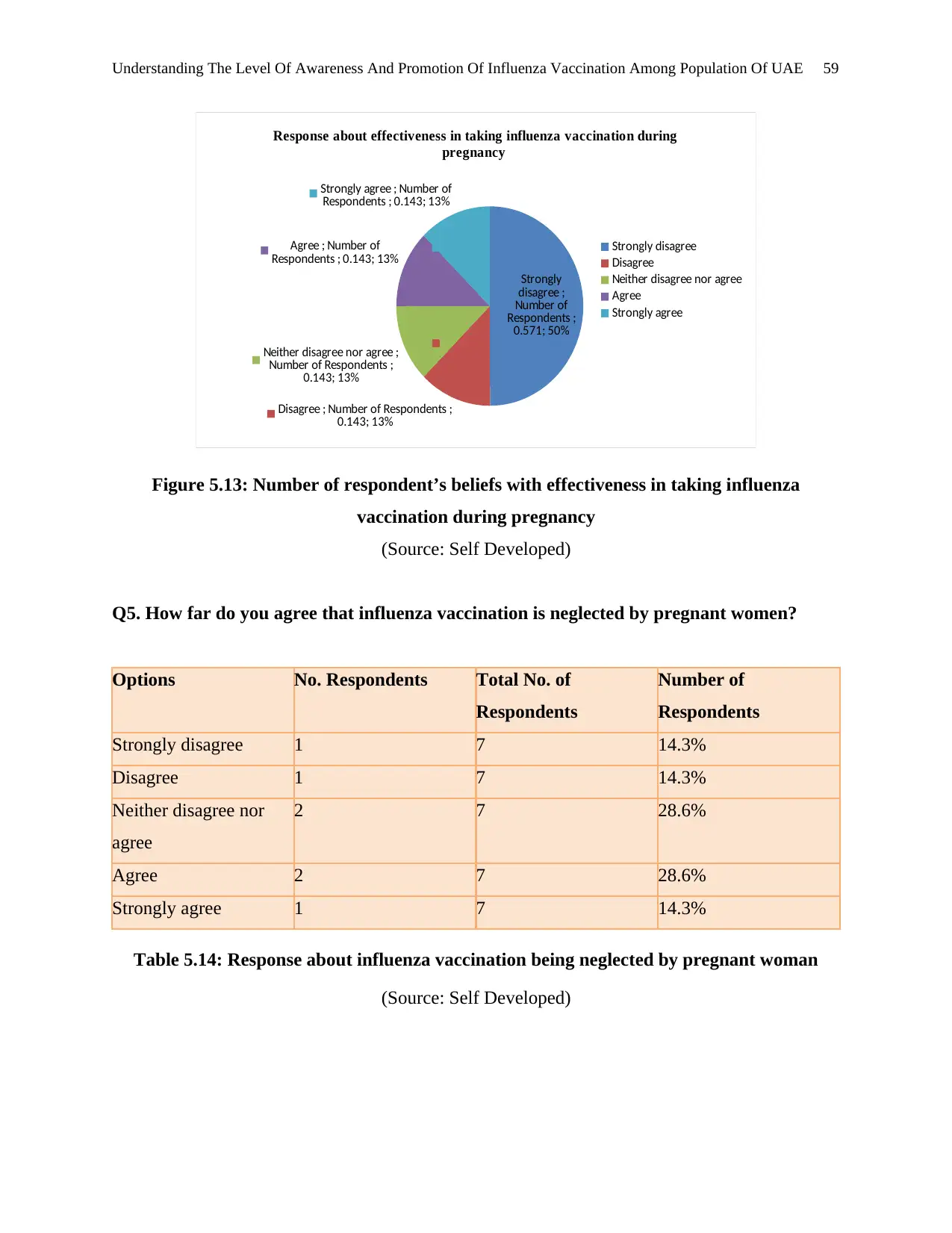
Understanding The Level Of Awareness And Promotion Of Influenza Vaccination Among Population Of UAE 59
Strongly
disagree ;
Number of
Respondents ;
0.571; 50%
Disagree ; Number of Respondents ;
0.143; 13%
Neither disagree nor agree ;
Number of Respondents ;
0.143; 13%
Agree ; Number of
Respondents ; 0.143; 13%
Strongly agree ; Number of
Respondents ; 0.143; 13%
Response about effectiveness in taking influenza vaccination during
pregnancy
Strongly disagree
Disagree
Neither disagree nor agree
Agree
Strongly agree
Figure 5.13: Number of respondent’s beliefs with effectiveness in taking influenza
vaccination during pregnancy
(Source: Self Developed)
Q5. How far do you agree that influenza vaccination is neglected by pregnant women?
Options No. Respondents Total No. of
Respondents
Number of
Respondents
Strongly disagree 1 7 14.3%
Disagree 1 7 14.3%
Neither disagree nor
agree
2 7 28.6%
Agree 2 7 28.6%
Strongly agree 1 7 14.3%
Table 5.14: Response about influenza vaccination being neglected by pregnant woman
(Source: Self Developed)
Strongly
disagree ;
Number of
Respondents ;
0.571; 50%
Disagree ; Number of Respondents ;
0.143; 13%
Neither disagree nor agree ;
Number of Respondents ;
0.143; 13%
Agree ; Number of
Respondents ; 0.143; 13%
Strongly agree ; Number of
Respondents ; 0.143; 13%
Response about effectiveness in taking influenza vaccination during
pregnancy
Strongly disagree
Disagree
Neither disagree nor agree
Agree
Strongly agree
Figure 5.13: Number of respondent’s beliefs with effectiveness in taking influenza
vaccination during pregnancy
(Source: Self Developed)
Q5. How far do you agree that influenza vaccination is neglected by pregnant women?
Options No. Respondents Total No. of
Respondents
Number of
Respondents
Strongly disagree 1 7 14.3%
Disagree 1 7 14.3%
Neither disagree nor
agree
2 7 28.6%
Agree 2 7 28.6%
Strongly agree 1 7 14.3%
Table 5.14: Response about influenza vaccination being neglected by pregnant woman
(Source: Self Developed)

Understanding The Level Of Awareness And Promotion Of Influenza Vaccination Among Population Of UAE 60
Strongly disagree ;
Number of
Respondents ; 0.143;
14%
Disagree ; Number of
Respondents ; 0.143;
14%
Neither disagree nor
agree ; Number of
Respondents ; 0.286;
29%
Agree ; Number of
Respondents ; 0.286;
29%
Strongly agree ;
Number of
Respondents ; 0.143;
14%
Response about influenza vaccination being neglected by pregnant
woman
Strongly disagree
Disagree
Neither disagree nor agree
Agree
Strongly agree
Figure 5.14: Number of respondent’s beliefs towards influenza vaccination being neglected
by pregnant woman
(Source: Self Developed)
Q6. How far do you agree that lay belief among pregnant women is preventing them from
vaccination uptake?
Options No. Respondents Total No. of
Respondents
Number of
Respondents
Strongly disagree 1 7 14.3%
Disagree 1 7 14.3%
Neither disagree nor
agree
2 7 28.6%
Agree 2 7 28.6%
Strongly agree 1 7 14.3%
Table 5.15: Response based on prevention in influenza vaccination uptake by pregnant
woman due to lay beliefs
(Source: Self developed)
Strongly disagree ;
Number of
Respondents ; 0.143;
14%
Disagree ; Number of
Respondents ; 0.143;
14%
Neither disagree nor
agree ; Number of
Respondents ; 0.286;
29%
Agree ; Number of
Respondents ; 0.286;
29%
Strongly agree ;
Number of
Respondents ; 0.143;
14%
Response about influenza vaccination being neglected by pregnant
woman
Strongly disagree
Disagree
Neither disagree nor agree
Agree
Strongly agree
Figure 5.14: Number of respondent’s beliefs towards influenza vaccination being neglected
by pregnant woman
(Source: Self Developed)
Q6. How far do you agree that lay belief among pregnant women is preventing them from
vaccination uptake?
Options No. Respondents Total No. of
Respondents
Number of
Respondents
Strongly disagree 1 7 14.3%
Disagree 1 7 14.3%
Neither disagree nor
agree
2 7 28.6%
Agree 2 7 28.6%
Strongly agree 1 7 14.3%
Table 5.15: Response based on prevention in influenza vaccination uptake by pregnant
woman due to lay beliefs
(Source: Self developed)

Understanding The Level Of Awareness And Promotion Of Influenza Vaccination Among Population Of UAE 61
Strongly disagree ;
Number of
Respondents ; 0.143;
14%
Disagree ; Number of
Respondents ; 0.143;
14%
Neither disagree nor
agree ; Number of
Respondents ; 0.286;
29%
Agree ; Number of
Respondents ; 0.286;
29%
Strongly agree ;
Number of
Respondents ; 0.143;
14%
Response based on prevention in influenza vaccination uptake by
pregnant woman due to lay beliefs
Strongly disagree
Disagree
Neither disagree nor agree
Agree
Strongly agree
Figure 5.15: Number of respondent’s beliefs towards lay beliefs is preventing pregnant
woman to uptake influenza vaccination
(Source: Self developed)
Q7. How far do you agree that low support from family is acting as a major factor
hindering vaccination uptake?
Options No. Respondents Total No. of
Respondents
Number of
Respondents
Strongly disagree 1 7 14.3%
Disagree 1 7 14.3%
Neither disagree nor
agree
1 7 14.3%
Agree 3 7 57.1%
Strongly agree 1 7 14.3%
Table 5.16: Response towards low support from family as a major factor hindering
vaccination uptake for pregnant woman
(Source: Self developed)
Strongly disagree ;
Number of
Respondents ; 0.143;
14%
Disagree ; Number of
Respondents ; 0.143;
14%
Neither disagree nor
agree ; Number of
Respondents ; 0.286;
29%
Agree ; Number of
Respondents ; 0.286;
29%
Strongly agree ;
Number of
Respondents ; 0.143;
14%
Response based on prevention in influenza vaccination uptake by
pregnant woman due to lay beliefs
Strongly disagree
Disagree
Neither disagree nor agree
Agree
Strongly agree
Figure 5.15: Number of respondent’s beliefs towards lay beliefs is preventing pregnant
woman to uptake influenza vaccination
(Source: Self developed)
Q7. How far do you agree that low support from family is acting as a major factor
hindering vaccination uptake?
Options No. Respondents Total No. of
Respondents
Number of
Respondents
Strongly disagree 1 7 14.3%
Disagree 1 7 14.3%
Neither disagree nor
agree
1 7 14.3%
Agree 3 7 57.1%
Strongly agree 1 7 14.3%
Table 5.16: Response towards low support from family as a major factor hindering
vaccination uptake for pregnant woman
(Source: Self developed)
Secure Best Marks with AI Grader
Need help grading? Try our AI Grader for instant feedback on your assignments.
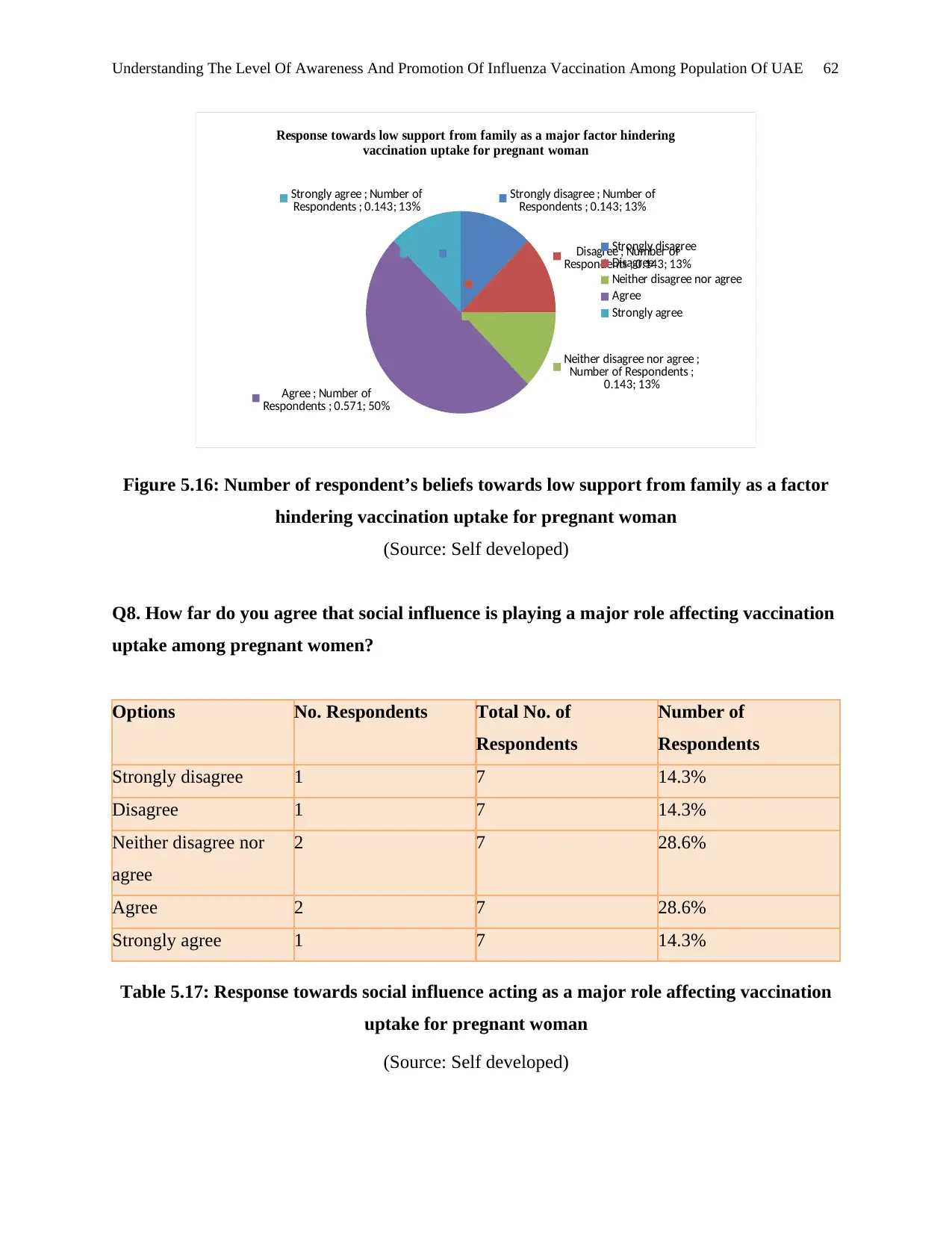
Understanding The Level Of Awareness And Promotion Of Influenza Vaccination Among Population Of UAE 62
Strongly disagree ; Number of
Respondents ; 0.143; 13%
Disagree ; Number of
Respondents ; 0.143; 13%
Neither disagree nor agree ;
Number of Respondents ;
0.143; 13%
Agree ; Number of
Respondents ; 0.571; 50%
Strongly agree ; Number of
Respondents ; 0.143; 13%
Response towards low support from family as a major factor hindering
vaccination uptake for pregnant woman
Strongly disagree
Disagree
Neither disagree nor agree
Agree
Strongly agree
Figure 5.16: Number of respondent’s beliefs towards low support from family as a factor
hindering vaccination uptake for pregnant woman
(Source: Self developed)
Q8. How far do you agree that social influence is playing a major role affecting vaccination
uptake among pregnant women?
Options No. Respondents Total No. of
Respondents
Number of
Respondents
Strongly disagree 1 7 14.3%
Disagree 1 7 14.3%
Neither disagree nor
agree
2 7 28.6%
Agree 2 7 28.6%
Strongly agree 1 7 14.3%
Table 5.17: Response towards social influence acting as a major role affecting vaccination
uptake for pregnant woman
(Source: Self developed)
Strongly disagree ; Number of
Respondents ; 0.143; 13%
Disagree ; Number of
Respondents ; 0.143; 13%
Neither disagree nor agree ;
Number of Respondents ;
0.143; 13%
Agree ; Number of
Respondents ; 0.571; 50%
Strongly agree ; Number of
Respondents ; 0.143; 13%
Response towards low support from family as a major factor hindering
vaccination uptake for pregnant woman
Strongly disagree
Disagree
Neither disagree nor agree
Agree
Strongly agree
Figure 5.16: Number of respondent’s beliefs towards low support from family as a factor
hindering vaccination uptake for pregnant woman
(Source: Self developed)
Q8. How far do you agree that social influence is playing a major role affecting vaccination
uptake among pregnant women?
Options No. Respondents Total No. of
Respondents
Number of
Respondents
Strongly disagree 1 7 14.3%
Disagree 1 7 14.3%
Neither disagree nor
agree
2 7 28.6%
Agree 2 7 28.6%
Strongly agree 1 7 14.3%
Table 5.17: Response towards social influence acting as a major role affecting vaccination
uptake for pregnant woman
(Source: Self developed)
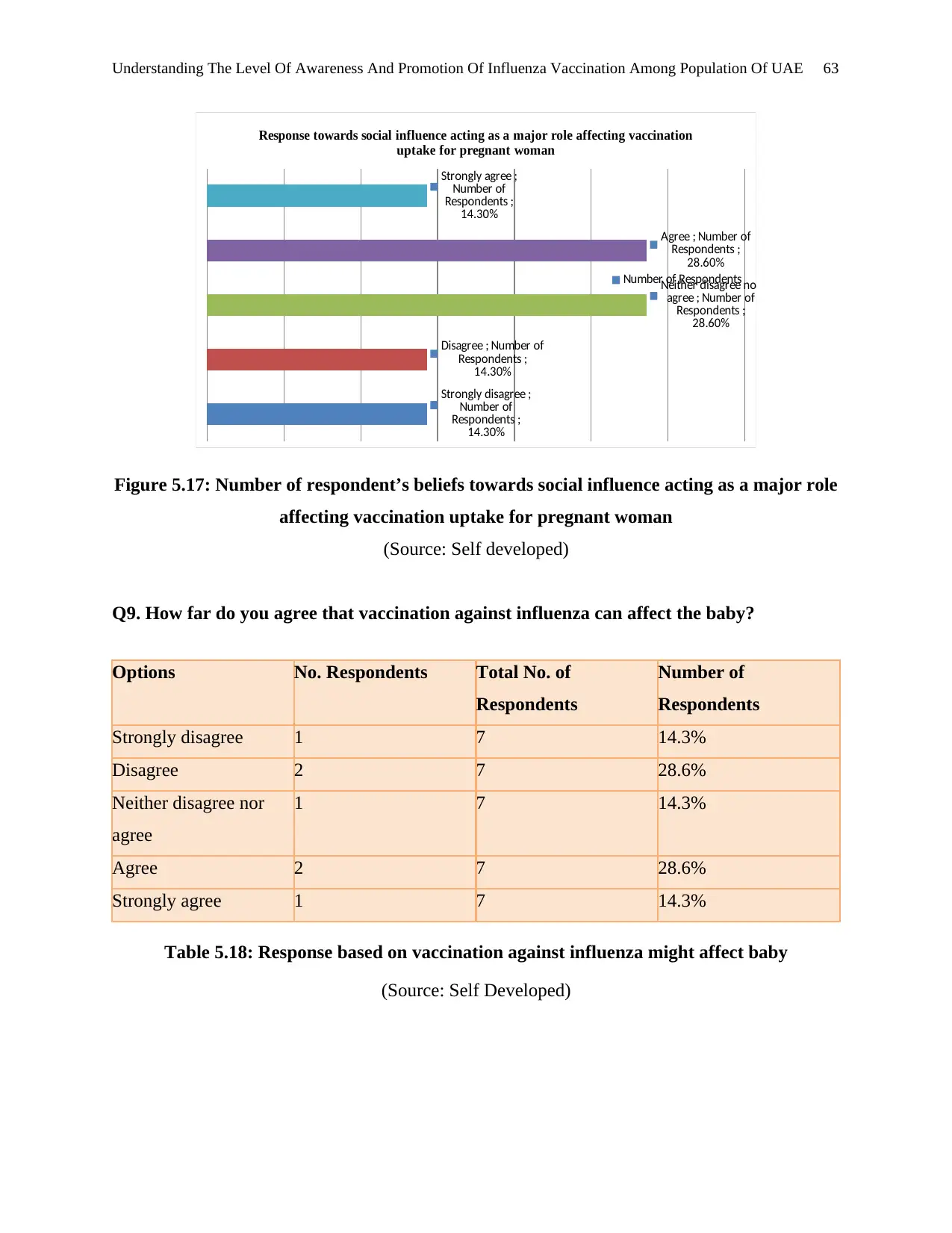
Understanding The Level Of Awareness And Promotion Of Influenza Vaccination Among Population Of UAE 63
Strongly disagree ;
Number of
Respondents ;
14.30%
Disagree ; Number of
Respondents ;
14.30%
Neither disagree nor
agree ; Number of
Respondents ;
28.60%
Agree ; Number of
Respondents ;
28.60%
Strongly agree ;
Number of
Respondents ;
14.30%
Response towards social influence acting as a major role affecting vaccination
uptake for pregnant woman
Number of Respondents
Figure 5.17: Number of respondent’s beliefs towards social influence acting as a major role
affecting vaccination uptake for pregnant woman
(Source: Self developed)
Q9. How far do you agree that vaccination against influenza can affect the baby?
Options No. Respondents Total No. of
Respondents
Number of
Respondents
Strongly disagree 1 7 14.3%
Disagree 2 7 28.6%
Neither disagree nor
agree
1 7 14.3%
Agree 2 7 28.6%
Strongly agree 1 7 14.3%
Table 5.18: Response based on vaccination against influenza might affect baby
(Source: Self Developed)
Strongly disagree ;
Number of
Respondents ;
14.30%
Disagree ; Number of
Respondents ;
14.30%
Neither disagree nor
agree ; Number of
Respondents ;
28.60%
Agree ; Number of
Respondents ;
28.60%
Strongly agree ;
Number of
Respondents ;
14.30%
Response towards social influence acting as a major role affecting vaccination
uptake for pregnant woman
Number of Respondents
Figure 5.17: Number of respondent’s beliefs towards social influence acting as a major role
affecting vaccination uptake for pregnant woman
(Source: Self developed)
Q9. How far do you agree that vaccination against influenza can affect the baby?
Options No. Respondents Total No. of
Respondents
Number of
Respondents
Strongly disagree 1 7 14.3%
Disagree 2 7 28.6%
Neither disagree nor
agree
1 7 14.3%
Agree 2 7 28.6%
Strongly agree 1 7 14.3%
Table 5.18: Response based on vaccination against influenza might affect baby
(Source: Self Developed)
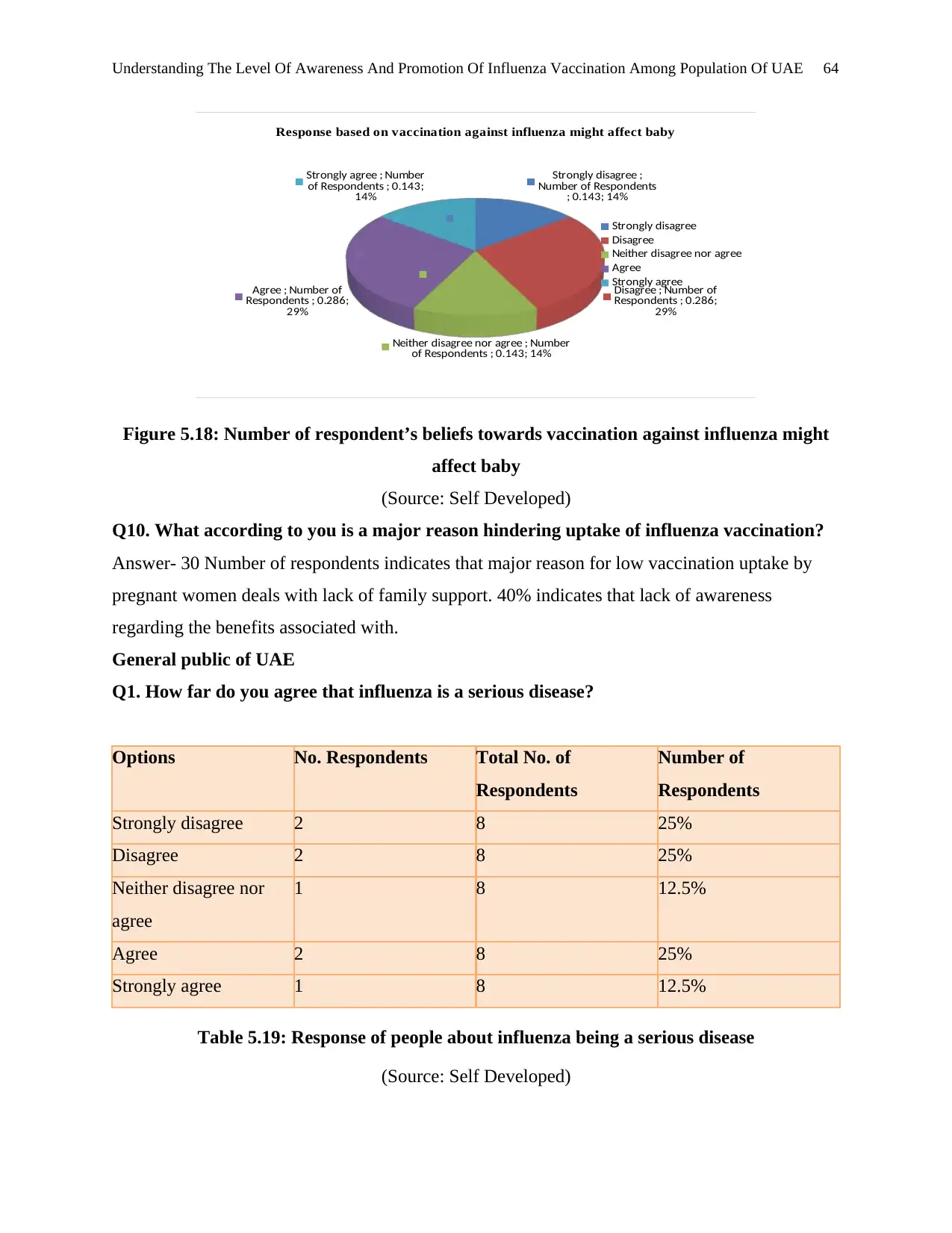
Understanding The Level Of Awareness And Promotion Of Influenza Vaccination Among Population Of UAE 64
Strongly disagree ;
Number of Respondents
; 0.143; 14%
Disagree ; Number of
Respondents ; 0.286;
29%
Neither disagree nor agree ; Number
of Respondents ; 0.143; 14%
Agree ; Number of
Respondents ; 0.286;
29%
Strongly agree ; Number
of Respondents ; 0.143;
14%
Response based on vaccination against influenza might affect baby
Strongly disagree
Disagree
Neither disagree nor agree
Agree
Strongly agree
Figure 5.18: Number of respondent’s beliefs towards vaccination against influenza might
affect baby
(Source: Self Developed)
Q10. What according to you is a major reason hindering uptake of influenza vaccination?
Answer- 30 Number of respondents indicates that major reason for low vaccination uptake by
pregnant women deals with lack of family support. 40% indicates that lack of awareness
regarding the benefits associated with.
General public of UAE
Q1. How far do you agree that influenza is a serious disease?
Options No. Respondents Total No. of
Respondents
Number of
Respondents
Strongly disagree 2 8 25%
Disagree 2 8 25%
Neither disagree nor
agree
1 8 12.5%
Agree 2 8 25%
Strongly agree 1 8 12.5%
Table 5.19: Response of people about influenza being a serious disease
(Source: Self Developed)
Strongly disagree ;
Number of Respondents
; 0.143; 14%
Disagree ; Number of
Respondents ; 0.286;
29%
Neither disagree nor agree ; Number
of Respondents ; 0.143; 14%
Agree ; Number of
Respondents ; 0.286;
29%
Strongly agree ; Number
of Respondents ; 0.143;
14%
Response based on vaccination against influenza might affect baby
Strongly disagree
Disagree
Neither disagree nor agree
Agree
Strongly agree
Figure 5.18: Number of respondent’s beliefs towards vaccination against influenza might
affect baby
(Source: Self Developed)
Q10. What according to you is a major reason hindering uptake of influenza vaccination?
Answer- 30 Number of respondents indicates that major reason for low vaccination uptake by
pregnant women deals with lack of family support. 40% indicates that lack of awareness
regarding the benefits associated with.
General public of UAE
Q1. How far do you agree that influenza is a serious disease?
Options No. Respondents Total No. of
Respondents
Number of
Respondents
Strongly disagree 2 8 25%
Disagree 2 8 25%
Neither disagree nor
agree
1 8 12.5%
Agree 2 8 25%
Strongly agree 1 8 12.5%
Table 5.19: Response of people about influenza being a serious disease
(Source: Self Developed)
Paraphrase This Document
Need a fresh take? Get an instant paraphrase of this document with our AI Paraphraser
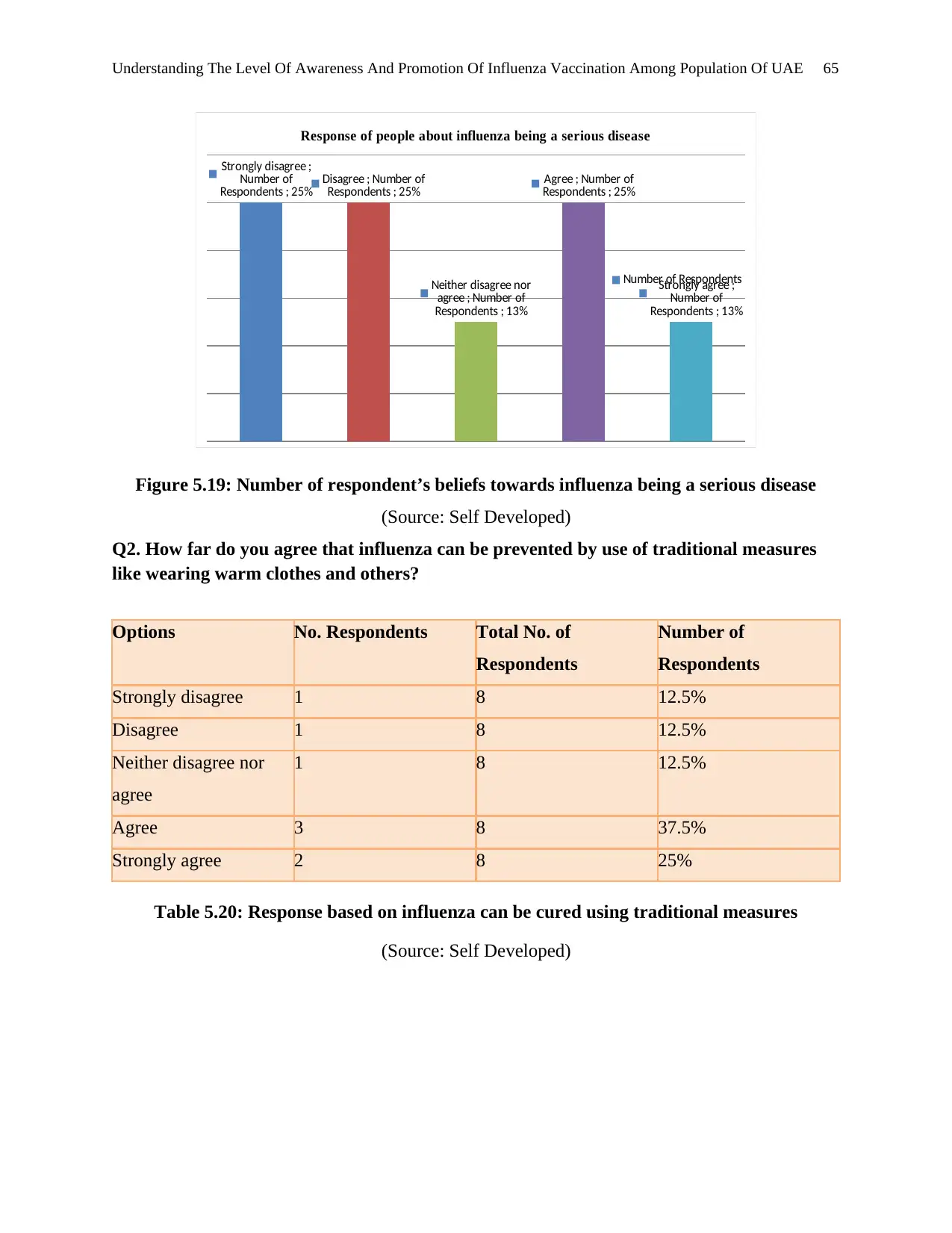
Understanding The Level Of Awareness And Promotion Of Influenza Vaccination Among Population Of UAE 65
Strongly disagree ;
Number of
Respondents ; 25% Disagree ; Number of
Respondents ; 25%
Neither disagree nor
agree ; Number of
Respondents ; 13%
Agree ; Number of
Respondents ; 25%
Strongly agree ;
Number of
Respondents ; 13%
Response of people about influenza being a serious disease
Number of Respondents
Figure 5.19: Number of respondent’s beliefs towards influenza being a serious disease
(Source: Self Developed)
Q2. How far do you agree that influenza can be prevented by use of traditional measures
like wearing warm clothes and others?
Options No. Respondents Total No. of
Respondents
Number of
Respondents
Strongly disagree 1 8 12.5%
Disagree 1 8 12.5%
Neither disagree nor
agree
1 8 12.5%
Agree 3 8 37.5%
Strongly agree 2 8 25%
Table 5.20: Response based on influenza can be cured using traditional measures
(Source: Self Developed)
Strongly disagree ;
Number of
Respondents ; 25% Disagree ; Number of
Respondents ; 25%
Neither disagree nor
agree ; Number of
Respondents ; 13%
Agree ; Number of
Respondents ; 25%
Strongly agree ;
Number of
Respondents ; 13%
Response of people about influenza being a serious disease
Number of Respondents
Figure 5.19: Number of respondent’s beliefs towards influenza being a serious disease
(Source: Self Developed)
Q2. How far do you agree that influenza can be prevented by use of traditional measures
like wearing warm clothes and others?
Options No. Respondents Total No. of
Respondents
Number of
Respondents
Strongly disagree 1 8 12.5%
Disagree 1 8 12.5%
Neither disagree nor
agree
1 8 12.5%
Agree 3 8 37.5%
Strongly agree 2 8 25%
Table 5.20: Response based on influenza can be cured using traditional measures
(Source: Self Developed)
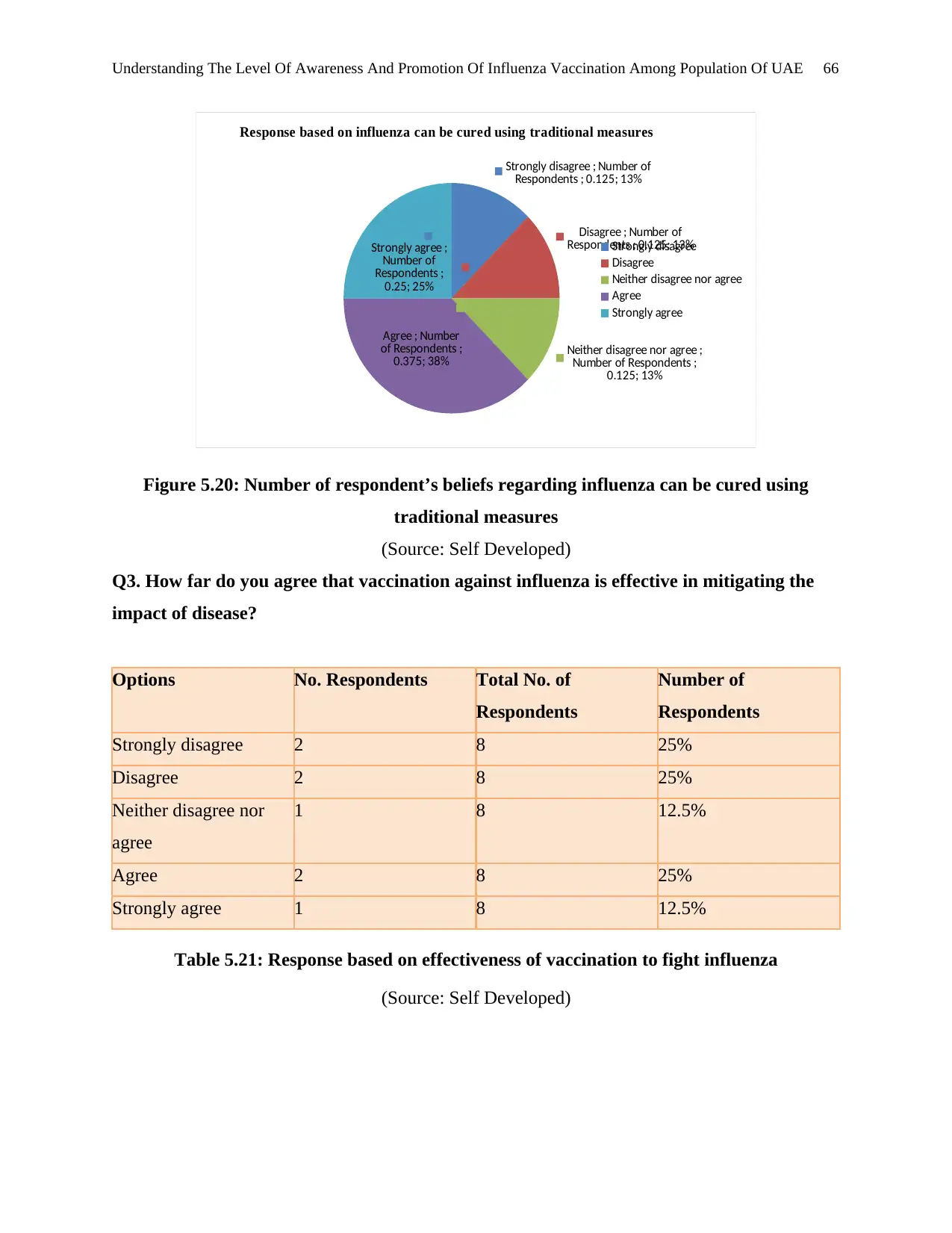
Understanding The Level Of Awareness And Promotion Of Influenza Vaccination Among Population Of UAE 66
Strongly disagree ; Number of
Respondents ; 0.125; 13%
Disagree ; Number of
Respondents ; 0.125; 13%
Neither disagree nor agree ;
Number of Respondents ;
0.125; 13%
Agree ; Number
of Respondents ;
0.375; 38%
Strongly agree ;
Number of
Respondents ;
0.25; 25%
Response based on influenza can be cured using traditional measures
Strongly disagree
Disagree
Neither disagree nor agree
Agree
Strongly agree
Figure 5.20: Number of respondent’s beliefs regarding influenza can be cured using
traditional measures
(Source: Self Developed)
Q3. How far do you agree that vaccination against influenza is effective in mitigating the
impact of disease?
Options No. Respondents Total No. of
Respondents
Number of
Respondents
Strongly disagree 2 8 25%
Disagree 2 8 25%
Neither disagree nor
agree
1 8 12.5%
Agree 2 8 25%
Strongly agree 1 8 12.5%
Table 5.21: Response based on effectiveness of vaccination to fight influenza
(Source: Self Developed)
Strongly disagree ; Number of
Respondents ; 0.125; 13%
Disagree ; Number of
Respondents ; 0.125; 13%
Neither disagree nor agree ;
Number of Respondents ;
0.125; 13%
Agree ; Number
of Respondents ;
0.375; 38%
Strongly agree ;
Number of
Respondents ;
0.25; 25%
Response based on influenza can be cured using traditional measures
Strongly disagree
Disagree
Neither disagree nor agree
Agree
Strongly agree
Figure 5.20: Number of respondent’s beliefs regarding influenza can be cured using
traditional measures
(Source: Self Developed)
Q3. How far do you agree that vaccination against influenza is effective in mitigating the
impact of disease?
Options No. Respondents Total No. of
Respondents
Number of
Respondents
Strongly disagree 2 8 25%
Disagree 2 8 25%
Neither disagree nor
agree
1 8 12.5%
Agree 2 8 25%
Strongly agree 1 8 12.5%
Table 5.21: Response based on effectiveness of vaccination to fight influenza
(Source: Self Developed)
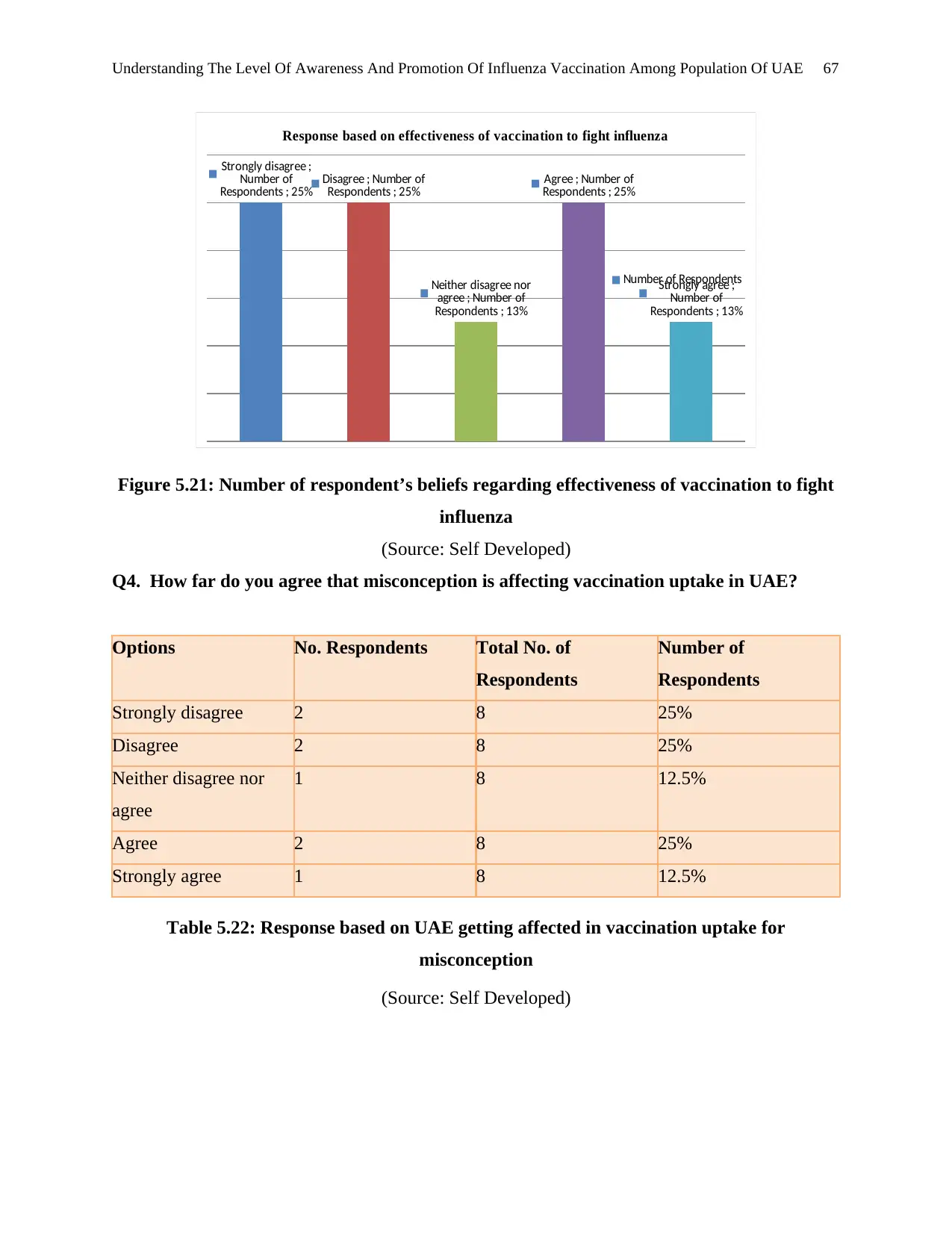
Understanding The Level Of Awareness And Promotion Of Influenza Vaccination Among Population Of UAE 67
Strongly disagree ;
Number of
Respondents ; 25% Disagree ; Number of
Respondents ; 25%
Neither disagree nor
agree ; Number of
Respondents ; 13%
Agree ; Number of
Respondents ; 25%
Strongly agree ;
Number of
Respondents ; 13%
Response based on effectiveness of vaccination to fight influenza
Number of Respondents
Figure 5.21: Number of respondent’s beliefs regarding effectiveness of vaccination to fight
influenza
(Source: Self Developed)
Q4. How far do you agree that misconception is affecting vaccination uptake in UAE?
Options No. Respondents Total No. of
Respondents
Number of
Respondents
Strongly disagree 2 8 25%
Disagree 2 8 25%
Neither disagree nor
agree
1 8 12.5%
Agree 2 8 25%
Strongly agree 1 8 12.5%
Table 5.22: Response based on UAE getting affected in vaccination uptake for
misconception
(Source: Self Developed)
Strongly disagree ;
Number of
Respondents ; 25% Disagree ; Number of
Respondents ; 25%
Neither disagree nor
agree ; Number of
Respondents ; 13%
Agree ; Number of
Respondents ; 25%
Strongly agree ;
Number of
Respondents ; 13%
Response based on effectiveness of vaccination to fight influenza
Number of Respondents
Figure 5.21: Number of respondent’s beliefs regarding effectiveness of vaccination to fight
influenza
(Source: Self Developed)
Q4. How far do you agree that misconception is affecting vaccination uptake in UAE?
Options No. Respondents Total No. of
Respondents
Number of
Respondents
Strongly disagree 2 8 25%
Disagree 2 8 25%
Neither disagree nor
agree
1 8 12.5%
Agree 2 8 25%
Strongly agree 1 8 12.5%
Table 5.22: Response based on UAE getting affected in vaccination uptake for
misconception
(Source: Self Developed)
Secure Best Marks with AI Grader
Need help grading? Try our AI Grader for instant feedback on your assignments.
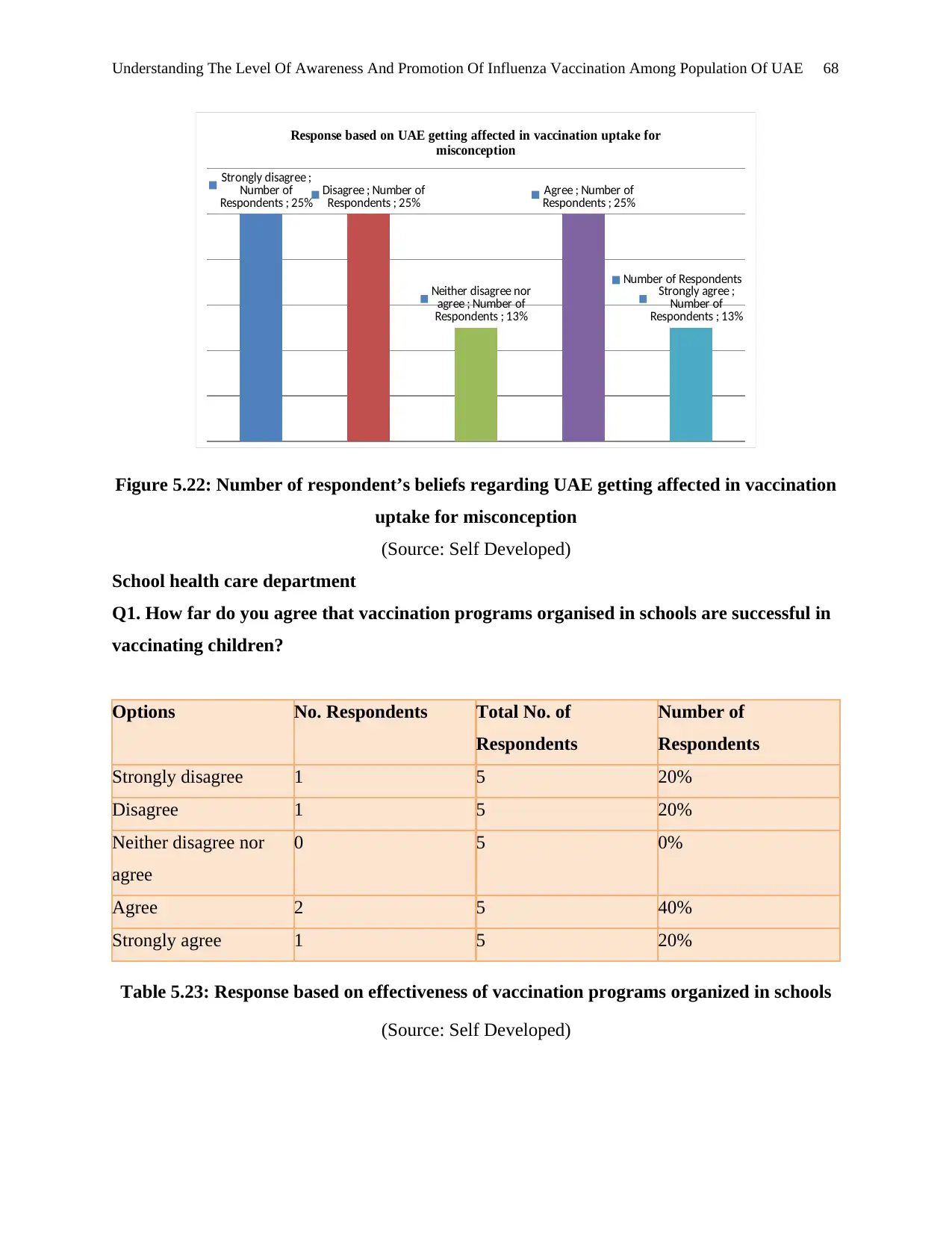
Understanding The Level Of Awareness And Promotion Of Influenza Vaccination Among Population Of UAE 68
Strongly disagree ;
Number of
Respondents ; 25% Disagree ; Number of
Respondents ; 25%
Neither disagree nor
agree ; Number of
Respondents ; 13%
Agree ; Number of
Respondents ; 25%
Strongly agree ;
Number of
Respondents ; 13%
Response based on UAE getting affected in vaccination uptake for
misconception
Number of Respondents
Figure 5.22: Number of respondent’s beliefs regarding UAE getting affected in vaccination
uptake for misconception
(Source: Self Developed)
School health care department
Q1. How far do you agree that vaccination programs organised in schools are successful in
vaccinating children?
Options No. Respondents Total No. of
Respondents
Number of
Respondents
Strongly disagree 1 5 20%
Disagree 1 5 20%
Neither disagree nor
agree
0 5 0%
Agree 2 5 40%
Strongly agree 1 5 20%
Table 5.23: Response based on effectiveness of vaccination programs organized in schools
(Source: Self Developed)
Strongly disagree ;
Number of
Respondents ; 25% Disagree ; Number of
Respondents ; 25%
Neither disagree nor
agree ; Number of
Respondents ; 13%
Agree ; Number of
Respondents ; 25%
Strongly agree ;
Number of
Respondents ; 13%
Response based on UAE getting affected in vaccination uptake for
misconception
Number of Respondents
Figure 5.22: Number of respondent’s beliefs regarding UAE getting affected in vaccination
uptake for misconception
(Source: Self Developed)
School health care department
Q1. How far do you agree that vaccination programs organised in schools are successful in
vaccinating children?
Options No. Respondents Total No. of
Respondents
Number of
Respondents
Strongly disagree 1 5 20%
Disagree 1 5 20%
Neither disagree nor
agree
0 5 0%
Agree 2 5 40%
Strongly agree 1 5 20%
Table 5.23: Response based on effectiveness of vaccination programs organized in schools
(Source: Self Developed)
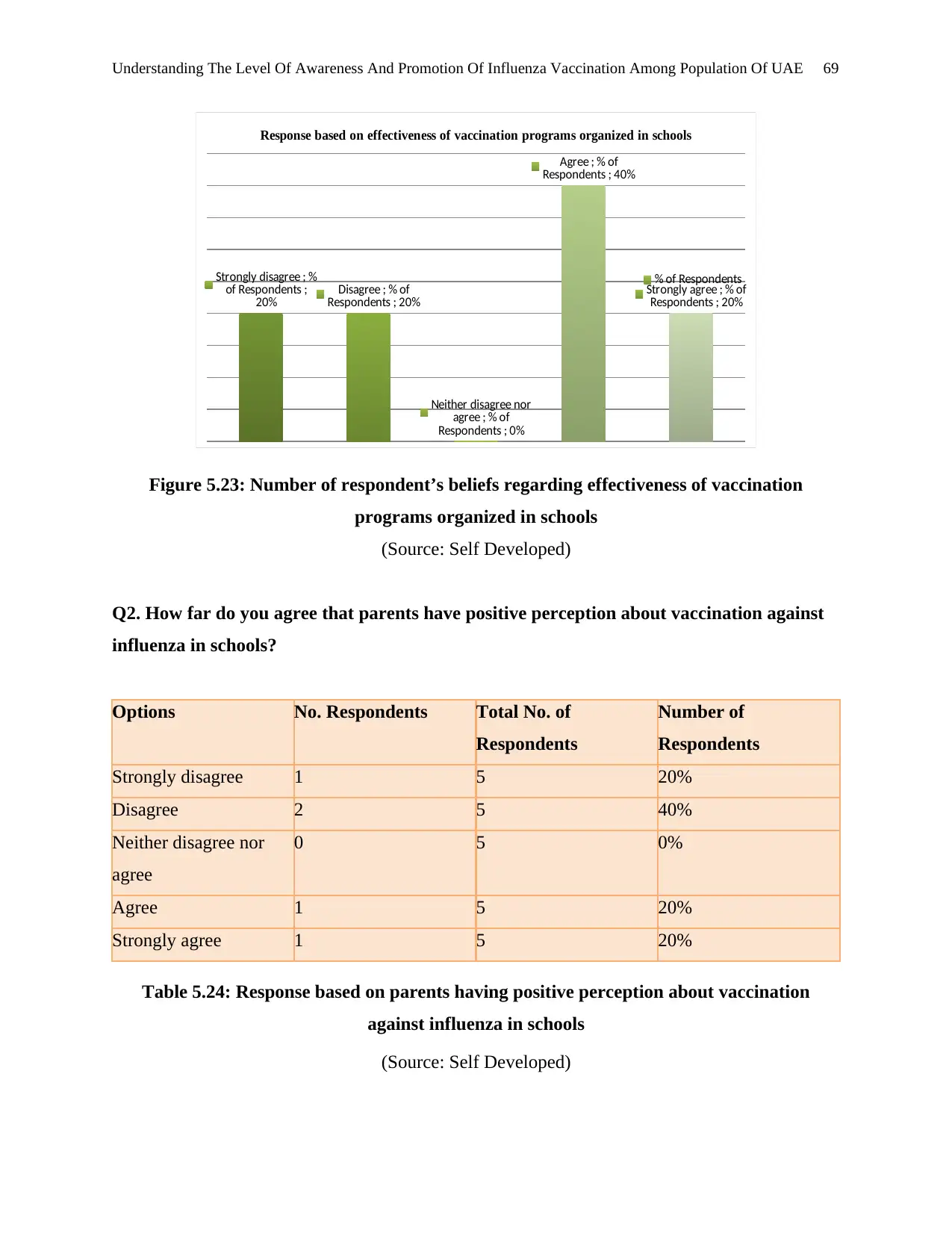
Understanding The Level Of Awareness And Promotion Of Influenza Vaccination Among Population Of UAE 69
Strongly disagree ; %
of Respondents ;
20% Disagree ; % of
Respondents ; 20%
Neither disagree nor
agree ; % of
Respondents ; 0%
Agree ; % of
Respondents ; 40%
Strongly agree ; % of
Respondents ; 20%
Response based on effectiveness of vaccination programs organized in schools
% of Respondents
Figure 5.23: Number of respondent’s beliefs regarding effectiveness of vaccination
programs organized in schools
(Source: Self Developed)
Q2. How far do you agree that parents have positive perception about vaccination against
influenza in schools?
Options No. Respondents Total No. of
Respondents
Number of
Respondents
Strongly disagree 1 5 20%
Disagree 2 5 40%
Neither disagree nor
agree
0 5 0%
Agree 1 5 20%
Strongly agree 1 5 20%
Table 5.24: Response based on parents having positive perception about vaccination
against influenza in schools
(Source: Self Developed)
Strongly disagree ; %
of Respondents ;
20% Disagree ; % of
Respondents ; 20%
Neither disagree nor
agree ; % of
Respondents ; 0%
Agree ; % of
Respondents ; 40%
Strongly agree ; % of
Respondents ; 20%
Response based on effectiveness of vaccination programs organized in schools
% of Respondents
Figure 5.23: Number of respondent’s beliefs regarding effectiveness of vaccination
programs organized in schools
(Source: Self Developed)
Q2. How far do you agree that parents have positive perception about vaccination against
influenza in schools?
Options No. Respondents Total No. of
Respondents
Number of
Respondents
Strongly disagree 1 5 20%
Disagree 2 5 40%
Neither disagree nor
agree
0 5 0%
Agree 1 5 20%
Strongly agree 1 5 20%
Table 5.24: Response based on parents having positive perception about vaccination
against influenza in schools
(Source: Self Developed)
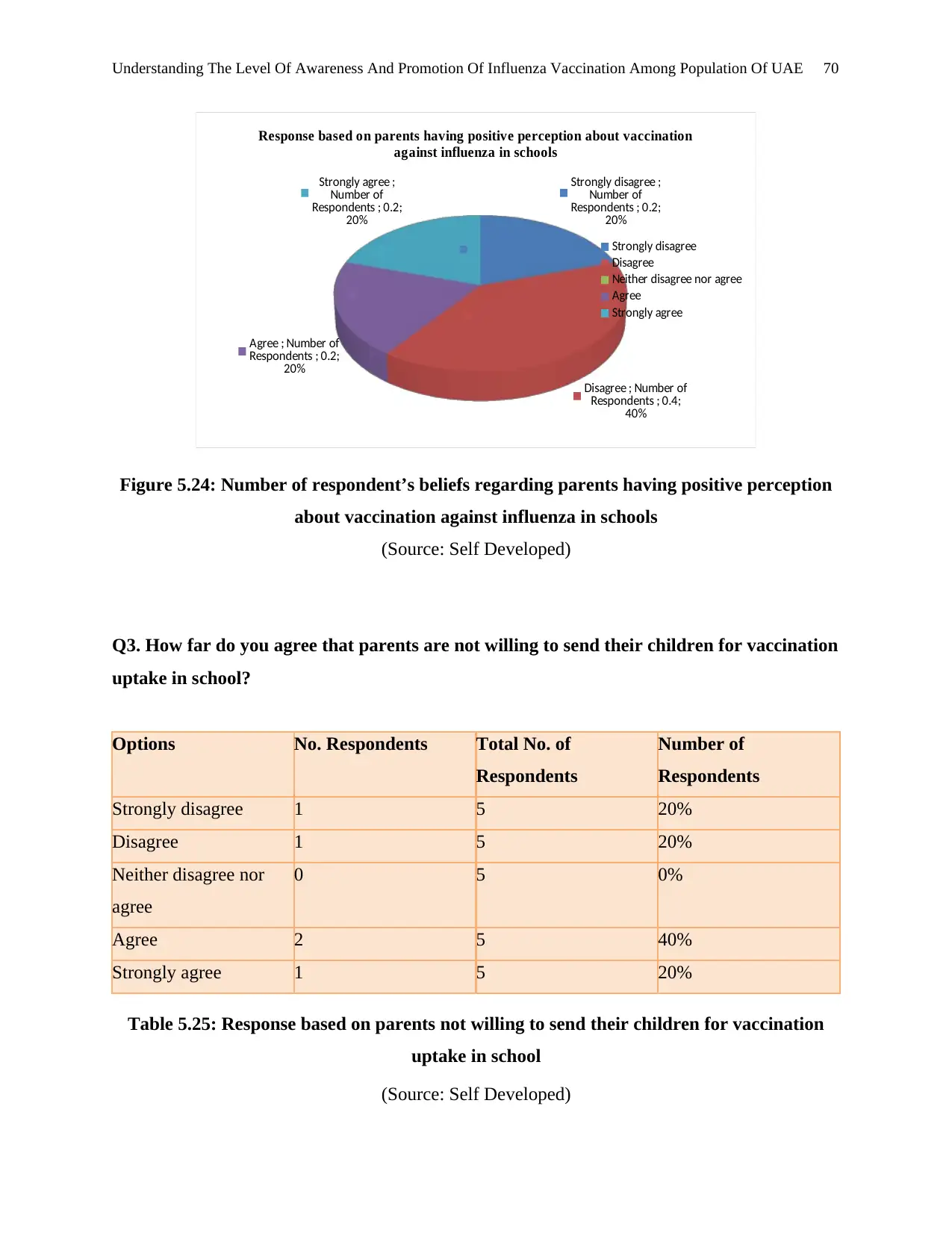
Understanding The Level Of Awareness And Promotion Of Influenza Vaccination Among Population Of UAE 70
Strongly disagree ;
Number of
Respondents ; 0.2;
20%
Disagree ; Number of
Respondents ; 0.4;
40%
Agree ; Number of
Respondents ; 0.2;
20%
Strongly agree ;
Number of
Respondents ; 0.2;
20%
Response based on parents having positive perception about vaccination
against influenza in schools
Strongly disagree
Disagree
Neither disagree nor agree
Agree
Strongly agree
Figure 5.24: Number of respondent’s beliefs regarding parents having positive perception
about vaccination against influenza in schools
(Source: Self Developed)
Q3. How far do you agree that parents are not willing to send their children for vaccination
uptake in school?
Options No. Respondents Total No. of
Respondents
Number of
Respondents
Strongly disagree 1 5 20%
Disagree 1 5 20%
Neither disagree nor
agree
0 5 0%
Agree 2 5 40%
Strongly agree 1 5 20%
Table 5.25: Response based on parents not willing to send their children for vaccination
uptake in school
(Source: Self Developed)
Strongly disagree ;
Number of
Respondents ; 0.2;
20%
Disagree ; Number of
Respondents ; 0.4;
40%
Agree ; Number of
Respondents ; 0.2;
20%
Strongly agree ;
Number of
Respondents ; 0.2;
20%
Response based on parents having positive perception about vaccination
against influenza in schools
Strongly disagree
Disagree
Neither disagree nor agree
Agree
Strongly agree
Figure 5.24: Number of respondent’s beliefs regarding parents having positive perception
about vaccination against influenza in schools
(Source: Self Developed)
Q3. How far do you agree that parents are not willing to send their children for vaccination
uptake in school?
Options No. Respondents Total No. of
Respondents
Number of
Respondents
Strongly disagree 1 5 20%
Disagree 1 5 20%
Neither disagree nor
agree
0 5 0%
Agree 2 5 40%
Strongly agree 1 5 20%
Table 5.25: Response based on parents not willing to send their children for vaccination
uptake in school
(Source: Self Developed)
Paraphrase This Document
Need a fresh take? Get an instant paraphrase of this document with our AI Paraphraser
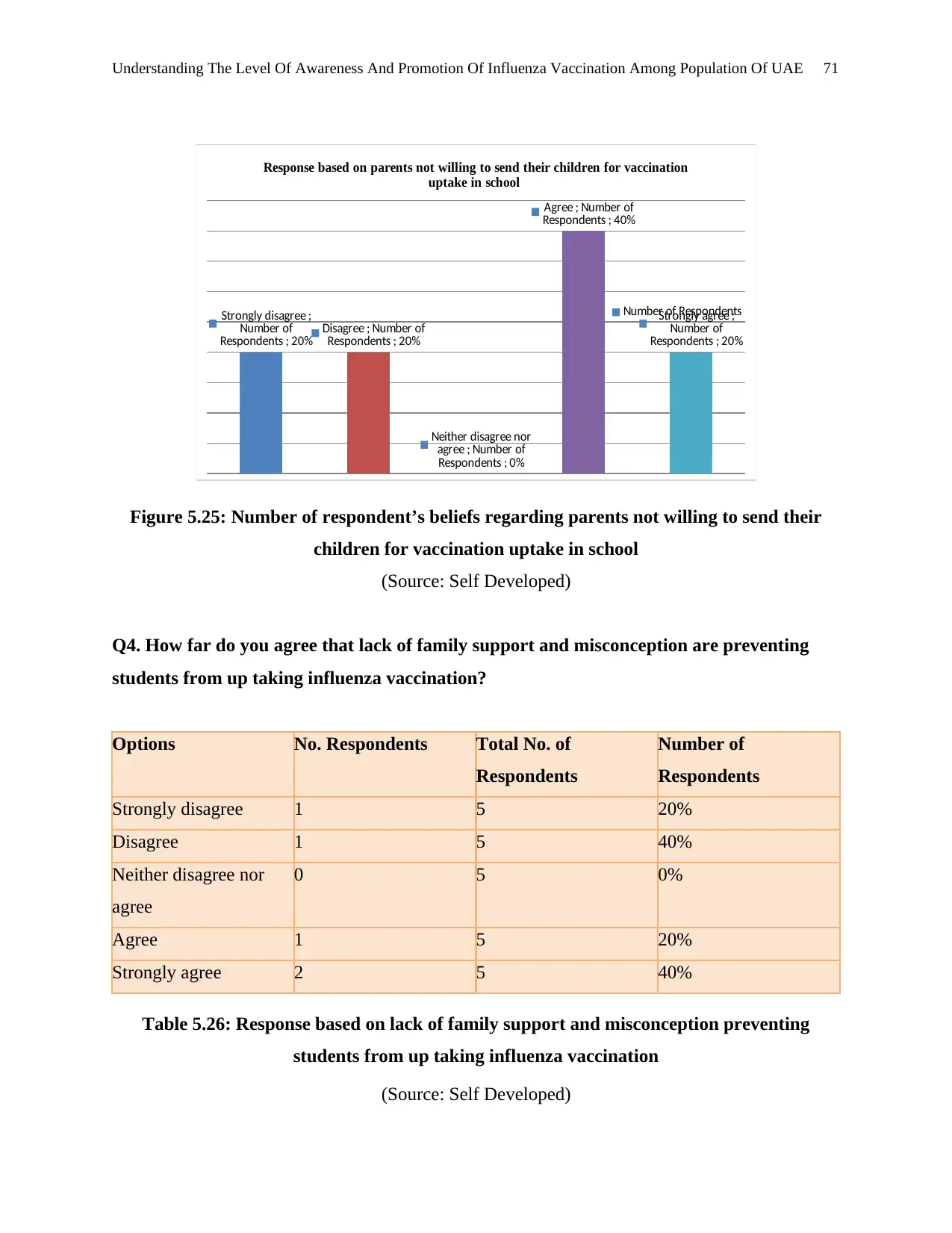
Understanding The Level Of Awareness And Promotion Of Influenza Vaccination Among Population Of UAE 71
Strongly disagree ;
Number of
Respondents ; 20% Disagree ; Number of
Respondents ; 20%
Neither disagree nor
agree ; Number of
Respondents ; 0%
Agree ; Number of
Respondents ; 40%
Strongly agree ;
Number of
Respondents ; 20%
Response based on parents not willing to send their children for vaccination
uptake in school
Number of Respondents
Figure 5.25: Number of respondent’s beliefs regarding parents not willing to send their
children for vaccination uptake in school
(Source: Self Developed)
Q4. How far do you agree that lack of family support and misconception are preventing
students from up taking influenza vaccination?
Options No. Respondents Total No. of
Respondents
Number of
Respondents
Strongly disagree 1 5 20%
Disagree 1 5 40%
Neither disagree nor
agree
0 5 0%
Agree 1 5 20%
Strongly agree 2 5 40%
Table 5.26: Response based on lack of family support and misconception preventing
students from up taking influenza vaccination
(Source: Self Developed)
Strongly disagree ;
Number of
Respondents ; 20% Disagree ; Number of
Respondents ; 20%
Neither disagree nor
agree ; Number of
Respondents ; 0%
Agree ; Number of
Respondents ; 40%
Strongly agree ;
Number of
Respondents ; 20%
Response based on parents not willing to send their children for vaccination
uptake in school
Number of Respondents
Figure 5.25: Number of respondent’s beliefs regarding parents not willing to send their
children for vaccination uptake in school
(Source: Self Developed)
Q4. How far do you agree that lack of family support and misconception are preventing
students from up taking influenza vaccination?
Options No. Respondents Total No. of
Respondents
Number of
Respondents
Strongly disagree 1 5 20%
Disagree 1 5 40%
Neither disagree nor
agree
0 5 0%
Agree 1 5 20%
Strongly agree 2 5 40%
Table 5.26: Response based on lack of family support and misconception preventing
students from up taking influenza vaccination
(Source: Self Developed)
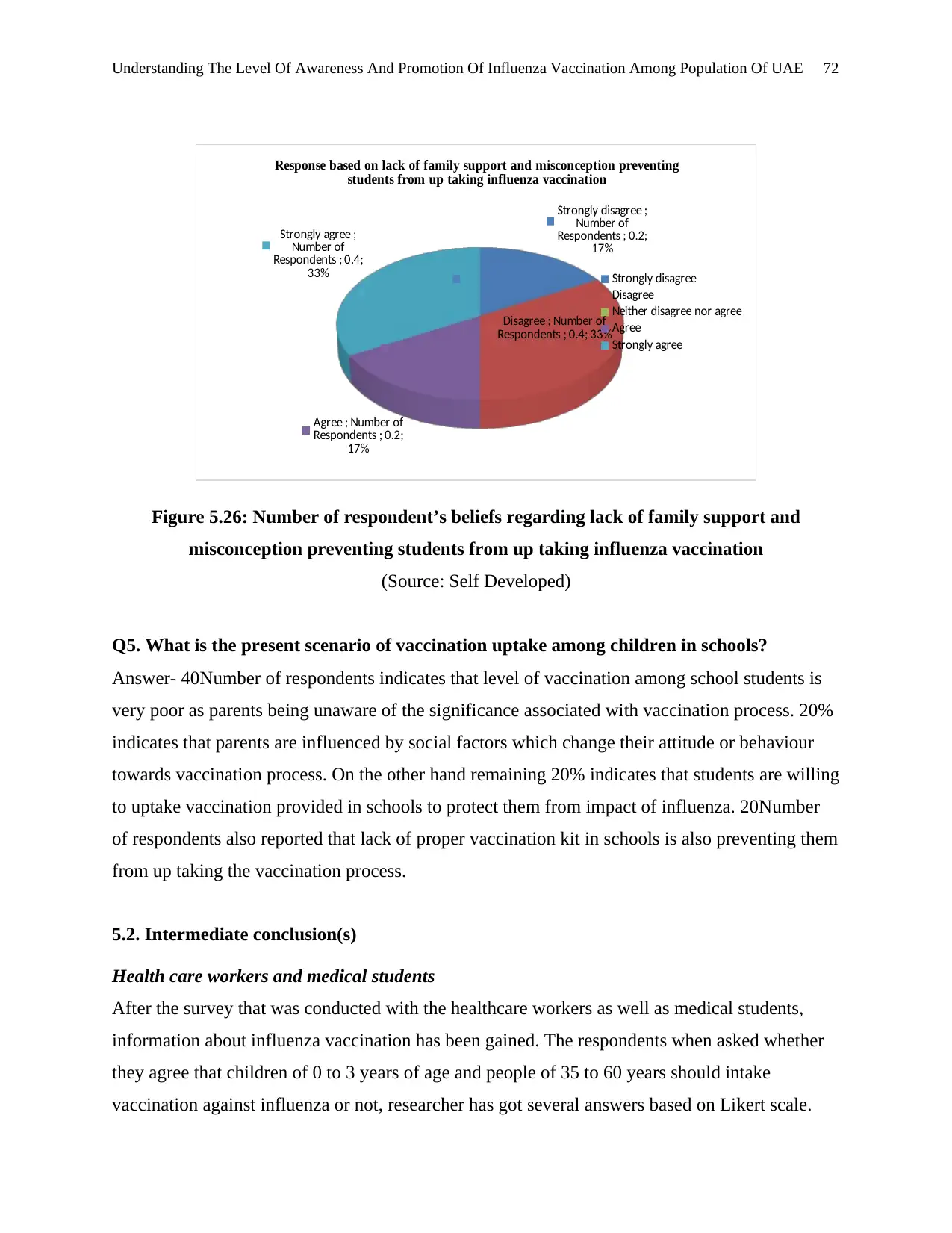
Understanding The Level Of Awareness And Promotion Of Influenza Vaccination Among Population Of UAE 72
Strongly disagree ;
Number of
Respondents ; 0.2;
17%
Disagree ; Number of
Respondents ; 0.4; 33%
Agree ; Number of
Respondents ; 0.2;
17%
Strongly agree ;
Number of
Respondents ; 0.4;
33%
Response based on lack of family support and misconception preventing
students from up taking influenza vaccination
Strongly disagree
Disagree
Neither disagree nor agree
Agree
Strongly agree
Figure 5.26: Number of respondent’s beliefs regarding lack of family support and
misconception preventing students from up taking influenza vaccination
(Source: Self Developed)
Q5. What is the present scenario of vaccination uptake among children in schools?
Answer- 40Number of respondents indicates that level of vaccination among school students is
very poor as parents being unaware of the significance associated with vaccination process. 20%
indicates that parents are influenced by social factors which change their attitude or behaviour
towards vaccination process. On the other hand remaining 20% indicates that students are willing
to uptake vaccination provided in schools to protect them from impact of influenza. 20Number
of respondents also reported that lack of proper vaccination kit in schools is also preventing them
from up taking the vaccination process.
5.2. Intermediate conclusion(s)
Health care workers and medical students
After the survey that was conducted with the healthcare workers as well as medical students,
information about influenza vaccination has been gained. The respondents when asked whether
they agree that children of 0 to 3 years of age and people of 35 to 60 years should intake
vaccination against influenza or not, researcher has got several answers based on Likert scale.
Strongly disagree ;
Number of
Respondents ; 0.2;
17%
Disagree ; Number of
Respondents ; 0.4; 33%
Agree ; Number of
Respondents ; 0.2;
17%
Strongly agree ;
Number of
Respondents ; 0.4;
33%
Response based on lack of family support and misconception preventing
students from up taking influenza vaccination
Strongly disagree
Disagree
Neither disagree nor agree
Agree
Strongly agree
Figure 5.26: Number of respondent’s beliefs regarding lack of family support and
misconception preventing students from up taking influenza vaccination
(Source: Self Developed)
Q5. What is the present scenario of vaccination uptake among children in schools?
Answer- 40Number of respondents indicates that level of vaccination among school students is
very poor as parents being unaware of the significance associated with vaccination process. 20%
indicates that parents are influenced by social factors which change their attitude or behaviour
towards vaccination process. On the other hand remaining 20% indicates that students are willing
to uptake vaccination provided in schools to protect them from impact of influenza. 20Number
of respondents also reported that lack of proper vaccination kit in schools is also preventing them
from up taking the vaccination process.
5.2. Intermediate conclusion(s)
Health care workers and medical students
After the survey that was conducted with the healthcare workers as well as medical students,
information about influenza vaccination has been gained. The respondents when asked whether
they agree that children of 0 to 3 years of age and people of 35 to 60 years should intake
vaccination against influenza or not, researcher has got several answers based on Likert scale.
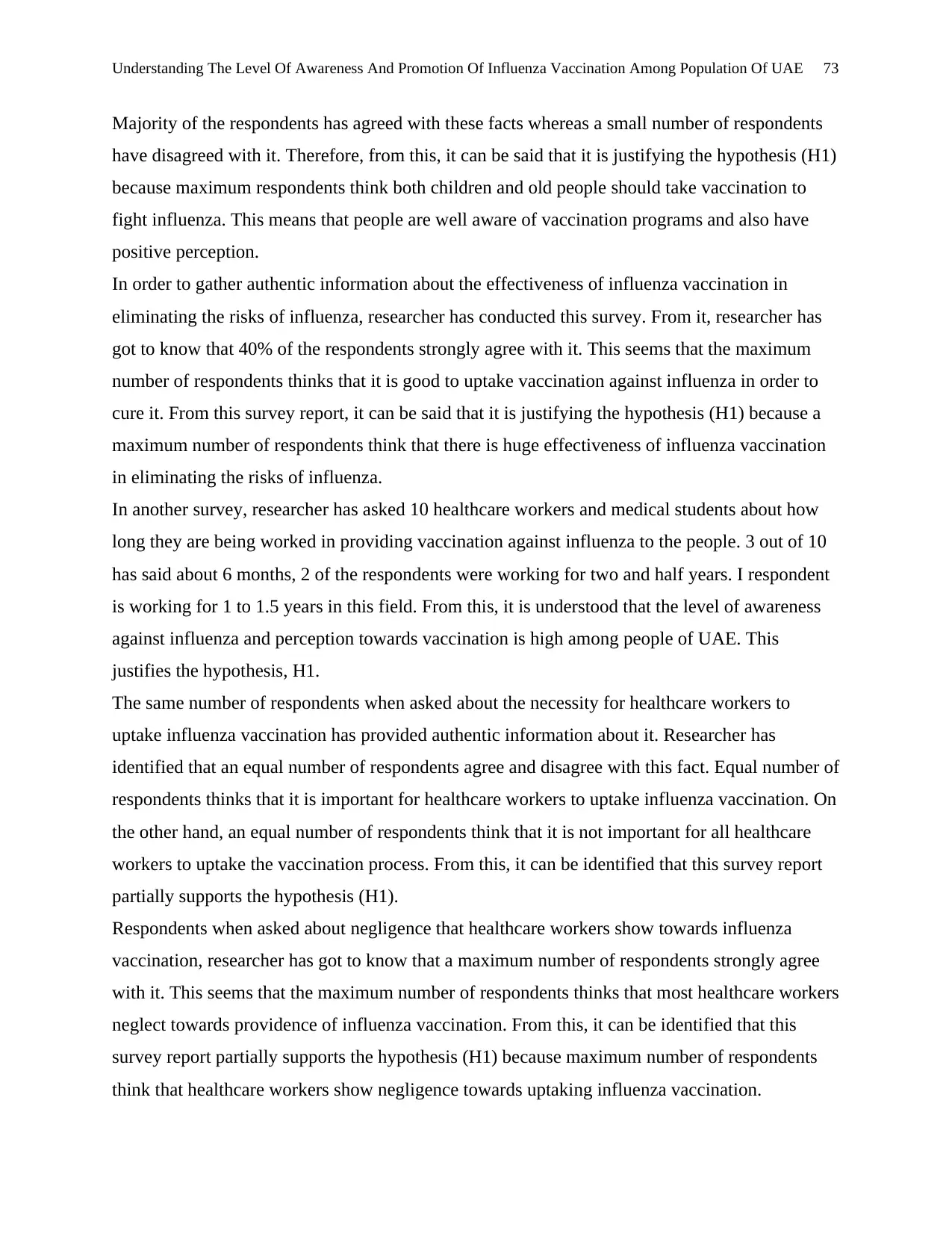
Understanding The Level Of Awareness And Promotion Of Influenza Vaccination Among Population Of UAE 73
Majority of the respondents has agreed with these facts whereas a small number of respondents
have disagreed with it. Therefore, from this, it can be said that it is justifying the hypothesis (H1)
because maximum respondents think both children and old people should take vaccination to
fight influenza. This means that people are well aware of vaccination programs and also have
positive perception.
In order to gather authentic information about the effectiveness of influenza vaccination in
eliminating the risks of influenza, researcher has conducted this survey. From it, researcher has
got to know that 40% of the respondents strongly agree with it. This seems that the maximum
number of respondents thinks that it is good to uptake vaccination against influenza in order to
cure it. From this survey report, it can be said that it is justifying the hypothesis (H1) because a
maximum number of respondents think that there is huge effectiveness of influenza vaccination
in eliminating the risks of influenza.
In another survey, researcher has asked 10 healthcare workers and medical students about how
long they are being worked in providing vaccination against influenza to the people. 3 out of 10
has said about 6 months, 2 of the respondents were working for two and half years. I respondent
is working for 1 to 1.5 years in this field. From this, it is understood that the level of awareness
against influenza and perception towards vaccination is high among people of UAE. This
justifies the hypothesis, H1.
The same number of respondents when asked about the necessity for healthcare workers to
uptake influenza vaccination has provided authentic information about it. Researcher has
identified that an equal number of respondents agree and disagree with this fact. Equal number of
respondents thinks that it is important for healthcare workers to uptake influenza vaccination. On
the other hand, an equal number of respondents think that it is not important for all healthcare
workers to uptake the vaccination process. From this, it can be identified that this survey report
partially supports the hypothesis (H1).
Respondents when asked about negligence that healthcare workers show towards influenza
vaccination, researcher has got to know that a maximum number of respondents strongly agree
with it. This seems that the maximum number of respondents thinks that most healthcare workers
neglect towards providence of influenza vaccination. From this, it can be identified that this
survey report partially supports the hypothesis (H1) because maximum number of respondents
think that healthcare workers show negligence towards uptaking influenza vaccination.
Majority of the respondents has agreed with these facts whereas a small number of respondents
have disagreed with it. Therefore, from this, it can be said that it is justifying the hypothesis (H1)
because maximum respondents think both children and old people should take vaccination to
fight influenza. This means that people are well aware of vaccination programs and also have
positive perception.
In order to gather authentic information about the effectiveness of influenza vaccination in
eliminating the risks of influenza, researcher has conducted this survey. From it, researcher has
got to know that 40% of the respondents strongly agree with it. This seems that the maximum
number of respondents thinks that it is good to uptake vaccination against influenza in order to
cure it. From this survey report, it can be said that it is justifying the hypothesis (H1) because a
maximum number of respondents think that there is huge effectiveness of influenza vaccination
in eliminating the risks of influenza.
In another survey, researcher has asked 10 healthcare workers and medical students about how
long they are being worked in providing vaccination against influenza to the people. 3 out of 10
has said about 6 months, 2 of the respondents were working for two and half years. I respondent
is working for 1 to 1.5 years in this field. From this, it is understood that the level of awareness
against influenza and perception towards vaccination is high among people of UAE. This
justifies the hypothesis, H1.
The same number of respondents when asked about the necessity for healthcare workers to
uptake influenza vaccination has provided authentic information about it. Researcher has
identified that an equal number of respondents agree and disagree with this fact. Equal number of
respondents thinks that it is important for healthcare workers to uptake influenza vaccination. On
the other hand, an equal number of respondents think that it is not important for all healthcare
workers to uptake the vaccination process. From this, it can be identified that this survey report
partially supports the hypothesis (H1).
Respondents when asked about negligence that healthcare workers show towards influenza
vaccination, researcher has got to know that a maximum number of respondents strongly agree
with it. This seems that the maximum number of respondents thinks that most healthcare workers
neglect towards providence of influenza vaccination. From this, it can be identified that this
survey report partially supports the hypothesis (H1) because maximum number of respondents
think that healthcare workers show negligence towards uptaking influenza vaccination.
Secure Best Marks with AI Grader
Need help grading? Try our AI Grader for instant feedback on your assignments.
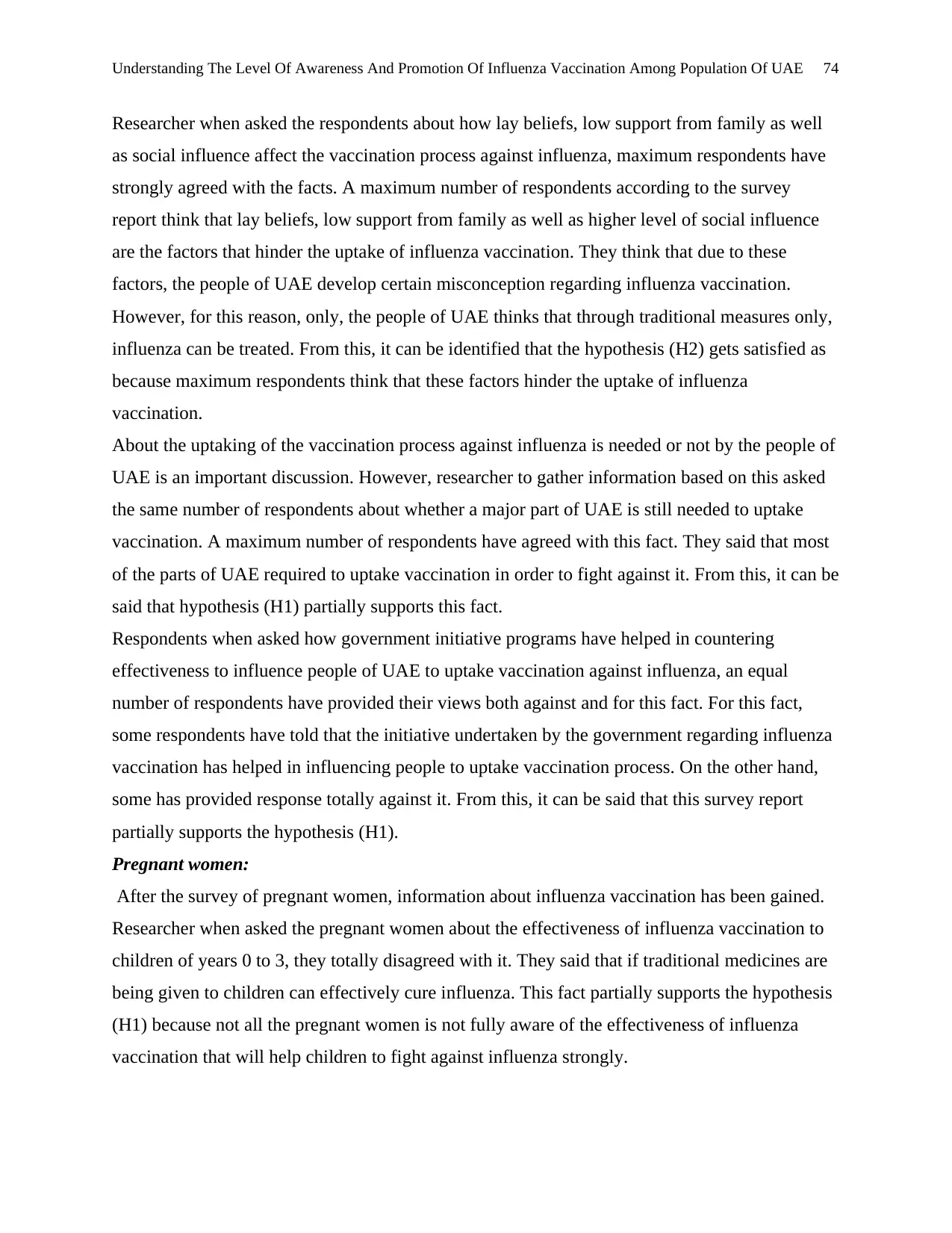
Understanding The Level Of Awareness And Promotion Of Influenza Vaccination Among Population Of UAE 74
Researcher when asked the respondents about how lay beliefs, low support from family as well
as social influence affect the vaccination process against influenza, maximum respondents have
strongly agreed with the facts. A maximum number of respondents according to the survey
report think that lay beliefs, low support from family as well as higher level of social influence
are the factors that hinder the uptake of influenza vaccination. They think that due to these
factors, the people of UAE develop certain misconception regarding influenza vaccination.
However, for this reason, only, the people of UAE thinks that through traditional measures only,
influenza can be treated. From this, it can be identified that the hypothesis (H2) gets satisfied as
because maximum respondents think that these factors hinder the uptake of influenza
vaccination.
About the uptaking of the vaccination process against influenza is needed or not by the people of
UAE is an important discussion. However, researcher to gather information based on this asked
the same number of respondents about whether a major part of UAE is still needed to uptake
vaccination. A maximum number of respondents have agreed with this fact. They said that most
of the parts of UAE required to uptake vaccination in order to fight against it. From this, it can be
said that hypothesis (H1) partially supports this fact.
Respondents when asked how government initiative programs have helped in countering
effectiveness to influence people of UAE to uptake vaccination against influenza, an equal
number of respondents have provided their views both against and for this fact. For this fact,
some respondents have told that the initiative undertaken by the government regarding influenza
vaccination has helped in influencing people to uptake vaccination process. On the other hand,
some has provided response totally against it. From this, it can be said that this survey report
partially supports the hypothesis (H1).
Pregnant women:
After the survey of pregnant women, information about influenza vaccination has been gained.
Researcher when asked the pregnant women about the effectiveness of influenza vaccination to
children of years 0 to 3, they totally disagreed with it. They said that if traditional medicines are
being given to children can effectively cure influenza. This fact partially supports the hypothesis
(H1) because not all the pregnant women is not fully aware of the effectiveness of influenza
vaccination that will help children to fight against influenza strongly.
Researcher when asked the respondents about how lay beliefs, low support from family as well
as social influence affect the vaccination process against influenza, maximum respondents have
strongly agreed with the facts. A maximum number of respondents according to the survey
report think that lay beliefs, low support from family as well as higher level of social influence
are the factors that hinder the uptake of influenza vaccination. They think that due to these
factors, the people of UAE develop certain misconception regarding influenza vaccination.
However, for this reason, only, the people of UAE thinks that through traditional measures only,
influenza can be treated. From this, it can be identified that the hypothesis (H2) gets satisfied as
because maximum respondents think that these factors hinder the uptake of influenza
vaccination.
About the uptaking of the vaccination process against influenza is needed or not by the people of
UAE is an important discussion. However, researcher to gather information based on this asked
the same number of respondents about whether a major part of UAE is still needed to uptake
vaccination. A maximum number of respondents have agreed with this fact. They said that most
of the parts of UAE required to uptake vaccination in order to fight against it. From this, it can be
said that hypothesis (H1) partially supports this fact.
Respondents when asked how government initiative programs have helped in countering
effectiveness to influence people of UAE to uptake vaccination against influenza, an equal
number of respondents have provided their views both against and for this fact. For this fact,
some respondents have told that the initiative undertaken by the government regarding influenza
vaccination has helped in influencing people to uptake vaccination process. On the other hand,
some has provided response totally against it. From this, it can be said that this survey report
partially supports the hypothesis (H1).
Pregnant women:
After the survey of pregnant women, information about influenza vaccination has been gained.
Researcher when asked the pregnant women about the effectiveness of influenza vaccination to
children of years 0 to 3, they totally disagreed with it. They said that if traditional medicines are
being given to children can effectively cure influenza. This fact partially supports the hypothesis
(H1) because not all the pregnant women is not fully aware of the effectiveness of influenza
vaccination that will help children to fight against influenza strongly.

Understanding The Level Of Awareness And Promotion Of Influenza Vaccination Among Population Of UAE 75
Gathering information from the pregnant women regarding whether children are the main
carriers of this influenza virus or not, they provided disagreement towards this fact. They said
that children are not at all the major carriers of this influenza virus. Adults also transmit this
virus from one person to another. This fact partially supports the hypothesis (H1).
Pregnant women when asked whether taking up influenza vaccination during pregnancy protects
the mother and baby from the impact of such pandemic virus, maximum of the respondent have
provided disagreement. However, very little respondent has agreed with this fact. This helps in
identification of the hypothesis and here H1 is getting partially satisfied. This is so because not
all the respondents think that every people of UAE are fully aware of this fact.
Researcher to acquire information based on influenza vaccination is being neglected by pregnant
women or not, pregnant women as respondents have helped a lot. A maximum number of
respondents have agreed with this fact that maximum number of pregnant women neglect to
uptake influenza vaccination. It is also that equal number of respondents have neither agreed nor
disagreed with this fact. On this basis, the hypothesis (H1) gets partially satisfied because not all
women is fully aware of the effectiveness of influenza vaccination.
Researcher when asked the respondents about how lay beliefs, low support from family as well
as social influence affect the vaccination process against influenza, maximum respondents have
agreed with the facts. Maximum number of respondents thinks that lay beliefs, low support from
family as well as higher level of social influence are the factors that hinder the uptake of
influenza vaccination. They think that due to these factors, the people of UAE develop certain
misconception regarding influenza vaccination. However, for this reason, only, the people of
UAE thinks that through traditional measures only, influenza can be treated. From this, it can be
identified that the hypothesis (H2) gets satisfied as because maximum respondents think that
these factors hinder the uptake of influenza vaccination.
In order to gather information about whether vaccination against influenza affect babies or not,
researcher has considered the same number of respondents. From them, researcher has got to
know that equal number of respondents is for and against this fact. Some respondents agrees that
vaccination affects or can affect babies when up taken. However, some other respondents are
totally against it. They think that if vaccination is being provided to baby, it will be an effective
one for them to fight against influenza. This survey report partially supports with the hypothesis
Gathering information from the pregnant women regarding whether children are the main
carriers of this influenza virus or not, they provided disagreement towards this fact. They said
that children are not at all the major carriers of this influenza virus. Adults also transmit this
virus from one person to another. This fact partially supports the hypothesis (H1).
Pregnant women when asked whether taking up influenza vaccination during pregnancy protects
the mother and baby from the impact of such pandemic virus, maximum of the respondent have
provided disagreement. However, very little respondent has agreed with this fact. This helps in
identification of the hypothesis and here H1 is getting partially satisfied. This is so because not
all the respondents think that every people of UAE are fully aware of this fact.
Researcher to acquire information based on influenza vaccination is being neglected by pregnant
women or not, pregnant women as respondents have helped a lot. A maximum number of
respondents have agreed with this fact that maximum number of pregnant women neglect to
uptake influenza vaccination. It is also that equal number of respondents have neither agreed nor
disagreed with this fact. On this basis, the hypothesis (H1) gets partially satisfied because not all
women is fully aware of the effectiveness of influenza vaccination.
Researcher when asked the respondents about how lay beliefs, low support from family as well
as social influence affect the vaccination process against influenza, maximum respondents have
agreed with the facts. Maximum number of respondents thinks that lay beliefs, low support from
family as well as higher level of social influence are the factors that hinder the uptake of
influenza vaccination. They think that due to these factors, the people of UAE develop certain
misconception regarding influenza vaccination. However, for this reason, only, the people of
UAE thinks that through traditional measures only, influenza can be treated. From this, it can be
identified that the hypothesis (H2) gets satisfied as because maximum respondents think that
these factors hinder the uptake of influenza vaccination.
In order to gather information about whether vaccination against influenza affect babies or not,
researcher has considered the same number of respondents. From them, researcher has got to
know that equal number of respondents is for and against this fact. Some respondents agrees that
vaccination affects or can affect babies when up taken. However, some other respondents are
totally against it. They think that if vaccination is being provided to baby, it will be an effective
one for them to fight against influenza. This survey report partially supports with the hypothesis

Understanding The Level Of Awareness And Promotion Of Influenza Vaccination Among Population Of UAE 76
(H1) because not all the people are fully aware with the effectiveness of influenza vaccination
and has not developed full perception for it.
General public of UAE:
Researcher has considered general public of UAE in order to gather authentic information about
the research topic and fulfill both the objectives as well as the hypothesis that researcher has
framed for this research study.
Asking the general public of UAE about whether influenza is a serious disease or not, among 8
respondents maximum of them has disagreed with the fact. According to their belief, influenza is
a normal cough and cold viral disease and it will get better if medicine of cold and traditional
preventive measures is taken. However, small number of respondent has agreed with the fact that
influenza is a very serious type of disease and it can only be treated with proper vaccination. This
survey report partially supports the hypothesis (H1) that researcher has framed.
General public of UAE when asked whether traditional method of treating influenza is effective
or not, maximum number of respondents has agreed with the fact. According to them and their
belief, influenza is a normal cough and cold viral disease and it will get better if medicine of cold
and traditional preventive measures is taken. According to them, the use of traditional measures
like herbal leaves and eating of healthy foods were considered to be effective enough in
preventing the impact of influenza. However, small number of respondent has disagreed with
this same fact. This survey report partially supports the hypothesis (H1) as people are not fully
aware about the influenza vaccination.
Asking the general public of UAE about whether influenza vaccination is effective in mitigating
the impact of this virus or not, among 8 respondents maximum of them has disagreed with the
fact. According to their belief, influenza cannot be cured through vaccination but can be cure
when traditional preventive measures are taken. However, small number of respondent has
agreed with this fact that influenza vaccination is effective in mitigating the impact of this virus.
This survey report partially supports the hypothesis (H1).
Researcher when gather information based on whether misconception among people of UAE is
hindering the uptake of influenza vaccination or not, have identified disagreement from the
respondent’s point of view. Maximum respondents have said that misconception does not affect
vaccination uptake among people of UAE. According to their belief, influenza is a normal cough
and cold viral disease and it will get better if medicine of cold and traditional preventive
(H1) because not all the people are fully aware with the effectiveness of influenza vaccination
and has not developed full perception for it.
General public of UAE:
Researcher has considered general public of UAE in order to gather authentic information about
the research topic and fulfill both the objectives as well as the hypothesis that researcher has
framed for this research study.
Asking the general public of UAE about whether influenza is a serious disease or not, among 8
respondents maximum of them has disagreed with the fact. According to their belief, influenza is
a normal cough and cold viral disease and it will get better if medicine of cold and traditional
preventive measures is taken. However, small number of respondent has agreed with the fact that
influenza is a very serious type of disease and it can only be treated with proper vaccination. This
survey report partially supports the hypothesis (H1) that researcher has framed.
General public of UAE when asked whether traditional method of treating influenza is effective
or not, maximum number of respondents has agreed with the fact. According to them and their
belief, influenza is a normal cough and cold viral disease and it will get better if medicine of cold
and traditional preventive measures is taken. According to them, the use of traditional measures
like herbal leaves and eating of healthy foods were considered to be effective enough in
preventing the impact of influenza. However, small number of respondent has disagreed with
this same fact. This survey report partially supports the hypothesis (H1) as people are not fully
aware about the influenza vaccination.
Asking the general public of UAE about whether influenza vaccination is effective in mitigating
the impact of this virus or not, among 8 respondents maximum of them has disagreed with the
fact. According to their belief, influenza cannot be cured through vaccination but can be cure
when traditional preventive measures are taken. However, small number of respondent has
agreed with this fact that influenza vaccination is effective in mitigating the impact of this virus.
This survey report partially supports the hypothesis (H1).
Researcher when gather information based on whether misconception among people of UAE is
hindering the uptake of influenza vaccination or not, have identified disagreement from the
respondent’s point of view. Maximum respondents have said that misconception does not affect
vaccination uptake among people of UAE. According to their belief, influenza is a normal cough
and cold viral disease and it will get better if medicine of cold and traditional preventive
Paraphrase This Document
Need a fresh take? Get an instant paraphrase of this document with our AI Paraphraser
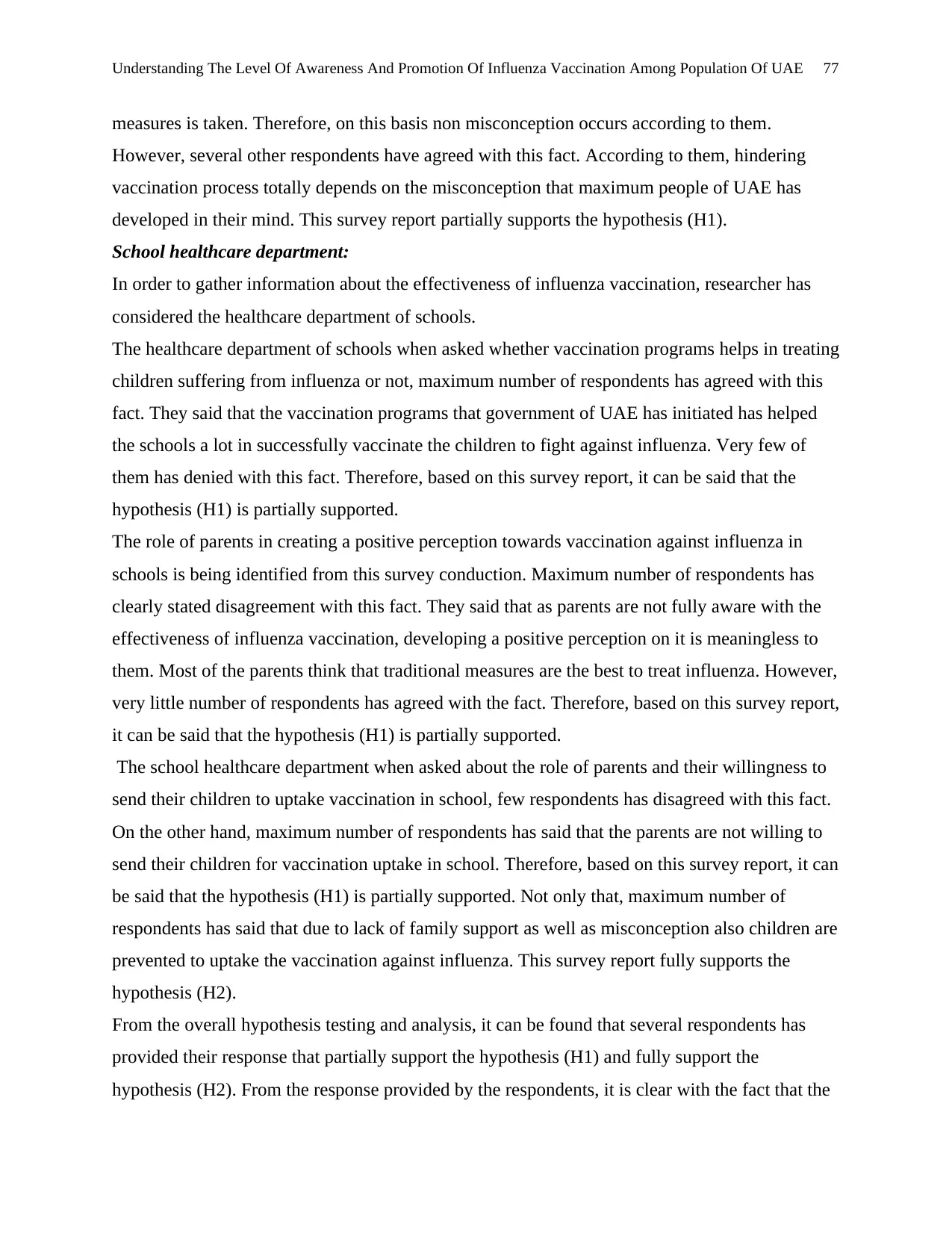
Understanding The Level Of Awareness And Promotion Of Influenza Vaccination Among Population Of UAE 77
measures is taken. Therefore, on this basis non misconception occurs according to them.
However, several other respondents have agreed with this fact. According to them, hindering
vaccination process totally depends on the misconception that maximum people of UAE has
developed in their mind. This survey report partially supports the hypothesis (H1).
School healthcare department:
In order to gather information about the effectiveness of influenza vaccination, researcher has
considered the healthcare department of schools.
The healthcare department of schools when asked whether vaccination programs helps in treating
children suffering from influenza or not, maximum number of respondents has agreed with this
fact. They said that the vaccination programs that government of UAE has initiated has helped
the schools a lot in successfully vaccinate the children to fight against influenza. Very few of
them has denied with this fact. Therefore, based on this survey report, it can be said that the
hypothesis (H1) is partially supported.
The role of parents in creating a positive perception towards vaccination against influenza in
schools is being identified from this survey conduction. Maximum number of respondents has
clearly stated disagreement with this fact. They said that as parents are not fully aware with the
effectiveness of influenza vaccination, developing a positive perception on it is meaningless to
them. Most of the parents think that traditional measures are the best to treat influenza. However,
very little number of respondents has agreed with the fact. Therefore, based on this survey report,
it can be said that the hypothesis (H1) is partially supported.
The school healthcare department when asked about the role of parents and their willingness to
send their children to uptake vaccination in school, few respondents has disagreed with this fact.
On the other hand, maximum number of respondents has said that the parents are not willing to
send their children for vaccination uptake in school. Therefore, based on this survey report, it can
be said that the hypothesis (H1) is partially supported. Not only that, maximum number of
respondents has said that due to lack of family support as well as misconception also children are
prevented to uptake the vaccination against influenza. This survey report fully supports the
hypothesis (H2).
From the overall hypothesis testing and analysis, it can be found that several respondents has
provided their response that partially support the hypothesis (H1) and fully support the
hypothesis (H2). From the response provided by the respondents, it is clear with the fact that the
measures is taken. Therefore, on this basis non misconception occurs according to them.
However, several other respondents have agreed with this fact. According to them, hindering
vaccination process totally depends on the misconception that maximum people of UAE has
developed in their mind. This survey report partially supports the hypothesis (H1).
School healthcare department:
In order to gather information about the effectiveness of influenza vaccination, researcher has
considered the healthcare department of schools.
The healthcare department of schools when asked whether vaccination programs helps in treating
children suffering from influenza or not, maximum number of respondents has agreed with this
fact. They said that the vaccination programs that government of UAE has initiated has helped
the schools a lot in successfully vaccinate the children to fight against influenza. Very few of
them has denied with this fact. Therefore, based on this survey report, it can be said that the
hypothesis (H1) is partially supported.
The role of parents in creating a positive perception towards vaccination against influenza in
schools is being identified from this survey conduction. Maximum number of respondents has
clearly stated disagreement with this fact. They said that as parents are not fully aware with the
effectiveness of influenza vaccination, developing a positive perception on it is meaningless to
them. Most of the parents think that traditional measures are the best to treat influenza. However,
very little number of respondents has agreed with the fact. Therefore, based on this survey report,
it can be said that the hypothesis (H1) is partially supported.
The school healthcare department when asked about the role of parents and their willingness to
send their children to uptake vaccination in school, few respondents has disagreed with this fact.
On the other hand, maximum number of respondents has said that the parents are not willing to
send their children for vaccination uptake in school. Therefore, based on this survey report, it can
be said that the hypothesis (H1) is partially supported. Not only that, maximum number of
respondents has said that due to lack of family support as well as misconception also children are
prevented to uptake the vaccination against influenza. This survey report fully supports the
hypothesis (H2).
From the overall hypothesis testing and analysis, it can be found that several respondents has
provided their response that partially support the hypothesis (H1) and fully support the
hypothesis (H2). From the response provided by the respondents, it is clear with the fact that the
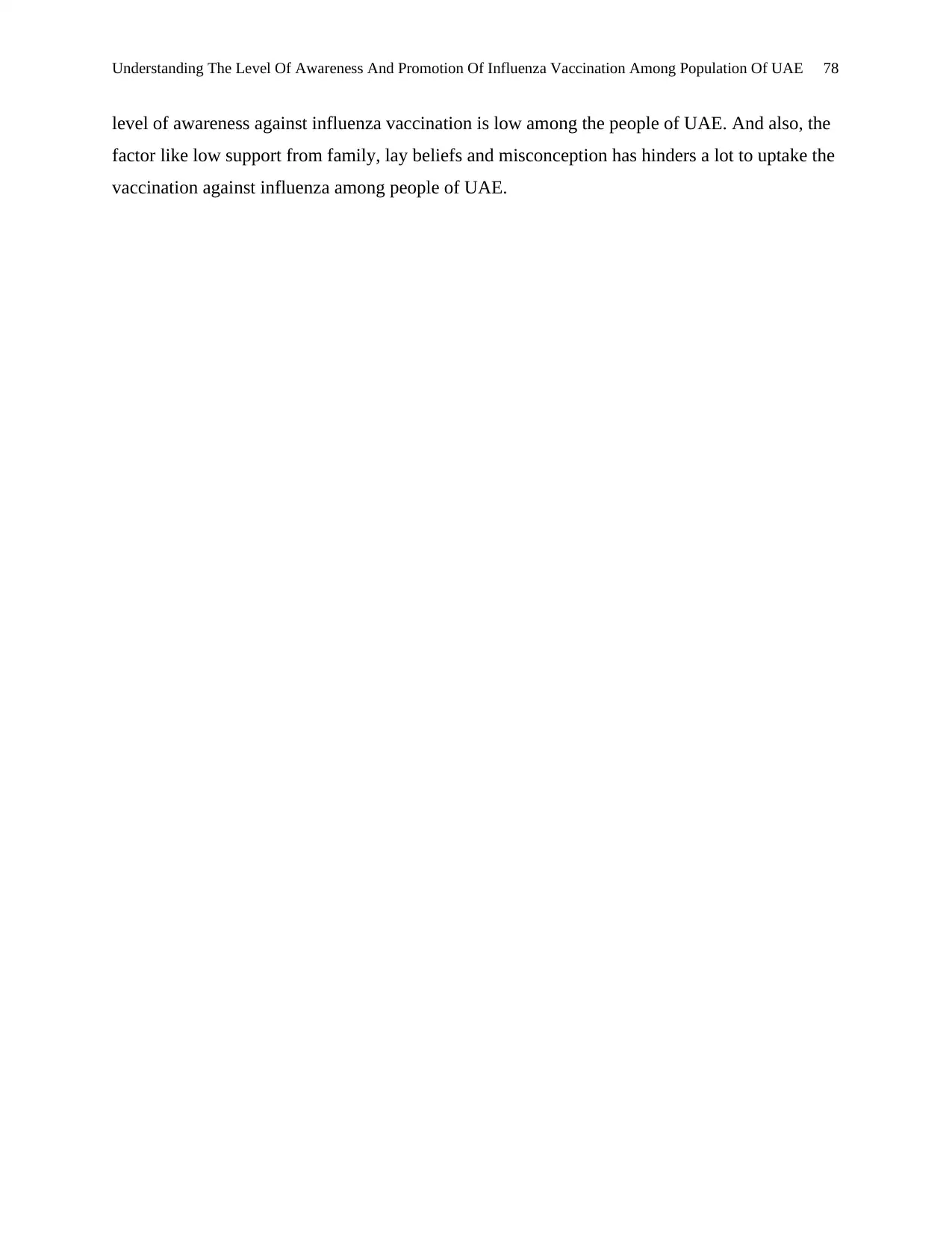
Understanding The Level Of Awareness And Promotion Of Influenza Vaccination Among Population Of UAE 78
level of awareness against influenza vaccination is low among the people of UAE. And also, the
factor like low support from family, lay beliefs and misconception has hinders a lot to uptake the
vaccination against influenza among people of UAE.
level of awareness against influenza vaccination is low among the people of UAE. And also, the
factor like low support from family, lay beliefs and misconception has hinders a lot to uptake the
vaccination against influenza among people of UAE.
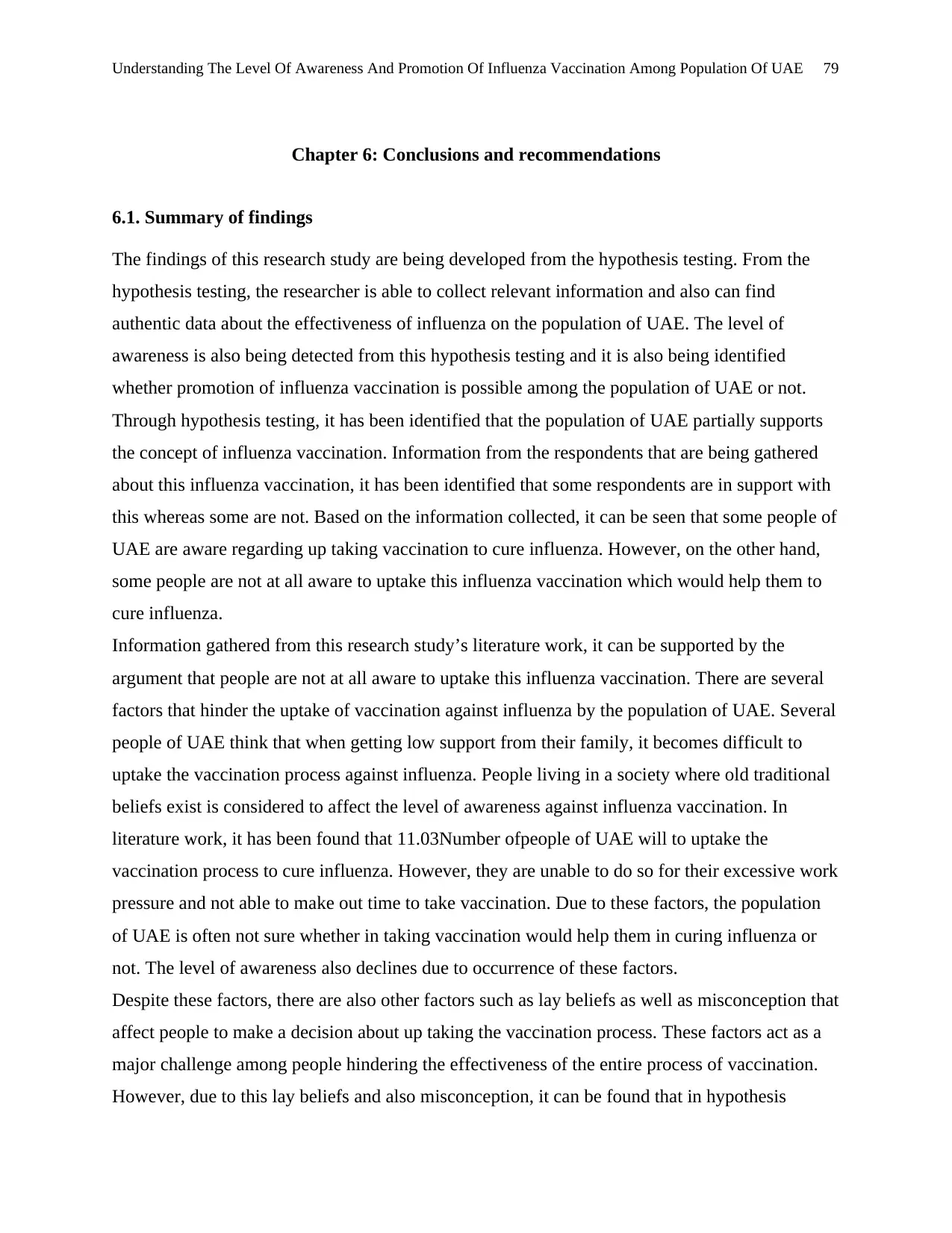
Understanding The Level Of Awareness And Promotion Of Influenza Vaccination Among Population Of UAE 79
Chapter 6: Conclusions and recommendations
6.1. Summary of findings
The findings of this research study are being developed from the hypothesis testing. From the
hypothesis testing, the researcher is able to collect relevant information and also can find
authentic data about the effectiveness of influenza on the population of UAE. The level of
awareness is also being detected from this hypothesis testing and it is also being identified
whether promotion of influenza vaccination is possible among the population of UAE or not.
Through hypothesis testing, it has been identified that the population of UAE partially supports
the concept of influenza vaccination. Information from the respondents that are being gathered
about this influenza vaccination, it has been identified that some respondents are in support with
this whereas some are not. Based on the information collected, it can be seen that some people of
UAE are aware regarding up taking vaccination to cure influenza. However, on the other hand,
some people are not at all aware to uptake this influenza vaccination which would help them to
cure influenza.
Information gathered from this research study’s literature work, it can be supported by the
argument that people are not at all aware to uptake this influenza vaccination. There are several
factors that hinder the uptake of vaccination against influenza by the population of UAE. Several
people of UAE think that when getting low support from their family, it becomes difficult to
uptake the vaccination process against influenza. People living in a society where old traditional
beliefs exist is considered to affect the level of awareness against influenza vaccination. In
literature work, it has been found that 11.03Number ofpeople of UAE will to uptake the
vaccination process to cure influenza. However, they are unable to do so for their excessive work
pressure and not able to make out time to take vaccination. Due to these factors, the population
of UAE is often not sure whether in taking vaccination would help them in curing influenza or
not. The level of awareness also declines due to occurrence of these factors.
Despite these factors, there are also other factors such as lay beliefs as well as misconception that
affect people to make a decision about up taking the vaccination process. These factors act as a
major challenge among people hindering the effectiveness of the entire process of vaccination.
However, due to this lay beliefs and also misconception, it can be found that in hypothesis
Chapter 6: Conclusions and recommendations
6.1. Summary of findings
The findings of this research study are being developed from the hypothesis testing. From the
hypothesis testing, the researcher is able to collect relevant information and also can find
authentic data about the effectiveness of influenza on the population of UAE. The level of
awareness is also being detected from this hypothesis testing and it is also being identified
whether promotion of influenza vaccination is possible among the population of UAE or not.
Through hypothesis testing, it has been identified that the population of UAE partially supports
the concept of influenza vaccination. Information from the respondents that are being gathered
about this influenza vaccination, it has been identified that some respondents are in support with
this whereas some are not. Based on the information collected, it can be seen that some people of
UAE are aware regarding up taking vaccination to cure influenza. However, on the other hand,
some people are not at all aware to uptake this influenza vaccination which would help them to
cure influenza.
Information gathered from this research study’s literature work, it can be supported by the
argument that people are not at all aware to uptake this influenza vaccination. There are several
factors that hinder the uptake of vaccination against influenza by the population of UAE. Several
people of UAE think that when getting low support from their family, it becomes difficult to
uptake the vaccination process against influenza. People living in a society where old traditional
beliefs exist is considered to affect the level of awareness against influenza vaccination. In
literature work, it has been found that 11.03Number ofpeople of UAE will to uptake the
vaccination process to cure influenza. However, they are unable to do so for their excessive work
pressure and not able to make out time to take vaccination. Due to these factors, the population
of UAE is often not sure whether in taking vaccination would help them in curing influenza or
not. The level of awareness also declines due to occurrence of these factors.
Despite these factors, there are also other factors such as lay beliefs as well as misconception that
affect people to make a decision about up taking the vaccination process. These factors act as a
major challenge among people hindering the effectiveness of the entire process of vaccination.
However, due to this lay beliefs and also misconception, it can be found that in hypothesis
Secure Best Marks with AI Grader
Need help grading? Try our AI Grader for instant feedback on your assignments.

Understanding The Level Of Awareness And Promotion Of Influenza Vaccination Among Population Of UAE 80
testing several respondents were not aware about this influenza vaccination. The respondents
who do not support up taking vaccination against influenza think that this can cause death. Their
beliefs lie in that influenza will get cured if medicine of cold and traditional preventive measures
is taken. It has been obtained from the information provided by the respondents that government
of UAE has implemented several vaccination programs as well as policies. The reason behind
collaboration of government is to make vaccination a mandatory action for children and high
risks adults. However, despite government initiative through several programs, the level of
awareness hinders due to occurrence of several factors that affect the uptake of vaccination
against influenza among population of UAE.
6.2. Overall conclusion
From the above research study, researcher has derived several conclusion regarding
understanding of awareness level as well as promotion of influenza vaccination among the
population of UAE. Researcher has clearly described the main discussion about the research
topic in the very beginning of this research study. From it, readers can get a clear cut idea about
the information provided in this research study. The main reason for selecting this research study
is to create awareness regarding the pandemic created by influenza worldwide. Another reason
behind conduction of this research study as described by the research at the very beginning lies
on, helping the population of UAE to uptake the vaccination process against influenza. This is
because according to several types of research, researcher has found that UAE is one such nation
faces the problem of influenza on a large scale. The main problem that the population of UAE
faces based on influenza is also being discussed at the very beginning of this research study.
From that, the main problem that the people of UAE face for influenza is being highlighted. It
has been said that influenza vaccination process needs to be identified on a larger scale in UAE.
This argument has been justified through analysis of several other types of research where it has
been seen that population of UAE are major sufferers of seasonal influenza. It has also been
obtained from several studies that despite high influenza rate among UAE people, up taking of
influenza vaccination are comparatively less.
Researcher has developed a problem statement from where evidence can be gathered about
several problems that vaccination program up taken against influenza faces. From this problem
statement, it is clearly understood that influenza vaccination process involves lack of awareness
testing several respondents were not aware about this influenza vaccination. The respondents
who do not support up taking vaccination against influenza think that this can cause death. Their
beliefs lie in that influenza will get cured if medicine of cold and traditional preventive measures
is taken. It has been obtained from the information provided by the respondents that government
of UAE has implemented several vaccination programs as well as policies. The reason behind
collaboration of government is to make vaccination a mandatory action for children and high
risks adults. However, despite government initiative through several programs, the level of
awareness hinders due to occurrence of several factors that affect the uptake of vaccination
against influenza among population of UAE.
6.2. Overall conclusion
From the above research study, researcher has derived several conclusion regarding
understanding of awareness level as well as promotion of influenza vaccination among the
population of UAE. Researcher has clearly described the main discussion about the research
topic in the very beginning of this research study. From it, readers can get a clear cut idea about
the information provided in this research study. The main reason for selecting this research study
is to create awareness regarding the pandemic created by influenza worldwide. Another reason
behind conduction of this research study as described by the research at the very beginning lies
on, helping the population of UAE to uptake the vaccination process against influenza. This is
because according to several types of research, researcher has found that UAE is one such nation
faces the problem of influenza on a large scale. The main problem that the population of UAE
faces based on influenza is also being discussed at the very beginning of this research study.
From that, the main problem that the people of UAE face for influenza is being highlighted. It
has been said that influenza vaccination process needs to be identified on a larger scale in UAE.
This argument has been justified through analysis of several other types of research where it has
been seen that population of UAE are major sufferers of seasonal influenza. It has also been
obtained from several studies that despite high influenza rate among UAE people, up taking of
influenza vaccination are comparatively less.
Researcher has developed a problem statement from where evidence can be gathered about
several problems that vaccination program up taken against influenza faces. From this problem
statement, it is clearly understood that influenza vaccination process involves lack of awareness
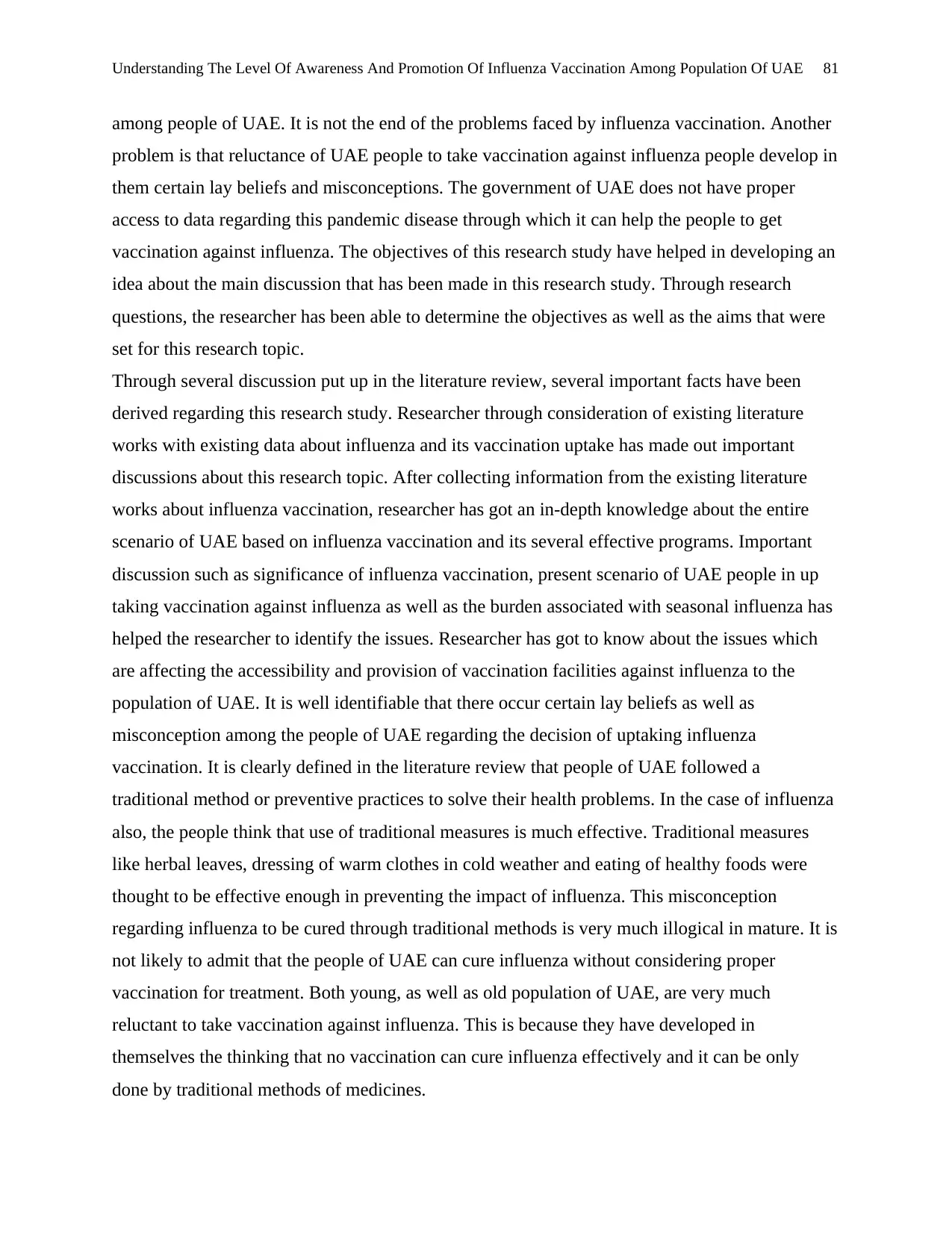
Understanding The Level Of Awareness And Promotion Of Influenza Vaccination Among Population Of UAE 81
among people of UAE. It is not the end of the problems faced by influenza vaccination. Another
problem is that reluctance of UAE people to take vaccination against influenza people develop in
them certain lay beliefs and misconceptions. The government of UAE does not have proper
access to data regarding this pandemic disease through which it can help the people to get
vaccination against influenza. The objectives of this research study have helped in developing an
idea about the main discussion that has been made in this research study. Through research
questions, the researcher has been able to determine the objectives as well as the aims that were
set for this research topic.
Through several discussion put up in the literature review, several important facts have been
derived regarding this research study. Researcher through consideration of existing literature
works with existing data about influenza and its vaccination uptake has made out important
discussions about this research topic. After collecting information from the existing literature
works about influenza vaccination, researcher has got an in-depth knowledge about the entire
scenario of UAE based on influenza vaccination and its several effective programs. Important
discussion such as significance of influenza vaccination, present scenario of UAE people in up
taking vaccination against influenza as well as the burden associated with seasonal influenza has
helped the researcher to identify the issues. Researcher has got to know about the issues which
are affecting the accessibility and provision of vaccination facilities against influenza to the
population of UAE. It is well identifiable that there occur certain lay beliefs as well as
misconception among the people of UAE regarding the decision of uptaking influenza
vaccination. It is clearly defined in the literature review that people of UAE followed a
traditional method or preventive practices to solve their health problems. In the case of influenza
also, the people think that use of traditional measures is much effective. Traditional measures
like herbal leaves, dressing of warm clothes in cold weather and eating of healthy foods were
thought to be effective enough in preventing the impact of influenza. This misconception
regarding influenza to be cured through traditional methods is very much illogical in mature. It is
not likely to admit that the people of UAE can cure influenza without considering proper
vaccination for treatment. Both young, as well as old population of UAE, are very much
reluctant to take vaccination against influenza. This is because they have developed in
themselves the thinking that no vaccination can cure influenza effectively and it can be only
done by traditional methods of medicines.
among people of UAE. It is not the end of the problems faced by influenza vaccination. Another
problem is that reluctance of UAE people to take vaccination against influenza people develop in
them certain lay beliefs and misconceptions. The government of UAE does not have proper
access to data regarding this pandemic disease through which it can help the people to get
vaccination against influenza. The objectives of this research study have helped in developing an
idea about the main discussion that has been made in this research study. Through research
questions, the researcher has been able to determine the objectives as well as the aims that were
set for this research topic.
Through several discussion put up in the literature review, several important facts have been
derived regarding this research study. Researcher through consideration of existing literature
works with existing data about influenza and its vaccination uptake has made out important
discussions about this research topic. After collecting information from the existing literature
works about influenza vaccination, researcher has got an in-depth knowledge about the entire
scenario of UAE based on influenza vaccination and its several effective programs. Important
discussion such as significance of influenza vaccination, present scenario of UAE people in up
taking vaccination against influenza as well as the burden associated with seasonal influenza has
helped the researcher to identify the issues. Researcher has got to know about the issues which
are affecting the accessibility and provision of vaccination facilities against influenza to the
population of UAE. It is well identifiable that there occur certain lay beliefs as well as
misconception among the people of UAE regarding the decision of uptaking influenza
vaccination. It is clearly defined in the literature review that people of UAE followed a
traditional method or preventive practices to solve their health problems. In the case of influenza
also, the people think that use of traditional measures is much effective. Traditional measures
like herbal leaves, dressing of warm clothes in cold weather and eating of healthy foods were
thought to be effective enough in preventing the impact of influenza. This misconception
regarding influenza to be cured through traditional methods is very much illogical in mature. It is
not likely to admit that the people of UAE can cure influenza without considering proper
vaccination for treatment. Both young, as well as old population of UAE, are very much
reluctant to take vaccination against influenza. This is because they have developed in
themselves the thinking that no vaccination can cure influenza effectively and it can be only
done by traditional methods of medicines.
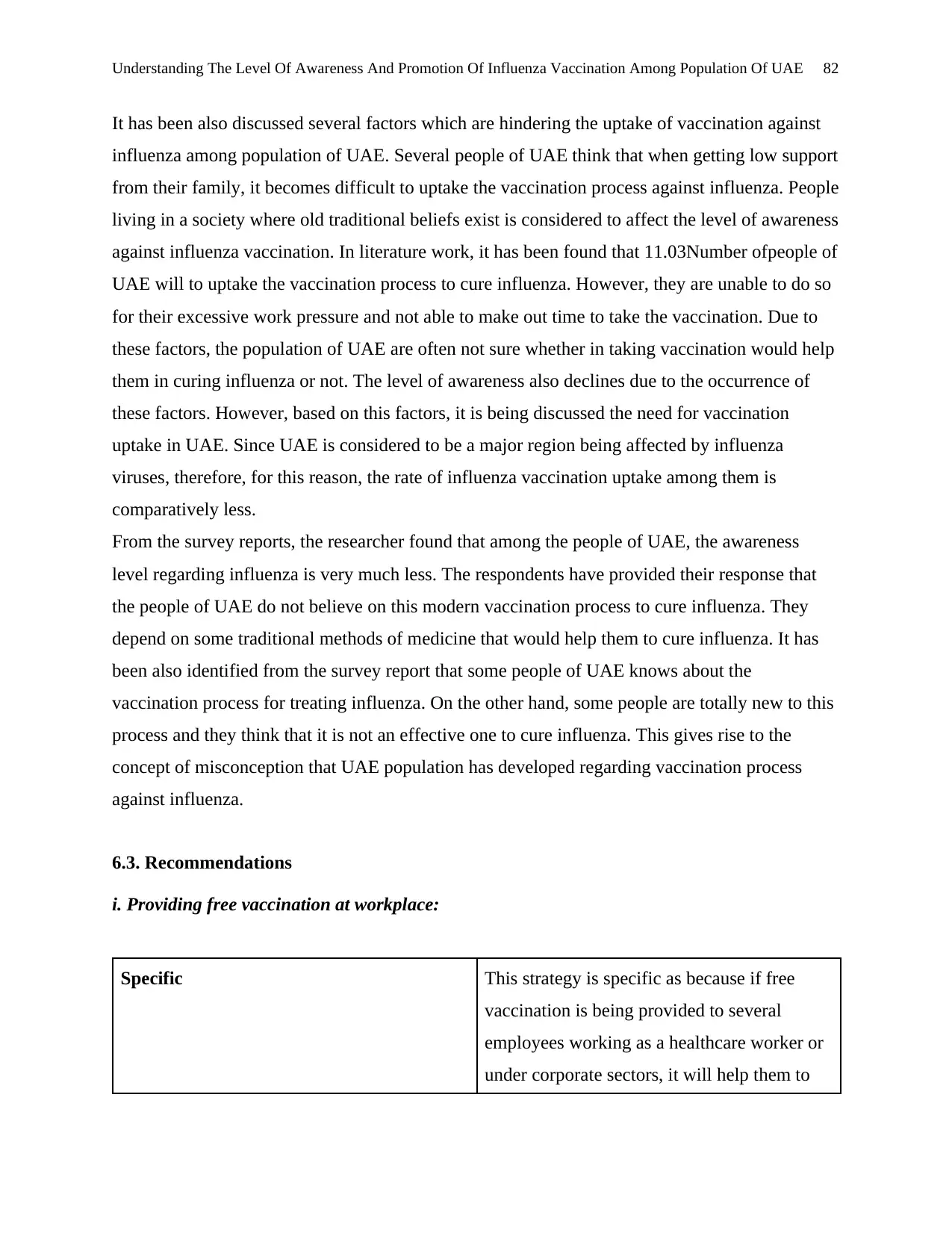
Understanding The Level Of Awareness And Promotion Of Influenza Vaccination Among Population Of UAE 82
It has been also discussed several factors which are hindering the uptake of vaccination against
influenza among population of UAE. Several people of UAE think that when getting low support
from their family, it becomes difficult to uptake the vaccination process against influenza. People
living in a society where old traditional beliefs exist is considered to affect the level of awareness
against influenza vaccination. In literature work, it has been found that 11.03Number ofpeople of
UAE will to uptake the vaccination process to cure influenza. However, they are unable to do so
for their excessive work pressure and not able to make out time to take the vaccination. Due to
these factors, the population of UAE are often not sure whether in taking vaccination would help
them in curing influenza or not. The level of awareness also declines due to the occurrence of
these factors. However, based on this factors, it is being discussed the need for vaccination
uptake in UAE. Since UAE is considered to be a major region being affected by influenza
viruses, therefore, for this reason, the rate of influenza vaccination uptake among them is
comparatively less.
From the survey reports, the researcher found that among the people of UAE, the awareness
level regarding influenza is very much less. The respondents have provided their response that
the people of UAE do not believe on this modern vaccination process to cure influenza. They
depend on some traditional methods of medicine that would help them to cure influenza. It has
been also identified from the survey report that some people of UAE knows about the
vaccination process for treating influenza. On the other hand, some people are totally new to this
process and they think that it is not an effective one to cure influenza. This gives rise to the
concept of misconception that UAE population has developed regarding vaccination process
against influenza.
6.3. Recommendations
i. Providing free vaccination at workplace:
Specific This strategy is specific as because if free
vaccination is being provided to several
employees working as a healthcare worker or
under corporate sectors, it will help them to
It has been also discussed several factors which are hindering the uptake of vaccination against
influenza among population of UAE. Several people of UAE think that when getting low support
from their family, it becomes difficult to uptake the vaccination process against influenza. People
living in a society where old traditional beliefs exist is considered to affect the level of awareness
against influenza vaccination. In literature work, it has been found that 11.03Number ofpeople of
UAE will to uptake the vaccination process to cure influenza. However, they are unable to do so
for their excessive work pressure and not able to make out time to take the vaccination. Due to
these factors, the population of UAE are often not sure whether in taking vaccination would help
them in curing influenza or not. The level of awareness also declines due to the occurrence of
these factors. However, based on this factors, it is being discussed the need for vaccination
uptake in UAE. Since UAE is considered to be a major region being affected by influenza
viruses, therefore, for this reason, the rate of influenza vaccination uptake among them is
comparatively less.
From the survey reports, the researcher found that among the people of UAE, the awareness
level regarding influenza is very much less. The respondents have provided their response that
the people of UAE do not believe on this modern vaccination process to cure influenza. They
depend on some traditional methods of medicine that would help them to cure influenza. It has
been also identified from the survey report that some people of UAE knows about the
vaccination process for treating influenza. On the other hand, some people are totally new to this
process and they think that it is not an effective one to cure influenza. This gives rise to the
concept of misconception that UAE population has developed regarding vaccination process
against influenza.
6.3. Recommendations
i. Providing free vaccination at workplace:
Specific This strategy is specific as because if free
vaccination is being provided to several
employees working as a healthcare worker or
under corporate sectors, it will help them to
Paraphrase This Document
Need a fresh take? Get an instant paraphrase of this document with our AI Paraphraser
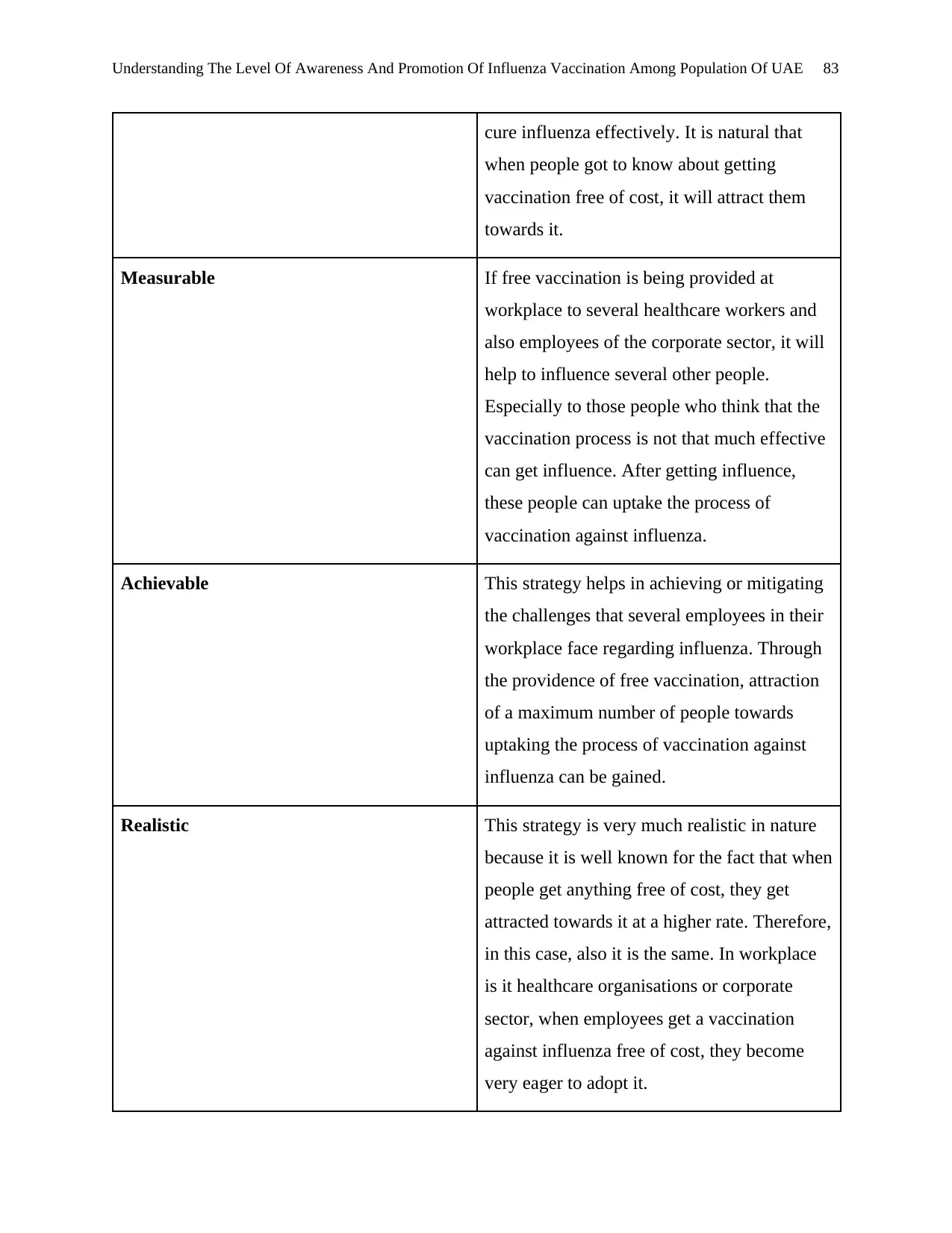
Understanding The Level Of Awareness And Promotion Of Influenza Vaccination Among Population Of UAE 83
cure influenza effectively. It is natural that
when people got to know about getting
vaccination free of cost, it will attract them
towards it.
Measurable If free vaccination is being provided at
workplace to several healthcare workers and
also employees of the corporate sector, it will
help to influence several other people.
Especially to those people who think that the
vaccination process is not that much effective
can get influence. After getting influence,
these people can uptake the process of
vaccination against influenza.
Achievable This strategy helps in achieving or mitigating
the challenges that several employees in their
workplace face regarding influenza. Through
the providence of free vaccination, attraction
of a maximum number of people towards
uptaking the process of vaccination against
influenza can be gained.
Realistic This strategy is very much realistic in nature
because it is well known for the fact that when
people get anything free of cost, they get
attracted towards it at a higher rate. Therefore,
in this case, also it is the same. In workplace
is it healthcare organisations or corporate
sector, when employees get a vaccination
against influenza free of cost, they become
very eager to adopt it.
cure influenza effectively. It is natural that
when people got to know about getting
vaccination free of cost, it will attract them
towards it.
Measurable If free vaccination is being provided at
workplace to several healthcare workers and
also employees of the corporate sector, it will
help to influence several other people.
Especially to those people who think that the
vaccination process is not that much effective
can get influence. After getting influence,
these people can uptake the process of
vaccination against influenza.
Achievable This strategy helps in achieving or mitigating
the challenges that several employees in their
workplace face regarding influenza. Through
the providence of free vaccination, attraction
of a maximum number of people towards
uptaking the process of vaccination against
influenza can be gained.
Realistic This strategy is very much realistic in nature
because it is well known for the fact that when
people get anything free of cost, they get
attracted towards it at a higher rate. Therefore,
in this case, also it is the same. In workplace
is it healthcare organisations or corporate
sector, when employees get a vaccination
against influenza free of cost, they become
very eager to adopt it.
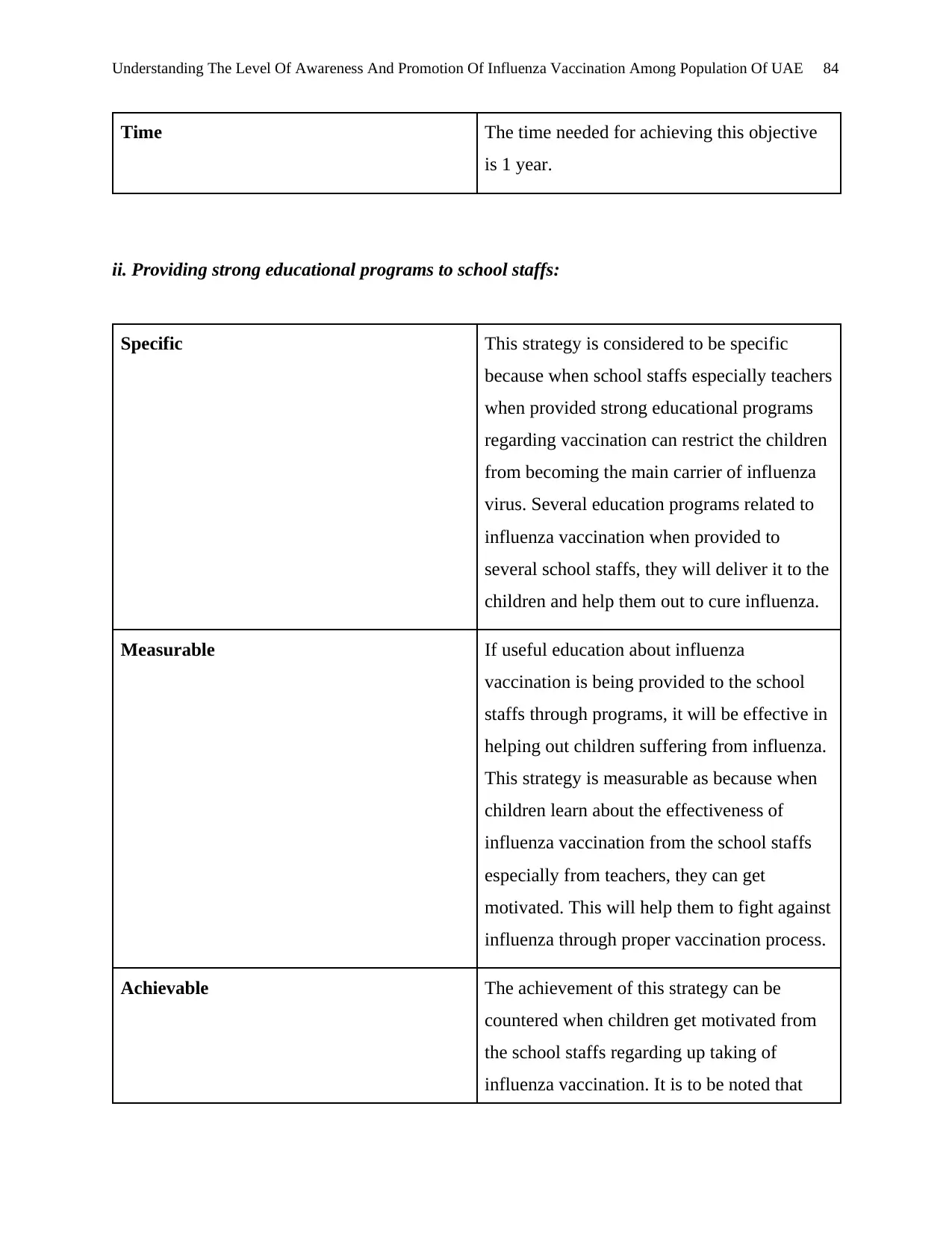
Understanding The Level Of Awareness And Promotion Of Influenza Vaccination Among Population Of UAE 84
Time The time needed for achieving this objective
is 1 year.
ii. Providing strong educational programs to school staffs:
Specific This strategy is considered to be specific
because when school staffs especially teachers
when provided strong educational programs
regarding vaccination can restrict the children
from becoming the main carrier of influenza
virus. Several education programs related to
influenza vaccination when provided to
several school staffs, they will deliver it to the
children and help them out to cure influenza.
Measurable If useful education about influenza
vaccination is being provided to the school
staffs through programs, it will be effective in
helping out children suffering from influenza.
This strategy is measurable as because when
children learn about the effectiveness of
influenza vaccination from the school staffs
especially from teachers, they can get
motivated. This will help them to fight against
influenza through proper vaccination process.
Achievable The achievement of this strategy can be
countered when children get motivated from
the school staffs regarding up taking of
influenza vaccination. It is to be noted that
Time The time needed for achieving this objective
is 1 year.
ii. Providing strong educational programs to school staffs:
Specific This strategy is considered to be specific
because when school staffs especially teachers
when provided strong educational programs
regarding vaccination can restrict the children
from becoming the main carrier of influenza
virus. Several education programs related to
influenza vaccination when provided to
several school staffs, they will deliver it to the
children and help them out to cure influenza.
Measurable If useful education about influenza
vaccination is being provided to the school
staffs through programs, it will be effective in
helping out children suffering from influenza.
This strategy is measurable as because when
children learn about the effectiveness of
influenza vaccination from the school staffs
especially from teachers, they can get
motivated. This will help them to fight against
influenza through proper vaccination process.
Achievable The achievement of this strategy can be
countered when children get motivated from
the school staffs regarding up taking of
influenza vaccination. It is to be noted that
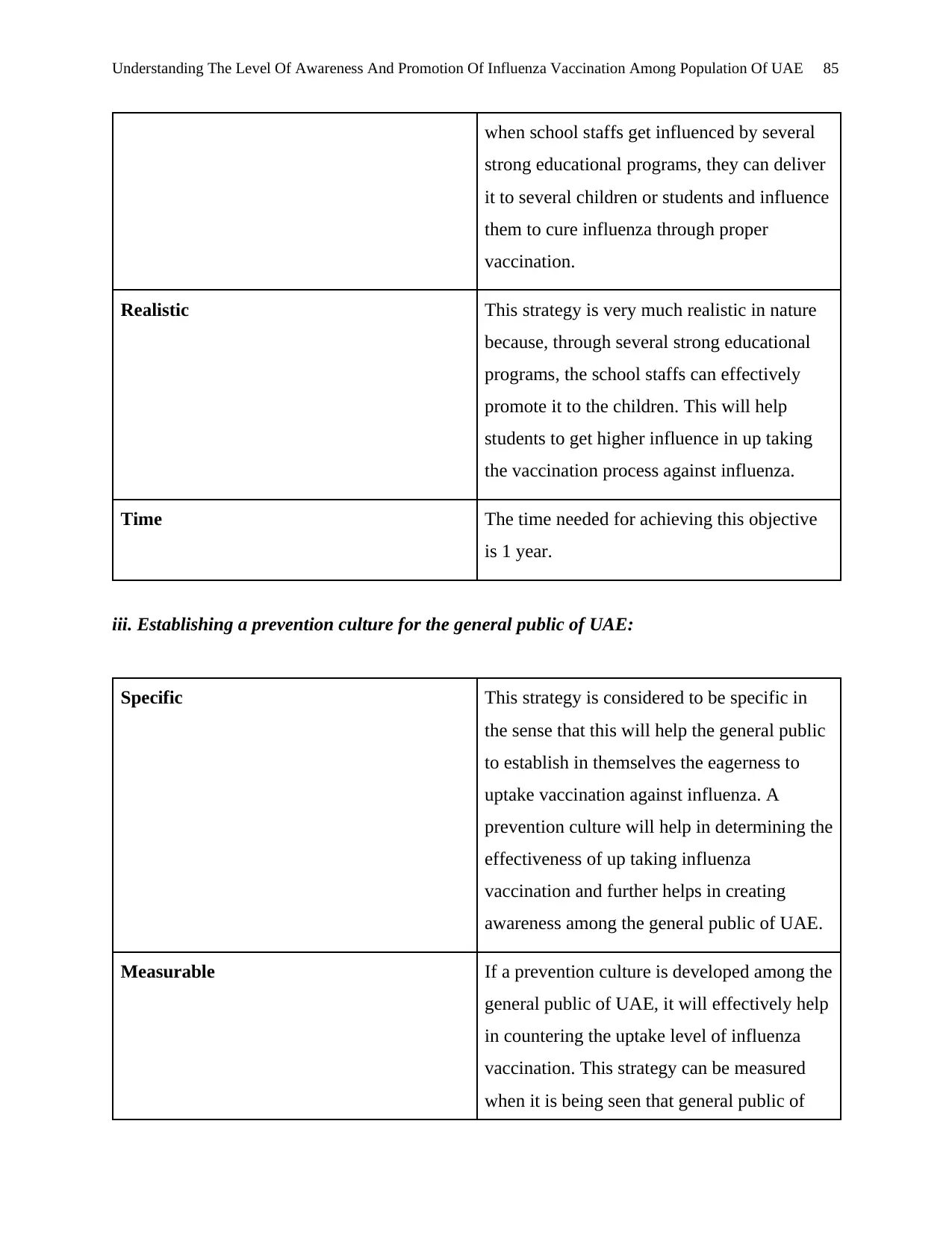
Understanding The Level Of Awareness And Promotion Of Influenza Vaccination Among Population Of UAE 85
when school staffs get influenced by several
strong educational programs, they can deliver
it to several children or students and influence
them to cure influenza through proper
vaccination.
Realistic This strategy is very much realistic in nature
because, through several strong educational
programs, the school staffs can effectively
promote it to the children. This will help
students to get higher influence in up taking
the vaccination process against influenza.
Time The time needed for achieving this objective
is 1 year.
iii. Establishing a prevention culture for the general public of UAE:
Specific This strategy is considered to be specific in
the sense that this will help the general public
to establish in themselves the eagerness to
uptake vaccination against influenza. A
prevention culture will help in determining the
effectiveness of up taking influenza
vaccination and further helps in creating
awareness among the general public of UAE.
Measurable If a prevention culture is developed among the
general public of UAE, it will effectively help
in countering the uptake level of influenza
vaccination. This strategy can be measured
when it is being seen that general public of
when school staffs get influenced by several
strong educational programs, they can deliver
it to several children or students and influence
them to cure influenza through proper
vaccination.
Realistic This strategy is very much realistic in nature
because, through several strong educational
programs, the school staffs can effectively
promote it to the children. This will help
students to get higher influence in up taking
the vaccination process against influenza.
Time The time needed for achieving this objective
is 1 year.
iii. Establishing a prevention culture for the general public of UAE:
Specific This strategy is considered to be specific in
the sense that this will help the general public
to establish in themselves the eagerness to
uptake vaccination against influenza. A
prevention culture will help in determining the
effectiveness of up taking influenza
vaccination and further helps in creating
awareness among the general public of UAE.
Measurable If a prevention culture is developed among the
general public of UAE, it will effectively help
in countering the uptake level of influenza
vaccination. This strategy can be measured
when it is being seen that general public of
Secure Best Marks with AI Grader
Need help grading? Try our AI Grader for instant feedback on your assignments.
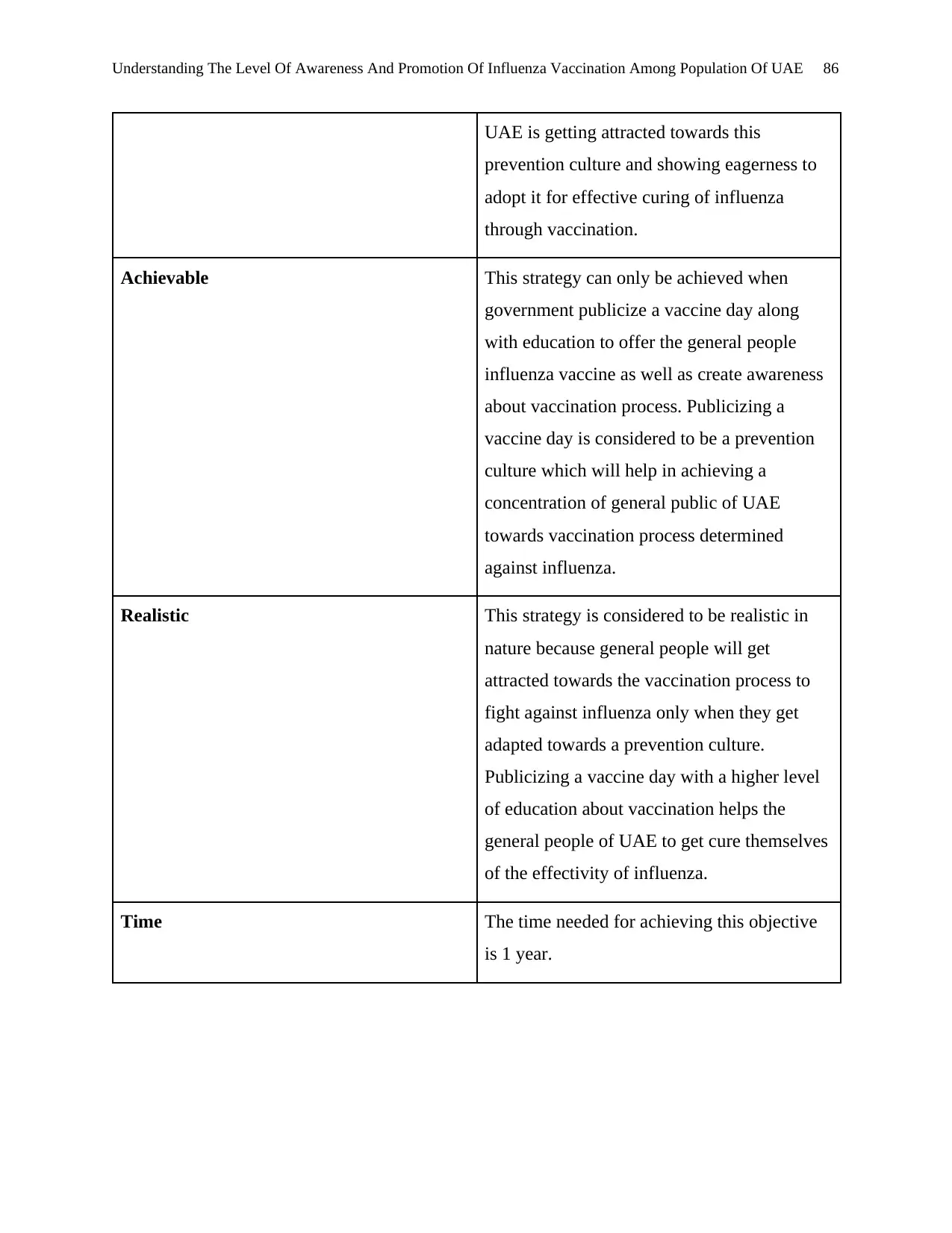
Understanding The Level Of Awareness And Promotion Of Influenza Vaccination Among Population Of UAE 86
UAE is getting attracted towards this
prevention culture and showing eagerness to
adopt it for effective curing of influenza
through vaccination.
Achievable This strategy can only be achieved when
government publicize a vaccine day along
with education to offer the general people
influenza vaccine as well as create awareness
about vaccination process. Publicizing a
vaccine day is considered to be a prevention
culture which will help in achieving a
concentration of general public of UAE
towards vaccination process determined
against influenza.
Realistic This strategy is considered to be realistic in
nature because general people will get
attracted towards the vaccination process to
fight against influenza only when they get
adapted towards a prevention culture.
Publicizing a vaccine day with a higher level
of education about vaccination helps the
general people of UAE to get cure themselves
of the effectivity of influenza.
Time The time needed for achieving this objective
is 1 year.
UAE is getting attracted towards this
prevention culture and showing eagerness to
adopt it for effective curing of influenza
through vaccination.
Achievable This strategy can only be achieved when
government publicize a vaccine day along
with education to offer the general people
influenza vaccine as well as create awareness
about vaccination process. Publicizing a
vaccine day is considered to be a prevention
culture which will help in achieving a
concentration of general public of UAE
towards vaccination process determined
against influenza.
Realistic This strategy is considered to be realistic in
nature because general people will get
attracted towards the vaccination process to
fight against influenza only when they get
adapted towards a prevention culture.
Publicizing a vaccine day with a higher level
of education about vaccination helps the
general people of UAE to get cure themselves
of the effectivity of influenza.
Time The time needed for achieving this objective
is 1 year.
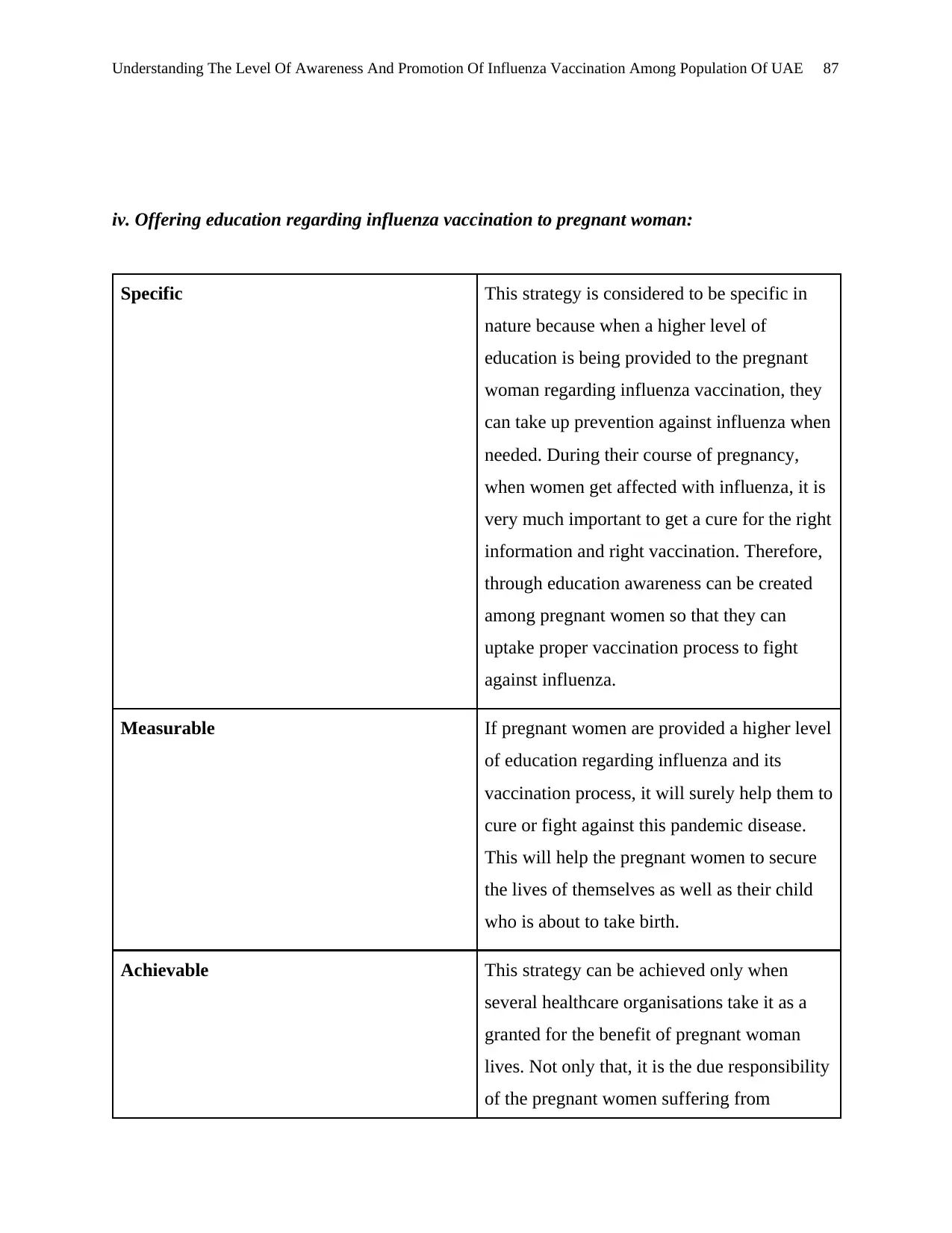
Understanding The Level Of Awareness And Promotion Of Influenza Vaccination Among Population Of UAE 87
iv. Offering education regarding influenza vaccination to pregnant woman:
Specific This strategy is considered to be specific in
nature because when a higher level of
education is being provided to the pregnant
woman regarding influenza vaccination, they
can take up prevention against influenza when
needed. During their course of pregnancy,
when women get affected with influenza, it is
very much important to get a cure for the right
information and right vaccination. Therefore,
through education awareness can be created
among pregnant women so that they can
uptake proper vaccination process to fight
against influenza.
Measurable If pregnant women are provided a higher level
of education regarding influenza and its
vaccination process, it will surely help them to
cure or fight against this pandemic disease.
This will help the pregnant women to secure
the lives of themselves as well as their child
who is about to take birth.
Achievable This strategy can be achieved only when
several healthcare organisations take it as a
granted for the benefit of pregnant woman
lives. Not only that, it is the due responsibility
of the pregnant women suffering from
iv. Offering education regarding influenza vaccination to pregnant woman:
Specific This strategy is considered to be specific in
nature because when a higher level of
education is being provided to the pregnant
woman regarding influenza vaccination, they
can take up prevention against influenza when
needed. During their course of pregnancy,
when women get affected with influenza, it is
very much important to get a cure for the right
information and right vaccination. Therefore,
through education awareness can be created
among pregnant women so that they can
uptake proper vaccination process to fight
against influenza.
Measurable If pregnant women are provided a higher level
of education regarding influenza and its
vaccination process, it will surely help them to
cure or fight against this pandemic disease.
This will help the pregnant women to secure
the lives of themselves as well as their child
who is about to take birth.
Achievable This strategy can be achieved only when
several healthcare organisations take it as a
granted for the benefit of pregnant woman
lives. Not only that, it is the due responsibility
of the pregnant women suffering from
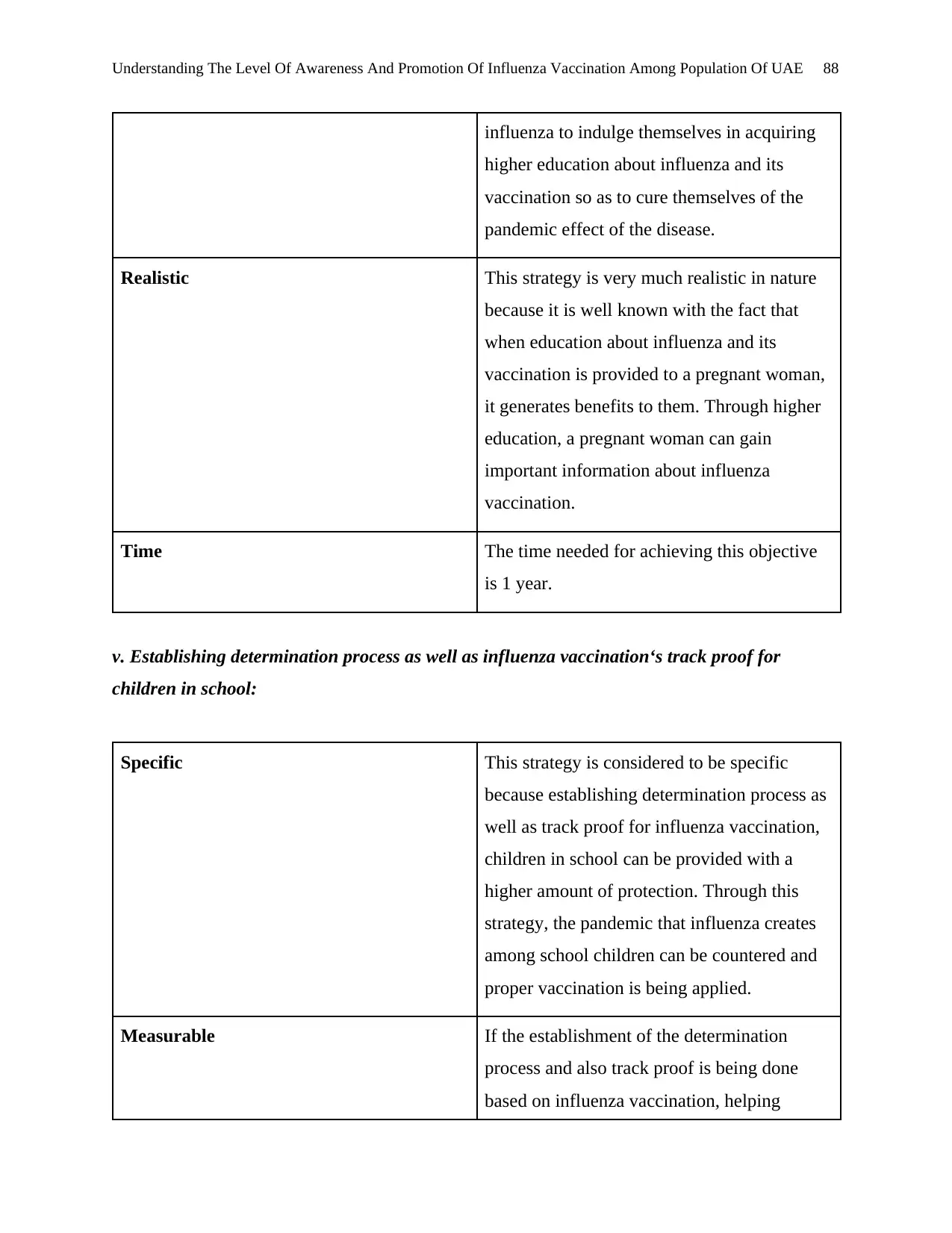
Understanding The Level Of Awareness And Promotion Of Influenza Vaccination Among Population Of UAE 88
influenza to indulge themselves in acquiring
higher education about influenza and its
vaccination so as to cure themselves of the
pandemic effect of the disease.
Realistic This strategy is very much realistic in nature
because it is well known with the fact that
when education about influenza and its
vaccination is provided to a pregnant woman,
it generates benefits to them. Through higher
education, a pregnant woman can gain
important information about influenza
vaccination.
Time The time needed for achieving this objective
is 1 year.
v. Establishing determination process as well as influenza vaccination‘s track proof for
children in school:
Specific This strategy is considered to be specific
because establishing determination process as
well as track proof for influenza vaccination,
children in school can be provided with a
higher amount of protection. Through this
strategy, the pandemic that influenza creates
among school children can be countered and
proper vaccination is being applied.
Measurable If the establishment of the determination
process and also track proof is being done
based on influenza vaccination, helping
influenza to indulge themselves in acquiring
higher education about influenza and its
vaccination so as to cure themselves of the
pandemic effect of the disease.
Realistic This strategy is very much realistic in nature
because it is well known with the fact that
when education about influenza and its
vaccination is provided to a pregnant woman,
it generates benefits to them. Through higher
education, a pregnant woman can gain
important information about influenza
vaccination.
Time The time needed for achieving this objective
is 1 year.
v. Establishing determination process as well as influenza vaccination‘s track proof for
children in school:
Specific This strategy is considered to be specific
because establishing determination process as
well as track proof for influenza vaccination,
children in school can be provided with a
higher amount of protection. Through this
strategy, the pandemic that influenza creates
among school children can be countered and
proper vaccination is being applied.
Measurable If the establishment of the determination
process and also track proof is being done
based on influenza vaccination, helping
Paraphrase This Document
Need a fresh take? Get an instant paraphrase of this document with our AI Paraphraser
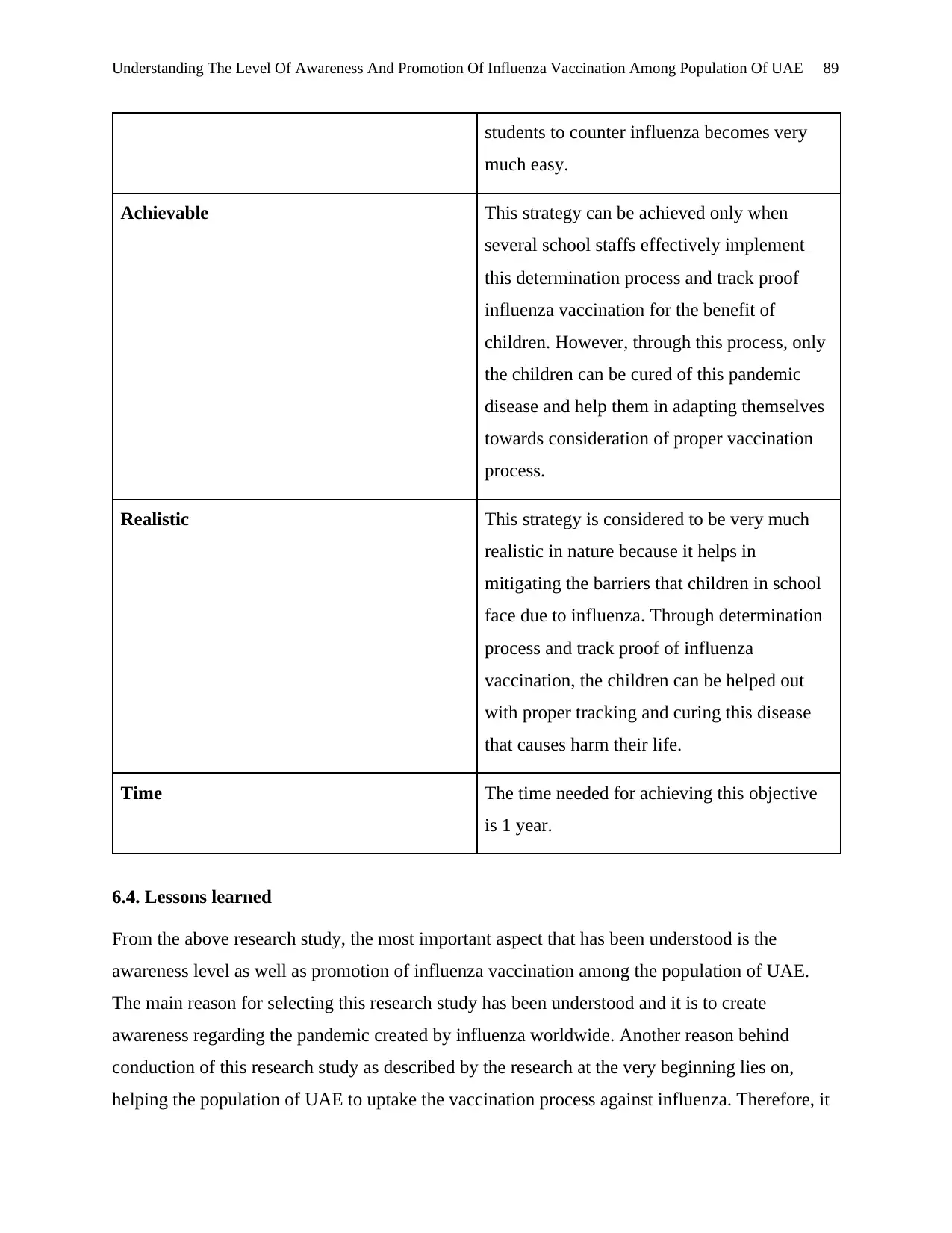
Understanding The Level Of Awareness And Promotion Of Influenza Vaccination Among Population Of UAE 89
students to counter influenza becomes very
much easy.
Achievable This strategy can be achieved only when
several school staffs effectively implement
this determination process and track proof
influenza vaccination for the benefit of
children. However, through this process, only
the children can be cured of this pandemic
disease and help them in adapting themselves
towards consideration of proper vaccination
process.
Realistic This strategy is considered to be very much
realistic in nature because it helps in
mitigating the barriers that children in school
face due to influenza. Through determination
process and track proof of influenza
vaccination, the children can be helped out
with proper tracking and curing this disease
that causes harm their life.
Time The time needed for achieving this objective
is 1 year.
6.4. Lessons learned
From the above research study, the most important aspect that has been understood is the
awareness level as well as promotion of influenza vaccination among the population of UAE.
The main reason for selecting this research study has been understood and it is to create
awareness regarding the pandemic created by influenza worldwide. Another reason behind
conduction of this research study as described by the research at the very beginning lies on,
helping the population of UAE to uptake the vaccination process against influenza. Therefore, it
students to counter influenza becomes very
much easy.
Achievable This strategy can be achieved only when
several school staffs effectively implement
this determination process and track proof
influenza vaccination for the benefit of
children. However, through this process, only
the children can be cured of this pandemic
disease and help them in adapting themselves
towards consideration of proper vaccination
process.
Realistic This strategy is considered to be very much
realistic in nature because it helps in
mitigating the barriers that children in school
face due to influenza. Through determination
process and track proof of influenza
vaccination, the children can be helped out
with proper tracking and curing this disease
that causes harm their life.
Time The time needed for achieving this objective
is 1 year.
6.4. Lessons learned
From the above research study, the most important aspect that has been understood is the
awareness level as well as promotion of influenza vaccination among the population of UAE.
The main reason for selecting this research study has been understood and it is to create
awareness regarding the pandemic created by influenza worldwide. Another reason behind
conduction of this research study as described by the research at the very beginning lies on,
helping the population of UAE to uptake the vaccination process against influenza. Therefore, it
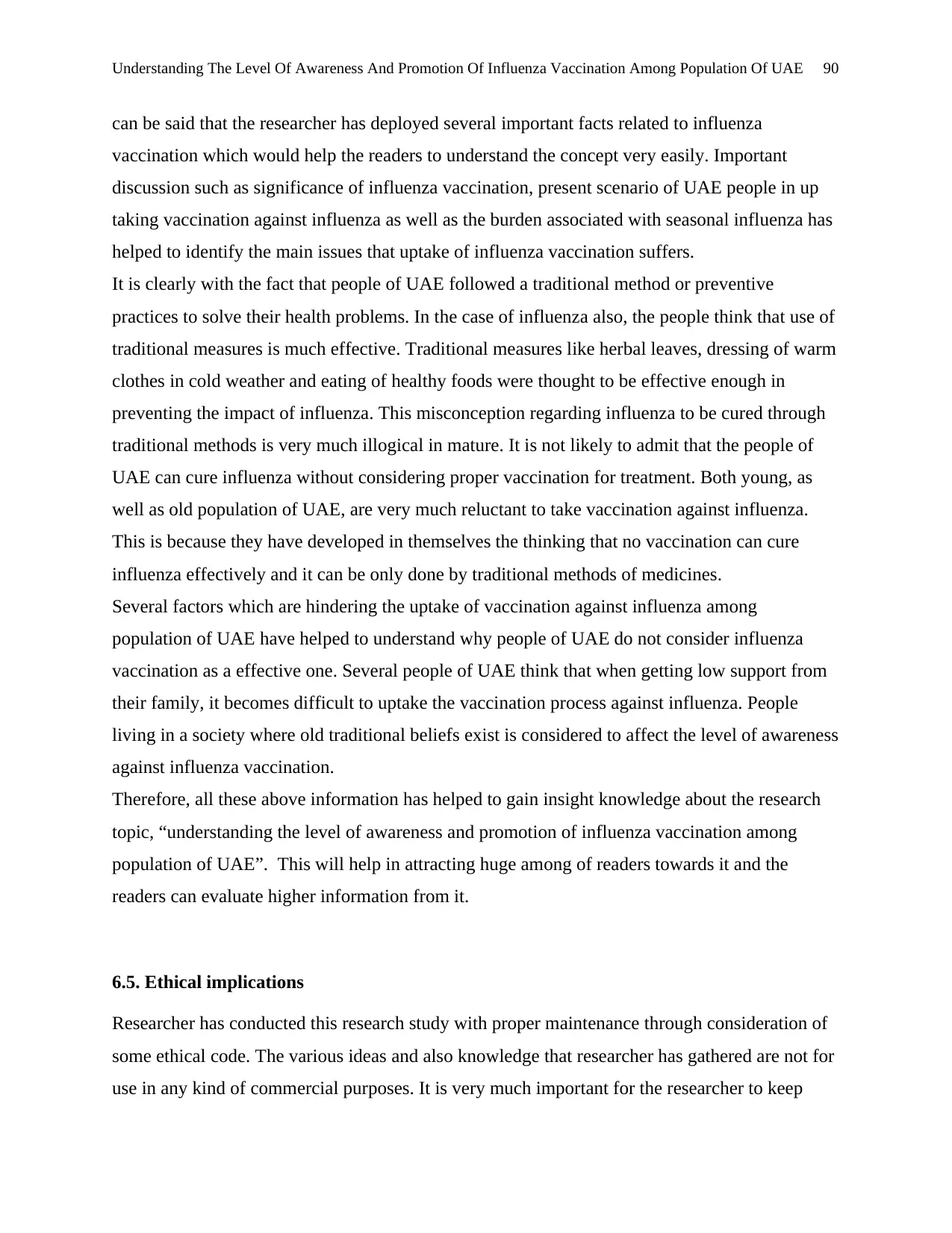
Understanding The Level Of Awareness And Promotion Of Influenza Vaccination Among Population Of UAE 90
can be said that the researcher has deployed several important facts related to influenza
vaccination which would help the readers to understand the concept very easily. Important
discussion such as significance of influenza vaccination, present scenario of UAE people in up
taking vaccination against influenza as well as the burden associated with seasonal influenza has
helped to identify the main issues that uptake of influenza vaccination suffers.
It is clearly with the fact that people of UAE followed a traditional method or preventive
practices to solve their health problems. In the case of influenza also, the people think that use of
traditional measures is much effective. Traditional measures like herbal leaves, dressing of warm
clothes in cold weather and eating of healthy foods were thought to be effective enough in
preventing the impact of influenza. This misconception regarding influenza to be cured through
traditional methods is very much illogical in mature. It is not likely to admit that the people of
UAE can cure influenza without considering proper vaccination for treatment. Both young, as
well as old population of UAE, are very much reluctant to take vaccination against influenza.
This is because they have developed in themselves the thinking that no vaccination can cure
influenza effectively and it can be only done by traditional methods of medicines.
Several factors which are hindering the uptake of vaccination against influenza among
population of UAE have helped to understand why people of UAE do not consider influenza
vaccination as a effective one. Several people of UAE think that when getting low support from
their family, it becomes difficult to uptake the vaccination process against influenza. People
living in a society where old traditional beliefs exist is considered to affect the level of awareness
against influenza vaccination.
Therefore, all these above information has helped to gain insight knowledge about the research
topic, “understanding the level of awareness and promotion of influenza vaccination among
population of UAE”. This will help in attracting huge among of readers towards it and the
readers can evaluate higher information from it.
6.5. Ethical implications
Researcher has conducted this research study with proper maintenance through consideration of
some ethical code. The various ideas and also knowledge that researcher has gathered are not for
use in any kind of commercial purposes. It is very much important for the researcher to keep
can be said that the researcher has deployed several important facts related to influenza
vaccination which would help the readers to understand the concept very easily. Important
discussion such as significance of influenza vaccination, present scenario of UAE people in up
taking vaccination against influenza as well as the burden associated with seasonal influenza has
helped to identify the main issues that uptake of influenza vaccination suffers.
It is clearly with the fact that people of UAE followed a traditional method or preventive
practices to solve their health problems. In the case of influenza also, the people think that use of
traditional measures is much effective. Traditional measures like herbal leaves, dressing of warm
clothes in cold weather and eating of healthy foods were thought to be effective enough in
preventing the impact of influenza. This misconception regarding influenza to be cured through
traditional methods is very much illogical in mature. It is not likely to admit that the people of
UAE can cure influenza without considering proper vaccination for treatment. Both young, as
well as old population of UAE, are very much reluctant to take vaccination against influenza.
This is because they have developed in themselves the thinking that no vaccination can cure
influenza effectively and it can be only done by traditional methods of medicines.
Several factors which are hindering the uptake of vaccination against influenza among
population of UAE have helped to understand why people of UAE do not consider influenza
vaccination as a effective one. Several people of UAE think that when getting low support from
their family, it becomes difficult to uptake the vaccination process against influenza. People
living in a society where old traditional beliefs exist is considered to affect the level of awareness
against influenza vaccination.
Therefore, all these above information has helped to gain insight knowledge about the research
topic, “understanding the level of awareness and promotion of influenza vaccination among
population of UAE”. This will help in attracting huge among of readers towards it and the
readers can evaluate higher information from it.
6.5. Ethical implications
Researcher has conducted this research study with proper maintenance through consideration of
some ethical code. The various ideas and also knowledge that researcher has gathered are not for
use in any kind of commercial purposes. It is very much important for the researcher to keep

Understanding The Level Of Awareness And Promotion Of Influenza Vaccination Among Population Of UAE 91
privacy in a higher amount of the data or information gathered from the respondents. Data
collected from health care workers of UAE, pregnant woman of this country, the general public
as well as several UAE schools is to be kept with a high amount of privacy. Researcher should
be aware that the data collected should not get disclosed. It is the duty of all the respondents that
researcher has considered for gathering information based on the research topic to participate
voluntarily. Active participation of the respondents is considered to be effective for the
researcher to collect information with ease and without any kind of nuisance. It is also important
from the researcher’s side that the researcher should take permission of the respondents while
collecting information from them. There might be several respondents who might not be eager to
provide information to the researcher if asked directly to them. However, taking permission from
them and their willingness towards this research helps researcher to gather appropriate and
relevant information about influenza vaccination acceptance by the UAE people.
privacy in a higher amount of the data or information gathered from the respondents. Data
collected from health care workers of UAE, pregnant woman of this country, the general public
as well as several UAE schools is to be kept with a high amount of privacy. Researcher should
be aware that the data collected should not get disclosed. It is the duty of all the respondents that
researcher has considered for gathering information based on the research topic to participate
voluntarily. Active participation of the respondents is considered to be effective for the
researcher to collect information with ease and without any kind of nuisance. It is also important
from the researcher’s side that the researcher should take permission of the respondents while
collecting information from them. There might be several respondents who might not be eager to
provide information to the researcher if asked directly to them. However, taking permission from
them and their willingness towards this research helps researcher to gather appropriate and
relevant information about influenza vaccination acceptance by the UAE people.
Secure Best Marks with AI Grader
Need help grading? Try our AI Grader for instant feedback on your assignments.
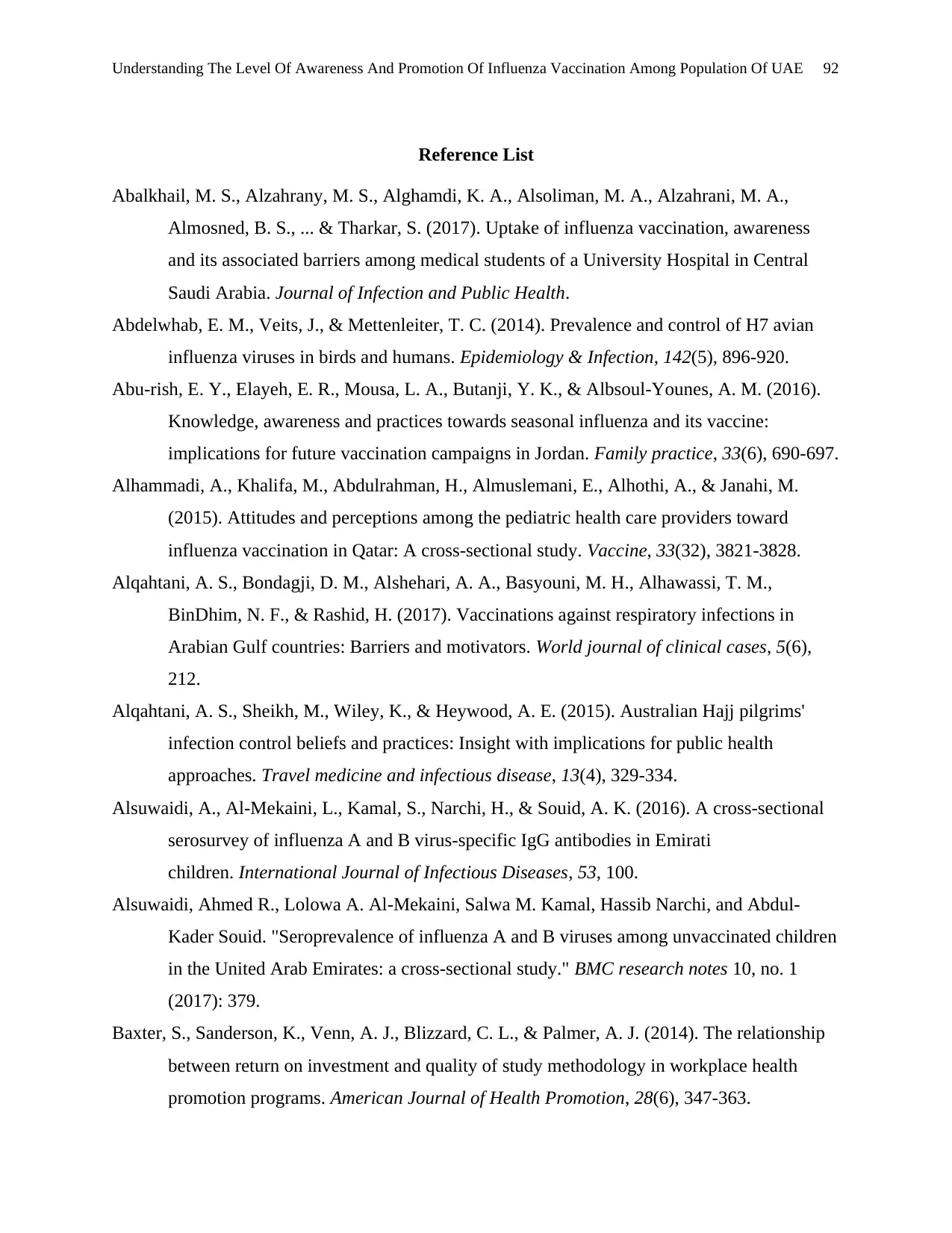
Understanding The Level Of Awareness And Promotion Of Influenza Vaccination Among Population Of UAE 92
Reference List
Abalkhail, M. S., Alzahrany, M. S., Alghamdi, K. A., Alsoliman, M. A., Alzahrani, M. A.,
Almosned, B. S., ... & Tharkar, S. (2017). Uptake of influenza vaccination, awareness
and its associated barriers among medical students of a University Hospital in Central
Saudi Arabia. Journal of Infection and Public Health.
Abdelwhab, E. M., Veits, J., & Mettenleiter, T. C. (2014). Prevalence and control of H7 avian
influenza viruses in birds and humans. Epidemiology & Infection, 142(5), 896-920.
Abu-rish, E. Y., Elayeh, E. R., Mousa, L. A., Butanji, Y. K., & Albsoul-Younes, A. M. (2016).
Knowledge, awareness and practices towards seasonal influenza and its vaccine:
implications for future vaccination campaigns in Jordan. Family practice, 33(6), 690-697.
Alhammadi, A., Khalifa, M., Abdulrahman, H., Almuslemani, E., Alhothi, A., & Janahi, M.
(2015). Attitudes and perceptions among the pediatric health care providers toward
influenza vaccination in Qatar: A cross-sectional study. Vaccine, 33(32), 3821-3828.
Alqahtani, A. S., Bondagji, D. M., Alshehari, A. A., Basyouni, M. H., Alhawassi, T. M.,
BinDhim, N. F., & Rashid, H. (2017). Vaccinations against respiratory infections in
Arabian Gulf countries: Barriers and motivators. World journal of clinical cases, 5(6),
212.
Alqahtani, A. S., Sheikh, M., Wiley, K., & Heywood, A. E. (2015). Australian Hajj pilgrims'
infection control beliefs and practices: Insight with implications for public health
approaches. Travel medicine and infectious disease, 13(4), 329-334.
Alsuwaidi, A., Al-Mekaini, L., Kamal, S., Narchi, H., & Souid, A. K. (2016). A cross-sectional
serosurvey of influenza A and B virus-specific IgG antibodies in Emirati
children. International Journal of Infectious Diseases, 53, 100.
Alsuwaidi, Ahmed R., Lolowa A. Al-Mekaini, Salwa M. Kamal, Hassib Narchi, and Abdul-
Kader Souid. "Seroprevalence of influenza A and B viruses among unvaccinated children
in the United Arab Emirates: a cross-sectional study." BMC research notes 10, no. 1
(2017): 379.
Baxter, S., Sanderson, K., Venn, A. J., Blizzard, C. L., & Palmer, A. J. (2014). The relationship
between return on investment and quality of study methodology in workplace health
promotion programs. American Journal of Health Promotion, 28(6), 347-363.
Reference List
Abalkhail, M. S., Alzahrany, M. S., Alghamdi, K. A., Alsoliman, M. A., Alzahrani, M. A.,
Almosned, B. S., ... & Tharkar, S. (2017). Uptake of influenza vaccination, awareness
and its associated barriers among medical students of a University Hospital in Central
Saudi Arabia. Journal of Infection and Public Health.
Abdelwhab, E. M., Veits, J., & Mettenleiter, T. C. (2014). Prevalence and control of H7 avian
influenza viruses in birds and humans. Epidemiology & Infection, 142(5), 896-920.
Abu-rish, E. Y., Elayeh, E. R., Mousa, L. A., Butanji, Y. K., & Albsoul-Younes, A. M. (2016).
Knowledge, awareness and practices towards seasonal influenza and its vaccine:
implications for future vaccination campaigns in Jordan. Family practice, 33(6), 690-697.
Alhammadi, A., Khalifa, M., Abdulrahman, H., Almuslemani, E., Alhothi, A., & Janahi, M.
(2015). Attitudes and perceptions among the pediatric health care providers toward
influenza vaccination in Qatar: A cross-sectional study. Vaccine, 33(32), 3821-3828.
Alqahtani, A. S., Bondagji, D. M., Alshehari, A. A., Basyouni, M. H., Alhawassi, T. M.,
BinDhim, N. F., & Rashid, H. (2017). Vaccinations against respiratory infections in
Arabian Gulf countries: Barriers and motivators. World journal of clinical cases, 5(6),
212.
Alqahtani, A. S., Sheikh, M., Wiley, K., & Heywood, A. E. (2015). Australian Hajj pilgrims'
infection control beliefs and practices: Insight with implications for public health
approaches. Travel medicine and infectious disease, 13(4), 329-334.
Alsuwaidi, A., Al-Mekaini, L., Kamal, S., Narchi, H., & Souid, A. K. (2016). A cross-sectional
serosurvey of influenza A and B virus-specific IgG antibodies in Emirati
children. International Journal of Infectious Diseases, 53, 100.
Alsuwaidi, Ahmed R., Lolowa A. Al-Mekaini, Salwa M. Kamal, Hassib Narchi, and Abdul-
Kader Souid. "Seroprevalence of influenza A and B viruses among unvaccinated children
in the United Arab Emirates: a cross-sectional study." BMC research notes 10, no. 1
(2017): 379.
Baxter, S., Sanderson, K., Venn, A. J., Blizzard, C. L., & Palmer, A. J. (2014). The relationship
between return on investment and quality of study methodology in workplace health
promotion programs. American Journal of Health Promotion, 28(6), 347-363.
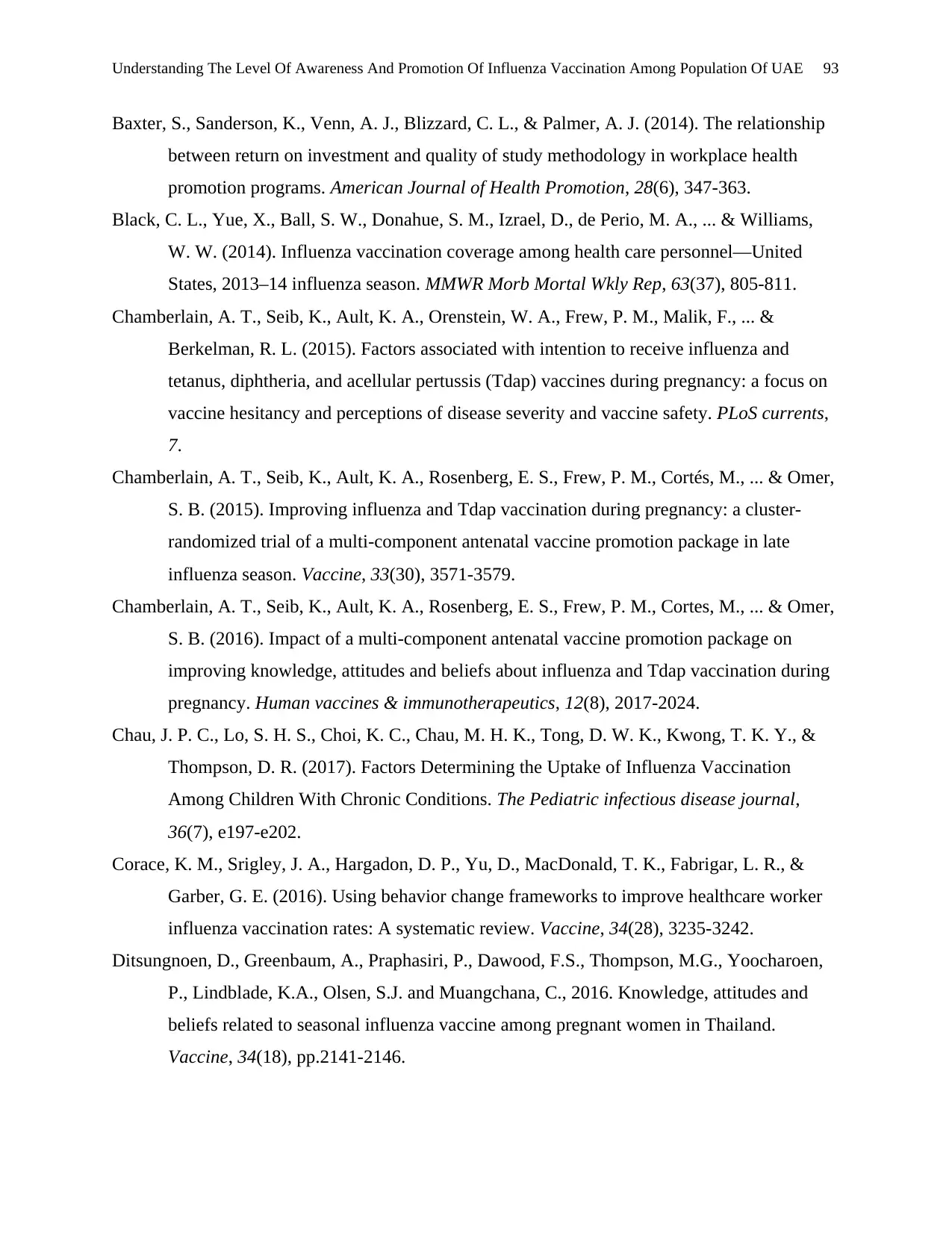
Understanding The Level Of Awareness And Promotion Of Influenza Vaccination Among Population Of UAE 93
Baxter, S., Sanderson, K., Venn, A. J., Blizzard, C. L., & Palmer, A. J. (2014). The relationship
between return on investment and quality of study methodology in workplace health
promotion programs. American Journal of Health Promotion, 28(6), 347-363.
Black, C. L., Yue, X., Ball, S. W., Donahue, S. M., Izrael, D., de Perio, M. A., ... & Williams,
W. W. (2014). Influenza vaccination coverage among health care personnel—United
States, 2013–14 influenza season. MMWR Morb Mortal Wkly Rep, 63(37), 805-811.
Chamberlain, A. T., Seib, K., Ault, K. A., Orenstein, W. A., Frew, P. M., Malik, F., ... &
Berkelman, R. L. (2015). Factors associated with intention to receive influenza and
tetanus, diphtheria, and acellular pertussis (Tdap) vaccines during pregnancy: a focus on
vaccine hesitancy and perceptions of disease severity and vaccine safety. PLoS currents,
7.
Chamberlain, A. T., Seib, K., Ault, K. A., Rosenberg, E. S., Frew, P. M., Cortés, M., ... & Omer,
S. B. (2015). Improving influenza and Tdap vaccination during pregnancy: a cluster-
randomized trial of a multi-component antenatal vaccine promotion package in late
influenza season. Vaccine, 33(30), 3571-3579.
Chamberlain, A. T., Seib, K., Ault, K. A., Rosenberg, E. S., Frew, P. M., Cortes, M., ... & Omer,
S. B. (2016). Impact of a multi-component antenatal vaccine promotion package on
improving knowledge, attitudes and beliefs about influenza and Tdap vaccination during
pregnancy. Human vaccines & immunotherapeutics, 12(8), 2017-2024.
Chau, J. P. C., Lo, S. H. S., Choi, K. C., Chau, M. H. K., Tong, D. W. K., Kwong, T. K. Y., &
Thompson, D. R. (2017). Factors Determining the Uptake of Influenza Vaccination
Among Children With Chronic Conditions. The Pediatric infectious disease journal,
36(7), e197-e202.
Corace, K. M., Srigley, J. A., Hargadon, D. P., Yu, D., MacDonald, T. K., Fabrigar, L. R., &
Garber, G. E. (2016). Using behavior change frameworks to improve healthcare worker
influenza vaccination rates: A systematic review. Vaccine, 34(28), 3235-3242.
Ditsungnoen, D., Greenbaum, A., Praphasiri, P., Dawood, F.S., Thompson, M.G., Yoocharoen,
P., Lindblade, K.A., Olsen, S.J. and Muangchana, C., 2016. Knowledge, attitudes and
beliefs related to seasonal influenza vaccine among pregnant women in Thailand.
Vaccine, 34(18), pp.2141-2146.
Baxter, S., Sanderson, K., Venn, A. J., Blizzard, C. L., & Palmer, A. J. (2014). The relationship
between return on investment and quality of study methodology in workplace health
promotion programs. American Journal of Health Promotion, 28(6), 347-363.
Black, C. L., Yue, X., Ball, S. W., Donahue, S. M., Izrael, D., de Perio, M. A., ... & Williams,
W. W. (2014). Influenza vaccination coverage among health care personnel—United
States, 2013–14 influenza season. MMWR Morb Mortal Wkly Rep, 63(37), 805-811.
Chamberlain, A. T., Seib, K., Ault, K. A., Orenstein, W. A., Frew, P. M., Malik, F., ... &
Berkelman, R. L. (2015). Factors associated with intention to receive influenza and
tetanus, diphtheria, and acellular pertussis (Tdap) vaccines during pregnancy: a focus on
vaccine hesitancy and perceptions of disease severity and vaccine safety. PLoS currents,
7.
Chamberlain, A. T., Seib, K., Ault, K. A., Rosenberg, E. S., Frew, P. M., Cortés, M., ... & Omer,
S. B. (2015). Improving influenza and Tdap vaccination during pregnancy: a cluster-
randomized trial of a multi-component antenatal vaccine promotion package in late
influenza season. Vaccine, 33(30), 3571-3579.
Chamberlain, A. T., Seib, K., Ault, K. A., Rosenberg, E. S., Frew, P. M., Cortes, M., ... & Omer,
S. B. (2016). Impact of a multi-component antenatal vaccine promotion package on
improving knowledge, attitudes and beliefs about influenza and Tdap vaccination during
pregnancy. Human vaccines & immunotherapeutics, 12(8), 2017-2024.
Chau, J. P. C., Lo, S. H. S., Choi, K. C., Chau, M. H. K., Tong, D. W. K., Kwong, T. K. Y., &
Thompson, D. R. (2017). Factors Determining the Uptake of Influenza Vaccination
Among Children With Chronic Conditions. The Pediatric infectious disease journal,
36(7), e197-e202.
Corace, K. M., Srigley, J. A., Hargadon, D. P., Yu, D., MacDonald, T. K., Fabrigar, L. R., &
Garber, G. E. (2016). Using behavior change frameworks to improve healthcare worker
influenza vaccination rates: A systematic review. Vaccine, 34(28), 3235-3242.
Ditsungnoen, D., Greenbaum, A., Praphasiri, P., Dawood, F.S., Thompson, M.G., Yoocharoen,
P., Lindblade, K.A., Olsen, S.J. and Muangchana, C., 2016. Knowledge, attitudes and
beliefs related to seasonal influenza vaccine among pregnant women in Thailand.
Vaccine, 34(18), pp.2141-2146.

Understanding The Level Of Awareness And Promotion Of Influenza Vaccination Among Population Of UAE 94
Dixon, B. E., Kasting, M. L., Wilson, S., Kulkarni, A., Zimet, G. D., & Downs, S. M. (2017).
Health care providers’ perceptions of use and influence of clinical decision support
reminders: qualitative study following a randomized trial to improve HPV vaccination
rates. BMC medical informatics and decision making, 17(1), 119.
Doris, S. F., Low, L. P., Lee, I. F., Lee, D. T., & Ng, W. M. (2014). Predicting influenza
vaccination intent among at-risk Chinese older adults in Hong Kong. Nursing research,
63(4), 270-277.
Ducatez, M. F., Becker, J., Freudenstein, A., Delverdier, M., Delpont, M., Sutter, G., ... & Volz,
A. (2016). Low pathogenic avian influenza (H9N2) in chicken: Evaluation of an ancestral
H9-MVA vaccine. Veterinary microbiology, 189, 59-67.
Elawad, K. H., Farag, E. A., Abuelgasim, D. A., Smatti, M. K., Al-Romaihi, H. E., Al Thani, M.,
... & Yassine, H. M. (2017). Improving Influenza Vaccination Rate among Primary
Healthcare Workers in Qatar. Vaccines, 5(4), 36.
Fabiani, M., Riccardo, F., Di Napoli, A., Gargiulo, L., Declich, S., & Petrelli, A. (2016).
Differences in Influenza Vaccination Coverage between Adult Immigrants and Italian
Citizens at Risk for Influenza-Related Complications: A Cross-Sectional Study. PloS one,
11(11), e0166517.
Groom, H. C., Zhang, F., Fisher, A. K., & Wortley, P. M. (2014). Differences in adult influenza
vaccine-seeking behavior: the roles of race and attitudes. Journal of Public Health
Management and Practice, 20(2), 246-250.
Haq, K., & McElhaney, J. E. (2014). Immunosenescence: influenza vaccination and the elderly.
Current opinion in immunology, 29, 38-42.
Haridi, H. K., Salman, K. A., Basaif, E. A., & Al-Skaibi, D. K. (2017). Influenza vaccine
uptake, determinants, motivators, and barriers of the vaccine receipt among healthcare
workers in a tertiary care hospital in Saudi Arabia. Journal of Hospital Infection.
Hickey, J.E., Gagnon, A.J. and Jitthai, N., 2014. Knowledge about pandemic influenza
preparedness among vulnerable migrants in Thailand. Health promotion international,
31(1), pp.124-132.
Jennings, L.C., 2013. Influenza vaccines: an Asia–Pacific perspective. Influenza and other
respiratory viruses, 7(s3), pp.44-51.
Dixon, B. E., Kasting, M. L., Wilson, S., Kulkarni, A., Zimet, G. D., & Downs, S. M. (2017).
Health care providers’ perceptions of use and influence of clinical decision support
reminders: qualitative study following a randomized trial to improve HPV vaccination
rates. BMC medical informatics and decision making, 17(1), 119.
Doris, S. F., Low, L. P., Lee, I. F., Lee, D. T., & Ng, W. M. (2014). Predicting influenza
vaccination intent among at-risk Chinese older adults in Hong Kong. Nursing research,
63(4), 270-277.
Ducatez, M. F., Becker, J., Freudenstein, A., Delverdier, M., Delpont, M., Sutter, G., ... & Volz,
A. (2016). Low pathogenic avian influenza (H9N2) in chicken: Evaluation of an ancestral
H9-MVA vaccine. Veterinary microbiology, 189, 59-67.
Elawad, K. H., Farag, E. A., Abuelgasim, D. A., Smatti, M. K., Al-Romaihi, H. E., Al Thani, M.,
... & Yassine, H. M. (2017). Improving Influenza Vaccination Rate among Primary
Healthcare Workers in Qatar. Vaccines, 5(4), 36.
Fabiani, M., Riccardo, F., Di Napoli, A., Gargiulo, L., Declich, S., & Petrelli, A. (2016).
Differences in Influenza Vaccination Coverage between Adult Immigrants and Italian
Citizens at Risk for Influenza-Related Complications: A Cross-Sectional Study. PloS one,
11(11), e0166517.
Groom, H. C., Zhang, F., Fisher, A. K., & Wortley, P. M. (2014). Differences in adult influenza
vaccine-seeking behavior: the roles of race and attitudes. Journal of Public Health
Management and Practice, 20(2), 246-250.
Haq, K., & McElhaney, J. E. (2014). Immunosenescence: influenza vaccination and the elderly.
Current opinion in immunology, 29, 38-42.
Haridi, H. K., Salman, K. A., Basaif, E. A., & Al-Skaibi, D. K. (2017). Influenza vaccine
uptake, determinants, motivators, and barriers of the vaccine receipt among healthcare
workers in a tertiary care hospital in Saudi Arabia. Journal of Hospital Infection.
Hickey, J.E., Gagnon, A.J. and Jitthai, N., 2014. Knowledge about pandemic influenza
preparedness among vulnerable migrants in Thailand. Health promotion international,
31(1), pp.124-132.
Jennings, L.C., 2013. Influenza vaccines: an Asia–Pacific perspective. Influenza and other
respiratory viruses, 7(s3), pp.44-51.
Paraphrase This Document
Need a fresh take? Get an instant paraphrase of this document with our AI Paraphraser

Understanding The Level Of Awareness And Promotion Of Influenza Vaccination Among Population Of UAE 95
Jennings, L.C., Smith, D.W. and Chan, P.K., 2013. Report of the first Asia‐Pacific influenza
summit, Asia‐Pacific Alliance for the Control of Influenza (APACI), Bangkok, 12–13
June 2012. Influenza and other respiratory viruses, 7(6), pp.991-995.
Knudsen, N. P. H., Olsen, A., Buonsanti, C., Follmann, F., Zhang, Y., Coler, R. N., ... &
Billeskov, R. (2016). Different human vaccine adjuvants promote distinct antigen-
independent immunological signatures tailored to different pathogens. Scientific reports,
6, 19570.
Leewongtrakul, T., Kunpalin, Y., Ingviya, T. and Chaithongwongwatthana, S., 2017. Acceptance
of Influenza Vaccination among Pregnant Women attending the Antenatal Care Clinic at
King Chulalongkorn Memorial Hospital. Thai Journal of Obstetrics and Gynaecology,
26(2).
Lehmann, B. A., Chapman, G. B., Franssen, F. M., Kok, G., & Ruiter, R. A. (2016). Changing
the default to promote influenza vaccination among health care workers. Vaccine, 34(11),
1389-1392.
Lim, D. W., Lee, L. T., Kyaw, W. M., & Chow, A. (2017). Psychosocial determinants of
influenza vaccination intention: A cross-sectional study on inpatient nurses in Singapore.
American Journal of Infection Control.
Lim, Y. C., & Seale, H. (2014). Examining the views of key stakeholders regarding the provision
of occupational influenza vaccination for healthcare workers in Australia. Vaccine, 32(5),
606-610.
Loulergue, P., & Launay, O. (2014). Vaccinations among medical and nursing students:
coverage and opportunities. Vaccine, 32(38), 4855-4859.
Lv, M., Fang, R., Wu, J., Pang, X., Deng, Y., Lei, T., & Xie, Z. (2016). The free vaccination
policy of influenza in Beijing, China: The vaccine coverage and its associated factors.
Vaccine, 34(18), 2135-2140.
Madhi, S. A., Cutland, C. L., Kuwanda, L., Weinberg, A., Hugo, A., Jones, S., ... & Venter, M.
(2014). Influenza vaccination of pregnant women and protection of their infants. New
England Journal of Medicine, 371(10), 918-931.
Mathai, D., Shamsuzzaman, A. K. M., Feroz, A. A., Virani, A. R., Hasan, A., Kumar, K. R., ... &
Ali, M. M. (2016). Consensus recommendation for India and Bangladesh for the use of
Jennings, L.C., Smith, D.W. and Chan, P.K., 2013. Report of the first Asia‐Pacific influenza
summit, Asia‐Pacific Alliance for the Control of Influenza (APACI), Bangkok, 12–13
June 2012. Influenza and other respiratory viruses, 7(6), pp.991-995.
Knudsen, N. P. H., Olsen, A., Buonsanti, C., Follmann, F., Zhang, Y., Coler, R. N., ... &
Billeskov, R. (2016). Different human vaccine adjuvants promote distinct antigen-
independent immunological signatures tailored to different pathogens. Scientific reports,
6, 19570.
Leewongtrakul, T., Kunpalin, Y., Ingviya, T. and Chaithongwongwatthana, S., 2017. Acceptance
of Influenza Vaccination among Pregnant Women attending the Antenatal Care Clinic at
King Chulalongkorn Memorial Hospital. Thai Journal of Obstetrics and Gynaecology,
26(2).
Lehmann, B. A., Chapman, G. B., Franssen, F. M., Kok, G., & Ruiter, R. A. (2016). Changing
the default to promote influenza vaccination among health care workers. Vaccine, 34(11),
1389-1392.
Lim, D. W., Lee, L. T., Kyaw, W. M., & Chow, A. (2017). Psychosocial determinants of
influenza vaccination intention: A cross-sectional study on inpatient nurses in Singapore.
American Journal of Infection Control.
Lim, Y. C., & Seale, H. (2014). Examining the views of key stakeholders regarding the provision
of occupational influenza vaccination for healthcare workers in Australia. Vaccine, 32(5),
606-610.
Loulergue, P., & Launay, O. (2014). Vaccinations among medical and nursing students:
coverage and opportunities. Vaccine, 32(38), 4855-4859.
Lv, M., Fang, R., Wu, J., Pang, X., Deng, Y., Lei, T., & Xie, Z. (2016). The free vaccination
policy of influenza in Beijing, China: The vaccine coverage and its associated factors.
Vaccine, 34(18), 2135-2140.
Madhi, S. A., Cutland, C. L., Kuwanda, L., Weinberg, A., Hugo, A., Jones, S., ... & Venter, M.
(2014). Influenza vaccination of pregnant women and protection of their infants. New
England Journal of Medicine, 371(10), 918-931.
Mathai, D., Shamsuzzaman, A. K. M., Feroz, A. A., Virani, A. R., Hasan, A., Kumar, K. R., ... &
Ali, M. M. (2016). Consensus recommendation for India and Bangladesh for the use of
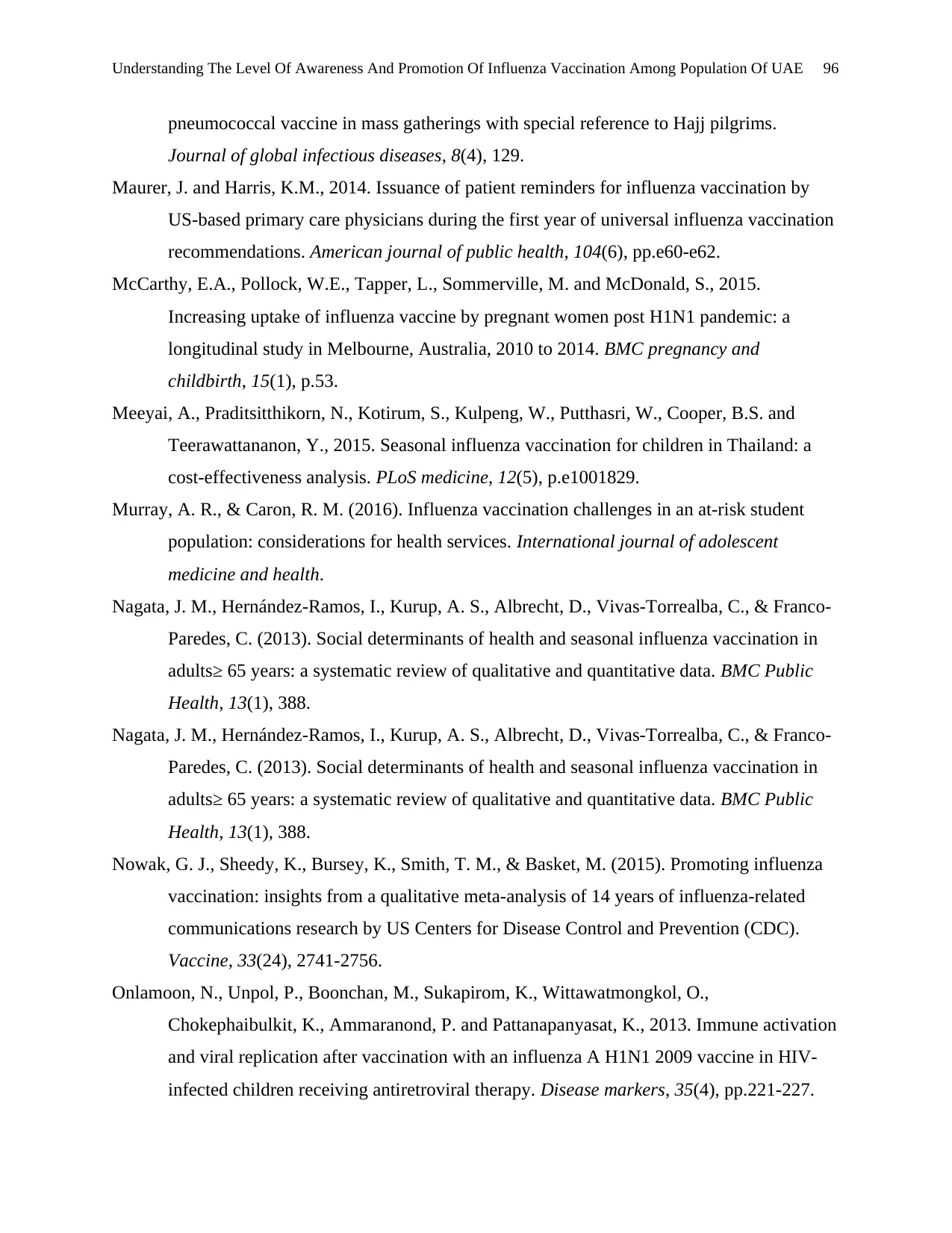
Understanding The Level Of Awareness And Promotion Of Influenza Vaccination Among Population Of UAE 96
pneumococcal vaccine in mass gatherings with special reference to Hajj pilgrims.
Journal of global infectious diseases, 8(4), 129.
Maurer, J. and Harris, K.M., 2014. Issuance of patient reminders for influenza vaccination by
US-based primary care physicians during the first year of universal influenza vaccination
recommendations. American journal of public health, 104(6), pp.e60-e62.
McCarthy, E.A., Pollock, W.E., Tapper, L., Sommerville, M. and McDonald, S., 2015.
Increasing uptake of influenza vaccine by pregnant women post H1N1 pandemic: a
longitudinal study in Melbourne, Australia, 2010 to 2014. BMC pregnancy and
childbirth, 15(1), p.53.
Meeyai, A., Praditsitthikorn, N., Kotirum, S., Kulpeng, W., Putthasri, W., Cooper, B.S. and
Teerawattananon, Y., 2015. Seasonal influenza vaccination for children in Thailand: a
cost-effectiveness analysis. PLoS medicine, 12(5), p.e1001829.
Murray, A. R., & Caron, R. M. (2016). Influenza vaccination challenges in an at-risk student
population: considerations for health services. International journal of adolescent
medicine and health.
Nagata, J. M., Hernández-Ramos, I., Kurup, A. S., Albrecht, D., Vivas-Torrealba, C., & Franco-
Paredes, C. (2013). Social determinants of health and seasonal influenza vaccination in
adults≥ 65 years: a systematic review of qualitative and quantitative data. BMC Public
Health, 13(1), 388.
Nagata, J. M., Hernández-Ramos, I., Kurup, A. S., Albrecht, D., Vivas-Torrealba, C., & Franco-
Paredes, C. (2013). Social determinants of health and seasonal influenza vaccination in
adults≥ 65 years: a systematic review of qualitative and quantitative data. BMC Public
Health, 13(1), 388.
Nowak, G. J., Sheedy, K., Bursey, K., Smith, T. M., & Basket, M. (2015). Promoting influenza
vaccination: insights from a qualitative meta-analysis of 14 years of influenza-related
communications research by US Centers for Disease Control and Prevention (CDC).
Vaccine, 33(24), 2741-2756.
Onlamoon, N., Unpol, P., Boonchan, M., Sukapirom, K., Wittawatmongkol, O.,
Chokephaibulkit, K., Ammaranond, P. and Pattanapanyasat, K., 2013. Immune activation
and viral replication after vaccination with an influenza A H1N1 2009 vaccine in HIV-
infected children receiving antiretroviral therapy. Disease markers, 35(4), pp.221-227.
pneumococcal vaccine in mass gatherings with special reference to Hajj pilgrims.
Journal of global infectious diseases, 8(4), 129.
Maurer, J. and Harris, K.M., 2014. Issuance of patient reminders for influenza vaccination by
US-based primary care physicians during the first year of universal influenza vaccination
recommendations. American journal of public health, 104(6), pp.e60-e62.
McCarthy, E.A., Pollock, W.E., Tapper, L., Sommerville, M. and McDonald, S., 2015.
Increasing uptake of influenza vaccine by pregnant women post H1N1 pandemic: a
longitudinal study in Melbourne, Australia, 2010 to 2014. BMC pregnancy and
childbirth, 15(1), p.53.
Meeyai, A., Praditsitthikorn, N., Kotirum, S., Kulpeng, W., Putthasri, W., Cooper, B.S. and
Teerawattananon, Y., 2015. Seasonal influenza vaccination for children in Thailand: a
cost-effectiveness analysis. PLoS medicine, 12(5), p.e1001829.
Murray, A. R., & Caron, R. M. (2016). Influenza vaccination challenges in an at-risk student
population: considerations for health services. International journal of adolescent
medicine and health.
Nagata, J. M., Hernández-Ramos, I., Kurup, A. S., Albrecht, D., Vivas-Torrealba, C., & Franco-
Paredes, C. (2013). Social determinants of health and seasonal influenza vaccination in
adults≥ 65 years: a systematic review of qualitative and quantitative data. BMC Public
Health, 13(1), 388.
Nagata, J. M., Hernández-Ramos, I., Kurup, A. S., Albrecht, D., Vivas-Torrealba, C., & Franco-
Paredes, C. (2013). Social determinants of health and seasonal influenza vaccination in
adults≥ 65 years: a systematic review of qualitative and quantitative data. BMC Public
Health, 13(1), 388.
Nowak, G. J., Sheedy, K., Bursey, K., Smith, T. M., & Basket, M. (2015). Promoting influenza
vaccination: insights from a qualitative meta-analysis of 14 years of influenza-related
communications research by US Centers for Disease Control and Prevention (CDC).
Vaccine, 33(24), 2741-2756.
Onlamoon, N., Unpol, P., Boonchan, M., Sukapirom, K., Wittawatmongkol, O.,
Chokephaibulkit, K., Ammaranond, P. and Pattanapanyasat, K., 2013. Immune activation
and viral replication after vaccination with an influenza A H1N1 2009 vaccine in HIV-
infected children receiving antiretroviral therapy. Disease markers, 35(4), pp.221-227.
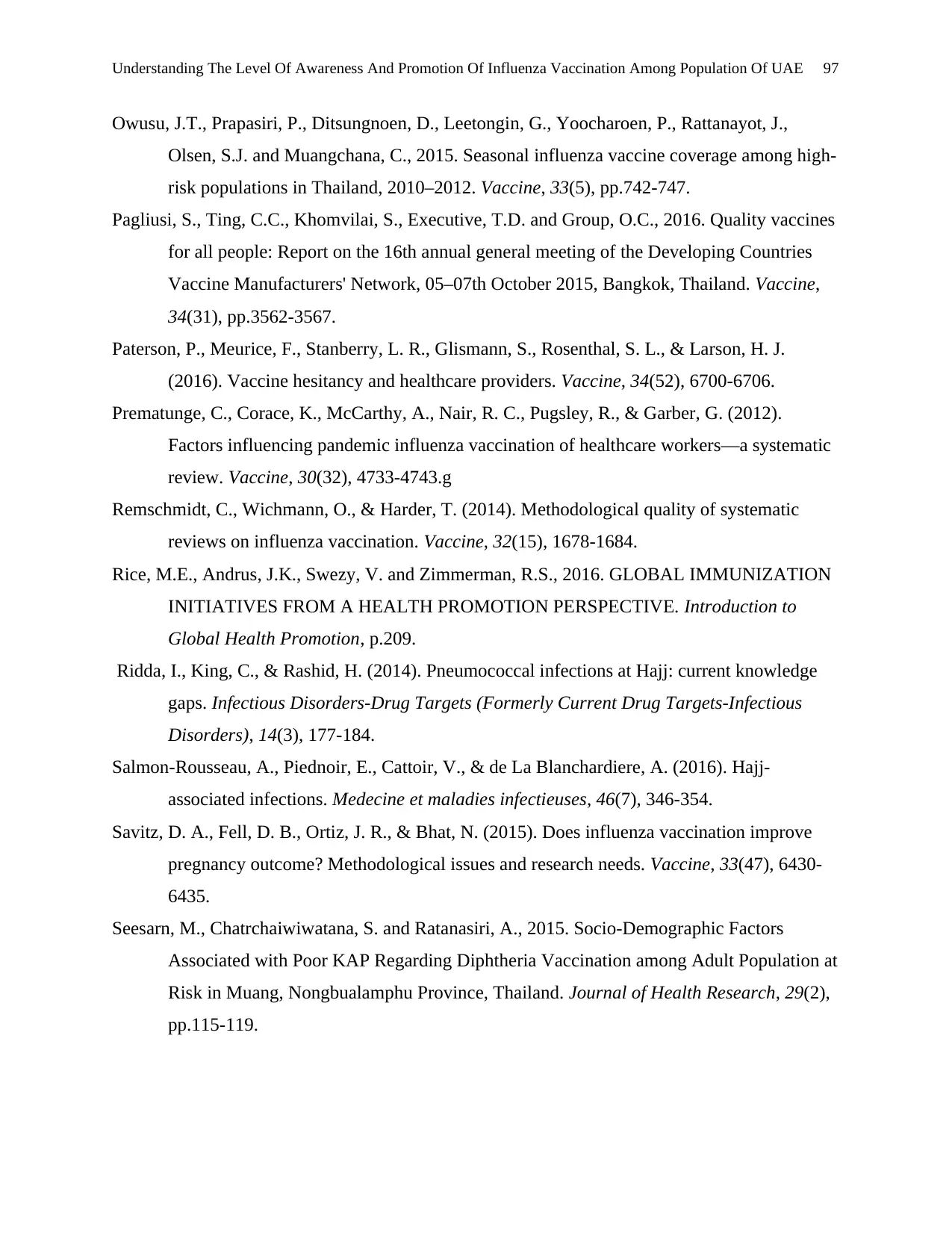
Understanding The Level Of Awareness And Promotion Of Influenza Vaccination Among Population Of UAE 97
Owusu, J.T., Prapasiri, P., Ditsungnoen, D., Leetongin, G., Yoocharoen, P., Rattanayot, J.,
Olsen, S.J. and Muangchana, C., 2015. Seasonal influenza vaccine coverage among high-
risk populations in Thailand, 2010–2012. Vaccine, 33(5), pp.742-747.
Pagliusi, S., Ting, C.C., Khomvilai, S., Executive, T.D. and Group, O.C., 2016. Quality vaccines
for all people: Report on the 16th annual general meeting of the Developing Countries
Vaccine Manufacturers' Network, 05–07th October 2015, Bangkok, Thailand. Vaccine,
34(31), pp.3562-3567.
Paterson, P., Meurice, F., Stanberry, L. R., Glismann, S., Rosenthal, S. L., & Larson, H. J.
(2016). Vaccine hesitancy and healthcare providers. Vaccine, 34(52), 6700-6706.
Prematunge, C., Corace, K., McCarthy, A., Nair, R. C., Pugsley, R., & Garber, G. (2012).
Factors influencing pandemic influenza vaccination of healthcare workers—a systematic
review. Vaccine, 30(32), 4733-4743.g
Remschmidt, C., Wichmann, O., & Harder, T. (2014). Methodological quality of systematic
reviews on influenza vaccination. Vaccine, 32(15), 1678-1684.
Rice, M.E., Andrus, J.K., Swezy, V. and Zimmerman, R.S., 2016. GLOBAL IMMUNIZATION
INITIATIVES FROM A HEALTH PROMOTION PERSPECTIVE. Introduction to
Global Health Promotion, p.209.
Ridda, I., King, C., & Rashid, H. (2014). Pneumococcal infections at Hajj: current knowledge
gaps. Infectious Disorders-Drug Targets (Formerly Current Drug Targets-Infectious
Disorders), 14(3), 177-184.
Salmon-Rousseau, A., Piednoir, E., Cattoir, V., & de La Blanchardiere, A. (2016). Hajj-
associated infections. Medecine et maladies infectieuses, 46(7), 346-354.
Savitz, D. A., Fell, D. B., Ortiz, J. R., & Bhat, N. (2015). Does influenza vaccination improve
pregnancy outcome? Methodological issues and research needs. Vaccine, 33(47), 6430-
6435.
Seesarn, M., Chatrchaiwiwatana, S. and Ratanasiri, A., 2015. Socio-Demographic Factors
Associated with Poor KAP Regarding Diphtheria Vaccination among Adult Population at
Risk in Muang, Nongbualamphu Province, Thailand. Journal of Health Research, 29(2),
pp.115-119.
Owusu, J.T., Prapasiri, P., Ditsungnoen, D., Leetongin, G., Yoocharoen, P., Rattanayot, J.,
Olsen, S.J. and Muangchana, C., 2015. Seasonal influenza vaccine coverage among high-
risk populations in Thailand, 2010–2012. Vaccine, 33(5), pp.742-747.
Pagliusi, S., Ting, C.C., Khomvilai, S., Executive, T.D. and Group, O.C., 2016. Quality vaccines
for all people: Report on the 16th annual general meeting of the Developing Countries
Vaccine Manufacturers' Network, 05–07th October 2015, Bangkok, Thailand. Vaccine,
34(31), pp.3562-3567.
Paterson, P., Meurice, F., Stanberry, L. R., Glismann, S., Rosenthal, S. L., & Larson, H. J.
(2016). Vaccine hesitancy and healthcare providers. Vaccine, 34(52), 6700-6706.
Prematunge, C., Corace, K., McCarthy, A., Nair, R. C., Pugsley, R., & Garber, G. (2012).
Factors influencing pandemic influenza vaccination of healthcare workers—a systematic
review. Vaccine, 30(32), 4733-4743.g
Remschmidt, C., Wichmann, O., & Harder, T. (2014). Methodological quality of systematic
reviews on influenza vaccination. Vaccine, 32(15), 1678-1684.
Rice, M.E., Andrus, J.K., Swezy, V. and Zimmerman, R.S., 2016. GLOBAL IMMUNIZATION
INITIATIVES FROM A HEALTH PROMOTION PERSPECTIVE. Introduction to
Global Health Promotion, p.209.
Ridda, I., King, C., & Rashid, H. (2014). Pneumococcal infections at Hajj: current knowledge
gaps. Infectious Disorders-Drug Targets (Formerly Current Drug Targets-Infectious
Disorders), 14(3), 177-184.
Salmon-Rousseau, A., Piednoir, E., Cattoir, V., & de La Blanchardiere, A. (2016). Hajj-
associated infections. Medecine et maladies infectieuses, 46(7), 346-354.
Savitz, D. A., Fell, D. B., Ortiz, J. R., & Bhat, N. (2015). Does influenza vaccination improve
pregnancy outcome? Methodological issues and research needs. Vaccine, 33(47), 6430-
6435.
Seesarn, M., Chatrchaiwiwatana, S. and Ratanasiri, A., 2015. Socio-Demographic Factors
Associated with Poor KAP Regarding Diphtheria Vaccination among Adult Population at
Risk in Muang, Nongbualamphu Province, Thailand. Journal of Health Research, 29(2),
pp.115-119.
Secure Best Marks with AI Grader
Need help grading? Try our AI Grader for instant feedback on your assignments.
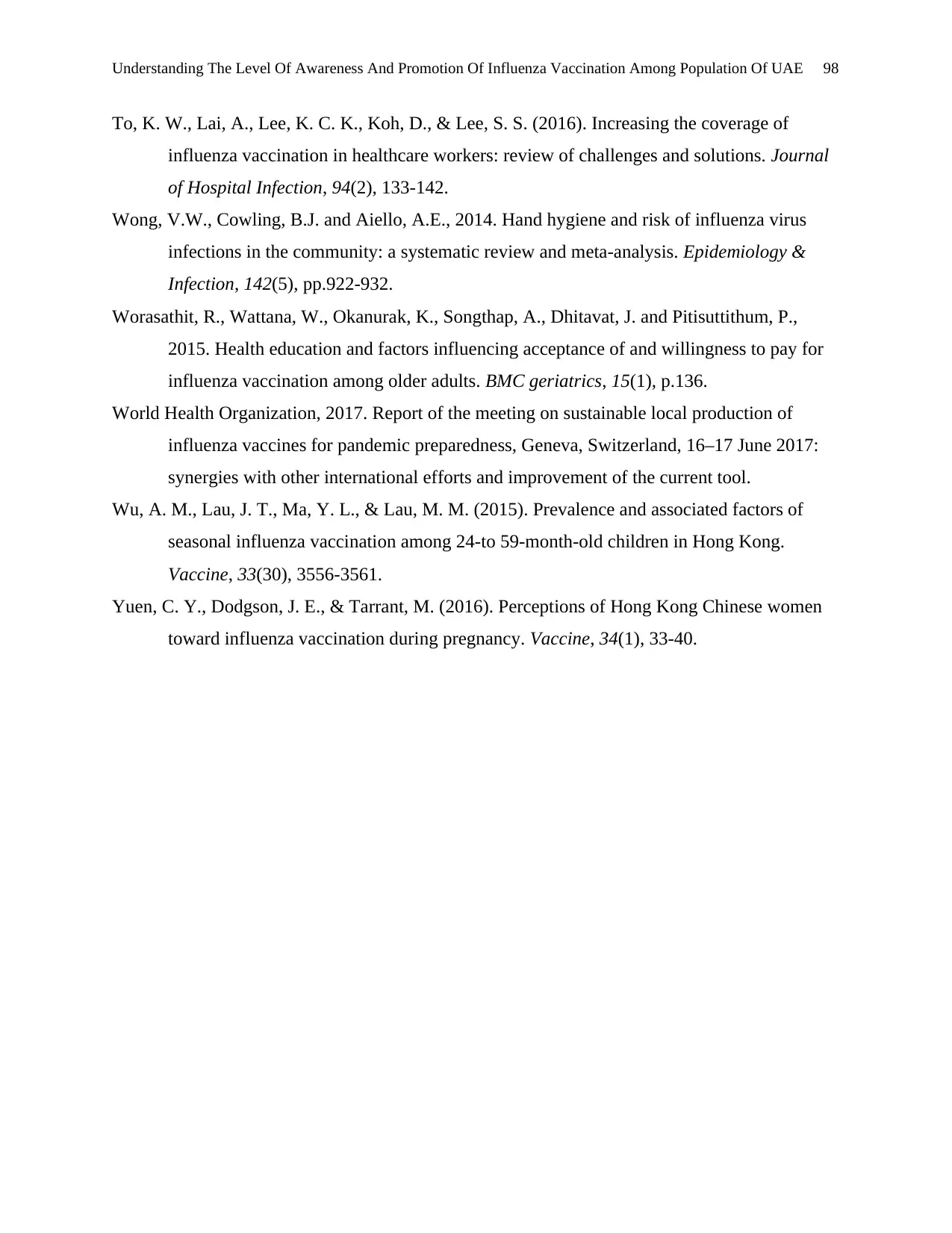
Understanding The Level Of Awareness And Promotion Of Influenza Vaccination Among Population Of UAE 98
To, K. W., Lai, A., Lee, K. C. K., Koh, D., & Lee, S. S. (2016). Increasing the coverage of
influenza vaccination in healthcare workers: review of challenges and solutions. Journal
of Hospital Infection, 94(2), 133-142.
Wong, V.W., Cowling, B.J. and Aiello, A.E., 2014. Hand hygiene and risk of influenza virus
infections in the community: a systematic review and meta-analysis. Epidemiology &
Infection, 142(5), pp.922-932.
Worasathit, R., Wattana, W., Okanurak, K., Songthap, A., Dhitavat, J. and Pitisuttithum, P.,
2015. Health education and factors influencing acceptance of and willingness to pay for
influenza vaccination among older adults. BMC geriatrics, 15(1), p.136.
World Health Organization, 2017. Report of the meeting on sustainable local production of
influenza vaccines for pandemic preparedness, Geneva, Switzerland, 16–17 June 2017:
synergies with other international efforts and improvement of the current tool.
Wu, A. M., Lau, J. T., Ma, Y. L., & Lau, M. M. (2015). Prevalence and associated factors of
seasonal influenza vaccination among 24-to 59-month-old children in Hong Kong.
Vaccine, 33(30), 3556-3561.
Yuen, C. Y., Dodgson, J. E., & Tarrant, M. (2016). Perceptions of Hong Kong Chinese women
toward influenza vaccination during pregnancy. Vaccine, 34(1), 33-40.
To, K. W., Lai, A., Lee, K. C. K., Koh, D., & Lee, S. S. (2016). Increasing the coverage of
influenza vaccination in healthcare workers: review of challenges and solutions. Journal
of Hospital Infection, 94(2), 133-142.
Wong, V.W., Cowling, B.J. and Aiello, A.E., 2014. Hand hygiene and risk of influenza virus
infections in the community: a systematic review and meta-analysis. Epidemiology &
Infection, 142(5), pp.922-932.
Worasathit, R., Wattana, W., Okanurak, K., Songthap, A., Dhitavat, J. and Pitisuttithum, P.,
2015. Health education and factors influencing acceptance of and willingness to pay for
influenza vaccination among older adults. BMC geriatrics, 15(1), p.136.
World Health Organization, 2017. Report of the meeting on sustainable local production of
influenza vaccines for pandemic preparedness, Geneva, Switzerland, 16–17 June 2017:
synergies with other international efforts and improvement of the current tool.
Wu, A. M., Lau, J. T., Ma, Y. L., & Lau, M. M. (2015). Prevalence and associated factors of
seasonal influenza vaccination among 24-to 59-month-old children in Hong Kong.
Vaccine, 33(30), 3556-3561.
Yuen, C. Y., Dodgson, J. E., & Tarrant, M. (2016). Perceptions of Hong Kong Chinese women
toward influenza vaccination during pregnancy. Vaccine, 34(1), 33-40.
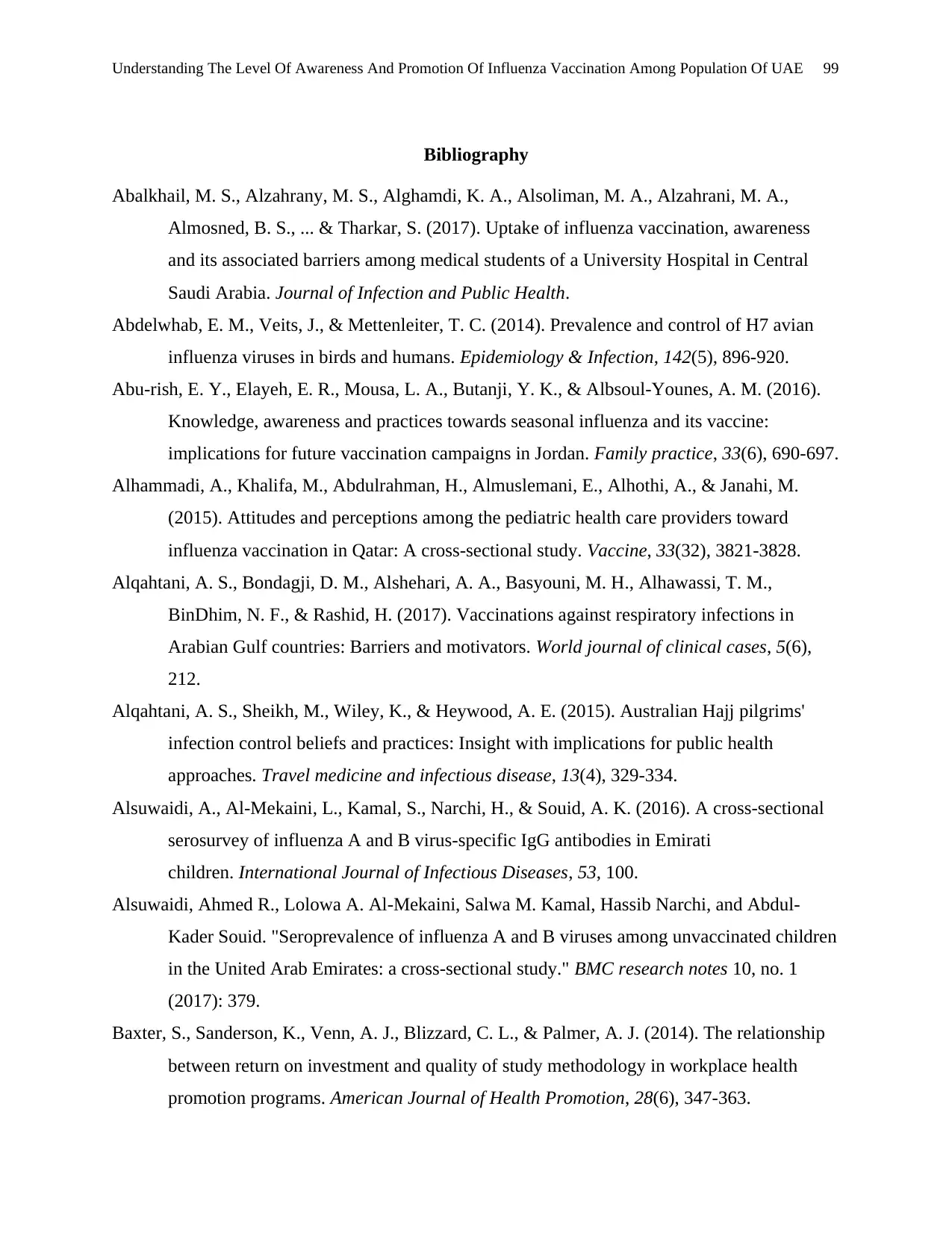
Understanding The Level Of Awareness And Promotion Of Influenza Vaccination Among Population Of UAE 99
Bibliography
Abalkhail, M. S., Alzahrany, M. S., Alghamdi, K. A., Alsoliman, M. A., Alzahrani, M. A.,
Almosned, B. S., ... & Tharkar, S. (2017). Uptake of influenza vaccination, awareness
and its associated barriers among medical students of a University Hospital in Central
Saudi Arabia. Journal of Infection and Public Health.
Abdelwhab, E. M., Veits, J., & Mettenleiter, T. C. (2014). Prevalence and control of H7 avian
influenza viruses in birds and humans. Epidemiology & Infection, 142(5), 896-920.
Abu-rish, E. Y., Elayeh, E. R., Mousa, L. A., Butanji, Y. K., & Albsoul-Younes, A. M. (2016).
Knowledge, awareness and practices towards seasonal influenza and its vaccine:
implications for future vaccination campaigns in Jordan. Family practice, 33(6), 690-697.
Alhammadi, A., Khalifa, M., Abdulrahman, H., Almuslemani, E., Alhothi, A., & Janahi, M.
(2015). Attitudes and perceptions among the pediatric health care providers toward
influenza vaccination in Qatar: A cross-sectional study. Vaccine, 33(32), 3821-3828.
Alqahtani, A. S., Bondagji, D. M., Alshehari, A. A., Basyouni, M. H., Alhawassi, T. M.,
BinDhim, N. F., & Rashid, H. (2017). Vaccinations against respiratory infections in
Arabian Gulf countries: Barriers and motivators. World journal of clinical cases, 5(6),
212.
Alqahtani, A. S., Sheikh, M., Wiley, K., & Heywood, A. E. (2015). Australian Hajj pilgrims'
infection control beliefs and practices: Insight with implications for public health
approaches. Travel medicine and infectious disease, 13(4), 329-334.
Alsuwaidi, A., Al-Mekaini, L., Kamal, S., Narchi, H., & Souid, A. K. (2016). A cross-sectional
serosurvey of influenza A and B virus-specific IgG antibodies in Emirati
children. International Journal of Infectious Diseases, 53, 100.
Alsuwaidi, Ahmed R., Lolowa A. Al-Mekaini, Salwa M. Kamal, Hassib Narchi, and Abdul-
Kader Souid. "Seroprevalence of influenza A and B viruses among unvaccinated children
in the United Arab Emirates: a cross-sectional study." BMC research notes 10, no. 1
(2017): 379.
Baxter, S., Sanderson, K., Venn, A. J., Blizzard, C. L., & Palmer, A. J. (2014). The relationship
between return on investment and quality of study methodology in workplace health
promotion programs. American Journal of Health Promotion, 28(6), 347-363.
Bibliography
Abalkhail, M. S., Alzahrany, M. S., Alghamdi, K. A., Alsoliman, M. A., Alzahrani, M. A.,
Almosned, B. S., ... & Tharkar, S. (2017). Uptake of influenza vaccination, awareness
and its associated barriers among medical students of a University Hospital in Central
Saudi Arabia. Journal of Infection and Public Health.
Abdelwhab, E. M., Veits, J., & Mettenleiter, T. C. (2014). Prevalence and control of H7 avian
influenza viruses in birds and humans. Epidemiology & Infection, 142(5), 896-920.
Abu-rish, E. Y., Elayeh, E. R., Mousa, L. A., Butanji, Y. K., & Albsoul-Younes, A. M. (2016).
Knowledge, awareness and practices towards seasonal influenza and its vaccine:
implications for future vaccination campaigns in Jordan. Family practice, 33(6), 690-697.
Alhammadi, A., Khalifa, M., Abdulrahman, H., Almuslemani, E., Alhothi, A., & Janahi, M.
(2015). Attitudes and perceptions among the pediatric health care providers toward
influenza vaccination in Qatar: A cross-sectional study. Vaccine, 33(32), 3821-3828.
Alqahtani, A. S., Bondagji, D. M., Alshehari, A. A., Basyouni, M. H., Alhawassi, T. M.,
BinDhim, N. F., & Rashid, H. (2017). Vaccinations against respiratory infections in
Arabian Gulf countries: Barriers and motivators. World journal of clinical cases, 5(6),
212.
Alqahtani, A. S., Sheikh, M., Wiley, K., & Heywood, A. E. (2015). Australian Hajj pilgrims'
infection control beliefs and practices: Insight with implications for public health
approaches. Travel medicine and infectious disease, 13(4), 329-334.
Alsuwaidi, A., Al-Mekaini, L., Kamal, S., Narchi, H., & Souid, A. K. (2016). A cross-sectional
serosurvey of influenza A and B virus-specific IgG antibodies in Emirati
children. International Journal of Infectious Diseases, 53, 100.
Alsuwaidi, Ahmed R., Lolowa A. Al-Mekaini, Salwa M. Kamal, Hassib Narchi, and Abdul-
Kader Souid. "Seroprevalence of influenza A and B viruses among unvaccinated children
in the United Arab Emirates: a cross-sectional study." BMC research notes 10, no. 1
(2017): 379.
Baxter, S., Sanderson, K., Venn, A. J., Blizzard, C. L., & Palmer, A. J. (2014). The relationship
between return on investment and quality of study methodology in workplace health
promotion programs. American Journal of Health Promotion, 28(6), 347-363.
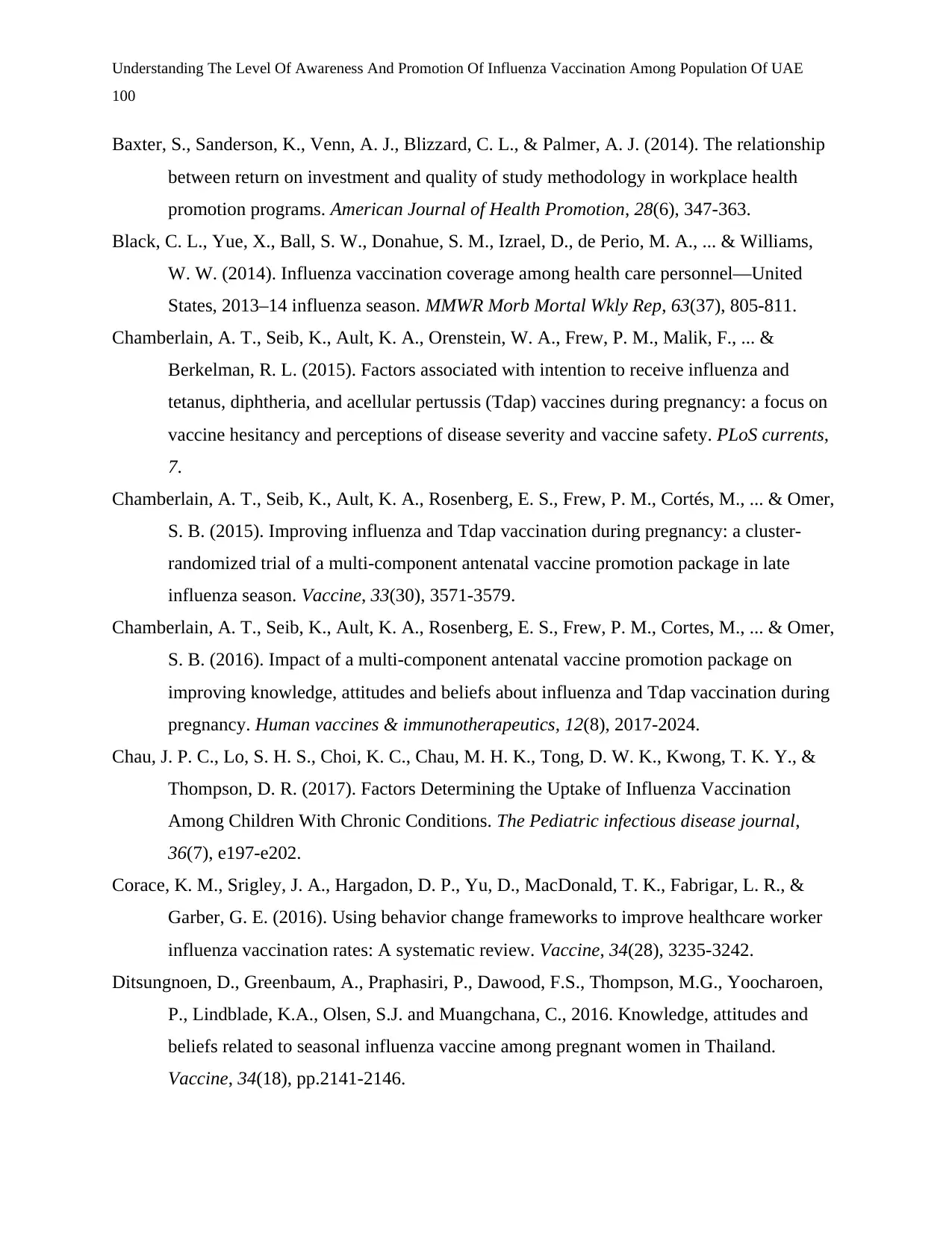
Understanding The Level Of Awareness And Promotion Of Influenza Vaccination Among Population Of UAE
100
Baxter, S., Sanderson, K., Venn, A. J., Blizzard, C. L., & Palmer, A. J. (2014). The relationship
between return on investment and quality of study methodology in workplace health
promotion programs. American Journal of Health Promotion, 28(6), 347-363.
Black, C. L., Yue, X., Ball, S. W., Donahue, S. M., Izrael, D., de Perio, M. A., ... & Williams,
W. W. (2014). Influenza vaccination coverage among health care personnel—United
States, 2013–14 influenza season. MMWR Morb Mortal Wkly Rep, 63(37), 805-811.
Chamberlain, A. T., Seib, K., Ault, K. A., Orenstein, W. A., Frew, P. M., Malik, F., ... &
Berkelman, R. L. (2015). Factors associated with intention to receive influenza and
tetanus, diphtheria, and acellular pertussis (Tdap) vaccines during pregnancy: a focus on
vaccine hesitancy and perceptions of disease severity and vaccine safety. PLoS currents,
7.
Chamberlain, A. T., Seib, K., Ault, K. A., Rosenberg, E. S., Frew, P. M., Cortés, M., ... & Omer,
S. B. (2015). Improving influenza and Tdap vaccination during pregnancy: a cluster-
randomized trial of a multi-component antenatal vaccine promotion package in late
influenza season. Vaccine, 33(30), 3571-3579.
Chamberlain, A. T., Seib, K., Ault, K. A., Rosenberg, E. S., Frew, P. M., Cortes, M., ... & Omer,
S. B. (2016). Impact of a multi-component antenatal vaccine promotion package on
improving knowledge, attitudes and beliefs about influenza and Tdap vaccination during
pregnancy. Human vaccines & immunotherapeutics, 12(8), 2017-2024.
Chau, J. P. C., Lo, S. H. S., Choi, K. C., Chau, M. H. K., Tong, D. W. K., Kwong, T. K. Y., &
Thompson, D. R. (2017). Factors Determining the Uptake of Influenza Vaccination
Among Children With Chronic Conditions. The Pediatric infectious disease journal,
36(7), e197-e202.
Corace, K. M., Srigley, J. A., Hargadon, D. P., Yu, D., MacDonald, T. K., Fabrigar, L. R., &
Garber, G. E. (2016). Using behavior change frameworks to improve healthcare worker
influenza vaccination rates: A systematic review. Vaccine, 34(28), 3235-3242.
Ditsungnoen, D., Greenbaum, A., Praphasiri, P., Dawood, F.S., Thompson, M.G., Yoocharoen,
P., Lindblade, K.A., Olsen, S.J. and Muangchana, C., 2016. Knowledge, attitudes and
beliefs related to seasonal influenza vaccine among pregnant women in Thailand.
Vaccine, 34(18), pp.2141-2146.
100
Baxter, S., Sanderson, K., Venn, A. J., Blizzard, C. L., & Palmer, A. J. (2014). The relationship
between return on investment and quality of study methodology in workplace health
promotion programs. American Journal of Health Promotion, 28(6), 347-363.
Black, C. L., Yue, X., Ball, S. W., Donahue, S. M., Izrael, D., de Perio, M. A., ... & Williams,
W. W. (2014). Influenza vaccination coverage among health care personnel—United
States, 2013–14 influenza season. MMWR Morb Mortal Wkly Rep, 63(37), 805-811.
Chamberlain, A. T., Seib, K., Ault, K. A., Orenstein, W. A., Frew, P. M., Malik, F., ... &
Berkelman, R. L. (2015). Factors associated with intention to receive influenza and
tetanus, diphtheria, and acellular pertussis (Tdap) vaccines during pregnancy: a focus on
vaccine hesitancy and perceptions of disease severity and vaccine safety. PLoS currents,
7.
Chamberlain, A. T., Seib, K., Ault, K. A., Rosenberg, E. S., Frew, P. M., Cortés, M., ... & Omer,
S. B. (2015). Improving influenza and Tdap vaccination during pregnancy: a cluster-
randomized trial of a multi-component antenatal vaccine promotion package in late
influenza season. Vaccine, 33(30), 3571-3579.
Chamberlain, A. T., Seib, K., Ault, K. A., Rosenberg, E. S., Frew, P. M., Cortes, M., ... & Omer,
S. B. (2016). Impact of a multi-component antenatal vaccine promotion package on
improving knowledge, attitudes and beliefs about influenza and Tdap vaccination during
pregnancy. Human vaccines & immunotherapeutics, 12(8), 2017-2024.
Chau, J. P. C., Lo, S. H. S., Choi, K. C., Chau, M. H. K., Tong, D. W. K., Kwong, T. K. Y., &
Thompson, D. R. (2017). Factors Determining the Uptake of Influenza Vaccination
Among Children With Chronic Conditions. The Pediatric infectious disease journal,
36(7), e197-e202.
Corace, K. M., Srigley, J. A., Hargadon, D. P., Yu, D., MacDonald, T. K., Fabrigar, L. R., &
Garber, G. E. (2016). Using behavior change frameworks to improve healthcare worker
influenza vaccination rates: A systematic review. Vaccine, 34(28), 3235-3242.
Ditsungnoen, D., Greenbaum, A., Praphasiri, P., Dawood, F.S., Thompson, M.G., Yoocharoen,
P., Lindblade, K.A., Olsen, S.J. and Muangchana, C., 2016. Knowledge, attitudes and
beliefs related to seasonal influenza vaccine among pregnant women in Thailand.
Vaccine, 34(18), pp.2141-2146.
Paraphrase This Document
Need a fresh take? Get an instant paraphrase of this document with our AI Paraphraser
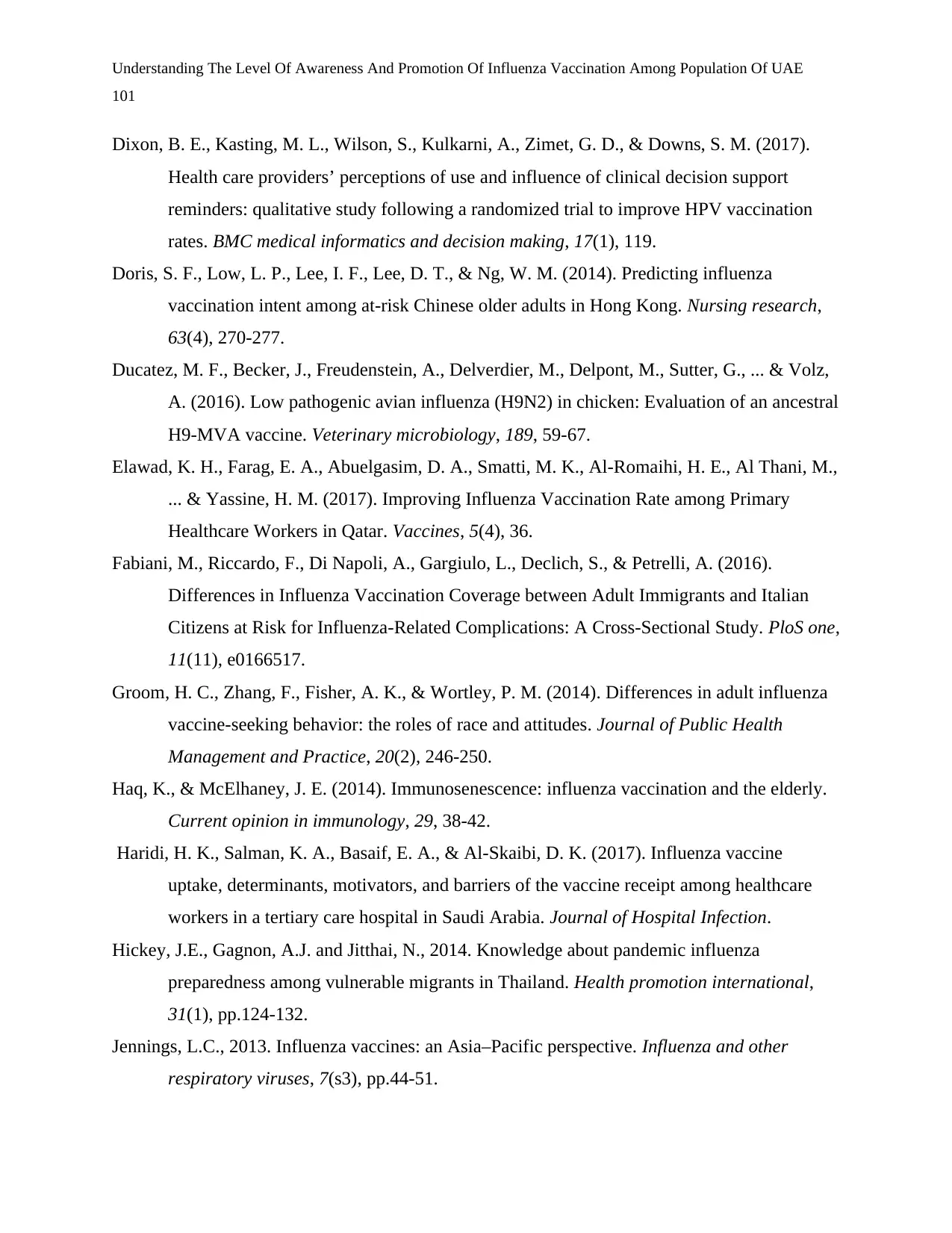
Understanding The Level Of Awareness And Promotion Of Influenza Vaccination Among Population Of UAE
101
Dixon, B. E., Kasting, M. L., Wilson, S., Kulkarni, A., Zimet, G. D., & Downs, S. M. (2017).
Health care providers’ perceptions of use and influence of clinical decision support
reminders: qualitative study following a randomized trial to improve HPV vaccination
rates. BMC medical informatics and decision making, 17(1), 119.
Doris, S. F., Low, L. P., Lee, I. F., Lee, D. T., & Ng, W. M. (2014). Predicting influenza
vaccination intent among at-risk Chinese older adults in Hong Kong. Nursing research,
63(4), 270-277.
Ducatez, M. F., Becker, J., Freudenstein, A., Delverdier, M., Delpont, M., Sutter, G., ... & Volz,
A. (2016). Low pathogenic avian influenza (H9N2) in chicken: Evaluation of an ancestral
H9-MVA vaccine. Veterinary microbiology, 189, 59-67.
Elawad, K. H., Farag, E. A., Abuelgasim, D. A., Smatti, M. K., Al-Romaihi, H. E., Al Thani, M.,
... & Yassine, H. M. (2017). Improving Influenza Vaccination Rate among Primary
Healthcare Workers in Qatar. Vaccines, 5(4), 36.
Fabiani, M., Riccardo, F., Di Napoli, A., Gargiulo, L., Declich, S., & Petrelli, A. (2016).
Differences in Influenza Vaccination Coverage between Adult Immigrants and Italian
Citizens at Risk for Influenza-Related Complications: A Cross-Sectional Study. PloS one,
11(11), e0166517.
Groom, H. C., Zhang, F., Fisher, A. K., & Wortley, P. M. (2014). Differences in adult influenza
vaccine-seeking behavior: the roles of race and attitudes. Journal of Public Health
Management and Practice, 20(2), 246-250.
Haq, K., & McElhaney, J. E. (2014). Immunosenescence: influenza vaccination and the elderly.
Current opinion in immunology, 29, 38-42.
Haridi, H. K., Salman, K. A., Basaif, E. A., & Al-Skaibi, D. K. (2017). Influenza vaccine
uptake, determinants, motivators, and barriers of the vaccine receipt among healthcare
workers in a tertiary care hospital in Saudi Arabia. Journal of Hospital Infection.
Hickey, J.E., Gagnon, A.J. and Jitthai, N., 2014. Knowledge about pandemic influenza
preparedness among vulnerable migrants in Thailand. Health promotion international,
31(1), pp.124-132.
Jennings, L.C., 2013. Influenza vaccines: an Asia–Pacific perspective. Influenza and other
respiratory viruses, 7(s3), pp.44-51.
101
Dixon, B. E., Kasting, M. L., Wilson, S., Kulkarni, A., Zimet, G. D., & Downs, S. M. (2017).
Health care providers’ perceptions of use and influence of clinical decision support
reminders: qualitative study following a randomized trial to improve HPV vaccination
rates. BMC medical informatics and decision making, 17(1), 119.
Doris, S. F., Low, L. P., Lee, I. F., Lee, D. T., & Ng, W. M. (2014). Predicting influenza
vaccination intent among at-risk Chinese older adults in Hong Kong. Nursing research,
63(4), 270-277.
Ducatez, M. F., Becker, J., Freudenstein, A., Delverdier, M., Delpont, M., Sutter, G., ... & Volz,
A. (2016). Low pathogenic avian influenza (H9N2) in chicken: Evaluation of an ancestral
H9-MVA vaccine. Veterinary microbiology, 189, 59-67.
Elawad, K. H., Farag, E. A., Abuelgasim, D. A., Smatti, M. K., Al-Romaihi, H. E., Al Thani, M.,
... & Yassine, H. M. (2017). Improving Influenza Vaccination Rate among Primary
Healthcare Workers in Qatar. Vaccines, 5(4), 36.
Fabiani, M., Riccardo, F., Di Napoli, A., Gargiulo, L., Declich, S., & Petrelli, A. (2016).
Differences in Influenza Vaccination Coverage between Adult Immigrants and Italian
Citizens at Risk for Influenza-Related Complications: A Cross-Sectional Study. PloS one,
11(11), e0166517.
Groom, H. C., Zhang, F., Fisher, A. K., & Wortley, P. M. (2014). Differences in adult influenza
vaccine-seeking behavior: the roles of race and attitudes. Journal of Public Health
Management and Practice, 20(2), 246-250.
Haq, K., & McElhaney, J. E. (2014). Immunosenescence: influenza vaccination and the elderly.
Current opinion in immunology, 29, 38-42.
Haridi, H. K., Salman, K. A., Basaif, E. A., & Al-Skaibi, D. K. (2017). Influenza vaccine
uptake, determinants, motivators, and barriers of the vaccine receipt among healthcare
workers in a tertiary care hospital in Saudi Arabia. Journal of Hospital Infection.
Hickey, J.E., Gagnon, A.J. and Jitthai, N., 2014. Knowledge about pandemic influenza
preparedness among vulnerable migrants in Thailand. Health promotion international,
31(1), pp.124-132.
Jennings, L.C., 2013. Influenza vaccines: an Asia–Pacific perspective. Influenza and other
respiratory viruses, 7(s3), pp.44-51.

Understanding The Level Of Awareness And Promotion Of Influenza Vaccination Among Population Of UAE
102
Jennings, L.C., Smith, D.W. and Chan, P.K., 2013. Report of the first Asia‐Pacific influenza
summit, Asia‐Pacific Alliance for the Control of Influenza (APACI), Bangkok, 12–13
June 2012. Influenza and other respiratory viruses, 7(6), pp.991-995.
Knudsen, N. P. H., Olsen, A., Buonsanti, C., Follmann, F., Zhang, Y., Coler, R. N., ... &
Billeskov, R. (2016). Different human vaccine adjuvants promote distinct antigen-
independent immunological signatures tailored to different pathogens. Scientific reports,
6, 19570.
Leewongtrakul, T., Kunpalin, Y., Ingviya, T. and Chaithongwongwatthana, S., 2017. Acceptance
of Influenza Vaccination among Pregnant Women attending the Antenatal Care Clinic at
King Chulalongkorn Memorial Hospital. Thai Journal of Obstetrics and Gynaecology,
26(2).
Lehmann, B. A., Chapman, G. B., Franssen, F. M., Kok, G., & Ruiter, R. A. (2016). Changing
the default to promote influenza vaccination among health care workers. Vaccine, 34(11),
1389-1392.
Lim, D. W., Lee, L. T., Kyaw, W. M., & Chow, A. (2017). Psychosocial determinants of
influenza vaccination intention: A cross-sectional study on inpatient nurses in Singapore.
American Journal of Infection Control.
Lim, Y. C., & Seale, H. (2014). Examining the views of key stakeholders regarding the provision
of occupational influenza vaccination for healthcare workers in Australia. Vaccine, 32(5),
606-610.
Loulergue, P., & Launay, O. (2014). Vaccinations among medical and nursing students:
coverage and opportunities. Vaccine, 32(38), 4855-4859.
Lv, M., Fang, R., Wu, J., Pang, X., Deng, Y., Lei, T., & Xie, Z. (2016). The free vaccination
policy of influenza in Beijing, China: The vaccine coverage and its associated factors.
Vaccine, 34(18), 2135-2140.
Madhi, S. A., Cutland, C. L., Kuwanda, L., Weinberg, A., Hugo, A., Jones, S., ... & Venter, M.
(2014). Influenza vaccination of pregnant women and protection of their infants. New
England Journal of Medicine, 371(10), 918-931.
Mathai, D., Shamsuzzaman, A. K. M., Feroz, A. A., Virani, A. R., Hasan, A., Kumar, K. R., ... &
Ali, M. M. (2016). Consensus recommendation for India and Bangladesh for the use of
102
Jennings, L.C., Smith, D.W. and Chan, P.K., 2013. Report of the first Asia‐Pacific influenza
summit, Asia‐Pacific Alliance for the Control of Influenza (APACI), Bangkok, 12–13
June 2012. Influenza and other respiratory viruses, 7(6), pp.991-995.
Knudsen, N. P. H., Olsen, A., Buonsanti, C., Follmann, F., Zhang, Y., Coler, R. N., ... &
Billeskov, R. (2016). Different human vaccine adjuvants promote distinct antigen-
independent immunological signatures tailored to different pathogens. Scientific reports,
6, 19570.
Leewongtrakul, T., Kunpalin, Y., Ingviya, T. and Chaithongwongwatthana, S., 2017. Acceptance
of Influenza Vaccination among Pregnant Women attending the Antenatal Care Clinic at
King Chulalongkorn Memorial Hospital. Thai Journal of Obstetrics and Gynaecology,
26(2).
Lehmann, B. A., Chapman, G. B., Franssen, F. M., Kok, G., & Ruiter, R. A. (2016). Changing
the default to promote influenza vaccination among health care workers. Vaccine, 34(11),
1389-1392.
Lim, D. W., Lee, L. T., Kyaw, W. M., & Chow, A. (2017). Psychosocial determinants of
influenza vaccination intention: A cross-sectional study on inpatient nurses in Singapore.
American Journal of Infection Control.
Lim, Y. C., & Seale, H. (2014). Examining the views of key stakeholders regarding the provision
of occupational influenza vaccination for healthcare workers in Australia. Vaccine, 32(5),
606-610.
Loulergue, P., & Launay, O. (2014). Vaccinations among medical and nursing students:
coverage and opportunities. Vaccine, 32(38), 4855-4859.
Lv, M., Fang, R., Wu, J., Pang, X., Deng, Y., Lei, T., & Xie, Z. (2016). The free vaccination
policy of influenza in Beijing, China: The vaccine coverage and its associated factors.
Vaccine, 34(18), 2135-2140.
Madhi, S. A., Cutland, C. L., Kuwanda, L., Weinberg, A., Hugo, A., Jones, S., ... & Venter, M.
(2014). Influenza vaccination of pregnant women and protection of their infants. New
England Journal of Medicine, 371(10), 918-931.
Mathai, D., Shamsuzzaman, A. K. M., Feroz, A. A., Virani, A. R., Hasan, A., Kumar, K. R., ... &
Ali, M. M. (2016). Consensus recommendation for India and Bangladesh for the use of
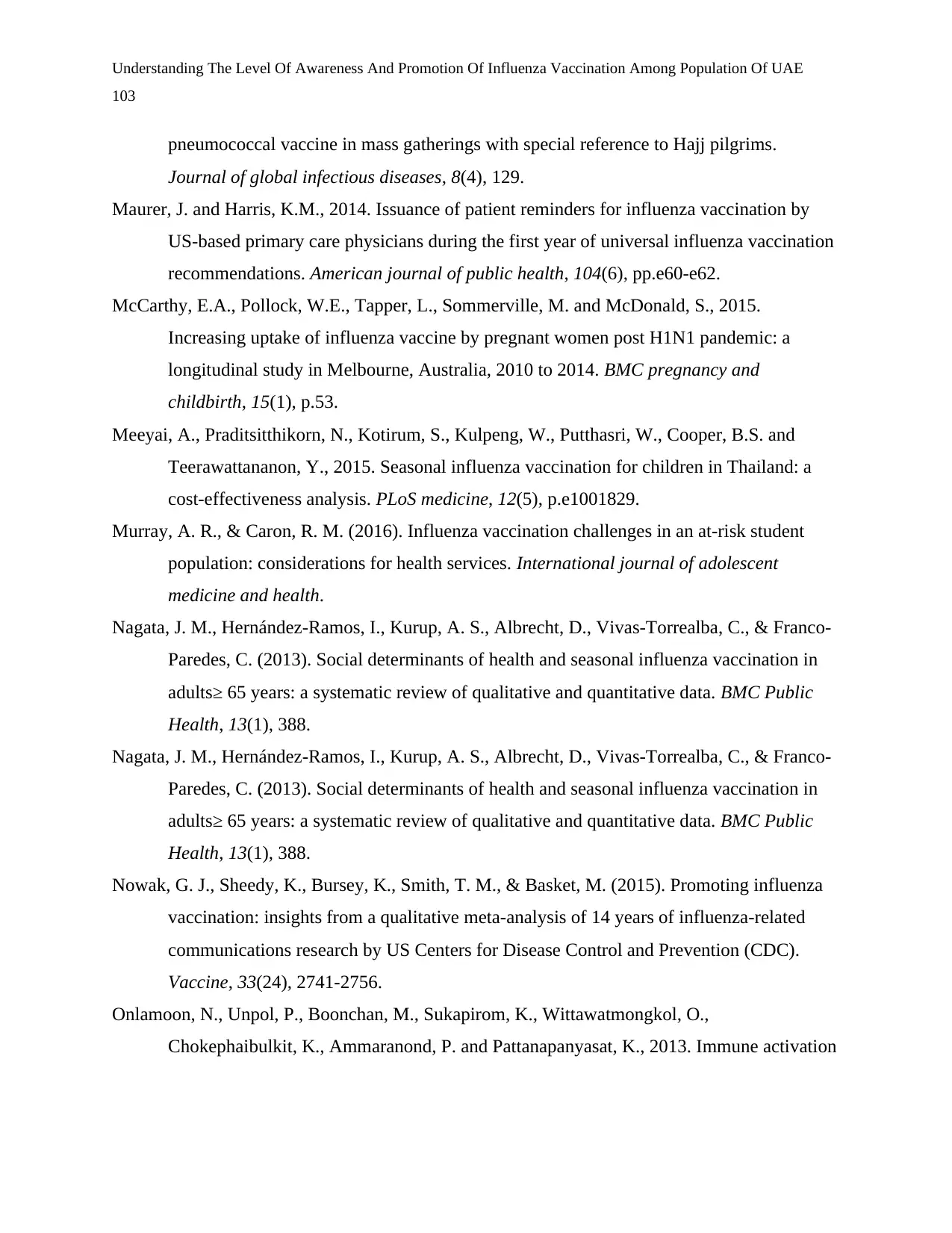
Understanding The Level Of Awareness And Promotion Of Influenza Vaccination Among Population Of UAE
103
pneumococcal vaccine in mass gatherings with special reference to Hajj pilgrims.
Journal of global infectious diseases, 8(4), 129.
Maurer, J. and Harris, K.M., 2014. Issuance of patient reminders for influenza vaccination by
US-based primary care physicians during the first year of universal influenza vaccination
recommendations. American journal of public health, 104(6), pp.e60-e62.
McCarthy, E.A., Pollock, W.E., Tapper, L., Sommerville, M. and McDonald, S., 2015.
Increasing uptake of influenza vaccine by pregnant women post H1N1 pandemic: a
longitudinal study in Melbourne, Australia, 2010 to 2014. BMC pregnancy and
childbirth, 15(1), p.53.
Meeyai, A., Praditsitthikorn, N., Kotirum, S., Kulpeng, W., Putthasri, W., Cooper, B.S. and
Teerawattananon, Y., 2015. Seasonal influenza vaccination for children in Thailand: a
cost-effectiveness analysis. PLoS medicine, 12(5), p.e1001829.
Murray, A. R., & Caron, R. M. (2016). Influenza vaccination challenges in an at-risk student
population: considerations for health services. International journal of adolescent
medicine and health.
Nagata, J. M., Hernández-Ramos, I., Kurup, A. S., Albrecht, D., Vivas-Torrealba, C., & Franco-
Paredes, C. (2013). Social determinants of health and seasonal influenza vaccination in
adults≥ 65 years: a systematic review of qualitative and quantitative data. BMC Public
Health, 13(1), 388.
Nagata, J. M., Hernández-Ramos, I., Kurup, A. S., Albrecht, D., Vivas-Torrealba, C., & Franco-
Paredes, C. (2013). Social determinants of health and seasonal influenza vaccination in
adults≥ 65 years: a systematic review of qualitative and quantitative data. BMC Public
Health, 13(1), 388.
Nowak, G. J., Sheedy, K., Bursey, K., Smith, T. M., & Basket, M. (2015). Promoting influenza
vaccination: insights from a qualitative meta-analysis of 14 years of influenza-related
communications research by US Centers for Disease Control and Prevention (CDC).
Vaccine, 33(24), 2741-2756.
Onlamoon, N., Unpol, P., Boonchan, M., Sukapirom, K., Wittawatmongkol, O.,
Chokephaibulkit, K., Ammaranond, P. and Pattanapanyasat, K., 2013. Immune activation
103
pneumococcal vaccine in mass gatherings with special reference to Hajj pilgrims.
Journal of global infectious diseases, 8(4), 129.
Maurer, J. and Harris, K.M., 2014. Issuance of patient reminders for influenza vaccination by
US-based primary care physicians during the first year of universal influenza vaccination
recommendations. American journal of public health, 104(6), pp.e60-e62.
McCarthy, E.A., Pollock, W.E., Tapper, L., Sommerville, M. and McDonald, S., 2015.
Increasing uptake of influenza vaccine by pregnant women post H1N1 pandemic: a
longitudinal study in Melbourne, Australia, 2010 to 2014. BMC pregnancy and
childbirth, 15(1), p.53.
Meeyai, A., Praditsitthikorn, N., Kotirum, S., Kulpeng, W., Putthasri, W., Cooper, B.S. and
Teerawattananon, Y., 2015. Seasonal influenza vaccination for children in Thailand: a
cost-effectiveness analysis. PLoS medicine, 12(5), p.e1001829.
Murray, A. R., & Caron, R. M. (2016). Influenza vaccination challenges in an at-risk student
population: considerations for health services. International journal of adolescent
medicine and health.
Nagata, J. M., Hernández-Ramos, I., Kurup, A. S., Albrecht, D., Vivas-Torrealba, C., & Franco-
Paredes, C. (2013). Social determinants of health and seasonal influenza vaccination in
adults≥ 65 years: a systematic review of qualitative and quantitative data. BMC Public
Health, 13(1), 388.
Nagata, J. M., Hernández-Ramos, I., Kurup, A. S., Albrecht, D., Vivas-Torrealba, C., & Franco-
Paredes, C. (2013). Social determinants of health and seasonal influenza vaccination in
adults≥ 65 years: a systematic review of qualitative and quantitative data. BMC Public
Health, 13(1), 388.
Nowak, G. J., Sheedy, K., Bursey, K., Smith, T. M., & Basket, M. (2015). Promoting influenza
vaccination: insights from a qualitative meta-analysis of 14 years of influenza-related
communications research by US Centers for Disease Control and Prevention (CDC).
Vaccine, 33(24), 2741-2756.
Onlamoon, N., Unpol, P., Boonchan, M., Sukapirom, K., Wittawatmongkol, O.,
Chokephaibulkit, K., Ammaranond, P. and Pattanapanyasat, K., 2013. Immune activation
Secure Best Marks with AI Grader
Need help grading? Try our AI Grader for instant feedback on your assignments.

Understanding The Level Of Awareness And Promotion Of Influenza Vaccination Among Population Of UAE
104
and viral replication after vaccination with an influenza A H1N1 2009 vaccine in HIV-
infected children receiving antiretroviral therapy. Disease markers, 35(4), pp.221-227.
Owusu, J.T., Prapasiri, P., Ditsungnoen, D., Leetongin, G., Yoocharoen, P., Rattanayot, J.,
Olsen, S.J. and Muangchana, C., 2015. Seasonal influenza vaccine coverage among high-
risk populations in Thailand, 2010–2012. Vaccine, 33(5), pp.742-747.
Pagliusi, S., Ting, C.C., Khomvilai, S., Executive, T.D. and Group, O.C., 2016. Quality vaccines
for all people: Report on the 16th annual general meeting of the Developing Countries
Vaccine Manufacturers' Network, 05–07th October 2015, Bangkok, Thailand. Vaccine,
34(31), pp.3562-3567.
Paterson, P., Meurice, F., Stanberry, L. R., Glismann, S., Rosenthal, S. L., & Larson, H. J.
(2016). Vaccine hesitancy and healthcare providers. Vaccine, 34(52), 6700-6706.
Prematunge, C., Corace, K., McCarthy, A., Nair, R. C., Pugsley, R., & Garber, G. (2012).
Factors influencing pandemic influenza vaccination of healthcare workers—a systematic
review. Vaccine, 30(32), 4733-4743.g
Remschmidt, C., Wichmann, O., & Harder, T. (2014). Methodological quality of systematic
reviews on influenza vaccination. Vaccine, 32(15), 1678-1684.
Rice, M.E., Andrus, J.K., Swezy, V. and Zimmerman, R.S., 2016. GLOBAL IMMUNIZATION
INITIATIVES FROM A HEALTH PROMOTION PERSPECTIVE. Introduction to
Global Health Promotion, p.209.
Ridda, I., King, C., & Rashid, H. (2014). Pneumococcal infections at Hajj: current knowledge
gaps. Infectious Disorders-Drug Targets (Formerly Current Drug Targets-Infectious
Disorders), 14(3), 177-184.
Salmon-Rousseau, A., Piednoir, E., Cattoir, V., & de La Blanchardiere, A. (2016). Hajj-
associated infections. Medecine et maladies infectieuses, 46(7), 346-354.
Savitz, D. A., Fell, D. B., Ortiz, J. R., & Bhat, N. (2015). Does influenza vaccination improve
pregnancy outcome? Methodological issues and research needs. Vaccine, 33(47), 6430-
6435.
Seesarn, M., Chatrchaiwiwatana, S. and Ratanasiri, A., 2015. Socio-Demographic Factors
Associated with Poor KAP Regarding Diphtheria Vaccination among Adult Population at
104
and viral replication after vaccination with an influenza A H1N1 2009 vaccine in HIV-
infected children receiving antiretroviral therapy. Disease markers, 35(4), pp.221-227.
Owusu, J.T., Prapasiri, P., Ditsungnoen, D., Leetongin, G., Yoocharoen, P., Rattanayot, J.,
Olsen, S.J. and Muangchana, C., 2015. Seasonal influenza vaccine coverage among high-
risk populations in Thailand, 2010–2012. Vaccine, 33(5), pp.742-747.
Pagliusi, S., Ting, C.C., Khomvilai, S., Executive, T.D. and Group, O.C., 2016. Quality vaccines
for all people: Report on the 16th annual general meeting of the Developing Countries
Vaccine Manufacturers' Network, 05–07th October 2015, Bangkok, Thailand. Vaccine,
34(31), pp.3562-3567.
Paterson, P., Meurice, F., Stanberry, L. R., Glismann, S., Rosenthal, S. L., & Larson, H. J.
(2016). Vaccine hesitancy and healthcare providers. Vaccine, 34(52), 6700-6706.
Prematunge, C., Corace, K., McCarthy, A., Nair, R. C., Pugsley, R., & Garber, G. (2012).
Factors influencing pandemic influenza vaccination of healthcare workers—a systematic
review. Vaccine, 30(32), 4733-4743.g
Remschmidt, C., Wichmann, O., & Harder, T. (2014). Methodological quality of systematic
reviews on influenza vaccination. Vaccine, 32(15), 1678-1684.
Rice, M.E., Andrus, J.K., Swezy, V. and Zimmerman, R.S., 2016. GLOBAL IMMUNIZATION
INITIATIVES FROM A HEALTH PROMOTION PERSPECTIVE. Introduction to
Global Health Promotion, p.209.
Ridda, I., King, C., & Rashid, H. (2014). Pneumococcal infections at Hajj: current knowledge
gaps. Infectious Disorders-Drug Targets (Formerly Current Drug Targets-Infectious
Disorders), 14(3), 177-184.
Salmon-Rousseau, A., Piednoir, E., Cattoir, V., & de La Blanchardiere, A. (2016). Hajj-
associated infections. Medecine et maladies infectieuses, 46(7), 346-354.
Savitz, D. A., Fell, D. B., Ortiz, J. R., & Bhat, N. (2015). Does influenza vaccination improve
pregnancy outcome? Methodological issues and research needs. Vaccine, 33(47), 6430-
6435.
Seesarn, M., Chatrchaiwiwatana, S. and Ratanasiri, A., 2015. Socio-Demographic Factors
Associated with Poor KAP Regarding Diphtheria Vaccination among Adult Population at
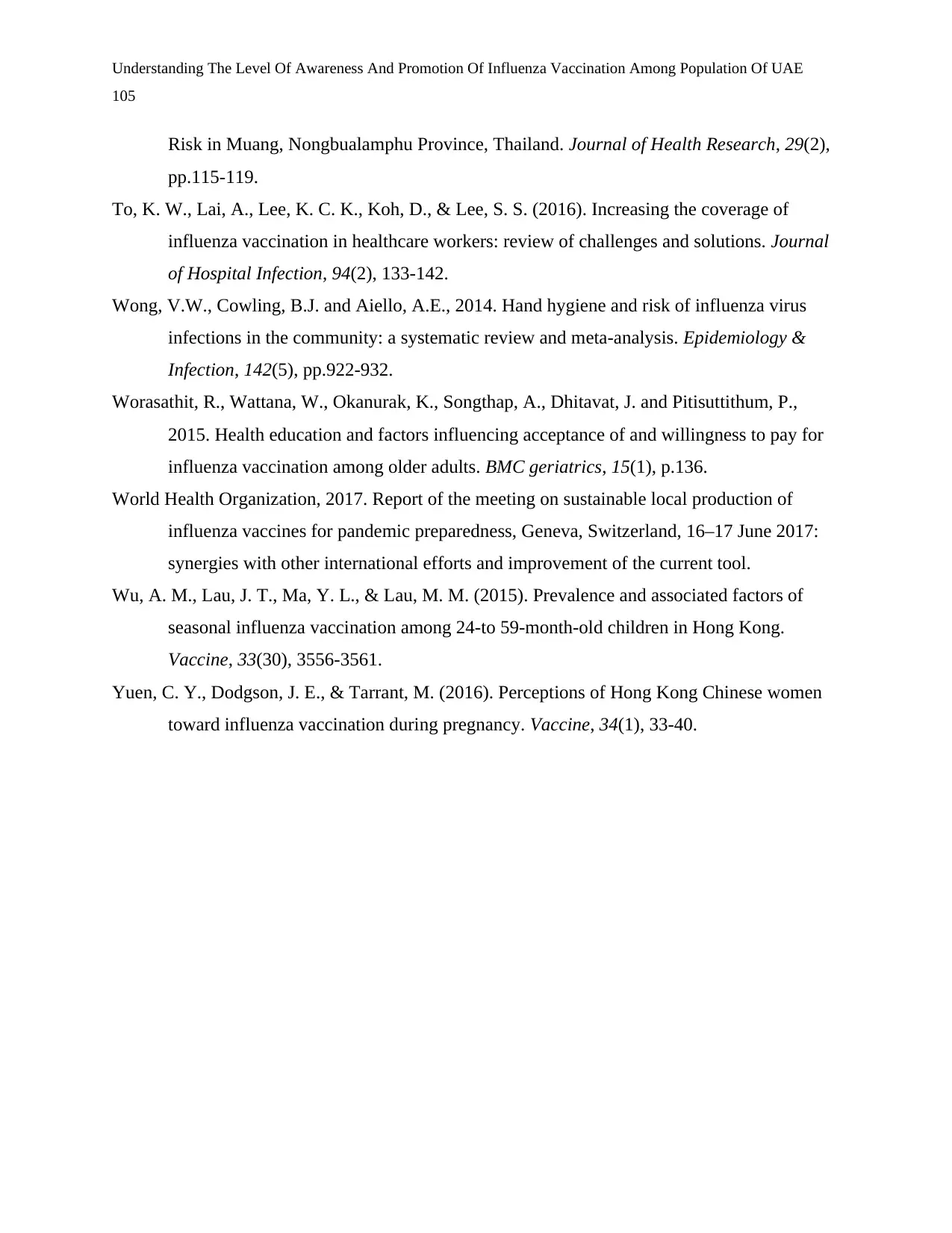
Understanding The Level Of Awareness And Promotion Of Influenza Vaccination Among Population Of UAE
105
Risk in Muang, Nongbualamphu Province, Thailand. Journal of Health Research, 29(2),
pp.115-119.
To, K. W., Lai, A., Lee, K. C. K., Koh, D., & Lee, S. S. (2016). Increasing the coverage of
influenza vaccination in healthcare workers: review of challenges and solutions. Journal
of Hospital Infection, 94(2), 133-142.
Wong, V.W., Cowling, B.J. and Aiello, A.E., 2014. Hand hygiene and risk of influenza virus
infections in the community: a systematic review and meta-analysis. Epidemiology &
Infection, 142(5), pp.922-932.
Worasathit, R., Wattana, W., Okanurak, K., Songthap, A., Dhitavat, J. and Pitisuttithum, P.,
2015. Health education and factors influencing acceptance of and willingness to pay for
influenza vaccination among older adults. BMC geriatrics, 15(1), p.136.
World Health Organization, 2017. Report of the meeting on sustainable local production of
influenza vaccines for pandemic preparedness, Geneva, Switzerland, 16–17 June 2017:
synergies with other international efforts and improvement of the current tool.
Wu, A. M., Lau, J. T., Ma, Y. L., & Lau, M. M. (2015). Prevalence and associated factors of
seasonal influenza vaccination among 24-to 59-month-old children in Hong Kong.
Vaccine, 33(30), 3556-3561.
Yuen, C. Y., Dodgson, J. E., & Tarrant, M. (2016). Perceptions of Hong Kong Chinese women
toward influenza vaccination during pregnancy. Vaccine, 34(1), 33-40.
105
Risk in Muang, Nongbualamphu Province, Thailand. Journal of Health Research, 29(2),
pp.115-119.
To, K. W., Lai, A., Lee, K. C. K., Koh, D., & Lee, S. S. (2016). Increasing the coverage of
influenza vaccination in healthcare workers: review of challenges and solutions. Journal
of Hospital Infection, 94(2), 133-142.
Wong, V.W., Cowling, B.J. and Aiello, A.E., 2014. Hand hygiene and risk of influenza virus
infections in the community: a systematic review and meta-analysis. Epidemiology &
Infection, 142(5), pp.922-932.
Worasathit, R., Wattana, W., Okanurak, K., Songthap, A., Dhitavat, J. and Pitisuttithum, P.,
2015. Health education and factors influencing acceptance of and willingness to pay for
influenza vaccination among older adults. BMC geriatrics, 15(1), p.136.
World Health Organization, 2017. Report of the meeting on sustainable local production of
influenza vaccines for pandemic preparedness, Geneva, Switzerland, 16–17 June 2017:
synergies with other international efforts and improvement of the current tool.
Wu, A. M., Lau, J. T., Ma, Y. L., & Lau, M. M. (2015). Prevalence and associated factors of
seasonal influenza vaccination among 24-to 59-month-old children in Hong Kong.
Vaccine, 33(30), 3556-3561.
Yuen, C. Y., Dodgson, J. E., & Tarrant, M. (2016). Perceptions of Hong Kong Chinese women
toward influenza vaccination during pregnancy. Vaccine, 34(1), 33-40.
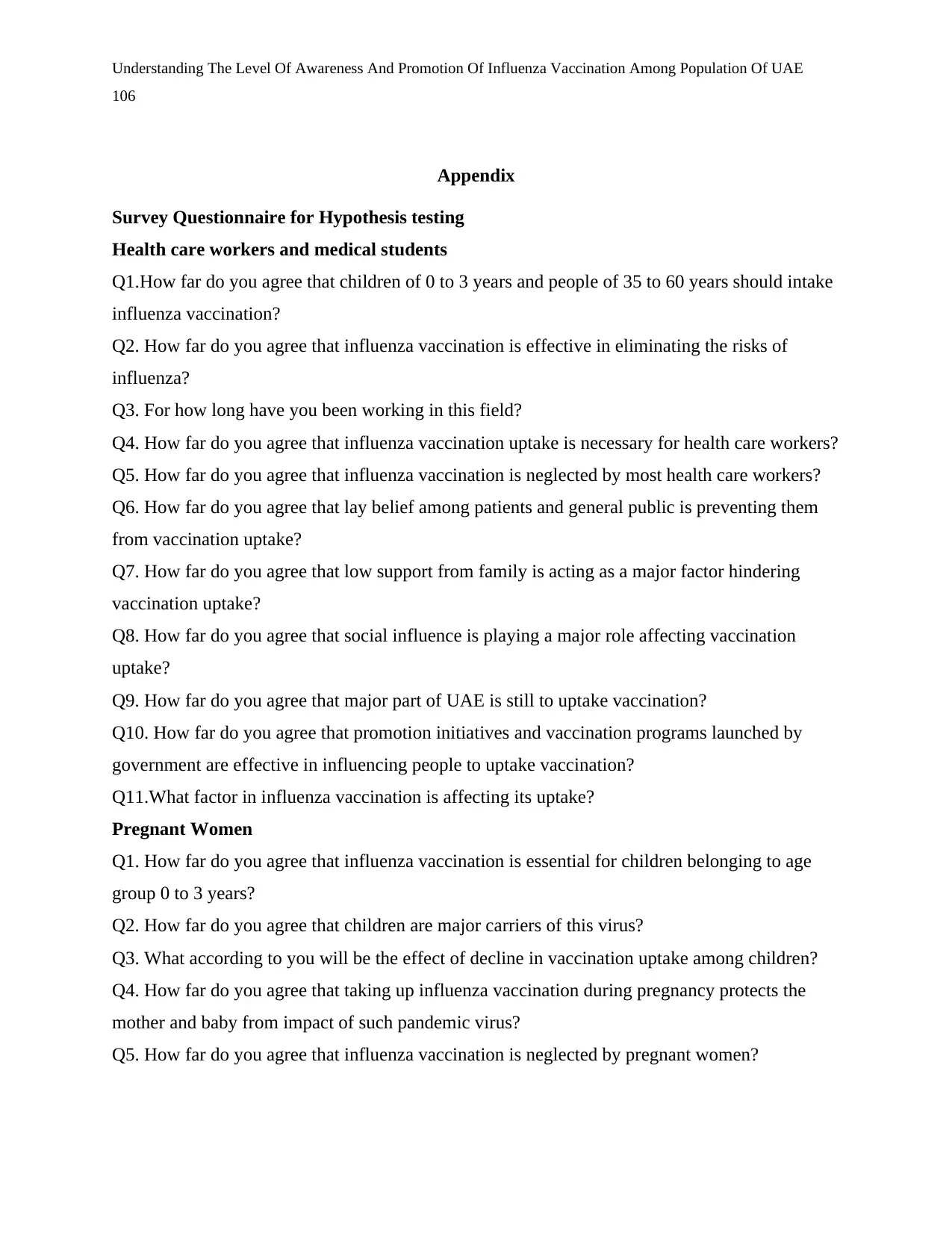
Understanding The Level Of Awareness And Promotion Of Influenza Vaccination Among Population Of UAE
106
Appendix
Survey Questionnaire for Hypothesis testing
Health care workers and medical students
Q1.How far do you agree that children of 0 to 3 years and people of 35 to 60 years should intake
influenza vaccination?
Q2. How far do you agree that influenza vaccination is effective in eliminating the risks of
influenza?
Q3. For how long have you been working in this field?
Q4. How far do you agree that influenza vaccination uptake is necessary for health care workers?
Q5. How far do you agree that influenza vaccination is neglected by most health care workers?
Q6. How far do you agree that lay belief among patients and general public is preventing them
from vaccination uptake?
Q7. How far do you agree that low support from family is acting as a major factor hindering
vaccination uptake?
Q8. How far do you agree that social influence is playing a major role affecting vaccination
uptake?
Q9. How far do you agree that major part of UAE is still to uptake vaccination?
Q10. How far do you agree that promotion initiatives and vaccination programs launched by
government are effective in influencing people to uptake vaccination?
Q11.What factor in influenza vaccination is affecting its uptake?
Pregnant Women
Q1. How far do you agree that influenza vaccination is essential for children belonging to age
group 0 to 3 years?
Q2. How far do you agree that children are major carriers of this virus?
Q3. What according to you will be the effect of decline in vaccination uptake among children?
Q4. How far do you agree that taking up influenza vaccination during pregnancy protects the
mother and baby from impact of such pandemic virus?
Q5. How far do you agree that influenza vaccination is neglected by pregnant women?
106
Appendix
Survey Questionnaire for Hypothesis testing
Health care workers and medical students
Q1.How far do you agree that children of 0 to 3 years and people of 35 to 60 years should intake
influenza vaccination?
Q2. How far do you agree that influenza vaccination is effective in eliminating the risks of
influenza?
Q3. For how long have you been working in this field?
Q4. How far do you agree that influenza vaccination uptake is necessary for health care workers?
Q5. How far do you agree that influenza vaccination is neglected by most health care workers?
Q6. How far do you agree that lay belief among patients and general public is preventing them
from vaccination uptake?
Q7. How far do you agree that low support from family is acting as a major factor hindering
vaccination uptake?
Q8. How far do you agree that social influence is playing a major role affecting vaccination
uptake?
Q9. How far do you agree that major part of UAE is still to uptake vaccination?
Q10. How far do you agree that promotion initiatives and vaccination programs launched by
government are effective in influencing people to uptake vaccination?
Q11.What factor in influenza vaccination is affecting its uptake?
Pregnant Women
Q1. How far do you agree that influenza vaccination is essential for children belonging to age
group 0 to 3 years?
Q2. How far do you agree that children are major carriers of this virus?
Q3. What according to you will be the effect of decline in vaccination uptake among children?
Q4. How far do you agree that taking up influenza vaccination during pregnancy protects the
mother and baby from impact of such pandemic virus?
Q5. How far do you agree that influenza vaccination is neglected by pregnant women?
Paraphrase This Document
Need a fresh take? Get an instant paraphrase of this document with our AI Paraphraser

Understanding The Level Of Awareness And Promotion Of Influenza Vaccination Among Population Of UAE
107
Q6. How far do you agree that lay belief among pregnant women is preventing them from
vaccination uptake?
Q7. How far do you agree that low support from family is acting as a major factor hindering
vaccination uptake?
Q8. How far do you agree that social influence is playing a major role affecting vaccination
uptake among pregnant women?
Q9 How far do you agree that vaccination against influenza can affect the baby?
Q10 What according to you is a major reason hindering uptake of influenza vaccination?
General public of UAE
Q1. How far do you agree that influenza is a serious disease?
Q2. How far do you agree that influenza can be prevented by use of traditional measures like
wearing warm clothes and others?
Q3. How far do you agree that vaccination against influenza is effective in mitigating the impact
of disease?
Q4. How far do you agree that misconception is affecting vaccination uptake in UAE?
School health care department
Q1. How far do you agree that vaccination programs organized in schools are successful in
vaccinating children?
Q2. How far do you agree that parents have positive perception about vaccination against
influenza in schools?
Q3. How far do you agree that parents are not willing to send their children for vaccination
uptake in school?
Q4. How far do you agree that lack of family support and misconception are preventing students
from up taking influenza vaccination?
Q5. What is the present scenario of vaccination uptake among children in schools?
107
Q6. How far do you agree that lay belief among pregnant women is preventing them from
vaccination uptake?
Q7. How far do you agree that low support from family is acting as a major factor hindering
vaccination uptake?
Q8. How far do you agree that social influence is playing a major role affecting vaccination
uptake among pregnant women?
Q9 How far do you agree that vaccination against influenza can affect the baby?
Q10 What according to you is a major reason hindering uptake of influenza vaccination?
General public of UAE
Q1. How far do you agree that influenza is a serious disease?
Q2. How far do you agree that influenza can be prevented by use of traditional measures like
wearing warm clothes and others?
Q3. How far do you agree that vaccination against influenza is effective in mitigating the impact
of disease?
Q4. How far do you agree that misconception is affecting vaccination uptake in UAE?
School health care department
Q1. How far do you agree that vaccination programs organized in schools are successful in
vaccinating children?
Q2. How far do you agree that parents have positive perception about vaccination against
influenza in schools?
Q3. How far do you agree that parents are not willing to send their children for vaccination
uptake in school?
Q4. How far do you agree that lack of family support and misconception are preventing students
from up taking influenza vaccination?
Q5. What is the present scenario of vaccination uptake among children in schools?
1 out of 107
Related Documents
Your All-in-One AI-Powered Toolkit for Academic Success.
+13062052269
info@desklib.com
Available 24*7 on WhatsApp / Email
![[object Object]](/_next/static/media/star-bottom.7253800d.svg)
Unlock your academic potential
© 2024 | Zucol Services PVT LTD | All rights reserved.





